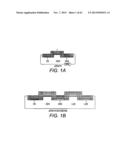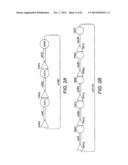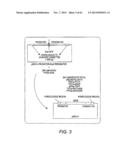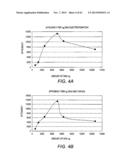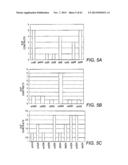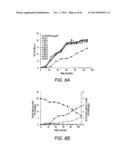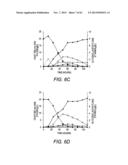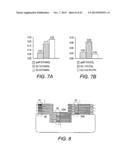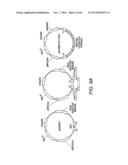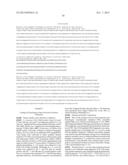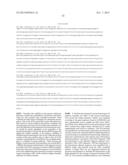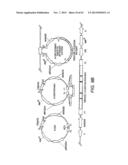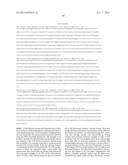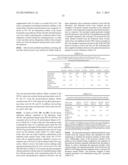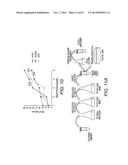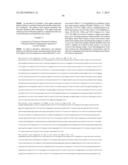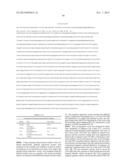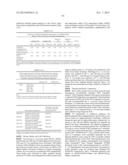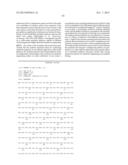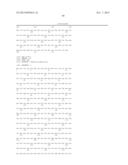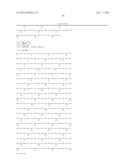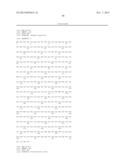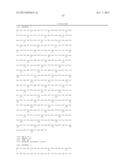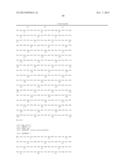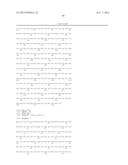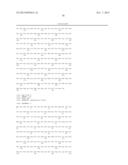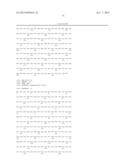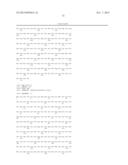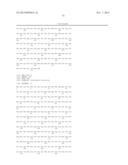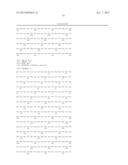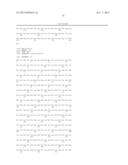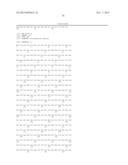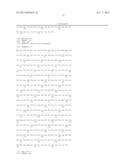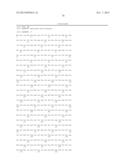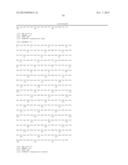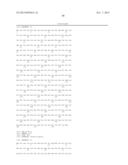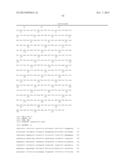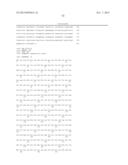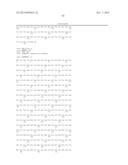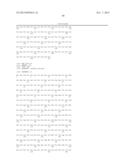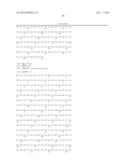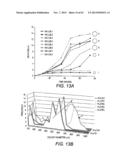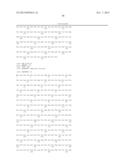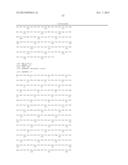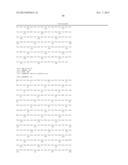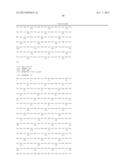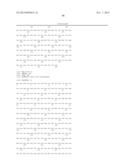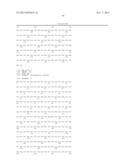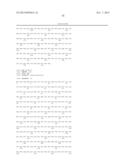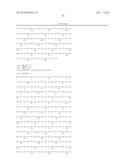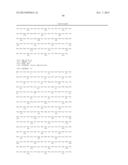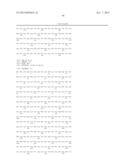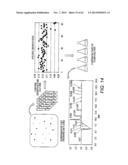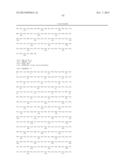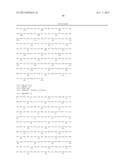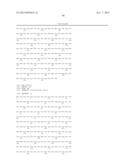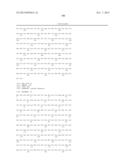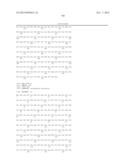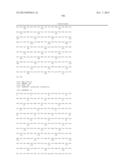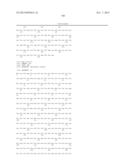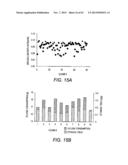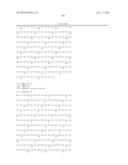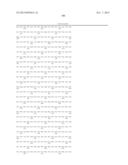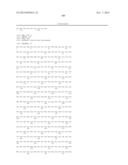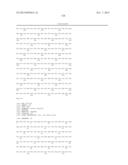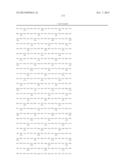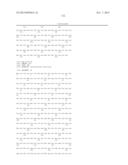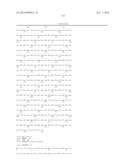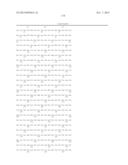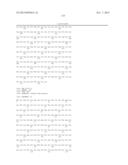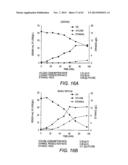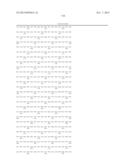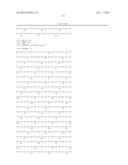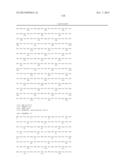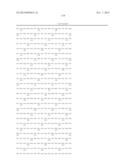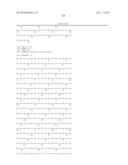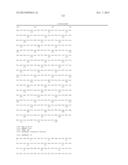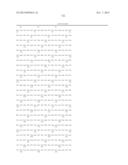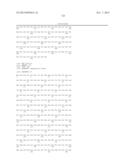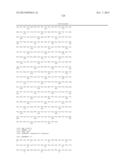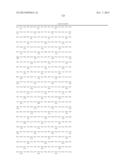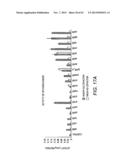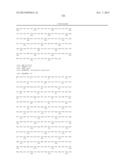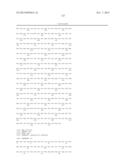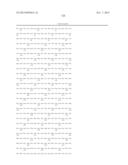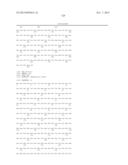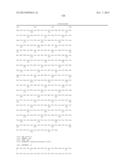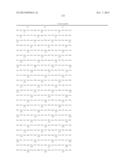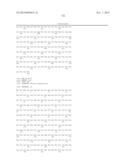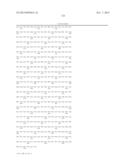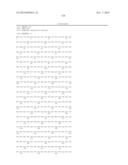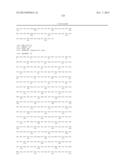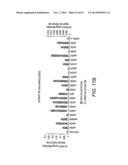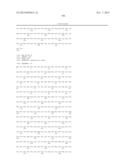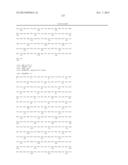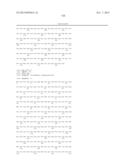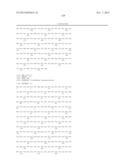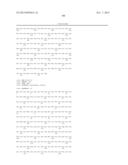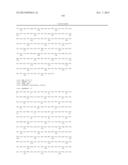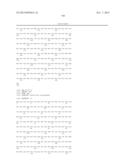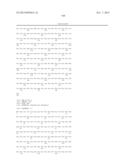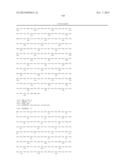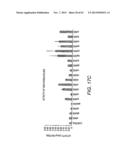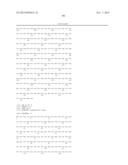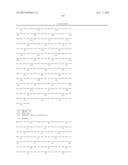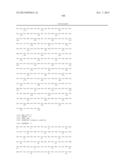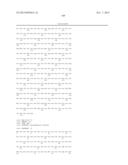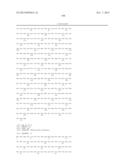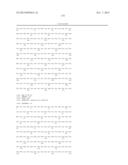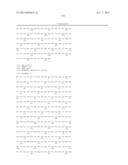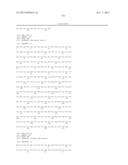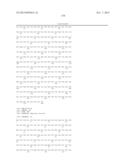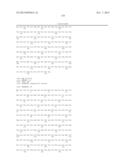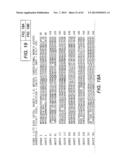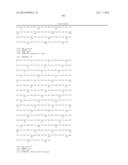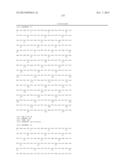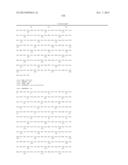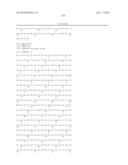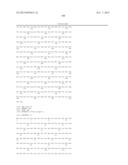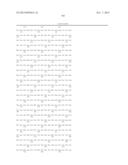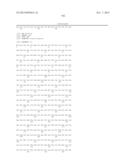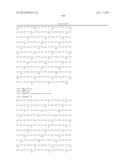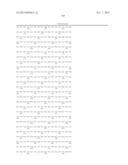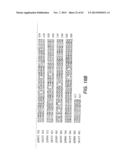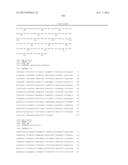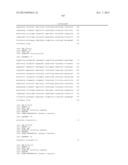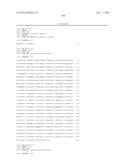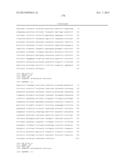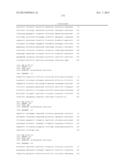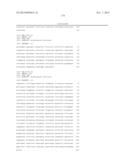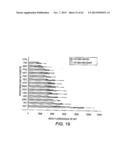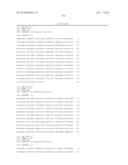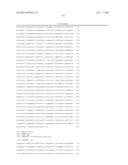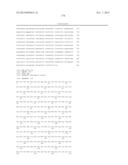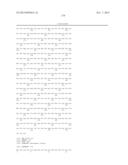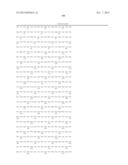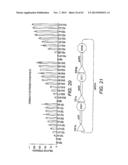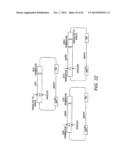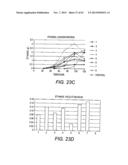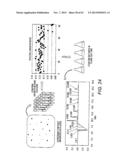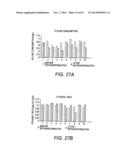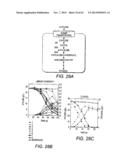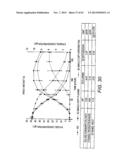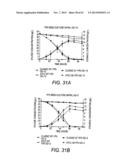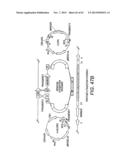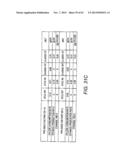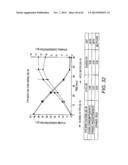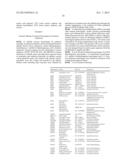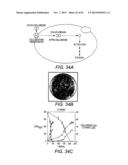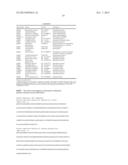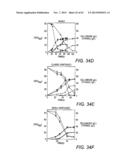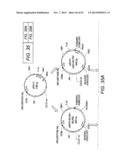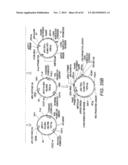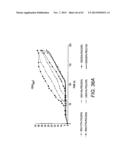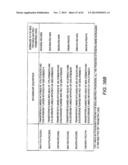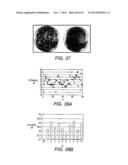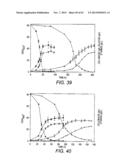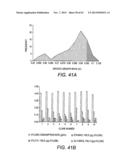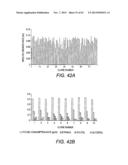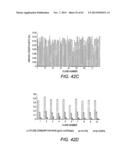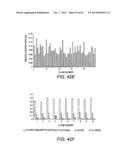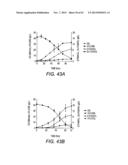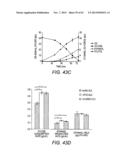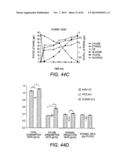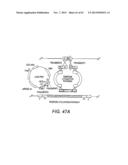Patent application title: COMBINATORIAL DESIGN OF HIGHLY EFFICIENT HETEROLOGOUS PATHWAYS
Inventors:
Huimin Zhao (Champaign, IL, US)
Huimin Zhao (Champaign, IL, US)
Byoungjin Kim (Urbana, IL, US)
Jing Du (Champaign, IL, US)
Yongbo Yuan (Urbana, IL, US)
Dawn Eriksen (Urbana, IL, US)
Tong Si (Urbana, IL, US)
Assignees:
THE BOARD OF TRUSTEES OF THE UNIVERSITY OF ILLINOIS
IPC8 Class: AC12P706FI
USPC Class:
435161
Class name: Containing hydroxy group acyclic ethanol
Publication date: 2013-11-07
Patent application number: 20130295631
Abstract:
The present disclosure relates to the production of highly efficient
heterologous pathways in host cells by identifying favorable enzyme
and/or promoter combinations. In particular the present disclosure
provides methods for assembly and selection of multi-step xylose and
arabinose/xylose utilization pathways from a library of fungal enzymes.
The present disclosure further provides compositions containing favorable
enzyme combinations, as well as recombinant yeast expressing such
combinations, and methods of use for bioconversion of pentose sugars.
Also provided are compositions and methods involving favorable expression
patterns identified by utilization of combinations of promoters of
varying strengths. Provided herein are methods for assembly and selection
of multi-step xylose, arabinose/xylose, and cellobiose utilization
pathways from a library of promoters of varying strengths. The present
disclosure further provides compositions containing heterologous
enzyme-coding polynucleotides under the control of favorable promoters,
as well as recombinant yeast expressing such enzymes, and methods of
their use for bioconversion of pentose and/or hexose sugars.Claims:
1-51. (canceled)
52. A host cell comprising a nucleic acid comprising coding regions of a xylose reductase, a xylitol dehydrogenase, and a xylulokinase, wherein each of said coding regions is in operable combination with a heterologous promoter and a heterologous terminator, and wherein each of said coding regions is from a different species.
53. The host cell of claim 52, wherein said xylose reductase coding region is of A. nidulans, said xylitol dehydrogenase coding region is of C. albicans, and said xylulokinase coding region is of S. cerevisiae.
54. The host cell of claim 53, wherein said A. nidulans xylose reductase coding region encodes a polypeptide comprising an amino acid sequence at least 90% identical to SEQ ID NO: 19, said C. albicans xylitol dehydrogenase coding region encodes a polypeptide comprising an amino acid sequence at least 90% identical to SEQ ID NO: 24, and said S. cerevisiae xylulokinase coding region encodes a polypeptide comprising an amino acid sequence at least 90% identical to SEQ ID NO: 49.
55. The host cell of claim 52, wherein said xylose reductase coding region is of P. guilliermondii, said xylitol dehydrogenase coding region is of P. chrysogenum, and said xylulokinase coding region is of A. oryzae.
56. The host cell of claim 55, wherein said P. guilliermondii xylose reductase coding region encodes a polypeptide comprising an amino acid sequence at least 90% identical to SEQ ID NO: 7, said P. chrysogenum xylitol dehydrogenase coding region encodes a polypeptide comprising an amino acid sequence at least 90% identical to SEQ ID NO: 30, and said A. oryzae xylulokinase coding region encodes a polypeptide comprising an amino acid sequence at least 90% identical to SEQ ID NO: 60.
57. The host cell of claim 52, wherein said xylose reductase coding region is of A. nidulans, said xylitol dehydrogenase coding region is of A. niger, and said xylulokinase coding region is of P. chrysogenum.
58. The host cell of claim 57, wherein said A. nidulans xylose reductase coding region encodes a polypeptide comprising an amino acid sequence at least 90% identical to SEQ ID NO: 19, said A. niger xylitol dehydrogenase coding region encodes a polypeptide comprising an amino acid sequence at least 90% identical to SEQ ID NO: 36, and said P. chrysogenum xylulokinase coding region encodes a polypeptide comprising an amino acid sequence at least 90% identical to SEQ ID NO: 47.
59. The host cell of claim 52, wherein said xylose reductase coding region is of C. shehatae, said xylitol dehydrogenase coding region is of C. tropicalis, and said xylulokinase coding region is of P. pastoris.
60. The host cell of claim 59, wherein said C. shehatae xylose reductase coding region encodes a polypeptide comprising an amino acid sequence at least 90% identical to SEQ ID NO: 3, said C. tropicalis xylitol dehydrogenase coding region encodes a polypeptide comprising an amino acid sequence at least 90% identical to SEQ ID NO: 38, and said P. pastoris xylulokinase coding region encodes a polypeptide comprising an amino acid sequence at least 90% identical to SEQ ID NO: 50.
61. The host cell of claim 52, wherein the nucleic acid further comprises coding regions of a xylose-specific transporter, a transaldolase and a transketolase, wherein each of said coding regions is in operable combination with a unique heterologous promoter and a unique heterologous terminator, and wherein said coding regions are from at least two different species.
62. The host cell of claim 52, wherein the nucleic acid further comprises coding regions of an L-arabitol 4-dehydrogenase, and a L-xylulose reductase, wherein each of said coding regions is in operable combination with a unique heterologous promoter and a unique heterologous terminator, and wherein said coding regions are from at least two different species.
63. The host cell of claim 52, wherein the nucleic acid further comprises coding regions of an L-arabitol 4-dehydrogenase, and a L-xylulose reductase, a xylose-specific transporter, an arabinose-specific transporter, a transaldolase and a transketolase wherein each of said coding regions is in operable combination with a unique heterologous promoter and a unique heterologous terminator, and wherein said coding regions are from at least two different species.
64. The host cell of claim 52, wherein said host cell grows anaerobically on xylose and/or arabinose as a main carbon source at a greater rate than a parental yeast strain from which it was derived and which lacks said vector.
65. The host cell of claim 52, wherein said host cell is a microorganism selected from the group consisting of Saccharomyces cerevisiae, Saccharomyces monacensis, Saccharomyces bayanus, Saccharomyces pastorianus, Saccharomyces carlsbergensis, Saccharomyces pombe, Kluyveromyces marxiamus, Kluyveromyces laths, Kluyveromyces fragilis, Pichia stipitis, Sporotrichum thermophile, Candida shehatae, Candida tropicalis, Neurospora crassa, Trichoderma reesei and Zymomonas mobilis.
66. A method for production of ethanol comprising culturing the host cell of claim 52 in a composition comprising xylose and/or arabinose, under conditions suitable for the production of ethanol.
67. The method of claim 66, wherein the composition comprising xylose and/or arabinose comprises plant biomass hydrolysate.
68. The method of claim 66, further comprising recovering the ethanol from the culture medium.
Description:
FIELD
[0001] The present disclosure relates to the production of highly efficient heterologous pathways in host cells by identifying favorable enzyme and/or promoter combinations. In particular the present disclosure provides methods for assembly and selection of multi-step xylose and arabinose/xylose utilization pathways from a library of fungal enzymes. The present disclosure further provides compositions containing favorable enzyme combinations, as well as recombinant yeast expressing such combinations, and methods of use for bioconversion of pentose sugars. Also provided are compositions and methods involving favorable expression patterns of heterologous enzymes identified by utilization of combinations of promoters of varying strengths. Provided herein are methods for assembly and selection of multi-step xylose, arabinose/xylose, and cellobiose utilization pathways from a library of polynucleotides encoding proteins of multi-step xylose, arabinose/xylose, and/or cellobiose utilization pathways under the control of promoters of varying strengths. The present disclosure further provides compositions containing heterologous enzyme-coding polynucleotides under the control of favorable promoters, as well as recombinant yeast expressing such enzymes, and methods of their use for bioconversion of pentose and/or hexose sugars.
BACKGROUND
[0002] Biofuels are under intensive investigation due to increasing concerns about energy security, sustainability, and global climate change (Lynd et al., Nature Biotechnology, 26:169-172, 2008). Biological conversion of plant-derived lignocellulosic materials into biofuels has been regarded as an attractive alternative to chemical production of fossil fuels (Lynd et al., Science, 251:1318-1323, 1991; and Hahn-Hagerdal et al., Trends in Biotechnology, 24:549-556, 2006). Saccharomyces cerevisiae, also known as baker's yeast, has been used for bioconversion of hexose sugars into ethanol for thousands of years. It is also the most widely used microorganism for large scale industrial fermentation of glucose into ethanol. S. cerevisiae is an excellent organism for bioconversion of lignocellulosic biomass into biofuels (van Maris et al., Antonie van Leeuwenhoek, 90:391-418, 2006). It has a well-studied genetic and physiological background, ample genetic tools, and high tolerance to ethanol and inhibitors present in lignocellulosic hydrolysates (Jeffries et al., Current Opinion in Biotechnology, 17:320-326, 2006). Moreover, the low fermentation pH of S. cerevisiae can also prevent bacterial contamination. Lignocellulosic biomass is composed of cellulose, hemicellulose, and lignin. The hemicellulose component comprises 20-30% of lignocellulosic biomass, and it is primarily composed of five-carbon sugars (pentoses) such as xylose and arabinose (Saha, In Hemicellulose bioconversion, Springer-Verlag Berlin:279-291, 2003). Unfortunately, wild type S. cerevisiae can not utilize pentose sugars (Hector et al., Applied Microbiology and Biotechnology, 80:675-684, 2008).
[0003] To overcome this limitation, pentose utilization pathways from pentose-assimilating organisms have been introduced into S. cerevisiae, allowing fermentation of xylose and arabinose (Fonseca et al., FEBS Journal, 274:3589-3600, 2007; Brat et al., Applied and Environmental Microbiology, 75:2304-2311; 2009; Wisselink et al., Applied and Environmental Microbiology, 73:4881-4891, 2007; Wiedemann and Boles, Applied and Environmental Microbiology, 74:2043-2050, 2008; Wisselink et al., Applied and Environmental Microbiology, 75:907-914, 2009; Karhumaa et al., Microbial Cell Factories, 5:18, 2006; and Bettiga et al., Microbial Cell Factories, 8:40, 2009). However, pentose utilization by recombinant S. cerevisiae strains is inefficient due to the low expression level and activity of heterologous genes, redox imbalance resulting from different cofactor preference for oxidation and reduction reactions, and suboptimal metabolic flux through different catalytic steps (Hector et al., supra, 2008). A lot of research has been done to improve the pentose utilization in S. cerevisiae by targeting different aspects of these issues (Jin and Jeffries, Applied Biochemistry and Biotechnology, 105:277-285, 2003; Jin et al., and Applied and Environmental Microbiology, 69:495-503, 2003).
[0004] Implementation of concerted strategies to concurrently solve all three problems associated with pentose utilization by yeast has heretofore been unsuccessful. Thus what is needed in the art are improved technologies for production of yeast capable of efficiently catabolizing five-carbon sugars.
[0005] Furthermore, host cells such as yeast may be used for various other metabolic processes through the introduction of heterologous genes into the cell. For example, recently a heterologous pathway for cellobiose utilization in S. cerevisiae was developed (Li et al., Mol BioSyst 6, 2129-2132 (2010)). Similar to the problems associated with pentose utilization by recombinant S. cerevisiae strains, many heterologous pathways introduced into a host cell may be inefficient. Thus what is also needed in the art are improved technologies for production of yeast having efficient heterologous pathways for various metabolic processes.
BRIEF SUMMARY
[0006] The present disclosure relates to the production of highly efficient heterologous pathways by identifying favorable enzyme and/or promoter combinations. In particular the present disclosure provides methods for assembly and selection of multi-step xylose and arabinose/xylose utilization pathways from a library of fungal enzymes. The present disclosure further provides compositions containing favorable enzyme combinations, as well as recombinant yeast expressing such combinations, and methods of use for bioconversion of pentose sugars. Also provided are compositions and methods involving favorable expression patterns of heterologous enzymes identified by utilization of combinations of promoters of varying strengths. Provided herein are methods for assembly and selection of multi-step xylose, arabinose/xylose, and cellobiose utilization pathways from a library of polynucleotides encoding proteins of multi-step xylose, arabinose/xylose, and/or cellobiose utilization pathways under the control of promoters of varying strengths. The present disclosure further provides compositions containing heterologous enzyme-coding polynucleotides under the control of favorable promoters, as well as recombinant yeast expressing such enzymes, and methods of their use for bioconversion of pentose and/or hexose sugars.
[0007] The present disclosure provides methods of preparing a library of nucleic acids encoding multi-enzyme pathways, comprising: a) providing: i) a first gene expression cassette for each of a plurality of homologues of a first enzyme, wherein the first gene expression cassette comprises an isolated nucleic acid comprising a coding region of the first enzyme in operable combination with a first heterologous promoter and a first heterologous terminator; ii) a second gene expression cassette for each of a plurality of homologues of a second enzyme, wherein the second gene expression cassette comprises an isolated nucleic acid comprising a coding region of the second enzyme in operable combination with a second heterologous promoter and a second heterologous terminator; iii) a third gene expression cassette for each of a plurality of homologues of a third enzyme, wherein the third gene expression cassette comprises an isolated nucleic acid comprising a coding region of the third enzyme, in operable combination with a third heterologous promoter, and a third heterologous terminator; and iv) a linearized yeast expression vector; wherein the first, second and third heterologous promoters comprise three different promoters, and the first, second and third heterologous terminators comprise three different terminators, and wherein an upstream homologous region is adjacent to the 5' end of the promoters, and a downstream homologous region is a adjacent to the 3' end of the terminators to facilitate homologous recombination of the gene expression cassettes into a site of interest in the yeast expression vector such that the first gene expression cassette is adjacent to the second gene expression cassette and the second third gene expression cassette is adjacent to the third gene expression cassette; and b) transforming yeast cells with the linearized yeast expression vector and the first, second and third gene expression cassettes to produce a recombinant yeast cell culture comprising a plurality of recombinant yeast cells each comprising a nucleic acid encoding a multi-enzyme pathway comprising one of each of the first, second and third gene expression cassettes adjacent to one another. In some embodiments, the methods further comprise step c) culturing the recombinant yeast cell culture under selective conditions comprising growth under oxygen-limited conditions in media containing a substrate utilized by the multi-enzyme pathway to produce a selected yeast cell culture enriched in a favorable combination of the first, second and third gene expression cassettes for utilization of the substrate. In some embodiments, recombinant yeast cell cultures comprising a favorable combination of gene expression cassettes produce a higher amount of product (e.g., ethanol) per gram substrate (at least 10%, 15%, 20%, 25%, 30%, 35%, 40%, 45%, 50%, 55%, 60%, 65%, 70%, 75%, 80%, 85%, 90%, 95%, 100%, 125%, 150%, 175%, or 200% greater product in grams/per gram substrate) as compared to a reference recombinant yeast cell culture comprising a reference multi-enzyme pathway. In some embodiments, the methods further comprise step d) isolating the nucleic acid encoding the multi-enzyme pathway from the selected yeast cell culture.
[0008] Also provided by the present disclosure are methods of preparing a library of nucleic acids encoding xylose utilization pathways, comprising: a) providing: i) a first gene expression cassette for each of a plurality of homologues of a xylose reductase, wherein the first gene expression cassette comprises an isolated nucleic acid comprising a coding region of the xylose reductase in operable combination with a first heterologous promoter and a first heterologous terminator; ii) a second gene expression cassette for each of a plurality of homologues of a xylitol dehydrogenase, wherein the second gene expression cassette comprises an isolated nucleic acid comprising a coding region of the xylitol dehydrogenase in operable combination with a second heterologous promoter and a second heterologous terminator; iii) a third gene expression cassette for each of a plurality of homologues of a xylulokinase, wherein the third gene expression cassette comprises an isolated nucleic acid comprising a coding region of the xylulokinase reductase, in operable combination with a third heterologous promoter, and a third heterologous terminator; and iv) a linearized yeast expression vector; wherein the first, second and third heterologous promoters comprise three different promoters, and the first, second and third heterologous terminators comprise three different terminators, and wherein an upstream homologous region is adjacent to the 5' end of the promoters, and a downstream homologous region is a adjacent to the 3' end of the terminators to facilitate homologous recombination of the gene expression cassettes into a site of interest in the yeast expression vector such that the first gene expression cassette is adjacent to the second gene expression cassette and the second gene expression cassette is adjacent to the third gene expression cassette; and b) transforming yeast cells with the linearized yeast expression vector and the first, second and third gene expression cassettes to produce a recombinant yeast cell culture comprising a plurality of recombinant yeast cells each comprising a nucleic acid encoding a xylose utilization pathway comprising one of each of the first, second and third gene expression cassettes adjacent to one another. In some embodiments, the methods further comprise step c) culturing the recombinant yeast cell culture under selective conditions comprising growth under oxygen-limited conditions in media containing xylose to produce a selected yeast cell culture enriched in a favorable combination of the first, second and third gene expression cassettes for anaerobic xylose catabolism. In some embodiments, recombinant yeast cell cultures comprising a favorable combination of gene expression cassettes produce a higher amount of product (e.g., ethanol) per gram xylose (at least 10%, 15%, 20%, 25%, 30%, 35%, 40%, 45%, 50%, 55%, 60%, 65%, 70%, 75%, 80%, 85%, 90%, 95%, 100%, 125%, 150%, 175%, or 200% greater product in grams/per gram xylose) as compared to a reference recombinant yeast cell culture comprising a reference xylose utilization pathway. An exemplary reference recombinant yeast cell culture comprises the scaffold of FIG. 2A. In some embodiments, the methods further comprise step d) isolating the nucleic acid encoding the xylose utilization pathway from the selected yeast cell culture.
[0009] Additionally, the present disclosure provides methods of preparing a library of nucleic acids encoding xylose/arabinose utilization pathways, comprising: a) providing: i) a first gene expression cassette for each of a plurality of homologues of a xylose reductase, wherein the first gene expression cassette comprises an isolated nucleic acid comprising a coding region of the xylose reductase in operable combination with a first heterologous promoter and a first heterologous terminator; ii) a second gene expression cassette for each of a plurality of homologues of a xylitol dehydrogenase, wherein the second gene expression cassette comprises an isolated nucleic acid comprising a coding region of the xylitol dehydrogenase in operable combination with a second heterologous promoter and a second heterologous terminator; iii) a third gene expression cassette for each of a plurality of homologues of a xylulokinase, wherein the third gene expression cassette comprises an isolated nucleic acid comprising a coding region of the xylulokinase reductase, in operable combination with a third heterologous promoter, and a third heterologous terminator; iv) a fourth gene expression cassette for each of a plurality of homologues of a L-arabitol 4-dehydrogenase, wherein the fourth gene expression cassette comprises an isolated nucleic acid comprising a coding region of the L-arabitol 4-dehydrogenase in operable combination with a fourth heterologous promoter and a fourth heterologous terminator; v) a fifth gene expression cassette for each of a plurality of homologues of a L-xylulose reductase, wherein the fifth gene expression cassette comprises an isolated nucleic acid comprising a coding region of the L-xylulose reductase in operable combination with a fifth heterologous promoter and a fifth heterologous terminator; and vi) a linearized yeast expression vector; wherein the first, second, third, fourth and fifth heterologous promoters comprise five different promoters, and the first, second, third, fourth and fifth heterologous terminators comprise five different terminators, and wherein an upstream homologous region is adjacent to the 5' end of the promoters, and a downstream homologous region is a adjacent to the 3' end of the terminators to facilitate homologous recombination of the gene expression cassette into a site of interest in the yeast expression vector such that the first gene expression cassette is adjacent to the second gene expression cassette, the second gene expression cassette is adjacent to the third gene expression cassette, the third gene expression cassette is adjacent to the fourth gene expression cassette, and the fourth gene expression cassette is adjacent to the fifth gene expression cassette; and b) transforming yeast cells with the linearized yeast expression vector and the first, second, third, fourth and fifth gene expression cassettes to produce a recombinant yeast cell culture comprising a plurality of recombinant yeast cells each comprising a nucleic acid encoding a xylose/arabinose utilization pathway comprising one of each of the first, second, third, fourth and fifth gene expression cassettes adjacent to one another. In some embodiments, the methods further comprise step c) culturing the recombinant yeast cell culture under selective conditions comprising growth under oxygen-limited conditions in media containing xylose and/or arabinose to produce a selected yeast cell culture enriched in a favorable combination of the first, second, third, fourth and fifth gene expression cassettes for anaerobic xylose and/or arabinose catabolism. In some embodiments, recombinant yeast cell cultures comprising a favorable combination of gene expression cassettes produce a higher amount of product (e.g., ethanol) per gram xylose and/or arabinose (at least 10%, 15%, 20%, 25%, 30%, 35%, 40%, 45%, 50%, 55%, 60%, 65%, 70%, 75%, 80%, 85%, 90%, 95%, 100%, 125%, 150%, 175%, or 200% greater product in grams/per gram xylose and/or arabinose) as compared to a reference recombinant yeast cell culture comprising a reference xylose utilization pathway. An exemplary reference recombinant yeast cell culture comprises the scaffold of FIG. 2B. In some embodiments, the methods further comprise step d) isolating the nucleic acid encoding the xylose/arabinose utilization pathway from the selected yeast cell culture.
[0010] Moreover the present disclosure provides isolated nucleic acids comprising coding regions of a xylose reductase, a xylitol dehydrogenase, and a xylulokinase, wherein each of the coding regions is in operable combination with a unique heterologous promoter and a unique heterologous terminator, and wherein each of the coding regions is of a different species. The heterologous promoters and terminators are unique in that they are different from other promoters and terminators, respectively of the isolated nucleic acid. In some embodiments, the coding regions of the nucleic acid are codon-optimized for expression in S. cerevisiae. In some embodiments, the xylose reductase coding region is of A. nidulans, the xylitol dehydrogenase coding region is of C. albicans, and the xylulokinase coding region is of S. cerevisiae. In a subset of these embodiments, the A. nidulans xylose reductase coding region encodes a polypeptide containing an amino acid sequence at least 90% identical to SEQ ID NO: 19, the C. albicans xylitol dehydrogenase coding region encodes a polypeptide containing an amino acid sequence at least 90% identical to SEQ ID NO: 24, and the S. cerevisiae xylulokinase coding region encodes a polypeptide containing an amino acid sequence at least 90% identical to SEQ ID NO: 49. In some embodiments, the xylose reductase coding region is of P. guilliermondii, the xylitol dehydrogenase coding region is of P. chrysogenum, and the xylulokinase coding region is of A. oryzae. In a subset of these embodiments, the P. guilliermondii xylose reductase coding region encodes a polypeptide containing an amino acid sequence at least 90% identical to SEQ ID NO: 7, the P. chrysogenum xylitol dehydrogenase coding region encodes a polypeptide containing an amino acid sequence at least 90% identical to SEQ ID NO: 30, and the A. oryzae xylulokinase coding region encodes a polypeptide containing an amino acid sequence at least 90% identical to SEQ ID NO: 60. In some embodiments, the xylose reductase coding region is of A. nidulans, the xylitol dehydrogenase coding region is of A. niger, and the xylulokinase coding region is of P. chrysogenum. In a subset of these embodiments, the A. nidulans xylose reductase coding region encodes a polypeptide containing an amino acid sequence at least 90% identical to SEQ ID NO: 19, the A. niger xylitol dehydrogenase coding region encodes a polypeptide containing an amino acid sequence at least 90% identical to SEQ ID NO: 36, and the P. chrysogenum xylulokinase coding region encodes a polypeptide containing an amino acid sequence at least 90% identical to SEQ ID NO: 47. In some embodiments, the xylose reductase coding region is of C. shehatae, the xylitol dehydrogenase coding region is of C. tropicalis, and the xylulokinase coding region is of P. pastoris. In a subset of these embodiments, the C. shehatae xylose reductase coding region encodes a polypeptide containing an amino acid sequence at least 90% identical to SEQ ID NO: 3, the C. tropicalis xylitol dehydrogenase coding region encodes a polypeptide containing an amino acid sequence at least 90% identical to SEQ ID NO: 38, and the P. pastoris xylulokinase coding region encodes a polypeptide containing an amino acid sequence at least 90% identical to SEQ ID NO: 50. In some embodiments, the xylose reductase coding region is of P. guilliermondii, the xylitol dehydrogenase coding regions of N. crassa, and the xylulokinase coding regions is of P. chrysogenum. In a subset of these embodiments, the P. guilliermondii xylose reductase coding region is at least 95% identical to SEQ ID NO:7, the N. crassa xylitol coding region is at least 95% identical to SEQ ID NO:27, and the P. chrysogenum xylulokinase coding region is at least 95% identical to SEQ ID NO:47. In other embodiments, the xylose reductase coding region is of A. oryzae, the xylitol dehydrogenase coding region is of N. crassa, and the xylulokinase coding region is of P. chrysogenum. In a subset of these embodiments, the A. oryzae xylose reductase coding region is at least 95% identical to SEQ ID NO:1, the N. crassa xylitol coding region is at least 95% identical to SEQ ID NO:27, and the P. chrysogenum xylulokinase coding region is at least 95% identical to SEQ ID NO:47. At least 90% identical indicates that the coding region of interest is at least 90%, 91%, 92%, 93%, 94%, 95%, 96%, 97%, 98%, 99% or 100% identical to the referenced SEQ ID NO.
[0011] Also provided by the present disclosure are isolated nucleic acids comprising coding regions of a xylose reductase, a xylitol dehydrogenase, a xylulokinase, a xylose-specific transporter, a transaldolase and a transketolase, wherein each of the coding regions is in operable combination with a unique heterologous promoter and a unique heterologous terminator, and wherein the coding regions are from at least two different species. The heterologous promoters and terminators are unique in that they are different from other promoters and terminators, respectively of the isolated nucleic acid. In some embodiments, the different species comprise at least two or three different fungal species. In some preferred embodiments, the coding regions of the nucleic acid are codon-optimized for expression in S. cerevisiae.
[0012] The present disclosure also provides isolated nucleic acids comprising coding regions of a xylose reductase, a xylitol dehydrogenase, a xylulokinase, an L-arabitol 4-dehydrogenase, and a L-xylulose reductase, wherein each of the coding regions is in operable combination with a unique heterologous promoter and a unique heterologous terminator, and wherein the coding regions are from at least two different species. The heterologous promoters and terminators are unique in that they are different from other promoters and terminators, respectively of the isolated nucleic acid. In some embodiments, the different species comprise at least two or three different fungal species. In some preferred embodiments, the coding regions of the nucleic acid are codon-optimized for expression in S. cerevisiae.
[0013] Also provided by the present disclosure are isolated nucleic acids comprising coding regions of a xylose reductase, a xylitol dehydrogenase, a xylulokinase, an L-arabitol 4-dehydrogenase, and a L-xylulose reductase, a xylose-specific transporter, an arabinose-specific transporter, a transaldolase and a transketolase wherein each of the coding regions is in operable combination with a unique heterologous promoter and a unique heterologous terminator, and wherein the coding regions are from at least two different species. The heterologous promoters and terminators are unique in that they are different from other promoters and terminators, respectively of the isolated nucleic acid. In some embodiments, the different species comprise at least two or three different fungal species. In some preferred embodiments, the coding regions of the nucleic acid are codon-optimized for expression in S. cerevisiae.
[0014] In addition, the present disclosure provides vectors comprising the isolated nucleic acid of any one of the preceding paragraphs. In some embodiments, the vector is selected from the group consisting of an integrative plasmid, a centromeric plasmid, and a episomal plasmid. In further embodiments, the present disclosure provides a host cell comprising the vector. In some preferred embodiments, the host cell is of a microorganism selected from the group consisting of Saccharomyces cerevisiae, Saccharomyces monacensis, Saccharomyces bayanus, Saccharomyces pastorianus, Saccharomyces carlsbergensis, Saccharomyces pombe, Kluyveromyces marxiamus, Kluyveromyces lactis, Kluyveromyces fragilis, Pichia stipitis, Sporotrichum thermophile, Candida shehatae, Candida tropicalis, Neurospora crassa, Trichoderma reesei, and Zymomonas mobilis. In some embodiments, the yeast grows anaerobically on xylose and/or arabinose as a main carbon source at a greater rate than a parental yeast strain from which it was derived and which lacks the vector. Moreover, the present disclosure provides method for productions of ethanol comprising culturing the host cells in a composition comprising xylose and/or arabinose, under conditions suitable for the production of ethanol. In some aspects, the composition comprising xylose and/or arabinose includes plant biomass hydrolysate. In some embodiments, the methods further comprise recovering the ethanol from the culture medium.
[0015] The present disclosure also provides methods of preparing a library of gene expression cassettes, comprising: a) amplifying a coding region of an enzyme with a primer pair comprising a forward primer and a reverse primer to produce an amplified coding region, the forward primer comprising a 5' overhang identical to the 3' end of a heterologous promoter, and the reverse primer comprising a 5' overhang identical to the reverse complement of the 3' end of a heterologous terminator; b) digesting a helper plasmid with a restriction endonuclease to produce a linearized helper plasmid, wherein the helper plasmid comprises the promoter separated from the terminator by a sole recognition site for the restriction endonuclease; c) transforming a yeast cell with the linearized helper plasmid and the amplified coding region to produce a recombinant yeast cell comprising a circular plasmid containing a gene expression cassette comprising the coding region in operable combination with the promoter and the terminator; and d) repeating steps (a) to (c) for each of a plurality of homologues of the enzyme, to produce a library of gene expression cassettes. In some embodiments, the enzyme comprises one or more of the group consisting of a xylose reductase, a xylitol dehydrogenase, a xylulokinase, a L-arabitol 4-dehydrogenase, and a L-xylulose reductase. In some embodiments, an upstream homologous region is adjacent to the 5' end of the heterologous promoter of the helper plasmid, and a downstream homologous region is a adjacent to the 3' end of the heterologous terminator of the helper plasmid to facilitate incorporation by homologous recombination of the gene expression cassette into a site of interest in an expression vector.
[0016] The present disclosure also provides a method of preparing a library of nucleic acids encoding cellobiose utilization pathways, comprising: a) providing: i) a plurality of first gene expression cassettes for a cellobiose transporter, wherein each of said first gene expression cassettes comprises an isolated nucleic acid comprising a coding region of said cellobiose transporter in operable combination with a first heterologous promoter and a first heterologous terminator; ii) a plurality of second gene expression cassettes for a beta-glucosidase, wherein each of said second gene expression cassettes comprises an isolated nucleic acid comprising a coding region of said beta-glucosidase in operable combination with a second heterologous promoter and a second heterologous terminator; and iii) a linearized yeast expression vector; wherein said first and second heterologous promoters comprise two different promoters, and said first and second heterologous terminators comprise two different terminators, and wherein each of said first and second heterologous promoters comprise a mutation with respect to another of said first and second heterologous promoters of said plurality such that said mutation results in a change in relative expression levels of one of said cellobiose transporter and beta-glucosidase, and wherein an upstream homologous region is adjacent to the 5' end of said promoters, and a downstream homologous region is a adjacent to the 3' end of said terminators to facilitate homologous recombination of said gene expression cassettes into a site of interest in said yeast expression vector such that said first gene expression cassette is adjacent to said second gene expression cassette; and b) transforming yeast cells with said linearized yeast expression vector and said first and second gene expression cassettes to produce a recombinant yeast cell culture comprising a plurality of recombinant yeast cells each comprising a nucleic acid encoding a cellobiose utilization pathway comprising one of each of said first and second gene expression cassettes adjacent to one another. In some aspects, the method may further comprise step c) culturing said recombinant yeast cell culture under selective conditions comprising growth under oxygen-limited conditions in media containing cellobiose to produce a selected yeast cell culture enriched in a favorable combination of said first and second gene expression cassettes for anaerobic cellobiose catabolism. In some aspects, the method may further comprise step d) isolating said nucleic acid encoding said cellobiose utilization pathway from said selected yeast cell culture. In some aspects, the heterologous promoters include at two from the group consisting of an ENO2 promoter, a PDC1 promoter, a FBA1 promoter, a GPM1 promoter, a TPI1 promoter, and a TEF1 promoter.
[0017] In addition, the present disclosure provides methods of preparing a library of nucleic acids encoding xylose utilization pathways, comprising: a) providing: i) a plurality of first gene expression cassettes for a xylose reductase, wherein each of the first gene expression cassettes comprises an isolated nucleic acid comprising a coding region of the xylose reductase in operable combination with a first heterologous promoter and a first heterologous terminator; ii) a plurality of second gene expression cassettes for a xylitol dehydrogenase, wherein each of the second gene expression cassettes comprises an isolated nucleic acid comprising a coding region of the xylitol dehydrogenase in operable combination with a second heterologous promoter and a second heterologous terminator; iii) a plurality of third gene expression cassettes for a xylulokinase, wherein the third gene expression cassette comprises an isolated nucleic acid comprising a coding region of the xylulokinase reductase, in operable combination with a third heterologous promoter, and a third heterologous terminator; and iv) a linearized yeast expression vector; wherein the first, second and third heterologous promoters comprise three different promoters, and the first, second and third heterologous terminators comprise three different terminators, and wherein each of the first, second and third heterologous promoters comprise a mutation with respect to another of the first, second and third heterologous promoters of the plurality such that the mutation results in a change in relative expression levels of one of the xylose reductase, xylitol dehydrogenase, and xylulokinase reductase, and wherein an upstream homologous region is adjacent to the 5' end of the promoters, and a downstream homologous region is a adjacent to the 3' end of the terminators to facilitate homologous recombination of the gene expression cassettes into a site of interest in the yeast expression vector such that the first gene expression cassette is adjacent to the second gene expression cassette and the second third gene expression cassette is adjacent to the third gene expression cassette; and b) transforming yeast cells with the linearized yeast expression vector and the first, second and third gene expression cassettes to produce a recombinant yeast cell culture comprising a plurality of recombinant yeast cells each comprising a nucleic acid encoding a xylose utilization pathway comprising one of each of the first, second and third gene expression cassettes adjacent to one another. In some embodiments, the methods further comprise step c) culturing the recombinant yeast cell culture under selective conditions comprising growth under oxygen-limited conditions in media containing xylose to produce a selected yeast cell culture enriched in a favorable combination of the first, second and third gene expression cassettes for anaerobic xylose catabolism, as compared to a reference recombinant yeast cell culture comprising a reference xylose utilization pathway. An exemplary reference recombinant yeast cell culture comprises the scaffold of FIG. 2A. In some embodiments, the methods further comprise step d) isolating the nucleic acid encoding the xylose utilization pathway from the selected yeast cell culture. In some embodiments, the heterologous promoters comprise three from the group consisting of an ENO2 promoter, a PDC1 promoter, a FBA1 promoter, a GPM1 promoter, a TPI1 promoter, and a TEF1 promoter.
[0018] Moreover the present invention provides methods of preparing a library of nucleic acids encoding xylose/arabinose utilization pathways, comprising: a) providing: i) a plurality of first gene expression cassettes for a xylose reductase, wherein each of the first gene expression cassettes comprises an isolated nucleic acid comprising a coding region of the xylose reductase in operable combination with a first heterologous promoter and a first heterologous terminator; ii) a plurality of second gene expression cassettes for a xylitol dehydrogenase, wherein each of the second gene expression cassettes comprises an isolated nucleic acid comprising a coding region of the xylitol dehydrogenase in operable combination with a second heterologous promoter and a second heterologous terminator; iii) a plurality of third gene expression cassettes for a xylulokinase, wherein the third gene expression cassette comprises an isolated nucleic acid comprising a coding region of the xylulokinase reductase, in operable combination with a third heterologous promoter, and a third heterologous terminator; iv) a plurality of fourth gene expression cassettes for an L-arabitol 4-dehydrogenase, wherein the fourth gene expression cassette comprises an isolated nucleic acid comprising a coding region of the L-arabitol 4-dehydrogenase, in operable combination with a fourth heterologous promoter, and a fourth heterologous terminator; v) a plurality of fifth gene expression cassettes for a L-xylulose reductase, wherein the fifth gene expression cassette comprises an isolated nucleic acid comprising a coding region of the L-xylulose reductase, in operable combination with a fifth heterologous promoter, and a fifth heterologous terminator; and vi) a linearized yeast expression vector; wherein the first, second, third, fourth and fifth heterologous promoters comprise five different promoters, and the first, second, third, fourth and fifth heterologous terminators comprise five different terminators, and wherein each of the first, second, third, fourth and fifth heterologous promoters comprise a mutation with respect to another of the first, second, third, fourth and fifth heterologous promoters of the plurality such that the mutation results in a change in relative expression levels of one of the xylose reductase, xylitol dehydrogenase, xylulokinase reductase, L-arabitol 4-dehydrogenase and, and wherein an upstream homologous region is adjacent to the 5' end of the promoters, and a downstream homologous region is a adjacent to the 3' end of the terminators to facilitate homologous recombination of the gene expression cassettes into a site of interest in the yeast expression vector such that the first gene expression cassette is adjacent to the second gene expression cassette, the second gene expression cassette is adjacent to the third gene expression cassette, the third gene expression cassette is adjacent to the fourth gene expression cassette, and the fourth gene expression cassette is adjacent to the fifth gene expression cassette; and b) transforming yeast cells with the linearized yeast expression vector and the first, second, third, fourth and fifth gene expression cassettes to produce a recombinant yeast cell culture comprising a plurality of recombinant yeast cells each comprising a nucleic acid encoding a xylose/arabinose utilization pathway comprising one of each of the first, second, third, fourth and fifth gene expression cassettes adjacent to one another. In some embodiments, the methods further comprise step c) culturing the recombinant yeast cell culture under selective conditions comprising growth under oxygen-limited conditions in media containing xylose and/or arabinose to produce a selected yeast cell culture enriched in a favorable combination of the first, second, third, fourth and fifth gene expression cassettes for anaerobic xylose and/or arabinose catabolism as compared to a reference recombinant yeast cell culture comprising a reference xylose utilization pathway. An exemplary reference recombinant yeast cell culture comprises the scaffold of FIG. 2B. In some embodiments, the methods further comprise step d) isolating the nucleic acid encoding the xylose/arabinose utilization pathway from the selected yeast cell culture. In some embodiments, the heterologous promoters comprise five from the group consisting of an ENO2 promoter, a PDC1 promoter, a FBA1 promoter, a GPM1 promoter, a TPI1 promoter, and a TEF1 promoter.
[0019] The present disclosure also provides methods of preparing a library of nucleic acids encoding multi-enzyme pathways, comprising: a) providing: i) a plurality of first gene expression cassettes for a first enzyme, wherein each of the first gene expression cassettes comprises an isolated nucleic acid comprising a coding region of the first enzyme in operable combination with a first heterologous promoter and a first heterologous terminator; ii) a plurality of second gene expression cassettes for a second enzyme, wherein each of the second gene expression cassettes comprises an isolated nucleic acid comprising a coding region of the second enzyme in operable combination with a second heterologous promoter and a second heterologous terminator; iii) a plurality of third gene expression cassettes for a third enzyme, wherein the third gene expression cassette comprises an isolated nucleic acid comprising a coding region of the third enzyme, in operable combination with a third heterologous promoter, and a third heterologous terminator; and iv) a linearized yeast expression vector; wherein the first, second and third heterologous promoters comprise three different promoters, and the first, second and third heterologous terminators comprise three different terminators, and wherein each of the first, second and third heterologous promoters comprise a mutation with respect to another of the first, second and third heterologous promoters of the plurality such that the mutation results in a change in relative expression levels of one of the first, second and third enzymes, and wherein an upstream homologous region is adjacent to the 5' end of the promoters, and a downstream homologous region is a adjacent to the 3' end of the terminators to facilitate homologous recombination of the gene expression cassettes into a site of interest in the yeast expression vector such that the first gene expression cassette is adjacent to the second gene expression cassette and the second third gene expression cassette is adjacent to the third gene expression cassette; and b) transforming yeast cells with the linearized yeast expression vector and the first, second and third gene expression cassettes to produce a recombinant yeast cell culture comprising a plurality of recombinant yeast cells each comprising a nucleic acid encoding a multi-enzyme pathway comprising one of each of the first, second and third gene expression cassettes adjacent to one another. In some embodiments, the methods further comprise step c) culturing the recombinant yeast cell culture under selective conditions comprising growth under oxygen-limited conditions in media containing a substrate of the pathway to produce a selected yeast cell culture enriched in a favorable combination of the first, second and third gene expression cassettes for anaerobic utilization of the substrate, as compared to a reference recombinant yeast cell culture comprising a reference multi-enzyme pathway. In some embodiments, the methods further comprise step d) isolating the nucleic acid encoding the multi-enzyme pathway from the selected yeast cell culture. In some embodiments, the heterologous promoters include three from the group consisting of an ENO2 promoter, a PDC1 promoter, a FBA1 promoter, a GPM1 promoter, a TPI1 promoter, and a TEF1 promoter.
[0020] The disclosure also provides an isolated nucleic acid comprising coding regions of a cellobiose transporter and a beta glucosidase, wherein each of the coding regions is in operable combination with a unique heterologous promoter and a unique heterologous terminator. In some embodiments, the cellobiose transporter and beta glucosidase coding region is of N. crassa. In a subset of these embodiments, the N. crassa cellobiose transporter coding region encodes a polypeptide containing an amino acid sequence at least 90% identical to SEQ ID NO: 129 and the N. crassa beta glucosidase coding region encodes a polypeptide containing an amino acid sequence at least 90% identical to SEQ ID NO: 130. In some aspects, each heterologous promoter of the isolated nucleic acid has a non-naturally occurring nucleotide sequence. In addition, the present disclosure provides vectors comprising an isolated nucleic acid comprising coding regions of a cellobiose transporter and a beta glucosidase, wherein each of the coding regions is in operable combination with a unique heterologous promoter and a unique heterologous terminator. In some embodiments, the vector is selected from the group consisting of an integrative plasmid, a centromeric plasmid, and a episomal plasmid. In further embodiments, the present disclosure provides a host cell comprising the vector. In some preferred embodiments, the host cell is of a microorganism selected from the group consisting of Saccharomyces cerevisiae, Saccharomyces monacensis, Saccharomyces bayanus, Saccharomyces pastorianus, Saccharomyces carlsbergensis, Saccharomyces pombe, Kluyveromyces marxiamus, Kluyveromyces lactis, Kluyveromyces fragilis, Pichia stipitis, Sporotrichum thermophile, Candida shehatae, Candida tropicalis, Neurospora crassa, Trichoderma reesei, and Zymomonas mobilis. In some embodiments, the yeast grows anaerobically on cellobiose as a main carbon source at a greater rate than a parental yeast strain from which it was derived and which lacks the vector. Moreover, the present disclosure provides method for productions of ethanol comprising culturing the host cells in a composition comprising cellobiose, under conditions suitable for the production of ethanol. In some aspects, the composition comprising cellobiose includes plant biomass hydrolysate. In some embodiments, the methods further comprise recovering the ethanol from the culture medium.
BRIEF DESCRIPTION OF THE DRAWINGS
[0021] FIG. 1 shows a scheme for the combinatorial pathway design strategy in a pRS416 backbone. pRS416 is a single-copy shuttle vector for cloning of genes in S. cerevisiae, which is also capable of replication in E. coli (New England Biolabs, Ipswich, Mass.). General scaffolds for the three-gene xylose utilization pathway (1A) and the five-gene arabinose/xylose utilization pathway (1B) were constructed using fungal and other nucleic acid templates. The overlap between adjacent expression cassettes was on the order of 500 to 1000 bp (e.g., about 500 bp to 1.2 kb): about 500 bp between the first promoter and last terminator to the vector backbone; and about 1 kb between enzyme coding regions. The size of the overlap varied due to the use of promoters and terminators of different lengths. All of the DNA fragments except for the vector backbone were generated by single PCR reactions.
[0022] FIG. 2A shows the pHZ981 scaffold used for combinatorial design of a three enzyme xylose utilization pathway. FIG. 2B shows the pHZ1002 scaffold used for combinatorial design of a five enzyme xylose/arabinose utilization pathway. The scaffolds were formed by assembling gene expression cassettes into a linearized pRS416 vector by using the DNA assembler method (Shao et al., Nucleic Acids Research, 37:e16, 2009).
[0023] FIG. 3 illustrates the assembly of individual gene expression cassettes into a helper plasmid having a pRS414 backbone.
[0024] FIG. 4A-B shows the optimal amount of DNA fragments needed for library creation. It was determined to be around 5,000 ng in total, and the resulting library size was around 1.3×104 (transformants/μg DNA).
[0025] FIG. 5A-C shows the genetic diversity of various xylose assembly libraries.
[0026] FIG. 6A-D shows analyses of cell growth and metabolism of the S. cerevisiae control strain (expressing XR, XDH, and XKS from P. stipitis) and clones isolated through enrichment. (a) Comparison of the cell growth of the control strain and 10 clones from the second and third round of enrichments; (b), (c), and (d) OD (solid diamond), xylose (solid rectangle), xylitol (solid triangle), glycerol (cross), acetate (solid circle), and ethanol (empty circle) concentrations in the culture of (b) control, (c) clone E2.1, and (d) E3.2.
[0027] FIG. 7 shows a comparison of the (a) ethanol and (b) xylitol yields in g/g xylose of the recombinant E2.1 and E3.2 clones with that of the control strain expressing P. stipitis XR, XDH, and XKS. E2.# and E3.# represents clones isolated after two and three rounds of enrichment, respectively. In each group of three bars, the left bar is psXP, the middle bar is E2.1, and the right bar is E3.2.
[0028] FIG. 8 illustrates the scheme for optimizing the three gene xylose utilization pathway using promoters with varying strengths. A different promoter is used for each pathway enzyme. For the same pathway enzyme, mutants of the same promoter with varying strength are introduced into the cell. Using the DNA assembler method we developed previously, expression cassettes of different pathway enzymes are assembled into a full xylose utilization pathway, resulting in varied expression level of each pathway enzyme.
[0029] FIG. 9A provides maps of a single copy vector into which a pentose utilization pathway can be introduced using the DNA assembler method. FIG. 9B provides maps of a multi-copy delta-integrative vector into which a pentose utilization pathway can be introduced using the DNA assembler method. After digesting with rare cutting restriction endonucleases to release the CEN.ARS fragment, the linearized vector is integrated into the delta site of a yeast host strain via homologous recombination. Yeast cells harboring multiple copies of the pentose pathway are obtained by high dose drug selection.
[0030] FIG. 10 Enrichment of the control pathway with the pathway library itself in parallel. Diamond: final OD after every 48 hours of culture for the strain with psXR-psXDH-psXKS single copy integration in the genome; triangle: final OD after every 48 hours for E3.2 pathway on single copy plasmid; square: final OD after every 48 hours for E3.2 pathway on single copy chromosomal integration. Ethanol yields after four rounds of enrichment are indicated.
[0031] FIG. 11 Enrichment with re-transformation after every two rounds of enrichment. A. Scheme of the library enrichment strategy, B. Final OD of each culture in the YP media supplemented with xylose. Before even round numbers, the yeast plasmids were isolated and retransferred into fresh host cells. C. Plot of the final OD of the cultures right after re-transformation, indicating that the cell growth rate didn't improve after rounds of enrichment.
[0032] FIG. 12 Enrichment with re-transformation after every round of enrichment. Cell density (left) and xylose consumption (right) at the end of each round of enrichment. Diamond: INVSc1 with ps-pathway fresh plasmid; square: INVSc1 with ps-pathway enriched with library; triangle: INVSc1 with pathway library
[0033] FIG. 13 Relationship between growth rate and colony size distribution. Left: Growth rate of yeast strains harboring different pathway mutants. Inv.lib.1 to inv.lib.8 are the eight random picked strains with different growth rate. Inv.lib.1 to inv.lib.5 are the five strains plated on xylose plate for colony size check. Right: Distribution of colony size of 50 random picked yeast colonies. Plate 1 to plate 5 correspond to the colony size of inv.lib.1 to inv.lib.5. In the graph, the order of the plates, starting at the front, are: 1, 2, 5, 4, and 3. The numbers and black circles shown on the plot left indiate the plate number used to inoculate each liquid culture and the diameter of the black circle represents relative average colony sizes on each plate. Black arrow on the plot right indicates the direction of the increasing size of large colones on each plate and the arrow with the question mark indicates the deviation from hear correlation between colony size and growth rate in liquid media. The plate 5 had the largest (average) colony size, but the clone picked from the plate 5 showed median growth rate (on the left).
[0034] FIG. 14 Screening strategy based on colony size. Screening strategy based on colony size. The pathway library is spread on an agar plate containing 2% xylose as the sole carbon source together with a reference pathway consisting of a xylose utilization consisting of psXR, psXDH and psXKS. Colonies on the library plate that have grown to a size bigger than that of the largest colonies on the reference plate are picked and inoculated in media supplemented with 2% and the necessary selection pressure for maintaining the pathway bearing plasmids. The seed cultures are then used to inoculate tubes containing YP media supplemented with 2% xylose to a similar initial OD. Mutant strains bearing fast xylose utilizing pathways are identified by measuring the cell growth rates of the mutant strains. The top ten mutant strains identified using tube cultures are screened again in 50 mL flasks containing 10 ml YP media supplemented with 2% xylose. Flask cultures are analyzed using HPLC and the top mutant strain with the fastest xylose utilization rate and the highest ethanol productivity is identified.
[0035] FIG. 15 Specific growth rates and xylose consumption and ethanol yield of the selected recombinants of InvSc1 strain. A) specific growth rates of 80 recombinants selected by the colony size between 20 and 32 hrs culture in YPX (2%) media under aerobic condition. The clones selected for the next screening were shown in dark black. B) Xylose consumption and ethanol yields of the selected 10 clones after 42 hrs in YPX (2%) media under oxygen-limited condition.
[0036] FIG. 16 Xylose fermentation profiles of InvSc1 strain expressing control (P. stipitis pathway (psXR-psXDH-psXKS), left) and screened S2 (anXR-caXDH-scXKS) (right) pathways on a single copy plasmid. Square: xylose concentration; diamond: cell density (measured by optical density at 600 nm); triangle: ethanol concentration. The data shown is the mean of the duplicates, and the standard deviation is within 20%.
[0037] FIG. 17 Enzyme activities of enzyme homologues. A. Activity of xylose reductase homologues from different sources. In each column pair, the left column shows the activity when NADPH is used as a cofactor, while the right column shows the activity when NADH is used as a cofactor. B. Activity of xylitol dehydrogenases homologues from different sources. The upper portion of each column (lighter gray) shows the activity when NAD is used as a cofactor (primary Y-axis), while the lower portion of each column (darker gray/black) shows the activity when NADP is used as a cofactor (secondary Y-axis). C. Activity of xylulokinase homologues from different sources. All enzyme activity measurements were done, at the very least, in duplication. The error bar indicates the standard deviation of replicated samples. Based on this result, the xylose reductase from Candida shehatae (csXR), the NAD+-specific xylitol dehydrogenase from Candida tropicalis (ctXDH), and the xylulokinase from Pichia pastoris (ppXKS) were selected to construct the xylose utilizing pathway in both laboratory and industrial yeast strains.
[0038] FIG. 18 Alignment of cloned ppXKS amino acid sequence with its reference sequence from the NCBI database The cloned ppXKS only shares 93% sequence identity with its reference protein. To further verify that the origin of the cloned ppXKS is actually from cDNA isolated from Pichia pastoris and not due to contamination, the amino acid sequence of the cloned ppXKS was subjected to a BLAST search of the non-redundant protein sequence database at NCBI. The result from the BLAST search showed that the top hit with the highest score is indeed the xylulokinase from Pichia pastoris, indicating that the ppXKS cloned herein is from Pichia pastoris cDNA and not contamination.
[0039] FIG. 19 Strength of yeast promoters determined under different aeration conditions (Sun et al., Bioengineering Biotechnology "Systematic Characterization of a Panel of Constitutive Promoters for Applications in Pathway Engineering in Saccharomyces cerevisiae" (forthcoming)).
[0040] FIG. 20 Promoter mutants created through nucleotide analogue mutagenesis. Strength of promoter mutants was shown using a wild type TEF1 promoter as a reference (relative strength of 100). All promoter strengths were determined by measuring the fluorescent intensity of green florescent protein driven by promoter mutants. All samples were measured in triplicates. Error bars indicate the standard deviation of the replicated samples.
[0041] FIG. 21 Scaffold for the promoter-based pathway assembly of xylose utilization pathways. The scaffold for pathway assembly consists of a xylose reductase gene from Candida shehatae flanked with a PDC1 promoter and an ADH1 terminator, followed by a xylitol dehydrogenase gene from Candida tropicalis flanked with a TEF1 promoter and a CYC1 terminator, and a xyulokinase gene from Pichia pastoris flanked with an ENO2 promoter and an ADH2 terminator.
[0042] FIG. 22 Assembly of gene expression cassettes on the pRS414 helper plasmids. The helper plasmids were first linearized at the unique KpnI site, and then co-transformed into S. cerevisiae with the PCR fragments of the promoter mutants. The resulting constructs were used for amplification of gene expression cassettes consisting of a promoter, the reading frame of an enzyme homologue, a terminator, and the upstream and downstream homologous regions.
[0043] FIG. 23 Xylose fermentation performance of eight colonies randomly picked from the promoter-based pathway library in INVSc1. The cell growth of the mutants (indicated by cell density measured using optical density at 600 nm), xylose consumption, ethanol production, and ethanol yield from xylose were all different for the eight mutants.
[0044] FIG. 24 Screening strategy based on colony size. The pathway library is spread on an agar plate containing 2% xylose as the sole carbon source together with a reference pathway consisting of a xylose utilization pathway driven by wild type PDC1, TEF1 and ENO2 promoters. Colonies on the library plate that have grown to a size bigger than that of the largest colonies on the reference plate are picked and inoculated in media supplemented with 2% and the necessary selection pressure for maintaining the pathway bearing plasmids. The seed cultures are then used to inoculate tubes containing YP media supplemented with 2% xylose to a similar initial OD. Mutant strains bearing fast xylose utilizing pathways are identified by measuring the cell growth rates of the mutant strains. The top ten mutant strains identified using tube cultures are screened again in 50 mL flasks containing 10 ml YP media supplemented with 2% xylose. Flask cultures are analyzed using HPLC and the top mutant strain with the fastest xylose utilization rate and the highest ethanol productivity is identified.
[0045] FIG. 25 Correlation between xylose consumption and ethanol production with specific growth rate for tube based screening. The 36 hour samples of the fifty largest colonies from the promoter-based pathway library in the Classic strain were analyzed using HPLC. The overall xylose consumption and ethanol concentration was plotted with the specific growth rate of the mutant strains. The top xylose consumer and ethanol producer from flask based screening under oxygen limited conditions are marked in dark black.
[0046] FIG. 26 Tube and flask based screening of the promoter-based pathway library in different strain backgrounds. Left: Specific growth rates of the eighty or fifty colonies screened using tubes. The top mutants selected for later flask screening are marked in squares and the strain hosting the control pathway is marked in triangles. Right: Xylose consumption and ethanol yield of the top ten growers in flask based screening before xylose depletion. In both cases, the control strain contains pathways driven by wild type promoters on a single copy plasmid (PDC1p_wt-csXR-ADH1t-TEF1p_wt-ctXDH-CYC1t-ENO2p_wt-ppXKS-ADH2t).
[0047] FIG. 27 Xylose consumption rates and ethanol yields of 10 pathways as screened (before retransformation) and after retransformed into fresh host strain, InvSc1. The xylose consumption and ethanol yield after 3 days of fermentation under oxygen limited conditions are shown. In each bar pair, the xylose consumption and ethanol yield before retransformation are shown in the left bar, while those after retransformation are shown in the right bar.
[0048] FIG. 28 Optimization of the engineered xylose utilization pathway in S. cerevisiae by promoter optimization. (a) Scheme of the engineered fungal xylose utilization pathway. (b) Xylose fermentation behavior of eight randomly picked colonies from the pathway library. (c) Optimization of the xylose utilization pathway in the Classic strain via promoter optimization. The open symbols are from a strain with wild type promoters and the solid symbols are from a strain with optimized promoters, with an initial OD˜2 (solid line) or OD˜10 (dashed line). Circle: xylose Down triangle: ethanol. (d) Optimization of the xylose utilization pathway in the INVSc1 strain via promoter optimization. The open symbols are from a strain with wild type promoters and the solid symbols are from a strain with optimized promoters. Circle: xylose, down triangle: ethanol. (e) Xylose fermentation of the pathways optimized under different strain background in the INVSc1 strain. Open symbol: the pathway optimized in the INVSc1 strain, Solid symbol: the pathway optimized in the Classic strain. Circle: xylose, Down triangle: ethanol. (f) Xylose fermentation of pathways optimized under different strain background in INVSc1strain. Open symbol: pathway optimized in Classic strain, Solid symbol: pathway optimized in INVSc1 strain. Circle: xylose, down triangle: ethanol.
[0049] FIG. 29 Comparison of the fermentation performance of the INVSc1 strains harboring the reference, control pathway (psXR-psXDH-psXKS) either on a single copy plasmid (left) or a single copy chromosomal integration (right).
[0050] FIG. 30 Xylose fermentation of the mutant INVSc1 strain S3 on a single copy plasmid (S3 plasmid) or single copy integration (S3 integration) compared to the wild type control strain (WT). The fermentation was done in duplicates. The error bar indicates the standard deviation of the replicates. WT=diamonds, S3 single copy plasmid=squares, S3 single copy integration=triangles.
[0051] FIG. 31 Xylose fermentation of the industrial strains harboring optimized mutant xylose utilizing pathways. In the YPD seed culture initial OD˜10 graph, Classic WT YPD OD˜10=diamonds, Classic S7 YPD OD˜10=squares, ATCC WT YPD OD˜10=triangles, ATCC S8 YPD OD˜10=circles. In the YPX seed culture initial OD˜2 graph, Classic WT YPX OD˜2=diamonds, Classic S7 YPX OD˜2=squares, ATCC WT YPX OD˜2=triangles, ATCC S8 YPX OD˜2=circles.
[0052] FIG. 32 Xylose fermentation of the industrial strains harboring optimized mutant xylose utilizing pathways. In the YPX seed culture initial OD˜10 graph, Classic S7 YPX OD˜10=square and ATCC S8 YPX OD˜10=circle.
[0053] FIG. 33 Scheme for the combinatorial design of the cellobiose pathway.
[0054] FIG. 34 Optimization of the engineered cellobiose utilization pathway in S. cerevisiae via promoter optimization. (a) Scheme of the engineered cellobiose utilization pathway. (b) Library screening on an YPAC agar plate. (c) Comparison of cellobiose consumption and ethanol production in 250 mL flask fermentations in industrial Classic strain. The open symbols are from a strain with wild type promoters and the solid symbols are from a strain with optimized promoters. Circle: cellobiose, square: OD (A600), down triangle: ethanol. (d) Comparison of cellobiose consumption and ethanol production in 250 mL flask fermentations in laboratory INVSc1 strain. The open symbols are from a strain with wild type promoters and the solid symbols are from a strain with optimized promoters. Circle: cellobiose, square: OD (A600), down triangle: ethanol. (e) Cellobiose fermentation of the pathways optimized under different strain background in the Classic strain. (Open symbol: pathway optimized in INVSc1 strain, Solid symbol: pathway optimized in Classic strain. Circle: cellobiose, square: OD (A600), down triangle: ethanol. (f) Cellobiose fermentation of the pathways optimized under different strain background in the INVSc1 strain. Open symbol: pathway optimized in Classic strain, Solid symbol: pathway optimized in INVSc1 strain. Circle: cellobiose, square: OD (A600), down triangle: ethanol.
[0055] FIG. 35 Scheme for construction of helper plasmids and plasmids containing a library of cellobiose pathways.
[0056] FIG. 36 Cellobiose cultivation behavior of six recombinants with designed strengths of cellobiose transporter and β-glucosidase. Six different recombinants, each contains a transporter coupled to an ENO promoter and a β-glucosidase coupled to a PDC promoter, were assembled into SalI-NotI digested single copy plasmid expression pRS-kanMX. Culture condition: Recombinants were first seed cultured in YPAD medium to exponential phase, washed cells were then directly transferred into 25 mL YPAC medium (8% cellobiose) in 125 mL flask and shaken with 100 rpm at 30° C. No YPAC pre-culture was performed before main culture to avoid any adaptation. Significant different lag phases were observed.
[0057] FIG. 37 Screening of a library of cellobiose utilization mutant pathways in industrial strain Classic using YPAC agar plates. (a) A library of cellobiose utilization pathways containing combinations of 11 ENO2 mutant promoters and 10 PDC1 mutant promoters. (b) The cellobiose pathway consisting of only one combination of ENO2 and PDC1 promoters (ENO 14%-PDC 215%).
[0058] FIG. 38 Screening of a library of cellobiose utilization pathways in industrial strain Classic by cultivations in Falcon tubes and shake-flasks. (a) Ethanol concentrations of 80 colonies from YPAC agar plate screening cultured in Falcon tubes. The concentrations ranged from 16.9 to 25.1 g/L. (b) Ethanol concentrations of top 10 strains from tube screening cultured in shake-flasks.
[0059] FIG. 39 Comparison of cellobiose consumption and ethanol production in 125 mL shake-flask fermentations between WT and CYT-059 in industrial strain Classic. The open symbols are from a strain with wild type promoters and the solid symbols are from CYT-059 (having optimized promoters). Circle: cellobiose, square: OD (A600), down triangle: ethanol.
[0060] FIG. 40 Comparison of cellobiose consumption and ethanol production in 125 mL shake-flask fermentations between WT and INV-C3 in laboratory strain INVSc1. The open symbols are from a strain with wild type promoters and the solid symbols are from INV-C3 (having optimized promoters). Circle: cellobiose, square: OD (A600), down triangle: ethanol.
[0061] FIG. 41 Specific growth rate distribution of the 80 clones picked from the library based on the colony size (A) and xylose fermentation properties of the 10 fast growers selected based on the specific growth rate (B). In each group of 4 bars in (B), the left-most bar is xylose consumption rate, the second from the left is ethanol yield, the third from the left is xylitol yield, and the right-most bar is glycerol yield. The range of the specific growth rates of the fast 10 growers is shown in the far right section in (A).
[0062] FIG. 42 Specific growth rate distributions of the 80 clones picked from InvSc1 and ATCC 4124 strain libraries and 50 clones picked from Classic strain library (panels A, C, and E) and xylose fermentation properties of the 10 fast growers in each libary (panels B, D, and F). In panels B, D, and F, in each group of four bars, the left-most bar is xylose consumption rate, the second from the left is ethanol yield, the third from the left is xylitol yield, and the right-most bar is glycerol yield.
[0063] FIG. 43 Fermentation profiles on YPX (4%) under oxygen-limited condition and comparison of three selected pathways for each strain: Panel A, InvSc1 strain with pathway #2 (InvSc1-IL2); Panel B, ATCC 4124 strain with pathway #2 (ATCC-AL2); Panel C, Classic strain with pathway #3 (Classic-CL3). * and ** indicate P<0.05 and P<0.005 (n=3), respectively. In Panel D, in each group of three bars, the left-most bar is InvSc1-IL2, the middle bar is ATCC-AL2, and the right bar is Classic-CL3.
[0064] FIG. 44 Co-fermentation profiles on YPGX (4% glucose and 4% xylose) under oxygen-limited condition and comparison of three selected pathways for each strain: Panel A, InvSc1 strain with pathway #2 (InvSc1-IL2); Panel B, ATCC 4124 strain with pathway #2 (ATCC-AL2); Panel C, Classic strain with pathway #3 (Classic-CL3). * indicates P<0.05 and P<0.005 (n=3), respectively. In Panel D, in each group of three bars, the left-most bar is InvSc1-IL2, the middle bar is ATCC-AL2, and the right bar is Classic-CL3.
[0065] FIG. 45 Panel A: Xylose consumption rates of InvSc1, ATCC 4124, Classic strains transformed with the five pathways found in the screening of Classic strain library, demonstrating the dependency of host strain background. In each group of three bars, the left-most bar is InvSc1-IL2, the middle bar is ATCC-AL2, and the right bar is Classic-CL3. Panel B: Co-fermentation profiles on YPGX (4% glucose and 4% xylose) under oxygen-limited condition of 10 fast growers in ATCC 4124 strain library. In each group of three bars, the left bar is xylitol yield, the middle bar is xylose consumption rate, and the right bar is ethanol yield.
[0066] FIG. 46 Xylose and mixed sugar (4% glucose and 4% xylose) fermentation profiles of ATCC-IL2 and ATCC-IL5 which were found by testing the same 10 fast growers in 4% xylose and 4% glucose and 4% xylose mixture (A, B). Cofermentation (7% glucose and 4% xylose) profile of Classic-IL3, (C), and enzyme activities used in the library creation (measured in InvSc1 strain).
[0067] FIG. 47 Panel (A) Schematic for use of a pentose utilizing pathway as the selection marker; Panel (B) schematic for use of a separate positive selection marker as the selection marker.
[0068] FIG. 48 An overall schematic for heterologous combinatorial pathway assembly, screening, and final pathway identification.
DETAILED DESCRIPTION
[0069] The present disclosure relates to the production of highly efficient heterologous pathways by identifying favorable enzyme and/or promoter combinations. In particular the present disclosure provides methods for assembly and selection of multi-step xylose and arabinose/xylose utilization pathways from a library of fungal enzymes. The present disclosure further provides compositions containing favorable enzyme combinations, as well as recombinant yeast expressing such combinations, and methods of use for bioconversion of pentose sugars. Also provided are compositions and methods involving favorable expression patterns identified by utilization of combinations of promoters of varying strengths. Provided herein are methods for assembly and selection of multi-step xylose, arabinose/xylose, and cellobiose utilization pathways from a library containing polynucleotides encoding proteins of multi-step xylose, arabinose/xylose, and/or cellobiose utilization pathways under the control of promoters of varying strengths. The present disclosure further provides compositions containing heterologous enzyme-coding polynucleotides under the control of favorable promoters, as well as recombinant yeast expressing such enzymes, and methods of their use for bioconversion of pentose and/or hexose sugars.
EMBODIMENTS
[0070] The present disclosure relates to methods of producing libraries of multi-enzyme pathways by providing a plurality of gene expression cassettes for each enzyme of a pathway of interest. In some aspects, each of the plurality of gene expression cassettes contains a nucleic acid containing a varying coding region of a homolog of an enzyme of interest in operable combination with a constant heterologous promoter. In these embodiments, the relative expression level of the enzyme of interest is a function of the sequence of the coding region, which differs from another of the plurality of gene expression cassettes. In other aspects, each of the plurality of gene expression cassettes contains a nucleic acid containing a constant coding region of an enzyme of interest in operable combination with a varying heterologous promoter. In these embodiments, the relative expression level of the enzyme of interest is a function of the sequence of the promoter, which differs from another of the plurality of gene expression cassettes.
[0071] In some embodiments, a heterologous multi-enzyme pathway is prepared according to the schematic outlined in FIG. 48.
[0072] In some embodiments, the multi-enzyme pathway is a xylose utilization pathway containing a xylose reductase, a xylitol dehydrogenase, and a xylulokinase. In other embodiments, the multi-enzyme pathway is a xylose/arabinose utilization pathway containing a xylose reductase, a xylitol dehydrogenase, a xylulokinase, an L-arabitol 4-dehydrogenase, and a L-xylulose reductase. In further embodiments, the multi-enzyme pathway further contains additional components such as one or more of a xylose-specific transporter, an arabinose-specific transporter, a transaldolase, and a transketolase. In some embodiments, the multi-enzyme pathway contains a cellodextrin transporter and beta-glucosidase.
[0073] Also provided by the present disclosure are isolated polynucleotides containing gene expression cassettes of a xylose or a xylose/arabinose utilization pathway. Also provided by the present disclosure are isolated polynucleotides containing gene expression cassettes of a cellobiose utilization pathway. In still further embodiments, the present disclosure provides vectors and genetically modified host cells (recombinant yeast cells) containing the isolated polynucleotides. In other aspects, the present disclosure provides methods of selecting recombinant yeast cells enriched in favorable combinations of gene expression cassettes for pentose and/or cellobiose utilization. Also provided are methods for culturing the recombinant yeast cells, and methods for producing ethanol through use of the recombinant yeast cells to ferment pentose and/or cellobiose.
[0074] Pentose Utilization Pathways
[0075] As used herein the term "pentose utilization pathway" refers to three or more proteins that play roles in pentose metabolism. In preferred embodiments the proteins include but are not limited to enzymes. In some embodiments, the proteins further include a pentose-specific transporter. In one embodiment, the pathway is a "xylose-utilization pathway" containing a xylose reductase, a xylitol dehydrogenase, and a xylulokinase. In another embodiment, the pathway is a "arabinose-utilization pathway" containing a xylose reductase, a xylitol dehydrogenase, a xylulokinase, an L-arabitol 4-dehydrogenase, and a L-xylulose reductase. In other embodiments, the pathway further contains one or more of a pentose-specific transporter, a transaldolase, and a transketolase. In still further embodiments, the pathway further contains a xylose isomerase.
[0076] The terms "xylose reductase" and "XR" as used herein refer to an enzyme that catalyzes the following reaction: xylose+NAD(P)H+H+=xylitol+NAD(P)+(EC 1.1.1.21). Other names for xylose reductase include "aldehyde reductase" include "aldose reductase," "polyol dehydrogenase (NADP+)," "ALR2," "NADPH-aldopentose reductase," "NADPH-aldose reductase," and "alditol:NAD(P)+1-oxidoreductase."
[0077] The terms "xylitol dehydrogenase" and "XDH" refer to an enzyme that catalyzes the following reaction: xylitol+NAD+=D-xylulose+NADH+H+ (EC 1.1.1.9). Other names for xylitol dehydrogenase include "D-xylulose reductase," "NAD-dependent xylitol dehydrogenase," "erythritol dehydrogenase," "2,3-cis-polyol(DPN) dehydrogenase (C3-5)," "pentitol-DPN dehydrogenase," "xylitol-2-dehydrogenase," and "xylitol: NAD+2-oxidoreductase (D-xylulose-forming)."
[0078] The terms "xylulokinase" and "XKS" refer to an enzyme that catalyzes the following reaction: ATP+D-xylulose=ADP+D-xylulose 5-phosphate (EC 2.7.1.17). Other names for xylulokinase include "D-xylulokinase" and "ATP:D-xylulose 5-phosphotransferase."
[0079] The terms "L-arabitol 4-dehydrogenase" and "LAD" refer to an enzyme that catalyzes the following reaction: L-arabinitol+NAD+=L-xylulose+NADH+H+ (EC 1.1.1.12). Other names for L-arabitol 4-dehydrogenase include "pentitol-DPN dehydrogenase," and "L-arabinitol:NAD+4-oxidoreductase (L-xylulose-forming)."
[0080] The terms "L-xylulose reductase" and "LXR" refer to an enzyme that catalyzes the following reaction: L-xylulose+NADPH+H+=xylitol+NADP+(EC 1.1.1.10). Other names for L-xylulose reductase include "xylitol dehydrogenase," and "xylitol:NADP+4-oxidoreductase (L-xylulo se-forming)."
[0081] The term "catalytic activity" or "activity" describes quantitatively the conversion of a given substrate under defined reaction conditions. The term "residual activity" is defined as the ratio of the catalytic activity of the enzyme under a certain set of conditions to the catalytic activity under a different set of conditions. The term "specific activity" describes quantitatively the catalytic activity per amount of enzyme under defined reaction conditions.
[0082] The term "hemicellulose" refers to a polymer of short, highly-branched chains of mostly five-carbon pentose sugars (e.g., xylose and arabinose) and to a lesser extent six-carbon hexose sugars (e.g., galactose, glucose and mannose). Hemicelluloses may include, for example, xylan, glucuronoxylan, arabinoxylan, glucomannan, or xyloglucan. Non-limiting examples of sources of hemicellulose include grasses (e.g., switchgrass, Miscanthus), rice hulls, bagasse, cotton, jute, hemp, flax, bamboo, sisal, abaca, straw, leaves, grass clippings, corn stover, corn cobs, distillers grains, legume plants, sorghum, sugar cane, sugar beet pulp, wood chips, sawdust, and biomass crops (e.g., Crambe).
[0083] In some embodiments, the pathways of the present disclosure are used in conjunction with one or more additional proteins of interest. Non-limiting examples of proteins of interest include: hemicellulases, alpha-galactosidases, beta-galactosidases, lactases, beta-glucanases, endo-beta-1,4-glucanases, cellulases, xylosidases, xylanases, xyloglucanases, xylan acetyl-esterases, galactanases, endo-mannasases, exo-mannanases, pectinases, pectin lyases, pectinesterases, polygalacturonases, arabinases, rhamnogalacturonases, laccases, reductases, oxidases, phenoloxidases, ligninases, proteases, amylases, phosphatases, lipolytic enzymes, cutinases, and/or other enzymes.
[0084] Cellobiose Utilization Pathways
[0085] As used herein the term "cellobiose utilization pathway" refers to two or more proteins that play roles in cellobiose metabolism. In one embodiment, the pathway is a "cellobiose utilization pathway" containing a cellodextrin transporter and a beta-glucosidase. In one aspect, the cellodextrin transporter is a cellobiose transporter.
[0086] The term "cellodextrin transporter" as used herein refers to a protein that facilitates the transport of one or more types of cellodextrin across a cell membrane. Cellodextrins include, without limitation, cellobiose, cellotriose, cellotetraose, cellopentaose, and cellohexaose.
[0087] The term "beta-glucosidase" as used herein refer to a protein that catalyzes the cleavage of beta 1-4 bonds linking two glucose molecules (e.g. as in a cellobiose molecule)
[0088] Cellulodextrins may be obtained from the degradation of cellulose. Non-limiting examples of sources of cellulose include grasses (e.g., switchgrass, Miscanthus), rice hulls, bagasse, cotton, jute, hemp, flax, bamboo, sisal, abaca, straw, leaves, grass clippings, corn stover, corn cobs, distillers grains, legume plants, sorghum, sugar cane, sugar beet pulp, wood chips, sawdust, and biomass crops (e.g., Crambe).
[0089] In some embodiments, the pathways of the present disclosure are used in conjunction with one or more additional proteins of interest. Non-limiting examples of proteins of interest include: hemicellulases, alpha-galactosidases, beta-galactosidases, lactases, beta-glucanases, endo-beta-1,4-glucanases, cellulases, xylosidases, xylanases, xyloglucanases, xylan acetyl-esterases, galactanases, endo-mannasases, exo-mannanases, pectinases, pectin lyases, pectinesterases, polygalacturonases, arabinases, rhamnogalacturonases, laccases, reductases, oxidases, phenoloxidases, ligninases, proteases, amylases, phosphatases, lipolytic enzymes, cutinases, and/or other enzymes.
[0090] Polynucleotides
[0091] The terms "polynucleotide" and "nucleic acid" used interchangeably herein, refer to a polymeric form of nucleotides of any length, either ribonucleotides or deoxyribonucleotides. These terms include, but are not limited to, a single-, double- or triple-stranded DNA, genomic DNA, cDNA, RNA, DNA-RNA hybrid, or a polymer containing purine and pyrimidine bases, or other natural, chemically, biochemically modified, non-natural or derivatized nucleotide bases. The following are non-limiting examples of polynucleotides: genes, gene fragments, chromosomal fragments, ESTs, exons, introns, mRNA, tRNA, rRNA, ribozymes, cDNA, recombinant polynucleotides, branched polynucleotides, plasmids, vectors, isolated DNA of any sequence, isolated RNA of any sequence, nucleic acid probes, and primers. Polynucleotides of the present disclosure are prepared by any suitable method known to those of ordinary skill in the art, including, for example, direct chemical synthesis, amplification or cloning. The term "library" as used herein in references to nucleic acids, refers to a collection of isolated nucleic acids.
[0092] In one aspect, the disclosure provides an isolated or purified nucleic acid molecule encoding a pentose utilization pathway (three or more proteins that play roles in pentose metabolism). In another aspect, the disclosure provides an isolated or purified nucleic acid molecule encoding one or more proteins of a pentose utilization pathway. In certain embodiments, the recombinant polynucleotides of the disclosure encode polypeptides having at least 50%, or at least about 55%, or at least about 60%, or at least about 65%, or at least about 70%, or at least about 75%, or at least about 80%, or at least about 85%, or at least about 90%, or at least about 91%, or at least about 92%, or at least about 93%, or at least about 94%, or at least about 95%, or at least about 96%, or at least about 97%, or at least about 98%, or at least about 99%, or at least about 100% amino acid residue sequence identity over a specified region, or, when not specified, over the entire sequence of a polypeptide of any of SEQ ID NOS:1-94.
[0093] In another aspect, the disclosure provides an isolated or purified nucleic acid molecule encoding a cellobiose utilization pathway (two or more proteins that play roles in cellobiose metabolism). In another aspect, the disclosure provides an isolated or purified nucleic acid molecule encoding one or more proteins of a cellobiose utilization pathway. In certain embodiments, the recombinant polynucleotides of the disclosure encode polypeptides having at least 50%, or at least about 55%, or at least about 60%, or at least about 65%, or at least about 70%, or at least about 75%, or at least about 80%, or at least about 85%, or at least about 90%, or at least about 91%, or at least about 92%, or at least about 93%, or at least about 94%, or at least about 95%, or at least about 96%, or at least about 97%, or at least about 98%, or at least about 99%, or at least about 100% amino acid residue sequence identity over a specified region, or, when not specified, over the entire sequence of a polypeptide of any of SEQ ID NOS:129-130.
[0094] In some embodiments, the recombinant polynucleotides of the disclosure have at least at least 50%, or at least about 55%, or at least about 60%, or at least about 65%, or at least about 70%, or at least about 75%, or at least about 80%, or at least about 85%, or at least about 90%, or at least about 95%, or at least about 96%, or at least about 97%, or at least about 98%, or at least about 99%, or at least about 100% nucleic acid sequence identity over a specified region, or, when not specified, over the entire sequence of a promoter or terminator of the Examples.
[0095] For sequence comparison, typically one sequence acts as a reference sequence, to which test sequences are compared. When using a sequence comparison algorithm, test and reference sequences are entered into a computer, subsequence coordinates are designated, if necessary, and sequence algorithm program parameters are designated. Default program parameters can be used, or alternative parameters can be designated. The sequence comparison algorithm then calculates the percent sequence identities for the test sequences relative to the reference sequence, based on the program parameters. When comparing two sequences for identity, it is not necessary that the sequences be contiguous, but any gap would carry with it a penalty that would reduce the overall percent identity. For blastn, the default parameters are Gap opening penalty=5 and Gap extension penalty=2. For blastp, the default parameters are Gap opening penalty=11 and Gap extension penalty=1.
[0096] A "comparison window", as used herein, includes reference to a segment of any one of the number of contiguous positions selected from the group consisting of from 20 to 600, usually about 50 to about 200, more usually about 100 to about 150 in which a sequence may be compared to a reference sequence of the same number of contiguous positions after the two sequences are optimally aligned. Methods of alignment of sequences for comparison are well-known in the art. Optimal alignment of sequences for comparison can be conducted using known algorithms (e.g., by the local homology algorithm of Smith and Waterman, Adv Appl Math, 2:482, 1981; by the homology alignment algorithm of Needleman and Wunsch, J Mol Biol, 48:443, 1970; by the search for similarity method of Pearson and Lipman, Proc Natl Acad Sci USA, 85:2444, 1988; by computerized implementations of these algorithms FASTDB (Intelligenetics), BLAST (National Center for Biomedical Information), GAP, BESTFIT, FASTA, and TFASTA in the Wisconsin Genetics Software Package (Genetics Computer Group, Madison, Wis.), or by manual alignment and visual inspection.
[0097] A preferred example of an algorithm that is suitable for determining percent sequence identity and sequence similarity is the FASTA algorithm (Pearson and Lipman, Proc Natl Acad Sci USA, 85:2444, 1988; and Pearson, Methods Enzymol, 266:227-258, 1996). Preferred parameters used in a FASTA alignment of DNA sequences to calculate percent identity are optimized, BL50 Matrix 15:-5, k-tuple=2; joining penalty=40, optimization=28; gap penalty-12, gap length penalty=-2; and width=16.
[0098] Another preferred example of algorithms suitable for determining percent sequence identity and sequence similarity are the BLAST and BLAST 2.0 algorithms (Altschul et al., Nuc Acids Res, 25:3389-3402, 1977; and Altschul et al., J Mol Biol, 215:403-410, 1990, respectively). BLAST and BLAST 2.0 are used, with the parameters described herein, to determine percent sequence identity for the nucleic acids and proteins of the disclosure. Software for performing BLAST analyses is publicly available through the National Center for Biotechnology Information website. This algorithm involves first identifying high scoring sequence pairs (HSPs) by identifying short words of length W in the query sequence, which either match or satisfy some positive-valued threshold score T when aligned with a word of the same length in a database sequence. T is referred to as the neighborhood word score threshold. These initial neighborhood word hits act as seeds for initiating searches to find longer HSPs containing them. The word hits are extended in both directions along each sequence for as far as the cumulative alignment score can be increased. Cumulative scores are calculated using, for nucleotide sequences, the parameters M (reward score for a pair of matching residues; always >0) and N (penalty score for mismatching residues; always <0). For amino acid sequences, a scoring matrix is used to calculate the cumulative score. Extension of the word hits in each direction are halted when: the cumulative alignment score falls off by the quantity X from its maximum achieved value; the cumulative score goes to zero or below, due to the accumulation of one or more negative-scoring residue alignments; or the end of either sequence is reached. The BLAST algorithm parameters W, T, and X determine the sensitivity and speed of the alignment. The BLASTN program (for nucleotide sequences) uses as defaults a word length (W) of 11, an expectation (E) of 10, M=5, N=-4 and a comparison of both strands. For amino acid sequences, the BLASTP program uses as defaults a word length of 3, and expectation (E) of 10, and the BLOSUM62 scoring matrix (Henikoff and Henikoff, Proc Natl Acad Sci USA, 89:10915, 1989) alignments (B) of 50, expectation (E) of 10, M=5, N=-4, and a comparison of both strands.
[0099] The BLAST algorithm also performs a statistical analysis of the similarity between two sequences (See, e.g., Karlin and Altschul, Proc Natl Acad Sci USA, 90:5873-5787, 1993). One measure of similarity provided by the BLAST algorithm is the smallest sum probability (P(N)), which provides an indication of the probability by which a match between two nucleotide or amino acid sequences would occur by chance. For example, a nucleic acid is considered similar to a reference sequence if the smallest sum probability in a comparison of the test nucleic acid to the reference nucleic acid is less than about 0.2, more preferably less than about 0.01, and most preferably less than about 0.001.
[0100] Another example of a useful algorithm is PILEUP. PILEUP creates a multiple sequence alignment from a group of related sequences using progressive, pairwise alignments to show relationship and percent sequence identity. It also plots a tree or dendogram showing the clustering relationships used to create the alignment. PILEUP uses a simplification of the progressive alignment method (Feng and Doolittle, J Mol Evol, 35:351-360, 1987), employing a method similar to a published method (Higgins and Sharp, CABIOS 5:151-153, 1989). The program can align up to 300 sequences, each of a maximum length of 5,000 nucleotides or amino acids. The multiple alignment procedure begins with the pairwise alignment of the two most similar sequences, producing a cluster of two aligned sequences. This cluster is then aligned to the next most related sequence or cluster of aligned sequences. Two clusters of sequences are aligned by a simple extension of the pairwise alignment of two individual sequences. The final alignment is achieved by a series of progressive, pairwise alignments. The program is run by designating specific sequences and their amino acid or nucleotide coordinates for regions of sequence comparison and by designating the program parameters. Using PILEUP, a reference sequence is compared to other test sequences to determine the percent sequence identity relationship using the following parameters: default gap weight (3.00), default gap length weight (0.10), and weighted end gaps. PILEUP can be obtained from the GCG sequence analysis software package, e.g., version 7.0 (Devereaux et al., Nuc Acids Res, 12:387-395, 1984).
[0101] Another preferred example of an algorithm that is suitable for multiple DNA and amino acid sequence alignments is the CLUSTALW program (Thompson et al., Nucl Acids. Res, 22:4673-4680, 1994). ClustalW performs multiple pairwise comparisons between groups of sequences and assembles them into a multiple alignment based on homology. Gap open and Gap extension penalties were 10 and 0.05 respectively. For amino acid alignments, the BLOSUM algorithm can be used as a protein weight matrix (Henikoff and Henikoff, Proc Natl Acad Sci USA, 89:10915-10919, 1992).
[0102] Polynucleotides of the disclosure further include polynucleotides that encode conservatively modified variants of the polypeptides of any of SEQ ID NOS:1-94 or 129-130. "Conservatively modified variants" as used herein include individual mutations that result in the substitution of an amino acid with a chemically similar amino acid. Conservative substitution tables providing functionally similar amino acids are well known in the art. Such conservatively modified variants are in addition to and do not exclude polymorphic variants, interspecies homologs, and alleles of the disclosure. The following eight groups contain amino acids that are conservative substitutions for one another: 1. Alanine (A), Glycine (G); 2. Aspartic acid (D), Glutamic acid (E); 3. Asparagine (N), Glutamine (Q); 4. Arginine (R), Lysine (K); 5. Isoleucine (I), Leucine (L), Methionine (M), Valine (V); 6. Phenylalanine (F), Tyrosine (Y), Tryptophan (W); 7. Serine (S), Threonine (T); and 8. Cysteine (C), Methionine (M).
[0103] Polynucleotides of the disclosure further include polynucleotides that encode homologs (especially orthologs) of polypeptides of SEQ ID NOS:1-94 or 129-130. As used herein, the terms "homolog" and "homologue" refer to a gene related to a second gene by descent from a common ancestral DNA sequence. The term homolog applies to the relationship between genes separated by a speciation event (e.g., ortholog), and to the relationship between genes separated by a genetic duplication event (e.g., paralog). In preferred embodiments, the term homolog refers to genes having the same or similar function to a parent or reference gene.
[0104] The terms "isolated" and "purified" as used herein refers to a material that is removed from at least one component with which it is naturally associated (e.g., removed from its original environment). The term "isolated," when used in reference to DNA, refers to a DNA molecule that has been removed from its natural genetic milieu and is thus free of extraneous or unwanted coding and/or non-coding sequences. Such isolated molecules are those that are separated from their natural environment and include cDNA and genomic clones. The term "isolated," when used in reference to a protein, refers to a protein that is found in a condition other than its native environment. In a preferred form, the isolated protein is substantially free of other proteins. In some preferred embodiments, a nucleic acid or protein is said to be purified, for example, if it gives rise to essentially one band in an electrophoretic gel or blot.
[0105] The terms "gene expression cassette" and "expression construct" refer to an isolated nucleic acid generated recombinantly or synthetically, with a series of specified nucleic acid elements that permit transcription of a "coding region" in a target cell. The expression cassette can be incorporated into a plasmid, a chromosome, or other nucleic acid fragment. Typically, the expression cassette contains a coding region of a protein in operable combination with a promoter and a terminator.
[0106] The terms "coding region," "open reading frame" and "ORF" refers to a sequence of codons extending from an initiator codon (ATG) to a terminator codon (TAG, TAA or TGA), which can be translated into a polypeptide. As used herein, the term "promoter" refers to a nucleic acid sequence that functions to direct transcription of a downstream polynucleotide. Promoters of the disclosure include any promoter that functions to direct transcription of a downstream polynucleotide in a host cell of the disclosure and include, without limitation, ENO2, PDC1, FBA1, GPM1, TPI1, and TEF1 promoters. As used herein, the term "terminator" refers to a nucleic acid sequence that causes transcription to cease. A nucleic acid is "operably linked" or "in operable combination" when it is placed in an appropriate position relative to another nucleic acid. For instance, a promoter is operably linked to a coding sequence if it affects the transcription of the sequence or a ribosome binding site is operably linked to a coding sequence if it is positioned so as to facilitate translation. Generally, "operably linked" means that the nucleic acids being linked are contiguous, and, in the case of a fusion protein are contiguous and in the same reading frame. Linking is accomplished by ligation at convenient restriction sites or if such sites do not exist, synthetic oligonucleotide adaptors or linkers are used in accordance with conventional practice. As described herein, in preferred embodiments, linking is accomplished by homologous recombination (e.g., DNA assembly in transformed yeast cells).
[0107] As used herein, the term "vector" refers to a polynucleotide construct designed to introduce nucleic acids into one or more cell types. Vectors include cloning vectors, expression vectors, shuttle vectors, plasmids, cassettes and the like. As used herein, the term "plasmid" refers to a circular double-stranded DNA construct used as a cloning and/or expression vector. Some plasmids take the form of an extrachromosomal self-replicating genetic element (episomal plasmid) when introduced into a host cell. Other plasmids integrates into a host chromosome (integrative plasmid) when introduced into a host cell, and are thereby replicated along with the host cell genome. Moreover, certain vectors are capable of directing the expression of coding regions genes to which they are operatively linked. Such vectors are referred to herein as "expression vectors" (or simply, "expression vectors").
[0108] The terms "derived from" or "of" when used in reference to a nucleic acid or protein indicates that its sequence is identical or substantially identical to that of an organism of interest. For instance, "a xylose reductase derived from Neurospora crassa" or "a xylose reductase of N. crassa" refers to a xylose reductase enzyme having a sequence identical or substantially identical to a native xylose reductase enzyme of N. crassa. The terms "derived from" and "of" when used in reference to a nucleic acid or protein do not indicate that the nucleic acid or protein in question was necessarily directly purified, isolated or otherwise obtained from an organism of interest. Thus by way of example, an isolated nucleic acid containing a xylose reductase coding region of N. crassa need not be obtained directly from this fungal species, instead the isolated nucleic acid may be prepared synthetically using methods known to one of skill in the art.
[0109] As used herein in the context of introducing a nucleic acid sequence into a cell, the term "introduced" refers to any method suitable for transferring the nucleic acid sequence into the cell. Such methods for introduction include but are not limited to protoplast fusion, transfection, transformation, conjugation, and transduction. As used herein, the term "transformed" refers to a cell that has an exogenous polynucleotide sequence integrated into its genome or as an episomal plasmid that is maintained for at least two generations.
[0110] Recombinant Host Cells
[0111] "Recombinant nucleic acid" or "recombinant polynucleotide" as used herein refers to a polymer of nucleic acids wherein at least one of the following is true: (a) the sequence of nucleic acids is foreign to (i.e., not naturally found in) a given host cell; (b) the sequence may be naturally found in a given host cell, but in an unnatural (e.g., greater than expected) amount; or (c) the sequence of nucleic acids contains two or more subsequences that are not found in the same relationship to each other in nature. For example, regarding instance (c), a recombinant nucleic acid sequence will have two or more sequences from unrelated genes arranged to make a new functional nucleic acid. Specifically, the present disclosure is related to the introduction of an expression vector into a host cell, wherein the expression vector contains a nucleic acid sequence coding for a protein that is not normally found in a host cell or contains a nucleic acid coding for a protein that is normally found in a cell but is under the control of different regulatory sequences. With reference to the host cell's genome, then, the nucleic acid sequence that codes for the protein is recombinant.
[0112] The term "recombinant host cell" (or simply "host cell") refers to a cell into which a recombinant vector has been introduced. It should be understood that such terms are intended to refer not only to the particular subject cell but to the progeny of such a cell. Because certain modifications may occur in succeeding generations due to either mutation or environmental influences, such progeny may not, in fact, be identical to the parent cell, but are still included within the scope of the term "host cell" as used herein.
[0113] The disclosure herein relates to host cells containing recombinant polynucleotides encoding polypeptides where the polypeptides are involved in pentose and/or cellobiose utilization. Host cells of the disclosure include any host cell containing one or more nucleic acids of the disclosure. In some aspects, a host cell of the disclosure contains a nucleic acid molecule of the disclosure that contains multiple polynucleotides encoding multiple polypeptides of a pentose and/or cellobiose utilization pathway. In some aspects, a host cell of the disclosure contains two or more nucleic acid molecule of the disclosure, wherein the polynucleotides encoding polypeptides of a pentose and/or cellobiose utilization pathway are on two or more different nucleic acid molecules. In some aspects, a combination of enzymes and/or promoters of interest in a heterologous pathway may be identified according to a method disclosed herein, and polynucleotides encoding the enzymes of interest under the control of promoters of interest are provided in a host cell on a single nucleic acid molecule. In some aspects, a combination of enzymes and/or promoters of interest in a heterologous may be identified according to a method disclosed herein, and polynucleotides encoding the enzymes of interest under the control of promoters of interest are provided in a host cell on more than one nucleic acid molecule. In some aspects, a host cell of the disclosure contains a nucleic acid molecule of the disclosure that contains three polynucleotides encoding a xylose reductase, a xylose dehydrogenase, and a xylulokinase on a single nucleic acid molecule. In some aspects, a host of the disclosure contains two or more nucleic acid molecules of the disclosure that contain three polynucleotides encoding a xylose reductase, a xylose dehydrogenase, and a xylulokinase on two or more nucleic acid molecules. In some aspects, a host cell of the disclosure contains a nucleic acid molecule of the disclosure that contains two polynucleotides encoding a cellodextrin transporter and a beta glucosidase on a single nucleic acid molecule. In some aspects, a host of the disclosure contains two nucleic acid molecules of the disclosure that contain two polynucleotides encoding a cellodextrin transporter and a beta glucosidase on two nucleic acid molecules.
[0114] In some aspects, in a host cell containing a recombinant nucleic acid molecule of the disclosure, the nucleic acid(s) is in a plasmid. In some aspects, the plasmid is an integrative plasmid, a centromeric plasmid, or an episomal plasmid. In some aspects, in a host cell containing a recombinant nucleic acid molecule of the disclosure, the nucleic acid(s) is integrated into a host cell chromosome.
[0115] Further described herein are methods of increasing growth of a host cell on a medium containing a pentose and/or cellobiose substrate, and methods of co-fermenting cellulose-derived and hemicellulose-derived pentoses.
[0116] "Host cell" and "host microorganism" are used interchangeably herein to refer to a living biological cell that can be transformed via insertion of recombinant DNA or RNA. Such recombinant DNA or RNA can be in an expression vector. Thus, a host organism or cell as described herein may be a prokaryotic organism (e.g., an organism of the kingdom Eubacteria) or a eukaryotic cell. As will be appreciated by one of ordinary skill in the art, a prokaryotic cell lacks a membrane-bound nucleus, while a eukaryotic cell has a membrane-bound nucleus.
[0117] Any prokaryotic or eukaryotic host cell may be used in the present disclosure so long as it remains viable after being transformed with a sequence of nucleic acids. Preferably, the host cell is not adversely affected by the transduction of the necessary nucleic acid sequences, the subsequent expression of the proteins (e.g., enzymes), or the resulting intermediates. Suitable eukaryotic cells include, but are not limited to yeast cells and filamentous fungal cells. "Fungi" as used herein includes the phyla Ascomycota, Basidiomycota, Chytridiomycota, and Zygomycota, as well as the Oomycota, and mitosporic fungi.
[0118] In particular embodiments, the fungal host is a yeast strain. "Yeast" as used herein includes ascosporogenous yeast (Endomycetales), basidiosporogenous yeast, and yeast belonging to the Fungi Imperfecti (Blastomycetes). Since the classification of yeast may change in the future, for the purposes of this disclosure, yeast shall be defined as described in Biology and Activities of Yeast (Skinner et al., eds, Soc. App. Bacteriol. Symposium Series No. 9, 1980).
[0119] In preferred embodiments, the yeast host cell is a Candida, Hansenula, Kluyveromyces, Pichia, Saccharomyces, Schizosaccharomyces, or Yarrowia strain. In certain embodiments, the yeast host is a Saccharomyces carlsbergensis, Saccharomyces cerevisiae, Saccharomyces diastaticus, Saccharomyces douglasii, Saccharomyces kluyveri, Saccharomyces norbensis, Saccharomyces monacensis, Saccharomyces bayanus, Saccharomyces pastorianus, Saccharomyces pombe, or Saccharomyces oviformis strain. In other preferred embodiments, the yeast host is Kluyveromyces lactis, Kluyveromyces fragilis, Kluyveromyces marxiamus, Pichia stipitis, Candida shehatae, or Candida tropicalis. In other embodiments, the yeast host is Yarrowia lipolytica, Brettanomyces custersii, or Zygosaccharomyces roux.
[0120] In another embodiment, the fungal host is a filamentous fungal strain. "Filamentous fungi" include filamentous forms of the subdivision Eumycota and Oomycota. The filamentous fungi are generally characterized by a mycelial wall composed of chitin, cellulose, glucan, chitosan, mannan, and other complex polysaccharides. Vegetative growth is by hyphal elongation and carbon catabolism is obligately aerobic. In contrast, vegetative growth by yeasts such as Saccharomyces cerevisiae is by budding of a unicellular thallus and carbon catabolism may be fermentative.
[0121] In preferred embodiments, the filamentous fungal host is an Acremonium, Aspergillus, Fusarium, Humicola, Mucor, Myceliophthora, Neurospora, Penicillium, Scytalidium, Thielavia, Tolypocladium, or Trichoderma strain. In certain embodiments, the filamentous fungal host is an Aspergillus awamori, Aspergillus foetidus, Aspergillus japonicus, Aspergillus nidulans, Aspergillus niger, or Aspergillus oryzae strain. In other embodiments, the filamentous fungal host is a Fusarium bactridioides, Fusarium cerealis, Fusarium crookwellense, Fusarium culmorum, Fusarium graminearum, Fusarium graminum, Fusarium heterosporum, Fusarium negundi, Fusarium oxysporum, Fusarium reticulatum, Fusarium roseum, Fusarium sambucinum, Fusarium sarcochroum, Fusarium sporotrichioides, Fusarium sulphureum, Fusarium torulosum, Fusarium trichothecioides, or Fusarium venenatum strain. In yet other preferred embodiments, the filamentous fungal host is a Humicola insolens, Humicola lanuginosa, Mucor miehei, Myceliophthora thermophila, Neurospora crassa, Penicillium purpurogenum, Scytalidium thermophilum, Sporotrichum thermophile, or Thielavia terrestris strain. In a further embodiment, the filamentous fungal host is a Trichoderma harzianum, Trichoderma koningii, Trichoderma longibrachiatum, Trichoderma reesei, or Trichoderma viride strain.
[0122] In some embodiments of the disclosure, the host cell is a Saccharomyces sp., Kluyveromyces sp., Pichia sp., Sporotrichum sp., Candida sp., Neurospora sp. Trichoderma sp., or Zymomonas sp. In some embodiments, the host cell is of a species selected from but not limited to Saccharomyces cerevisiae, Saccharomyces monacensis, Saccharomyces bayanus, Saccharomyces pastorianus, Saccharomyces carlsbergensis, Saccharomyces pombe, Kluyveromyces marxiamus, Kluyveromyces lactis, Kluyveromyces fragilis, Pichia stipitis, Sporotrichum thermophile, Candida shehatae, Candida tropicalis, Neurospora crassa, Trichoderma reesei, and Zymomonas mobilis. In some embodiments, the Saccharomyces sp. is an industrial Saccharomyces strain commonly used in bioethanol production as well as specific gene polymorphisms that are important for bioethanol production (Argueso et al., Genome Research, 19: 2258-2270, 2009). The host cells of the present disclosure are genetically modified in that recombinant nucleic acids have been introduced into the host cells, and as such the genetically modified host cells do not occur in nature.
[0123] In some aspects, the host cells of the present disclosure express proteins of a pentose utilization pathway. In some aspects, the host cells of the present disclosure express proteins of a cellobiose utilization pathway. The coding regions of the desired proteins may be heterologous to the host cell or endogenous to the host cell, but are operatively linked to heterologous promoters and/or terminators resulting in a different expression level of the coding region in the host cell. The term "endogenous" as used herein with reference to a nucleic acid or protein and a particular cell or microorganism refers to a nucleic acid or protein that is present in the cell and was not introduced into the cell using recombinant techniques (e.g., a gene found in the cell when it was originally isolated from nature). In contrast, the term "exogenous" as used herein with reference to a nucleic acid or protein and a particular cell or microorganism refers to a nucleic acid or protein that is not present in the cell (e.g., foreign nucleic acid or protein) and was introduced into the cell using recombinant techniques.
[0124] The term "heterologous" as used in reference to a coding region of a protein of interest and flanking sequences such as a 5' promoter and a 3' terminator, indicate that the flanking sequences are non-native to the coding region. For instance, a PGK1 promoter and a CYC1 terminator are heterologous to a XDH coding region. In contrast, the term "homologous" as used in reference to a coding region of a protein of interest and flanking sequences such as a 5' promoter and a 3' terminator, indicate that the flanking sequences are native to the coding region. For instance, a XDH promoter and a XDH terminator are homologous to a XDH coding region.
[0125] "Genetically engineered" or "genetically modified" refer to any recombinant DNA or RNA method used to create a prokaryotic or eukaryotic host cell that expresses a protein at elevated levels, at lowered levels, or in a mutated form. In other words, the host cell has been transfected, transformed, or transduced with a recombinant polynucleotide molecule, and thereby has been altered so as to cause the cell to alter expression of a desired protein. Methods and vectors for genetically engineering host cells are well known in the art; for example various techniques are illustrated in Current Protocols in Molecular Biology, Ausubel et al., eds. (Wiley & Sons, New York, 1988, and quarterly updates).
[0126] Genetic modifications that result in an increase in gene expression or function can be referred to as amplification, overproduction, overexpression, activation, enhancement, addition, or up-regulation of a gene. More specifically, reference to increasing the action (or activity) of enzymes or other proteins discussed herein generally refers to any genetic modification of the host cell in question which results in increased expression and/or functionality (biological activity) of the enzymes or proteins and includes higher activity or action of the proteins (e.g., specific activity or in vivo enzymatic activity), reduced inhibition or degradation of the proteins, and overexpression of the proteins. For example, gene copy number can be increased, expression levels can be increased by use of a promoter that gives higher levels of expression than that of the native promoter, or a gene can be altered by genetic engineering or classical mutagenesis to increase the biological activity of an enzyme or action of a protein. Combinations of some of these modifications are also possible.
[0127] Genetic modifications which result in a decrease in gene expression, in the function of the gene, or in the function of the gene product (i.e., the protein encoded by the gene) can be referred to as inactivation (complete or partial), deletion, interruption, blockage, silencing, or down-regulation, or attenuation of expression of a gene. For example, a genetic modification in a gene which results in a decrease in the function of the protein encoded by such gene, can be the result of a complete deletion of the gene (i.e., the gene does not exist, and therefore the protein does not exist), a mutation in the gene which results in incomplete or no translation of the protein (e.g., the protein is not expressed), or a mutation in the gene which decreases or abolishes the natural function of the protein (e.g., a protein is expressed which has decreased or no enzymatic activity or action). More specifically, reference to decreasing the action of proteins discussed herein generally refers to any genetic modification in the host cell in question, which results in decreased expression and/or functionality (biological activity) of the proteins and includes decreased activity of the proteins (e.g., decreased transport), increased inhibition or degradation of the proteins as well as a reduction or elimination of expression of the proteins. For example, the action or activity of a protein of the present disclosure can be decreased by blocking or reducing the production of the protein, reducing protein action, or inhibiting the action of the protein. Combinations of some of these modifications are also possible. Blocking or reducing the production of a protein can include placing the gene encoding the protein under the control of a promoter that requires the presence of an inducing compound in the growth medium. By establishing conditions such that the inducer becomes depleted from the medium, the expression of the gene encoding the protein (and therefore, of protein synthesis) could be turned off.
[0128] In general, according to the present disclosure, an increase or a decrease in a given characteristic of a multi-enzyme pathway (e.g., enzyme expression) is made with reference to the same characteristic of a reference multi-enzyme pathway (e.g., scaffolds such as those provided for the three gene xylose utilization pathway and the five gene xylose/arabinose utilization pathway), which is measured or established under the same or equivalent conditions. Similarly, an increase or decrease in a characteristic of a genetically modified host cell (e.g., enzyme expression) is made with reference to the same characteristic of a reference host cell (e.g., wild-type host cell of the same species, preferably the same strain or a recombinant host cell of the sam species, preferably the same strain, which has been transformed with an expression vector of a multi-enzyme pathway), under the same or equivalent conditions. Such conditions include the assay or culture conditions (e.g., medium components, temperature, pH, etc.) under which the activity of the protein or other characteristic of the host cell is measured, as well as the type of assay used. As discussed above, equivalent conditions are conditions (e.g., culture conditions) which are similar, but not necessarily identical (e.g., some conservative changes in conditions can be tolerated), and which do not substantially change the effect on cell growth or enzyme expression or biological activity as compared to a comparison made under the same conditions.
[0129] Methods of Producing and Culturing Host Cells
[0130] The disclosure herein relates to host cells containing recombinant polynucleotides encoding polypeptides of a pentose and/or cellobiose utilization pathway. Further described herein are methods of increasing growth of a host cell on a medium containing a pentose and/or cellobiose, and methods of co-fermenting cellulose-derived and/or hemicellulose-derived pentose and/or cellobiose molecules by providing a host cell containing one or more recombinant polynucleotide(s) encoding polypeptides of a pentose and/or cellobiose utilization pathway.
[0131] Methods of producing and culturing host cells of the disclosure may include the introduction or transfer of expression vectors containing the recombinant polynucleotides of the disclosure into the host cell. Such methods for transferring expression vectors into host cells are well known to those of ordinary skill in the art.
[0132] The vectors preferably contain one or more selectable markers which permit easy selection of transformed hosts. A selectable marker is a gene encoding a product which provides, for example, biocide or viral resistance, resistance to heavy metals, prototrophy to auxotrophs, and the like. Selection of recombinant cells may be based upon antimicrobial resistance that has been conferred by genes such as the amp, gpt, neo, and hyg genes.
[0133] Suitable markers for yeast hosts are, for example, ADE2, HIS3, LEU2, LYS2, MET3, TRP1, and URA3. Selectable markers for use in a filamentous fungal host include, but are not limited to, amdS (acetamidase), argB (ornithine carbamoyltransferase), bar (phosphinothricin acetyltransferase), hph (hygromycin phosphotransferase), niaD (nitrate reductase), pyrG (orotidine-5'-phosphate decarboxylase), sC (sulfate adenyltransferase), and trpC (anthranilate synthase), as well as equivalents thereof. Preferred for use in Aspergillus are the amdS and pyrG genes of Aspergillus nidulans or Aspergillus oryzae and the bar gene of Streptomyces hygroscopicus. Preferred for use in Trichoderma are bar and amdS.
[0134] For integration into the host genome, the vector may rely on the sequence of a gene of interest or any other element of the vector for integration of the vector into the genome by homologous or nonhomologous recombination. Alternatively, the vector may contain additional nucleotide sequences for directing integration by homologous recombination into the genome of the host (e.g., delta sequence). The additional nucleotide sequences enable the vector to be integrated into the host genome at a precise location(s) in the chromosome(s). To increase the likelihood of integration at a precise location, the integrational elements should preferably contain a sufficient number of nucleic acids, such as 100 to 10,000 base pairs, preferably more than about 500, 1,000, 1,500 or 2,000 base pairs, which are highly homologous with the corresponding target sequence to enhance the probability of homologous recombination. The integrational elements may be any sequence that is homologous with the target sequence in the genome of the host. Furthermore, the integrational elements may be non-coding or coding nucleotide sequences. On the other hand, the vector may be integrated into the genome of the host by non-homologous recombination.
[0135] For autonomous replication, the vector may further contain an origin of replication, enabling the vector to replicate autonomously in the host in question. The origin of replication may be any plasmid replicator mediating autonomous replication in a cell of interest. The term "origin of replication" or "plasmid replicator" is defined herein as a sequence that enables a plasmid or vector to replicate in vivo. Examples of origins of replication for use in a yeast host are the 2 micron origin of replication, ARS1, ARS4, the combination of ARS1 and CEN3, and the combination of ARS4 and CEN6. Examples of origins of replication useful in a filamentous fungal cell are AMA1 and ANS1 (WO 00/24883). Isolation of the AMA1 gene and construction of plasmids or vectors containing the gene can be accomplished according to known methods (WO 00/24883). For other hosts, transformation procedures are described, for example, in Read et al., Appl Environ Microbiol, 73:5088-5096, 2007 for Kluyveromyces, in Osvaldo Delgado et al., FEMS Microbiology Letters 132:23-26, 1995 for Zymomonas, in U.S. Pat. No. 7,501,275 for Pichia, and in WO 2008/040387 for Clostridium.
[0136] More than one copy of a gene may be inserted into the host to increase production of the gene product. An increase in the copy number of the gene can be obtained by integrating at least one additional copy of the gene into the host genome or by including an amplifiable selectable marker gene with the nucleotide sequence where cells containing amplified copies of the selectable marker gene, and thereby additional copies of the gene, can be selected for by cultivating the cells in the presence of the appropriate selectable agent.
[0137] Once the host cell has been transformed with the expression vector, the host cell is allowed to grow. Methods of the disclosure may include culturing the host cell such that recombinant nucleic acids in the cell are expressed. For microbial hosts, this process entails culturing the cells in a suitable medium. Typically cells are grown at 35° C. in appropriate media. Growth media in the present disclosure include, for example, common commercially prepared media such as Luria Bertani (LB) broth, Sabouraud Dextrose (SD) broth or Yeast medium (YM) broth. Other defined or synthetic growth media may also be used and the appropriate medium for growth of the particular host cell will be known by someone skilled in the art of microbiology or fermentation science.
[0138] According to some aspects of the disclosure, the culture media contains a carbon source for the host cell. Such a "carbon source" generally refers to a substrate or compound suitable to be used as a source of carbon for prokaryotic or simple eukaryotic cell growth. Carbon sources can be in various forms, including, but not limited to polymers, carbohydrates, acids, alcohols, aldehydes, ketones, amino acids, peptides, etc. These include, for example, various monosaccharides (e.g., glucose, xylose, arabinose, etc.), disaccharides, oligosaccharides, polysaccharides, a biomass polymer such as cellulose or hemicellulose, saturated or unsaturated fatty acids, succinate, lactate, acetate, ethanol, etc., or mixtures thereof. In some preferred embodiments, the carbon source is a product of photosynthesis, including, but not limited to glucose.
[0139] In some embodiments, the carbon source includes a biomass polymer such as cellulose or hemicellulose, and/or carbohydrates derived therefrom. "A biomass polymer" as described herein is any polymer contained in biological material. The biological material may be living or dead. Non-limiting examples of sources of a biomass polymer include grasses (e.g., switchgrass, Miscanthus), rice hulls, bagasse, cotton, jute, hemp, flax, bamboo, sisal, abaca, straw, leaves, grass clippings, corn stover, corn cobs, distillers grains, legume plants, sorghum, sugar cane, sugar beet pulp, wood chips, sawdust, and biomass crops (e.g., Crambe).
[0140] In addition to an appropriate carbon source, media must contain suitable minerals, salts, cofactors, buffers and other components, known to those skilled in the art, suitable for the growth of the cultures and promotion of the enzymatic pathways necessary for the fermentation of various sugars and the production of hydrocarbons and hydrocarbon derivatives. Reactions may be performed under aerobic or anaerobic conditions, where aerobic, anoxic, or anaerobic conditions are preferred based on the requirements of the microorganism. As the host cell grows and/or multiplies, it expresses enzymes of the substrate utilization pathway necessary for growth on the substrate.
EXPERIMENTAL
[0141] The present disclosure is described in further detail in the following examples, which are not in any way intended to limit the scope of the disclosure as claimed.
[0142] In the experimental disclosure which follows, the following abbreviations apply: LAD (L-arabitol 4-dehydrogenase); LXR (L-xylulose reductase); μL (microliter); NAD (nicotinamide adenine dinucleotide); NADP (nicotinamide adenine dinucleotide phosphate); OE-PCR (overlap extension PCR); ORF (open reading frame); PCR (polymerase chain reaction); SC-Ura (synthetic complete culture lacking uracil); SC-Ura-G (SC-Ura with glucose); TAL (transaldolase); (TKL) transketolase, XDH (xylitol dehydrogenase); XKS (xylulokinase); XR (xylose reductase); YP (yeast extract and peptone); YPA (yeast extract, peptone and adenine hemisulfate); YPX (yeast extract, peptone, and xylose).
Example 1
Genome Mining of Enzyme Homologues for Pentose Utilization
[0143] To identify enzyme homologues for pathway assembly, an intensive literature search was first performed to identify known xylose reductases, xylitol dehydrogenases, xylulokinases, L-arabitol 4-dehydrogenases, and L-xylulose reductases. Genome mining was also performed at various databases (NCBI, NCBI BLAST, and BRENDA Enzyme databases) to identify genes encoding those enzymes based on annotation and sequence homology. In addition, several codon-optimized genes and mutants with altered cofactor specificity were also cloned and included in the library. Nucleic acids encoding these enzymes were obtained by introduction of mutations into the wildtype gene through site specific mutagenesis, or by synthesis of codon optimized genes by DNA2.0 (Menlo Park, Calif.).
[0144] To obtain the open reading frames (ORFs) encoding other enzyme homologues, strains carrying corresponding genes were obtained from various culture collections: Agriculture Research Services ARS (NRRL) Culture Collection; German Resource Centre for Biological Material (DSMZ); and Fungal Genetics Stock Center (FGSC). The strains were cultivated in YP media supplemented with xylose or arabinose and then total RNA and genomic DNA were isolated. The total RNA was reverse transcribed into cDNA and primers were designed based on known gene sequences from the GENBANK to amplify the ORFs.
[0145] In total, 20 xylose reductase homologues, 22 xylitol dehydrogenase homologues, 19 xylulokinase homologues, 16 L-arabitol 4-dehydrogenase homologues and 11 L-xylulose reductase homologues were cloned for inclusion in the combinatorial pathway library.
[0146] List of Enzyme Homologs:
TABLE-US-00001 Abbreviation Source LOCUS Annotation aoXR Aspergillus oryzae XP_001819987 NAD(P)H-dependent D-xylose reductase xyl1 pgXR Pichia guilliermondii1 AAD09330 xylose reductase ctrXR Candida tropicalis ABX60132 xylose reductase klXR Kluyveromyces lactis AAA99507 xylose reductase csXR Candida shehatae ABK35120 xylose reductase psXR Pichia stipitis CAA42072 xylose reductase cpXR Candida parapsilosis ABK32844 xylose reductase afXR Aspergillus flavus XYL1_ASPFN xylose reductase MoXR Magnaporthe oryzae XP_363305 conserved hypothetical protein ZrXR Zygosaccharomyces XP_002494646 hypothetical protein rouxii tsXR Talaromyces stipitatus XP_002484051 D-xylose reductase (Xyl1), putative paXR Podospora anserina XP_001912586 hypothetical protein ppXR Pichia pastoris XP_002492973 Aldose reductase involved in methylglyoxal, D-xylose and arabinose metabolism pnXR Phaeosphaeria XP_001803042 hypothetical protein nodorum pcXR Penicillium XP_002561272 hypothetical protein chrysogenum mgXR Meyerozyma ABB87188 putative gamma-butyrobetaine guilliermondii hydroxylase anXR Aspergillus niger XP_001388804 NAD(P)H-dependent D-xylose reductase xyl1 anidXR Aspergillus nidulans XP_658027 hypothetical protein psXR_m 2 Pichia stipitis N.A. K270R mutant of psXR ncXR Neurospora crassa XM_958838 Xylose reductase aoXDH Aspergillus oryzae XP_001825523 D-xylulose reductase anidXDH Aspergillus nidulans XP_682333 hypothetical protein caXDH Candida albicans XP_719434 hypothetical protein cdXDH Candida dubliniensis XP_002422539 xylitol dehydrogenase, putative hjXDH Hypocrea jecorina AF428150_1 xylitol dehydrogenase ncXDH Neurospora crassa XP_964807 hypothetical protein nhXDH Nectria haematococca XP_003053965 predicted protein paXDH Pichia angust BAD32688 glycerol dehydrogenase pcXDH Penicillum XP_002568185 hypothetical protein chrysogenum pnXDH Phaeosphaeria XP_001801634 hypothetical protein nodorum ppXDH Pichia pastoris XP_002489933 hypothetical protein zrXDH Zygosaccharomyces XP_002497308 Sorbitol dehydrogenase rouxii baXDH Blastobotrys CAG34729 xylitol dehydrogenase adeninivorans psXDH Pichia stipitis3 XP_001386982 Xylitol dehydrogenase anXDH Aspergillus niger XP_001395093 D-xylulose reductase A pgXDH Pichia guilliermondii1 XP_001481963 hypothetical protein ctXDH Candida tropicalis XP_002546318 D-xylulose reductase klXDH Kluyveromyces lactis XP_453306 hypothetical protein csXDH Candida shehatae ACI01079 xylitol dehydrogenase tsXDH Talaromyces stipitatus XP_002488234 xylitol dehydrogenase ptXDH Pachysolen tannophilus ACD81475 alcohol dehydrogenase ncXDH_m Neurospora crassa N.A. ARS mutant of ncXDH anXKS Aspergillus niger XP_001391397 D-xylulose kinase A caXKS Candida albicans XP_711437 potential xylulokinase Xks1p ctXKS Candida tropicalis XP_002549576 hypothetical protein pcXKS Penicillium CAP80202 strong similarity to D-xylulokinase chrysogenum Xks1Saccharomyces cerevisiae psXKS Pichia stipitis3 AAF72328 D-xylulokinase scXKS Sacchammyces EDN61781 xylulokinase cerevisiae ppXKS Pichia pastoris XP_002489935 Xylulokinase, converts D-xylulose and ATP to xylulose 5-phosphate cdXKS Candida dubliniensis CAX42363 xylulokinase, putative ncXKS Neurospora crassa XP_001728137 hypothetical protein klXKS Kluyveromyces lactis XP_454390 hypothetical protein mgXKS Meyerozyma XP_001482343 hypothetical protein guilliermondii paXKS Podospora anserine XP_001907775 hypothetical protein afXKS Aspergillus flavus XP_002383697 D-xylulose kinase afuXKS Aspergillus fumigatus XP_753656 D-xylulose kinase tsXKS Talaromyces stipitatus XP_002484260 D-xylulose kinase anidXKS Aspergillus nidulans XP_682059 hypothetical protein aoXKS Aspergillus oryzae XP_001824894 D-xylulose kinase A zrXKS Zygosaccharomyces XP_002498508 hypothetical protein rouxii nhXKS Nectria haematococca XP_003048965 predicted protein 1Meyerozyma guilliermondii 2 Watanabe, S., Pack, S. P., Abu Saleh, A., Annaluru, N., Kodaki, T. and Makino, K. (2007) The positive effect of the decreased NADPH-preferring activity of xylose reductase from Pichia stipitis on ethanol production using xylose-fermenting recombinant Saccharomyces cerevisiae. Bioscience Biotechnology and Biochemistry, 71, 1365-1369. 3Scheffersomyces stipitis
[0147] The amino acid sequences of the pentose-utilization pathway enzymes are provided below.
TABLE-US-00002 Xylose Reductase (XR) Sequences Xylose reductase homolog of Aspergillus oryzae (SEQ ID NO: 1): MASPTVKLNSGHDMPLVGFGLWKVNNETCADQVYEAIKAGYRLFDGACDYGNEVECG QGVARAIKEGIVKREELFIVSKLWNSFHEGDRVEPICRKQLADWGVDYFDLYIVHFPVA LKYVDPAVRYPPGWNSESGKIEFSNATIQETWTAMESLVDKKLARSIGVSNFSAQLLMD LLRYARVRPATLQIEHHPYLTQPRLVEYAQKEGIAVTAYSSFGPLSFLELEVKNAVDTPP LFEHNTIKSLAEKYGKTPAQVLLRWATQRGIAVIPKSNNPTRLSQNLEVTGWDLEKSELE AISSLDKGLRFNDPIGYGMYVPIF. Xylose reductase homolog of Candida parapsilosis (SEQ ID NO: 2): MSIKLNSGHEMPIVGFGCWKVTNETAADQIYNAIKVGYRLFDGAQDYGNEKEVGEGIN RAIDEGLVSRDELFVVSKLWNNYHDPKNVETALNKTLSDLNLEYLDLFLIHFPIAFKFVPI EEKYPPGFYCGDGDKFHYENVPLLDTWRALESLVQKGKIRSIGISNFNGGLIYDLVRGA KIKPAVLQIEHHPYLQQPRLIEFVQSQGIAITGYSSFGPQSFLELESKKALDTPTLFDHETI KSIASKHKKSSAQVLLRWATQRGIAVIPKSNNPDRLAQNLNVSDFELSKEDLEAINKLDK GLRFNDPWDWDHIPIFV. Xylose reductase homolog of Candida shehatae (SEQ ID NO: 3): MSPSPIPAFKLNNGLEMPSIGFGCWKLGKSTAADQVYNAIKAGYRLFDGAEDYGNEQE VGEGVKRAIDEGIVTREEIFLTSKLWNNYHDPKNVETALNKTLKDLKVDYVDLFLIHFPI AFKFVPIEEKYPPGFYCGDGDNFVYEDVPILETWKALEKLVKAGKIRSIGVSNFPGALLL DLFRGATIKPAVLQVEHHPYLQQPKLIEYAQKVGITVTAYSSFGPQSFVEMNQGRALNT PTLFEHDVIKAIAAKHNKVPAEVLLRWSAQRGIAVIPKSNLPERLVQNRSFNDFELTKED FEEISKLDINLRFNDPWDWDNIPIFV. Xylose reductase homolog of Candida tropicalis (SEQ ID NO: 4): MSTTVNTPTIKLNSGYEMPLVGFGCWKVTNATAADQIYNAIKTGYRLFDGAEDYGNEK EVGEGINRAIKDGLVKREELFITSKLWNNFHDPKNVETALNKTLSDLNLDYVDLFLIHFPI AFKFVPIEEKYPPGFYCGDGDNFHYEDVPLLDTWKALEKLVEAGKIKSIGISNFTGALIY DLIRGATIKPAVLQIEHHPYLQQPKLIEYVQKAGIAITGYSSFGPQSFLELESKRALNTPTL FEHETIKSIADKHGKSPAQVLLRWATQRNIAVIPKSNNPERLAQNLSVVDFDLTKDDLDN IAKLDIGLRFNDPWDWDNIPIFV. Xylose reductase homolog of Kluyveromyces lactis (SEQ ID NO: 5): MTYLAETVTLNNGEKMPLVGLGCWKMPNDVCADQIYEAIKIGYRLFDGAQDYANEKE VGQGVNRAIKEGLVKREDLVVVSKLWNSFHHPDNVPRALERTLSDLQLDYVDIFYIHFP LAFKPVPFDEKYPPGFYTGKEDEAKGHIEEEQVPLLDTWRALEKLVDQGKIKSLGISNFS GALIQDLLRGARIKPVALQIEHHPYLTQERLIKYVKNAGIQVVAYSSFGPVSFLELENKK ALNTPTLFEHDTIKSIASKHKVTPQQVLLRWATQNGIAIIPKSSKKERLLDNLRINDALTL TDDELKQISGLNQNIRFNDPWEWLDNEFPTFI. Xylose reductase homolog of Neurospora crassa (SEQ ID NO: 6): MVPAIKLNSGFDMPQVGFGLWKVDGSIASDVVYNAIKAGYRLFDGACDYGNEVECGQ GVARAIKEGIVKREELFIVSKLWNTFHDGDRVEPIVRKQLADWGLEYFDLYLIHFPVALE YVDPSVRYPPGWHFDGKSEIRPSKATIQETWTAMESLVEKGLSKSIGVSNFQAQLLYDL LRYAKVRPATLQIEHHPYLVQQNLLNLAKAEGIAVTAYSSFGPASFREFNMEHAQKLQP LLEDPTIKAIGDKYNKDPAQVLLRWATQRGLAIIPKSSREATMKSNLNSLDFDLSEEDIK TISGFDRGIRFNQPTNYFSAENLWIFG. Xylose reductase homolog of Pichia guilliermondii (SEQ ID NO: 7): MSIKLNSGYDMPSVGFGCWKVDNATCADTIYNAIKVGYRLFDGAEDYGNEKEVGDGIN RALDEGLVARDELFVVSKLWNSFHDPKNVEKALDKTLSDLKVDYLDLFLIHFPIAFKFV PFEEKYPPGFYCGDGDKFHYEDVPLIDTWRALEKLVEKGKIRSIGISNFSGALIQDLLRSA KIKPAVLQIEHHPYLQQPRLVEYVQSQGIAITAYSSFGPQSFVELDHPRVKDVKPLFEHD VIKSVAGKVKKTPAQVLLRWATQRGLAVIPKSNNPDRLLSNLKVNDFDLSQEDFQEISK LDIELRFNNPWDWDKIPTFI. Xylose reductase homolog of Pichia stipitis (SEQ ID NO: 8): MPSIKLNSGYDMPAVGFGCWKVDVDTCSEQIYRAIKTGYRLFDGAEDYANEKLVGAG VKKAIDEGIVKREDLFLTSKLWNNYHHPDNVEKALNRTLSDLQVDYVDLFLIHFPVTFK FVPLEEKYPPGFYCGKGDNFDYEDVPILETWKALEKLVKAGKIRSIGVSNFPGALLLDLL RGATIKPSVLQVEHHPYLQQPRLIEFAQSRGIAVTAYSSFGPQSFVELNQGRALNTSPLFE NETIKAIAAKHGKSPAQVLLRWSSQRGIAIIPKSNTVPRLLENKDVNSFDLDEQDFADIAK LDINLRFNDPWDWDKIPIFV. Xylose reductase homolog of Aspergillus flavus, NRRL3357, Xyl1 (SEQ ID NO: 9): MASPTVKLNSGHDMPLVGFGLWKVNNETCADQVYEAIKAGYRLFDGACDYGNEVECG QGVARAIKEGIVKREELFIVSKLWNSFHEGDRVEPICRKQLADWGVDYFDLYIVHFPVA LKYVDPAVRYPPGWNSESGKIEFSNATIQETWTAMESLVDKKLARSIGVSNFSAQLLMD LLRYARVRPATLQIEHHPYLTQPRLVEYAQKEGIAVTAYSSFGPLSFLELEVKNAVDTPP LFEHNTIKSLAEKYGKTPAQVLLRWATQRGIAVIPKSNNPTRLSQNLEVTGWDLEKSELE AISSLDKGLRFNDPIGYGMYVPIF. Xylose reductase homolog of Magnaporthe oryzae 70-15 (SEQ ID NO: 10): MSATNGSAAAAPSKKNIGVFTNPKHDLWINEAEPSLESVQKGSDELKEGQVTIAIRSTGI CGSDVHFWHHGCIGPMIVREDHILGHESAGEIIAVHPSVTSLKVGDRVAVEPQVICYECE PCLTGRYNGCEKVDFLSTPPVPGLLRRYVNHPAVWCHKIGDMSWEDGAMLEPLSVALA GIQRAGITLGDPVLVCGAGPIGLITLLCAKAAGACPLVITDIDDGRLKFAKELVPDVITFK VEGRPTAEDAAKSIVEAFGGVEPTLAIECTGVESSIASAIWAVKFGGKVFVIGVGRNEISL PFMRASVREVDLQFQYRYCNTWPRAIRLIQNKVIDLTKLVTHRFPLEDALKAFETAADP KTGAIKVQIQSLE. Xylose reductase homolog of Zygosaccharomyces rouxii, ZYRO0A06336g (SEQ ID NO: 11): MASVVALNNGNKMPLVGLGCWKIPNETCSQQIYDAISVGYRVFDGAQDYGNEKEVGE GVRRAIKDGLVKREELFVVSKLWNSFHHPKNVKLALKRTLSDMGLDYLDLFYIHFPIAL KPVSFEEKYPPGLYTGEADAKAGVLSEEPVPILDTYRALEECVEEGLIKSIGVSNFSGSIM LDLLRGARIPPAALQIELHPYLTQERYVKWVQSKGIQVVAYSSFGPQSFVDIGSEVAKAT PPLFEHDVVKKIAAKHNVSTSQVLLRWATQQKVAVIPKSSKKERLRQNLLVDQEVTLTG DEIKEISGLNKNLRFNDPFTWSEKTPFPIFD. Xylose reductase homolog of Talaromyces stipitatus, ATCC 10500, Xyl1 (SEQ ID NO: 12): MSSPTVKLNSGYDMPLVGFGLWKVNNDTCADQVYAAIKAGYRLFDGACDYGNEKEV GQGIARAIKDGLVKREELFIVSKLWNTFHDGDKVEPIARKQLDDLGLDYFDLYLIHFPVA LKWVDPAERYPPGWTAPDGKVEFSKATIQETWQAMESLVDKKLSRSIGISNFSVQLIMD LLRHARIRPATLQIEHHPYLQQKELIKYVQSEGIVITAYSSFGPLSFIELDMSSAHNTPKLF DHDVIKSTSQKHGKTPAQILLRWATQRNIAVIPKSNDPTRLSQNLDVTGWSLEQSDIDAI NGLDLGLRFNDPLNYGIYIPIFA. Xylose reductase homolog of Podospora anserina S mat+ (SEQ ID NO: 13): MAPVIKLNSGYDMPQVGFGLWKVDNAIAADVVYNAIKAGYRLFDGACDYGNEVECGK GVARAISEGIVKREDLFIVSKLWNTFHDGERVQPIVKKQLADWGVDYFDLYLIHFPVAL EYVDPSVRYPPGWHYEGDEIRPSKATIQETWTAMESLVDAGLARSIGISNFQSQLIYDLL RYAKIRPATLQIEHHPYLTQEELLKLAKREGITVTAYSSFGPASFLEFNMQHAVKLQPLM EDDTIKAIAAKYNRPASQVLLRWATQRGLAVIPKSSRQETMVSNLQNTDFDLSEEDIATI SGFNRGIRFNQPSNYFPTELLWIFG. Xylose reductase homolog of Pichia pastoris GS115 (SEQ ID NO: 14): MATLLKLNNGLKLPQVGLGVWKIPNELTAETVYNAIKQGYRLFDGAEDYGNEKEVGQ GVRRAIDEGLVKREDLFIVSKLWNNYHHPDNVGKALDRTLSDLGLDYLDLFYIHFPIAF KFVPLEEKYPPAFYCGDGNNFHYEDVPLLDTYRALERLVDAGRIKSLGVSNFNGALLQD LLRGARIKPVALQIEHHPYLVQQKLIEYAQSEDIVVVAYSSFGPQSFLELKVNKALTAVS LFEHDVIKKIAQAHNRSAGEVLLRWATQRGLAIIPKSSKPERLSSNLHINSFDLTKEDLETI SSLDLGLRFNDPWDWDKIPIFA. Xylose reductase homolog of Phaeosphaeria nodorum SN15 (SEQ ID NO: 15): MVAGRFCRTSINTVRSFTTAVVPRSSFFPPVRTCISRTKAPSFRPTYSNRNFFATMAVNTP YITLNDGNKMPQVGFGLWKVDNATCADTVYNAIKTGYRLFDGACDYGNEVECGQGV ARAIKEGLVKREDLFIVSKLWQTFHDYEQVEPITKKQLKDWGIDYFDLYLIHFPVALKY VSPETRYPPGWFSDEANSKVIHSKARLEDTWRAFEDIKSKGLTKSIGVSNYSGALLLDLF TYAKVKPATLQIEHHPYYVQPYLIKLAEEHDIKVTAYSSFGPQSFIECDMKIAADTPLLFD HPVIKKIAEKHSKTPAQILLRWSTQRGLSVIPKSNSQNRLQQNLDVTGFDMSESEIAEISD LDKNLKFNAPTNYGIPCYVFA. Xylose reductase homolog of Penicillium chrysogenum Wisconsin 54-1255 (SEQ ID NO: 16): MVAPTVKLSSGYEMPLVGFGLWKVNNDTCADQVYHAIKAGYRLFDGACDYGNEVEA GQGVARAIKEGIVKREELFIVSKLWNSFHEADKVEPIARKQLADWGVDYFDLYIVHFPIA LKYLDPSVRYPPSWTTAEGKIEFANAPIHETWGAMETLVDKKLARSIGVSNFSAQLLMD LLRYARVRPATLQIEHHPYLTQTRLVDYAQKEGITVTAYSSFGPLSFLELDLKHAKDTPL LFEHATITSIAEKHGRTPAQVLLRWSTQRNVAVIPKSNNPTRLAQNLTVTDFDLEASELE AISALDKGLRFNDPIAVSLVCVEY. Xylose reductase homolog of Meyerozyma guilliermondii, anamorph of Candida guilliermondii (SEQ ID NO: 17): MTKMDHKIVKTSYDGDAVSVEWDGGASAKFDNIWLRDNCHCSECYYDATKQRLLNSC SIPDDIAPIKVDSSPTKLKIVWNHEEHQSEYECRWLVIHSYNPRQIPVTEKVSGEREILARE YWTVKDMEGRLPSVDFKTVMASTDENEEPIKDWCLKIWKHGFCFIDNVPVDPQETEKL CEKLMYIRPTHYGGFWDFTSDLSKNDTAYTNIDISSHTDGTYWSDTPGLQLFHLLMHEG TGGTTSLVDAFHCAEILKKEHPESFELLTRIPVPAHSAGEEKVCIQPDIPQPIFKLDTNGELI QVRWNQSDRSTMDSWENPSEVVKFYRAIKQWHKIISDPANELFYQLRPGQCLIFDNWR CFHSRTEFTGKRRMCGAYINRDDFVSRLKLLNIGRQPVLDAI. Xylose reductase homolog of Aspergillus niger (SEQ ID NO: 18): MASPTVKLNSGYDMPLVGFGLWKVNNDTCADQIYHAIKEGYRLFDGACDYGNEVEAG QGIARAIKDGLVKREELFIVSKLWNSFHDGDRVEPICRKQLADWGIDYFDLYIVHFPISLK
YVDPAVRYPPGWKSEKDELEFGNATIQETWTAMESLVDKKLARSIGISNFSAQLVMDLL RYARIRPATLQIEHHPYLTQTRLVEYAQKEGLTVTAYSSFGPLSFLELSVQNAVDSPPLFE HQLVKSIAEKHGRTPAQVLLRWATQRGIAVIPKSNNPQRLKQNLDVTGWNLEEEEIKAI SGLDRGLRFNDPLGYGLYAPIF. Xylose reductase homolog of Aspergillus nidulans FGSC A4 (SEQ ID NO: 19): MSPPTVKLNSGYDMPLVGFGLWKVNNDTCADQVYEAIKAGYRLFDGACDYGNEVEA GQGVARAIKEGIVKRSDLFIVSKLWNSFHDGERVEPIARKQLSDWGIDYFDLYIVHFPVS LKYVDPEVRYPPGWENAEGKVELGKATIQETWTAMESLVDKGLARSIGISNFSAQLLLD LLRYARIRPATLQIEHHPYLTQERLVTFAQREGIAVTAYSSFGPLSFLELSVKQAEGAPPL FEHPVIKDIAEKHGKTPAQVLLRWATQRGIAVIPKSNNPARLLQNLDVVGFDLEDGELK AISDLDKGLRFNDPPNYGLPITIF. Xylose reductase homolog of Pichia stipitis, K270R mutant (SEQ ID NO: 20): MPSIKLNSGYDMPAVGFGCWKVDVDTCSEQIYRAIKTGYRLFDGAEDYANEKLVGAG VKKAIDEGIVKREDLFLTSKLWNNYHHPDNVEKALNRTLSDLQVDYVDLFLIHFPVTFK FVPLEEKYPPGFYCGKGDNFDYEDVPILETWKALEKLVKAGKIRSIGVSNFPGALLLDLL RGATIKPSVLQVEHHPYLQQPRLIEFAQSRGIAVTAYSSFGPQSFVELNQGRALNTSPLFE NETIKAIAAKHGKSPAQVLLRWSSQRGIAIIPRSNTVPRLLENKDVNSFDLDEQDFADIAK LDINLRFNDPWDWDKIPIFV. Xylitol Dehydrogenase (XDH) Sequences Xylitol dehydrogenase homolog of Aspergillus oryzae (SEQ ID NO: 22): MGAPPKTAQNLSFVLEGIHKVKFEDRPIPQLRDAHDVLVDVRFTGICGSDVHYWEHGSI GQFVVKDPMVLGHESSGVISKVGSAVTTLKVGDHVAMEPGIPCRRCEPCKEGKYNLCE KMAFAATPPYDGTLAKYYVLPEDFCYKLPENINLQEAAVMEPLSVAVHIVKQANVAPG QSVVVFGAGPVGLLCCAVARAFGSPKVIAVDIQKGRLEFAKKYAATAIFEPSKVSALEN AERIVNENDLGRGADIVIDASGAEPSVHTGIHVLRPGGTYVQGGMGRNEITFPIMAACTK ELNVRGSFRYGSGDYKLAVNLVASGKVSVKELITGVVSFEDAEQAFHEVKAGKGIKTLI AGVDV. Xylitol dehydrogenase homolog of Aspergillus nidulans (SEQ ID NO: 23): MSSQTPTAQNLSFVLEGIHRVKFEDRPIPKLKSPHDVIVNVKYTGICGSDVHYWDHGAIG QFVVKEPMVLGHESSGIVTQIGSAVTSLKVGDHVAMEPGIPCRRCEPCKAGKYNLCEK MAFAATPPYDGTLAKYYTLPEDFCYKLPESISLPEGALMEPLGVAVHIVRQANVTPGQT VVVFGAGPVGLLCCAVAKAFGAIRIIAVDIQKPRLDFAKKFAATATFEPSKAPATENATR MIAENDLGRGADVAIDASGVEPSVHTGIHVLRPGGTYVQGGMGRSEMNFPIMAACTKE LNIKGSFRYGSGDYKLAVQLVASGQINVKELITGIVKFEDAEQAFKDVKTGKGIKTLIAG PGAAYKLAVQLVASGQINVKELITGIVKFEDAEQAFKDVKTGKGIKTLIAGPGAA. Xylitol dehydrogenase homolog of Candida albicans (SEQ ID NO: 24): MTNPSLVLNKIDDISFEDYESPEITSPRDVIVEVKKTGICGSDIHYYAHGSIGPFVLRKPMV LGHESAGVVVAVGDDVTNLKVGDKVAIEPGVPSRYSDEYKSGNYHLCPHMAFAATPP VNPDEPNPPGTLCKYYKAPADFLFKLPDHVSLELGAMVEPLTVGVHACKLANLKFGEN VVVFGAGPVGLLTAAVAKTIGAKNIMVVDIFDNKLQMAKDMGAATHTFNSKTGDDLV KAFDGIEPSVVLECSGAKQCIYTGVKILKAGGRFVQVGNAGGDVNFPIADFSTRELTLYG SFRYGYGDYQTSIDILDKNYINGKENAPINFELLITHRFKFKDAIKAYDLVRGGNGAVKC LIDGPE. Xylitol dehydrogenase homolog of Candida dubliniensis (SEQ ID NO: 25): MTPNPSLVLNKIDDISFEEYESPEITSPRDVIVEVKKTGICGSDIHYYAHGKIGPFVLRKPM VLGHESAGVVVAVGDDVKNLKVGDNVAIEPGVPSRYSDEYKSGNYHLCPHMAFAATP PVNPDEPNPPGTLCKYYKAPADFLFKLPDHVSLELGAMVEPLTVGVHACKLANLKFGE NVVVFGAGPVGLLTAAVAKTIGAKNIMVVDIFDNKLKMAKDMGVATHTFNSKTGGDD RDLVKHFDGIEPSVVLECSGAKQCIYTGVKVLKAGGRFVQVGNAGGDVNFPIADFSTRE LALYGSFRYGYGDYQTSIDILDKNYINGKDNAPINFELLITHRFKFKDAIKAYDLVRGGN GAVKCLIDGPE. Xylitol dehydrogenase homolog of Hypocrea jecorina (SEQ ID NO: 26): MATQTINKDAISNLSFVLNKPGDVTFEERPKPTITDPNDVLVAVNYTGICGSDVHYWVH GAIGHFVVKDPMVLGHESAGTVVEVGPAVKSLKPGDRVALEPGYPCRRCSFCRAGKYN LCPDMVFAATPPYHGTLTGLWAAPADFCYKLPDGVSLQEGALIEPLAVAVHIVKQARV QPGQSVVVMGAGPVGLLCAAVAKAYGASTIVSVDIVQSKLDFARGFCSTHTYVSQRISA EDNAKAIKELAGLPGGADVVIDASGAEPSIQTSIHVVRMGGTYVQGGMGKSDITFPIMA MCLKEVTVRGSFRYGAGDYELAVELVRTGRVDVKKLITGTVSFKQAEEAFQKVKSGEA IKILIAGPNEKV. Xylitol dehydrogenase homolog of Neurospora crassa (SEQ ID NO: 27): MATDGKSNLSFVLNKPLDVCFQDKPVPKINSPHDVLVAVNYTGICGSDVHYWLHGAIG HFVVKDPMVLGHESAGTIVAVGDAVKTLSVGDRVALEPGYPCRRCVHCLSGHYNLCPE MRFAATPPYDGTLTGFWTAPADFCYKLPETVSLQEGALIEPLAVAVHITKQAKIQPGQT VVVMGAGPVGLLCAAVAKAYGASKVVSVDIVPSKLEFAKSFAATHTYLSQRVSPEENA RNIIAAADLGEGADAVIDASGAEPSIQAALHVVRQGGHYVQGGMGKDNIIFPIMALCIKE VTASGSFRYGSGDYRLAIQLVEQGKVDVKKLVNGVVPFKNAEEAFKKVKEGEVIKILIA GPNEDVEGSLDTTVDEKKLNEAKACGGSGCC. Xylitol dehydrogenase homolog of Nectria haematococca (SEQ ID NO: 28): MASNLSFVLNKPGDVTFEERPKPTLEDPHDVLVAINYTGICGSDVHYWVHGSIGKFVVT DPMVLGHESAGTIVEVGEKVKTLKVGDRVALEPGYPCRRCTNCLAGKYNLCPDMVFA ATPPYHGTLTGYWRAPADFCFKLPENVSQQEGALIEPLAVGVHIVKQANVKPGDSVVV MGAGPVGLLCAAVARAYGASKIVSVDIVQSKLDFAKDFAATHTYASQRVSPEENAKNI LELAGLPDGADVVIDASGAEPSIQASIHVLKVGGSYVQGGMGKSDITFPIMAMCIKEATV SGSFRYGPGDYPLAIELVATGKVDVKKLVTGIVDFQQAEEAFKKVKEGEAIKVLIKGPN EE. Xylitol dehydrogenase homolog of Pichia angust (SEQ ID NO: 29): MKGLLYYGTNDIRYSETVPEPEIKNPNDVKIKVSYCGICGTDLKEFTYSGGPVFFPKQGT KDKISGYELPLCPGHEFSGTVVEVGSGVTSVKPGDRVAVEATSHCSDRSRYKDTVAQDL GLCMACQSGSPNCCASLSFCGLGGASGGFAEYVVYGEDHMVKLPDSIPDDIGALVEPIS VAWHAVERARFQPGQTALVLGGGPIGLATILALQGHHAGKIVCSEPALIRRQFAKELGA EVFDPSTCDDANAVLKAMVPENEGFHAAFDCSGVPQTFTTSIVATGPSGIAVNVAVWG DHPIGFMPMSLTYQEKYATGSMCYTVKDFQEVVKALEDGLISLDKARKMITGKVHLKD GVEKGFKQLIEHKENNVKILVTPNEVS. Xylitol dehydrogenase homolog of Penicillum chrysogenum (SEQ ID NO: 30): MATAQNLSFVLEGIHKVKFEDRPVPELKNPHDVIINVKYTGICGSDVHYWEHGSIGSFV VKDPMVLGHESAGIVSQVGSAVKTLKVGDRVAMEPGISCRRCDPCKAGKYNLCEDMR FAATPPYDGTLAKYYALPEDFCYKLPEHISLQEGALMEPLSVAVHIVRQAGVSPGQTVV VFGAGPVGLLCCAVATAFGASKVIAVDIQQQRLDFAKSYATTSTFMPSNVAAVENAER MKEENGLGAGADVAIDASGAEPSVHTGIHVLRNGGTYVQGGMGRSEILFPIMAACSKEL TIKGSFRYGSGDYKLAVGLVSSGKVDVKRLITGTVKFEQAEQAFIEVKAGKGIKTLIGGI DV. Xylitol dehydrogenase homolog of Phaeosphaeria nodorum (SEQ ID NO: 31): MTTKTATQKVELPNPSFVLQAPNKVVYEDRPIPDLPSPYDVIVKPKWTGICGSDVHYWV EGRIGHFVVESPMVLGHESAGIVHKVGDKVKSLKVGDRVAMEPGVPCRRCVRCKEGK YNLCPDMAFAATPPYDGTLARYYALPEDYCYKLPENMSLEEGALIEPTAVAVHITRQAS IKPGDSVVVFGAGPVGLLCCAVAKAYGAKKIVTVDINEQRLNFALQYAATDKFSSARVS AEENAKNLIKDCELGPGADVIIDASGAEPCIQTAIHALRMGGTYVQGGMGKPDINFPIMA MCTKELNVKGSFRYGAGDYQTAVDLVAGGRISIKELITGKVKFEDAENAFAQVKKGEGI KLLIEGPEE. Xylitol dehydrogenase homolog of Pichia pastoris (SEQ ID NO: 32): MSDNPSVILKRINEIVIEDRPIPAIEDPHYVKIAIKKTGICGSDVHFYTDGCCGSFKLESPM VLGHESAGIVVEVGSEVKSLRVGDKVACEPGIPSRYSNAYKSGHYNLCPEMAFAATPPI DGTLCRYFLLPEDFCVKLPEHVSLEEGALVEPLSVAVHAARLAKITFGDSVVVFGAGPV GLLVAATARAYGATNVLIVDIFDDKLTLAKDTLQVATHSFNSKNGMDNLLESFEGKHP NVSIDCTGVESCIAAGINALAPRGVHVQVGMGKSEYNNFPLGLICEKECIVKGVFRYCY NDYNLAVELIASGKVEVKGLVTHRFKFTEAVDAYDTVRQGKAIKAIIDGPE. Xylitol dehydrogenase homolog of Zygosaccharomyces rouxii (SEQ ID NO: 33): MTKQDAIVLQKPGVITVDKRDVPEIKDPHYVKLHIKATGICGSDVHYYTQGAIGQFVVK SPMVLGHESSGIVAEVGSAVTNVKVGDRVAIEPGIPSRYSDETMSGNYNLCPHMVFAAT PPYDGTLTKYYLAPEDFVYKMPDHLSFEEGALAEPMSVGVHANKLAGTRFGSKVLVSG AGPVGLLAGAVARAFGATEVVFVDIAEEKLERSKQFGATHTVSSSSDEERFVSEVSKVL GGDLPNIVLECSGAQPAIRCGVKACKAGGHYVQVGMGKDDVNFPISAVGSKEITFHGCF RYKKGDFADSVALLSSGRINGKPLISHRFAFDKAPEAYKFNAEHGNEVVKTIITGPE. Xylitol dehydrogenase homolog of Arxula adeninivoran (SEQ ID NO: 34): MAAQVEEQVLNLRAQADHNPSFVLKKPLELGFEERPVPVITDPRDVKIQVKKTGICGSD VHFWQHGRIGDYVVEKPMVLGHESSGVVVEVGSEVTSLKVGDRVAMEPGVPDRRSKE YKMGRYHLCPHVRFAACPPTDGTLCKYYTLPEDFCVKLPENVDFEEGALVEPLSVAVH TARLLGIYPGSKVVVFGAGPIGQLCIGVCKAFGASIIGAVDLFEQKLETAKEFGASHTYV PQKGDSHDETAHKILELLPNKQAPDVVIDASGAEQSINAGIELLERGGTFGQVAMGRTD YIQFAVSRMAMKEIRFQGVFRYTYGDYELATQLIGDGKIPVKKLVTHRRPFEKAEEAYE LVKSGVAVKCIIDGPE. Xylitol dehydrogenase homolog of Pichia stipitis (SEQ ID NO: 35): MTANPSLVLNKIDDISFETYDAPEISEPTDVLVQVKKTGICGSDIHFYAHGRIGNFVLTKP MVLGHESAGTVVQVGKGVTSLKVGDNVAIEPGIPSRFSDEYKSGHYNLCPHMAFAATP NSKEGEPNPPGTLCKYFKSPEDFLVKLPDHVSLELGALVEPLSVGVHASKLGSVAFGDY VAVFGAGPVGLLAAAVAKTFGAKGVIVVDIFDNKLKMAKDIGAATHTFNSKTGGSEELI
KAFGGNVPNVVLECTGAEPCIKLGVDAIAPGGRFVQVGNAAGPVSFPITVFAMKELTLF GSFRYGFNDYKTAVGIFDTNYQNGRENAPIDFEQLITHRYKFKDAIEAYDLVRAGKGAV KCLIDGPE. Xylitol dehydrogenase homolog of Aspergillus niger (SEQ ID NO: 36): MSTQNTNAQNLSFVLEGIHRVKFEDRPIPEINNPHDVLVNVRFTGICGSDVHYWEHGSIG QFIVKDPMVLGHESSGVVSKVGSAVTSLKVGDCVAMEPGIPCRRCEPCKAGKYNLCVK MAFAATPPYDGTLAKYYVLPEDFCYKLPESITLQEGAIMEPLSVAVHIVKQAGINPGQSV VVFGAGPVGLLCCAVAKAYGASKVIAVDIQKGRLDFAKKYAATATFEPAKAAALENA QRIITENDLGSGADVAIDASGAEPSVHTGIHVLRAGGTYVQGGMGRSEITFPIMAACTKE LNVKGSFRYGSGDYKLAVSLVSAGKVNVKELITGVVKFEDAERAFEEVRAGKGIKTLIA GVDS. Xylitol dehydrogenase homolog of Pichia guilliermondii (SEQ ID NO: 37): MSCNFTSSNKFFNFNSLLPFLYTSSRLSSTSSSTGSLGTLIGPGSISIFGRITGFFQCDCGAIA VYKVGVLHPTFFTIMTPNPSLVLNKVNDITFETLEAPTLLEPNEVMVEVKKTGICGSDIH YYSHGKIGDFVLTQPMVLGHESAGVVTAVGLNVKSLKVGDRVAIEPGVPSRFSEEYKSG HYQLCPNIVFAATPDPKHGSPSPPGTLCKYYKSPEDFLVKLPDCVSLELGAMVEPLSVGV HGCKQAKVTFGDVVVVFGGGPVGLLAAAAATKFGAAKVMVVDVIDDKLKMALEVGV ATHTFNSKSGGADELVKELGEHPDVVIECTGAEVCINLGIESLKMGGRFAQVGNATRPV SFPIVAFSSRELTLYGSFRYGYNDYKTSVAILEHNYRNGRENAAIDFEKLITHRFKFEDAK KAYDYIRDGNVAVKVIIDGPE. Xylitol dehydrogenase homolog of Candida tropicalis (SEQ ID NO: 38): MTANPSLVLNKVDDISFEEYEAPKLESPRDVIVEVKKTGICGSDIHYYAHGSIGPFILRKP MVLGHESAGVVSAVGSEVTNLKVGDRVAIEPGVPSRFSDETKSGHYHLCPHMSFAATPP VNPDEPNPQGTLCKYYRVPCDFLFKLPDHVSLELGAMVEPLTVGVHGCKLADLKFGED VVVFGAGPVGLLTAAVARTIGAKRVMVVDIFDNKLKMAKDMGAATHIFNSKTGGDYQ DLIKSFDGVQPSVVLECSGAQPCIYMGVKILKAGGRFVQIGNAGGDVNFPIADFSTRELA LYGSFRYGYGDYQTSIDILDRNYVNGKDKAPINFELLITHRFKFKDAIKAYDLVRAGNG AVKCLIDGPE. Xylitol dehydrogenase homolog of Kluyveromyces lactis (SEQ ID NO: 39): MSGTQKAVVLQKKGEITFEDIPAPEITDSHYVKIHVKKTGICGSDIHYYTHGSIGEFVVKK PMVLGHESSGVVVEVGKDVTLVQVGDRVAIEPGVPSRYSDETKSGHYNLCPHMAFAAT PPYDGTLVKYYLAPEDFLVKLPDHVSFEEGACAEPLAVGVHANRLAETSFGKNVVVFG AGPVGLVTGAVAAAFGASAVVYVDVFENKLERSKDFGATNTINSTKYKSEDELTEVIKS ELKGEQPEIAIDCSGAEICIRTAIKVLKAGGSYVQVGMGKDNINFPIAMIGAKELRVLGSF RYYFNDYKIAVKLISEGKVNVKKMITHTFKFEEAIDAYNFNLEHGSEVVKTMIDGPE. Xylitol dehydrogenase homolog of Candida shehatae (SEQ ID NO: 40): MTANPSLVLNKIDDITFESYDAPEITEPTDVLVEVKKTGICGSDIHYYAHGKIGNFVLTKP MVLGHESSGVVTKVGTGVTSLKVGDKVAIEPGIPSRFSDAYKSGHYNLCPHMCFAATP NSTEGEPNPPGTLCKYFKSPEDFLVKLPEHVSLEMGALVEPLSVGVHASKLASVKFGDY VAVFGAGPVGLLAAAVAKTFGAKGVIVIDIFDNKLQMAKDIGAATHIFNSKTGGDAAA LVKAFDGHEPTVVLECTGAEPCINQGVAILAQGGRFVQVGNAPGPVKFPITEFATKELTL FGSFRYGFNDYKTSVDIMDTNYKNGKEKAPIDFEQLITHRFKFADAIKAYDLVRAGSGA VKCFIDGPE. Xylitol dehydrogenase homolog of Talaromyces stipitatus (SEQ ID NO: 41): MSLTETKNLSFVLEGIKKVKFEERPIPEIIDPYDVLINVKYTGICGSDVHYWEHGSIGSFV VREPMVLGHESSGVVSKVGSKVTTLKVGDQVAMEPGIPCRRCEPCKSGKYHLCINMAF AATPPYDGTLARYYRLPEDFCYKLPENIPLKEGALIEPLGVAVHVVKQGGVVPGNSVVV FGAGPVGLLCGAVAKAFGASKVIISDIQQSRLDFAKKYIADGTFQPARVSAEENANRLK EEHDILAGADVVLEASGAEPAVHTGIHALRTGGTFVQAGMGRSEINFPIMAVCGKELNF KGSFRYGSGDYKLAVELVATGKVSVKELITGEFKFEDAEQAYIDVKAGKGIKTIIVGL. Xylitol dehydrogenase homolog of Pachysolen tannophilus (SEQ ID NO: 42): AWKGDWPLATKSPLVGGHEGAGVVVGMGSAVKNWKLGDLAGIKWLNGSCMNCEFC MHGDEPNCAHADLSGYTHDGSFQQYATADAVQAGRIPAGTNLSEIAPILCAGVTAYKAI KTAELKPGDWCCISGSGGGLGTLAIQFAKAMGLRVIGIDGGAGKEKLCLDLGAEKYIDF TKTKDIVKDVIAATDGGPHAVINVSVSERAIDASVNYVRPTGTVVLVGLPAGAVCKSEV FSQVVRSVKIKGSYVGNRCDTAEAIDFYVRGLVKSPIKVIGLSELPMVYDLMEKGEILGR YVVDTSR. Xylitol dehydrogenase homolog of Neurospora crassa, ARS mutant (SEQ ID NO: 43): MATDGKSNLSFVLNKPLDVCFQDKPVPKINSPHDVLVAVNYTGICGSDVHYWLHGAIG HFVVKDPMVLGHESAGTIVAVGDAVKTLSVGDRVALEPGYPCRRCVHCLSGHYNLCPE MRFAATPPYDGTLTGFWTAPADFCYKLPETVSLQEGALIEPLAVAVHITKQAKIQPGQT VVVMGAGPVGLLCAAVAKAYGASKVVSVARSPSKLEFAKSFAATHTYLSQRVSPEENA RNIIAAADLGEGADAVIDASGAEPSIQAALHVVRQGGHYVQGGMGKDNIIFPIMALCIKE VTASGSFRYGSGDYRLAIQLVEQGKVDVKKLVNGVVPFKNAEEAFKKVKEGEVIKILIA GPNEDVEGSLDTTVDEKKLNEAKACGGSGCC. Xylulokinase (XKS) Sequences Xylulokinase homolog of Aspergillus niger (SEQ ID NO:44): MQGPLYIGFDLSTQQLKGLVVNSDLKVVYVSKFDFDADSHGFPIKKGVLTNEAEHEVFA PVALWLQALDGVLEGLRKQGMDFSQIKGISGAGQQHGSVYWGENAEKLLKELDASKT LEEQLDGAFSHPFSPNWQDSSTQKECDEFDAALGGQSELAFATGSKAHHRFTGPQIMRF QRKYPDVYKKTSRISLVSSFIASLFLGHIAPMDISDVCGMNLWNIKKGAYDEKLLQLCA GSSGVDDLKRKLGDVPEDGGIHLGPIDRYYVERYGFSPDCTIIPATGDNPATILALPLRAS DAMVSLGTSTTFLMSTPSYKPDPATHFFNHPTTAGLYMFMLCYKNGGLARELVRDAVN EKLGEKPSTSWANFDKVTLETPPMGQKADSDPMKLGLFFPRPEIVPNLRSGQWRFDYNP KDGSLQPSNGGWDEPFDEARAIVESQMLSLRLRSRGLTQSPGEGIPAQPRRVYLVGGGS KNKAIAKVAGEILGGSEGVYKLEIGDNACALGAAYKAVWAMERAEGQTFEDLIGKRW HEEEFIEKIADGYQPGVFERYGQAAEGFEKMELEVLRQEGKH. Xylulokinase homolog of Candida albicans (SEQ ID NO: 45): MYSFTFTITFIYIYKLFTFFEGYFTFIFYVNNPPPSPAMTDYSNSKSLFLGFDLSTQQLKIIIT DENLTPLDTYNVEFDSQFKSKYTKINKGVITGDDGEVISPVAMWLDAINYVFDEMQKSK FPFDKVVGISGSGQQHGSVYWSGEANELLNDLIPCKELSSQLQDAFSWGYSPNWQDHST VKEAEDFHKAIGKEHLAEISGSRAHLRFTGLQIRKFITRSHSKEYESTSRISLVSSFVTSILL GEIAQLEESDACGMNLYDIQKSQYDEELLALAAGVHTEIDNISKEDPKYKKSIDQLKQKL GEISPITYKSSGKISKYFVDTYGFNSDCKIYSFTGDNLATILSLPLQPNDCLISLGTSTTVLII TSNYEPSSQYHLFKHPTLPDHYMGMLCYCNGSLAREKARDQANKKHNVSDNKSWDKF NEILDHNKDFNGKLGIYFPLGEIIPQAPAQTIRAVLEDNGEITPCELDSHGFTVDDDASAIV DSQTLSCRLRAGPMLSKSSTTKNGKTNSSEELQQLYDNLVDKFGELSTDGKKQSFESLT ARPNRCYYVGGASNNTSIITKMGSIFGPTNGNYKVEIPNACALGGAYKASWSYKCELEN KMIGYDEYIGKII. Xylulokinase homolog of Candida tropicalis (SEQ ID NO: 46): MTTDYSENDKLFLGLDLSTQQLKIIVTNEDLIPLKTYHVEFDAEFKEKYNITKGVVNGED GEVISPVGMWLDSMNYVFNSMKKDKFPFDKVVGISGSAQQHGSVYWSHEANELLSDL KPEEDLSEQLKDAFSWEYSPNWQDHSTLKEAEAFHEAIGKENLAKITGSRAHLRFTGLQI RKFATRSHVEEYAKTSRISLVSSFLTSVLIGKVTGLEESDACGMNLYDITKSQYNEELLA LGAGVHPKIDGVDKNDEKYQKSIDELKQKLGDITPITYESSGDISPYFVDTYGFNKDVKI YSFTGDNLATILSLPLQPNDCLISLGTSTTVLIITENYQPSSQYHLFKHPTMPDSYMGMLC YCNGSLAREKARDEVNKQNKVSDSKSWDKFDEILDNSKHFNHKLGIYFPLGEIIPQAPA QTIRAVLEDGKIIPCELNTHGFSIDDDANAIVESQTLSCRLRAGPMLSNSGDSSSDDESPES TKELENIYKDLTSKFGELYTDGKKQTFESLTARPNRCYYVGGASNNPSIIKKMGSIFGPV NGNYKVEIPNACALGGAYKASWSFACEEKGKMISYADYITKLFDTNDELDQFQVEDKW VEYFEGVGMLAKMEETLLKQ. Xylulokinase homolog of Penicillium chrysogenum (SEQ ID NO: 47): MASDSPLYIGFDLSTQQLKGLVVNSDLKVVHAAKFDFDADSKGFPIKKGVLNNEAEHE VFAPVALWLQALDGVLETLRKEGLDFRRVKGISGAGQQHGSVYWGQNAESLLRNLDSS KSLEEQLEGAFSHPYSPNWQDSSTQNECDEFDAALGDRKHLAQATGSKAHHRFTGPQIL RFTRKHPDVYKKTSRISLVSSFLASLFLGHIAPFDISDVCGMNLWNIKKGAYDEGLIQLCS GAFGVEDLKQKLGEVPEDGGLHLGSVHAYFVERFGFSPDCTVIPATGDNPATILALPLLP SDAMVSLGTSTTFLMSTPSYKPDPATHFFNHPTTPGLYMFMLCYKNGGLAREHVRDAIN ESLKDTPAQPWANFDKVALQTAPLGQQSPTDPMKMGLFFPRHEIVPNIPKGQWRFTYD ANTGNLKETTDGWNSPQDEARAIIESQLLSCRLRSRDLTENPGGGLPSQPRRVYLVGGG SKNKAIAKIAGEILGGVEGVYSLDVGDNACALGAAYKAVWGIERQPGQTFEDLIGQRW NEAEFIEKIADGYQKGIFEQYGQAVEGFEKMELQVLQQVAEKGDGDDY. Xylulokinase homolog of Pichia stipitis (SEQ ID NO: 48): MTTTPFDAPDKLFLGFDLSTQQLKIIVTDENLAALKTYNVEFDSINSSVQKGVIAINDEIS KGAIISPVYMWLDALDHVFEDMKKDGFPFNKVVGISGSCQQHGSVYWSRTAEKVLSEL DAESSLSSQMRSAFTFKHAPNWQDHSTGKELEEFERVIGADALADISGSRAHYRFTGLQI RKLSTRFKPEKYNRTARISLVSSFVASVLLGRITSIEEADACGMNLYDIEKREFNEELLAI AAGVHPELDGVEQDGEIYRAGINELKRKLGPVKPITYESEGDIASYFVTRYGFNPDCKIY SFTGDNLATIISLPLAPNDALISLGTSTTVLIITKNYAPSSQYHLFKHPTMPDHYMGMICY CNGSLAREKVRDEVNEKFNVEDKKSWDKFNEILDKSTDFNNKLGIYFPLGEIVPNAAAQ IKRSVLNSKNEIVDVELGDKNWQPEDDVSSIVESQTLSCRLRTGPMLSKSGDSSASSSAS PQPEGDGTDLHKVYQDLVKKFGDLFTDGKKQTFESLTARPNRCYYVGGASNNGSIIXK MGSILAPVNGNYKVDIPNACALGGAYKASWSYECEAKKEWIGYDQYINRLFEVSDEMN SFEVKDKWLEYANGVGMLAKMESELKH. Xylulokinase homolog of Saccharomyces cerevisiae (SEQ ID NO: 49): MLCSVIQRQTREVSNTMSLDSYYLGFDLSTQQLKCLAINQDLKIVHSETVEFEKDLPHY NTKKGVYIHGDTIECPVAMWLEALDLVLSKYREAKFPLNKVMAVSGSCQQHGSVYWS SQAESLLEQLNKKPEKDLLHYVSSVAFARQTAPNWQDHSTAKQCQEFEECIGGPEKMA
QLTGSRAHFRFTGPQILKIAQLEPEAYEKTKTISLVSNFLTSILVGHLVELEEADACGMNL YDIRERKFSDELLHLIDSSSKDKTIRQKLMRAPMKNLIAGTICKYFIEKYGFNTNCKVSP MTGDNLATICSLPLRKNDVLVSLGTSTTVLLVTDKYHPSPNYHLFIHPTLPNHYMGMIC YCNGSLARERIRDELNKERENNYEKTNDWTLFNQAVLDDSESSENELGVYFPLGEIVPS VKAINKRVIFNPKTGMIEREVAKFKDKRHDAKNIVESQALSCRVRISPLLSDSNASSQQR LNEDTIVKFDYDESPLRDYLNKRPERTSFVGGASKNDAIVKKFAQVIGATKGNFRLETPN SCALGGCYKAMWSLLYDSNKIAVPFDKFLNDNFPWHVMESISDVDNENWDRYNSKIVP LSELEKTLI. Xylulokinase homolog of Pichia pastoris (SEQ ID NO: 50): MVTKEIQNRDSALTESVPNDLYLGFDLSTQQLKITSFEGRSLTHFKTYRVDFDEELSVYG INNGVYVNEETGEINAPVAMWVEALDLIFSKMQKDKFPFGIVKGMSGSCQQHGSVYWS KDAPDLLSSLSPSKDLKSQLCPKAFTFEKSPNWQDHSTGEELEIFERKAGSPENLSKITGS RAHYRFTGSQIRKLAKRVNPELYKETYRISLISSFLSSLLCGRITKIEESDGCGMNIYDIQN SRYDEDLLAVTAAVDPEIDGATEHERQEGVARLKDKLQDLEPVGYRSIGTIAAYFVEKY GFSEDSKVFSFTGDNLATILSLPLHNDDILVSLGTSTTVLLVTETYWPNSNYHVFKHPTV PGSYMVMLCYVNGALARNQIKTSLDKKYNVSDPNDWTKFNEILDKSKPLHGKEELGVY FPKGEIIPNCVAQTKRFSYDAKSKKLVTANWDIEDDVVSIVESQALSCRLRSGPLYHGSD ETDQEEESEVIQRLSNFPKISADGKDQRLPDLISHPKKAFYVGGASQNVSIVRKFSEVLGA KEGNYQINLGDACAIGGAFKAVWSDLCETEKAIPYSDFLRKNFHWKENVKPVEADSSL WLQYVDGVGILSEIEQTLEK. Xylulokinase homolog of Candida dubliniensis (SEQ ID NO: 51): MTDYSNSKPLFLGFDLSTQQLKIIITNENLTPLNTYNVEFDSQFKSKYKDINKGVITGDDG EVISPVAMWLDAINYVFDEMKKDKFPFNKVSGISGSCQQHGSVYWSEKANELLNDLNP SQELSTQLQDAFSWGYSPNWQDHSTVKEAEEFHKAIGKEHLAEITGSRAHLRFTGLQIR KFVTRSHSKEYKSTSRISLVSSFVTSILLGEIAQLEESDACGMNLYDIQKSQYDEELLALA AGVHPEIDNVSKEDPKYKKSIDQLKQKLGEISPITYKSSGKISKYFVDTYGFNSNCKIYSF TGDNLATILSLPLQHNDCLISLGTSTTVLIITSNYEPSSQYHLFKHPTLPDHYMGMLCYCN GSLAREKARDQVNAKHNISDKKSWDKFNEILDNNKDFNGKLGIYFPLGEIIPQAPAQTIR AVLEDNGEITPCELDSHGFTVDDDASAIVDSQTLSCRLRAGPMLSKSSSSNTTSSKKNGN EKTNTSKELKQLYDNLVNKFGELSTDGKKQSFESLIARPNRCYYVGGASNNTSIIKKMG SIFGPINGNYKVEIPNACALGGAYKASWSYKCELENKMISYDEYIGKLFDTNDELESFKV DDKWEEYFTGVGMLAKMEETLLKQ. Xylulokinase homolog of Neurospora crassa OR74A (SEQ ID NO: 52): MDVQAIVIQSDLSVVSSAKVDFDGDFGAKYGIKKGVQVNEVDGEVFAPVAMWLEALD LVLQRLQEAKTPLNRIRGISGSCQQHGSVYWSREAEKLLAELQADKQRGDLVDQLKGA FSHPYAPNWQDHSTQAECDKFDEALGTAERLAHATGSAAHHRFTGPQIMRLRRKLPGM YASTSRISLVSSFLASLFIGSVAPMDISDVCGMNLWDIPSNTWSETLLALAAGGSTEGAA DLKAKLGEVRLDGGGSMGKISPYFVGKYGFSPDCEIAPFTGDNPATILALPLRPLDAIVS LGTSTTFLMITPVYKPDPSYHFFNHPTTPGQYMFMLCYKNGGLAREKVRDALPAPSNSS KDPWETFNQHALSTPPLDVSSPATDQAKLGLYFYLPEIVPNISAGTWRYECSATDGSNL QPVNQPWPVEKDARIIVESQALSMRLRSQNLVSTPPSTPSGTSSSSSSSALPAQPRRIYLV GGGSLNPAIARIMGDVLGGVDGVYKLDVGGNACALGGAYKAVWAFERRDETETFDELI GKRWKEEGAIRKVDEGYKKGVFEGYGNVLGAFGEMEGKVLEVARNK. Xylulokinase homolog of Kluyveromyces lactis NRRL Y-1140 (SEQ ID NO: 53): MSESGYYLGFDLSTQQLKCLAIDDQLNIVTTAAIEFDKDFPHYNTRKGVYIKDEGVIDAP VAMWLEAIDLCFERLGKCIDLKKVKSMSGSCQQHGTVFWNCDHLPKDLQPSSNLVKQL ASCFSRDVAPNWQDHSTRKQCDELTDKVGGPQELARITGSSSHYRFSGSQIAKVHETEP EVYANTKKISLVSSFLASVLVGDIVPLEEADACGMNLYGIEKHEFNEDLLSVVDEDIASI KRKLFDPPTSSDEPKSLGPVSTYFQEKYGVNPDCQIYPFTGDNLATICSLPLQKNDVLISL GTSTTILLITDQYHSSPNYHLFIHPTVPNHYMGMICYCNGSLAREKIRDDINGESQTHDW TKFNEALLDNSLSNDNEIGLYFPLGEIVPNMDAVTKRCYFKYIDNKVVLTNVNMFPDKR LDAKNIVESQALSCRVRISPLLSEEANAINETQVLKSELKVKFDYDFFPLASYAKRPNRA FFVGGASKNEAIIKTMANVIGAKNGNYRLETANSCALGGCYKALWSLLKEQNPETPSFD RWLNAFFNWERDCEFVCNSDAAKWENYNNKIRTLSEIEREASSH. Xylulokinase homolog of Meyerozyma guilliermondii ATCC 6260 (SEQ ID NO: 54): MTSKSSANYELLKELYLGFDLSTQQLKIIATNGKLDHLGTYNVEFDQEFGEKYEVKKGV RVNEQSGEIVSPVAMWLDAIDFLFGKMKQQNFPFDKVVGISGSGQQHGSVYWSLDAPQ LLSNLDASTTLASQLKSAFTFPESPNWQDHSTGEEIKVFEDTVGGPEKLAELTGSRAHYR FTGLQIRKLAVRKNPELYRKTHRISLVSSFVASVLSGEITTIEQAEACGMNIYDIKKHDYD DELLSLAAGVHPKADSASEEEREKGIASLKEKLGEVKKVSYDNCGTISSYFVKKFGLNPS ARIYPFTGDNLATIISLPLHPNDILLSLGTSTTVLLVTQNFKPSAQYHLFVHPTMPNHYMG MICYCNGALAREKVRDALNEKYSLEKNSWDKFNEVLDSSKKFDNKLGIYFPLGEIVPNA SAQFKRSKLANGKIEDVESWDIDEDVSSIVESQSLSARLRAGPMLNGSDSSNSSTPELDES SSGESSKLKKMYHELHSEFGDLYTDGEKHTYGSLTSRPRNTFFVGGASNNLSIVRKMASI LGAMDHNYKVEIPNACALGGAYKASWSHTCEKKNQWINYDDYISQNFHFDDLDPVQV KDEWESYFKGMGMLAKMEENLKHD. Xylulokinase homolog of Podospora anserina S mat+ (SEQ ID NO: 55): MTDNGPLYLGFDLSTQQLKAIVIQSDLSIVSSAKVDFDQDFGAKYKIKKGVLVNEQEGE VFAPVALWLESLDLVLQRLQEQNTPLNCIKGISGSCQQHGSVYWSHEAEQLLGGLTADK SLVDQLTGAFSHPFAPNWQDHSTQHECDKFEETMGTAERLAQATGSAAHHRFTGTQIM RLRHKLPQMYTSTSRISLVSSFLASLFLGSIAPMDISDVCGMNLWDIPSNNWSSPLLDLAS GGSPDDLRAKLGEVRQDGGGSMGNVSSYFVNKYNFSPDCGVAPFTGDNPATILALPLRP LDAIVSLGTSTTFLMSTPVYKPDPSYHFFNHPTTPGQYMFMLCYKNGGLAREKVRDVLP SSESGDVWENFNKHALETAPLDVRKEGDRAKLGLYFYLPEIVPNIKAGTWRYTCDANS GEGLEEVREPWAKETDARAIIESQALSMRLRSQKLVTAPREGLPAQPGRVYLVGGGSLN PAITRVLGDALGGADGVYKLDVGGNACALGGAYKAVWAFERGDGEAFDELIGKRWKE EGAIQRVDEGYKKGVFEKYGNVLGAFEKMEEEILKVAKNT. Xylulokinase homolog of Aspergillus flavus NRRL3357 (SEQ ID NO: 56): MQGPLYIGFDLSTQQLKALVVNSDLKVVYVSKFDFDADSRGFPIKKGVITNEAEHEVYA PVALWLQALDGVLEGLKKQGLDFARVKGISGAGQQHGSVYWGQDAERLLKELDSGKS LEDQLSGAFSHPYSPNWQDSSTQKECDEFDAFLGGADKLANATGSKAHHRFTGPQILRF QRKYPEVYKKTSRISLVSSFLASLFLGHIAPLDISDACGMNLWNIKQGAYDEKLLQLCAG PSGVEDLKRKLGAVPEDGGINLGQIDRYYIERYGFSSDCTIIPATGDNPATILALPLRPSD AMVSLGTSTTFLMSTPNYMPDPATHFFNHPTTAGLYMFMLCYKNGGLAREHIRDAIND KLGMAGDKDPWANFDKITLETAPMGQKKDSDPMKMGLFFPRPEIVPNLRAGQWRFDY NPADGSLHETNGGWNKPADEARAIVESQFLSLRLRSRGLTASPGQGMPAQPRRVYLVG GGSKNKAIAKVAGEILGGSDGVYKLEIGDNACALGAAYKAVWALERKDGQTFEDLIGQ RWREEDFIEKIADGYQKGVFEKYGAALEGFEKMELQVLKQEGETR. Xylulokinase homolog of Aspergillus fumigatus Af293 (SEQ ID NO: 57): MTSQGPLYIGFDLSTQQLKGLVVNSELKVVHISKFDFDADSHGFSIKKGVLTNEAEHEVF APVALWLQALDGVLNGLRKQGLDFSRVKGISGAGQQHGSVYWGENAESLLKSLDSSKS LEEQLSGAFSHPFSPNWQDASTQKECDEFDAFLGGPEQLAEATGSKAHHRFTGPQILRM QRKYPEVYKKTARISLVSSFLASLLLGHIAPMDISDVCGMNLWDIKKGAYNEKLLGLCA GPFGVEDLKRKLGAVPEDGGLRLGKINRYFVERYGFSSDCEILPSTGDNPATILALPLRPS DAMVSLGTSTTFLMSTPNYKPDPATHFFNHPTTPGLYMFMLCYKNGGLAREHVRDAIN EKSGSGASQSWESFDKIMLETPPMGQKTESGPMKMGLFFPRPEIVPNVRSGQWRFTYDP ASDALTETEDGWNTPSDEARAIVESQMLSLRLRSRGLTQSPGDGLPPQPRRVYLVGGGS KNKAIAKVAGEILGGSDGVYKLDVGDNACALGAAYKAVWAIERKPGQTFEDLIGQRW REEEFIEKIADGYQKGVFEKYGKAVEGFEKMEQQVLKQEAARK. Xylulokinase homolog of Talaromyces stipitatus ATCC 10500 (SEQ ID NO: 58): MAPGPLYIGFDLSTQQLKGLVVSSDLKVEYEAKFDFDAHSHGFDIKKGVMTNEAEHEV FAPVAMWLQALDSVLKTLKDQGLDFGRIRGISGAGQQHGSVYWSKDAEKLLQSLRSEK SLEEQLADAFSHPYSPNWQDASTQKECDEFDAYLGGPEELAHVTGSKAHHRFTGPQILR FHRKYPEQYKKTSRISLVSSFLASLFLGRIAPFDISDVCGMNLWNITAGSWDDRLLKLCA GQFGVDDLKQKLGDVPEDGGLHLGKIHEYFVERYSFNPDCIIMPSTGDNPSTILALPLNP SDAMVSLGTSTTFLMSTPMYKPDSATHFFNHPTTPGLHMFMLCYKNGGLAREQVRDAI NKQVGGNTAGKNPWANFDKAALETPAMGQKSASDTMKMGLFFPRPEIIPNLPSGQWRF NYNPQDKSLEETTSGWDIPLDEARAIVESQFLSLRLRSRGLTTAPAEGLPPQPKRVYLVG GGSKNTAIAKIAGEILGGHDGVYKLDVGENACALGAAYKAVWAIERQPGQTFEDLIGK RWREEEFVEKIADGYQPDVFKKYGVAVGGFERMEQQILQQEGRK. Xylulokinase homolog of Aspergillus nidulans FGSC A4 (SEQ ID NO: 59): MSSRSSSPLKGPLYIGFDLSTQQLKGLVVNSDLKVVYSSIFDFDADSQGFPIKKGVLTNE AEHEVFAPVALWLQALDSVLDGLKKQGLDFSHVRGISGAGQQHGSVYWGQDAEKLLN GLDAGKRLQEQLEGAFSHPYSPNWQDSSTQKECDEFDEYLGGADKLAEATGSKAHHRF TGPQILRFQKKYPDVYKKTSRISLVSSFLASLFLGHIAPLDISDVCGMNLWNIHKGAYDE DLLKLCAGPHGVEDLKRKLGDVPEDGGIDLGKVHRYYVDRYGFSPECTVIPSTGDNPAT ILALPLRPSDAMVSLGTSTTFLMSTPSYKADPATHFFNHPTTPGLYMFMLCYKNGGLAR EKIRDAINDAKNEKNPSNPWANFDSVALQTPPLGQTSPSDPMKMGLFFPRPEIVPNLRAG QWLFNYDPSTGNLTETLNGEGWNRPADEARAIIESQMLSLRLRSRGLTSSPGGDIPAQPR RVYLVGGGSKNKTIAKIAGEILGGSEGVYKLEIGDNACALGAAYKAVWALERKKDQTF EDLIGARWHEEEFIEKIADGYQKEAFERYGKAVEGFEKMEQRVLEQEGRK. Xylulokinase homolog of Aspergillus oryzae RIB40 (SEQ ID NO: 60): MQGPLYIGFDLSTQQLKALVVNSDLKVVYVSKFDFDADSRGFPIKKGVITNEAEHEVYA PVALWLQALDGVLEGLKKQGLDFARVKGISGAGQQHGSVYWGQDAERLLKELDSGKS LEDQLSGAFSHPYSPNWQDSSTQKECDEFDAFLGGADKLANATGSKAHHRFTGPQILRF QRKYPEVYKKTSRISLVSSFLASLFLGHIAPLDTSDVCGMNLWNIKQGAYDEKLLQLCA GPSGVEDLKRKLGAVPEDGGINLGQIDRYYIERYGFSSDCTIIPATGDNPATILALPLRPS
DAMVSLGTSTTFLMSTPNYMPDPATHFFNHPTTAGLYMFMLCYKNGGLAREHIRDAIN DKLGMAGDKDPWANFDKITLETAPMGQKKDSDPMKMGLFFPRPEIVPNLRAGQWRFD YNPADGSLHETNGGWNKPADEARAIVESQFLSLRLRSRGLTASPGQGMPAQPRRVYLV GGGSKNKAIAKVAGEILGGSDGVYKLEIGDNACALGAAYKAVWALERKDGQTFEDLIG QRWREEDFIEKIADGYQKGVFEKYGAALEGFEKMELQVLKQEGETR. Xylulokinase homolog of Zygosaccharomyces rouxii (SEQ ID NO: 61): MTETNDSFYLGFDLSTQQLKCLAINESLRIVHTETVAFGDELPQYETSKGVYVKGDSIQS PVSMWLEALDLLFSKFTQHGFDLSKVRAVSGSCQQHGSVYWTQKADELLRGLKSTKGS LAEQLSPEAFSRPTAPNWQDHSTGKQCHEFEDAVGGPQELARITGSRAHFRFTGTQILKI AEEEPEAYANTATVSLVSSFLASVLTGQLTSIEEAEACGMNLYDIPKREYHPKLLDLVDK DRKSIESKLKSPPIHCDKPVCLGSICSYFVDKYGFNKDCSVYPFTGDNLATICSLPLEKND VLVSLGTSTTILLVTDQYHPSADYHLFIHPTLPNHYMGMICYCNGALARERVRDYINGSP TSDWTPFNDALNDTNLNNDDEIGVYFPLGEIVPSVPSVYKRAKFDPSTGHIKEFVDNFAD DRHDAKNIVESQALSCRVRISPLLTSGVPVEGLAKDPNVRFDYDDIPLSQYYGRRPRRAF FVGGASKNDAIVNKFIQVLGATEGNYRLETPNSCALGGCYKAIwSHKIHEKQITATFDHF LGEKFPWGEVEHIRDSDDASWHHYNKKILPLSELEASLPKH. Xylulokinase homolog of Nectria haematococca mpVI 77-13-4 (SEQ ID NO: 62): MPFLARSRSNSPELPSDSKPLYLGFDLSTQQLKGIVVDSDLKVVGEAKVDFDKDFGRKY GVQKGVHVIEETGEVYAPVAMWMESLDLVLERLAEAMPVPLSRIRAISGSCQQHGSVF WNGQAYEILHNLDPRLPLAVQLPGALAHPWSPNWQDQSTQNECDAFDAALGGRQKLA EVTGSGAHHRFTGTQIMRLKKDLPQMYARTAHISLVSSWLASVFLGAIAPMDVSDVCG MNLFDMSRQTFSEPLLELAAGSKRDAINLRKKLGEPCLKGEAILGPVSPYFVDRHGFHP DCQITPFTGDNPGTILALPLRPLDAIVSLGTSTTFLMNTPKYKPDGSYHFFNHPTTDGHY MFMLCYKNGGLARERVRDQLPKPENGPTGWETFNKAVEDTPLMGAAKEDDRRKLGL YFYLRETVPNIRAGTWRYSCEPDGSDLQEVKGGWDKETDARMIVESQALSMRLRSQNL VHSPRPGLPAQPRRIYLVGGGSLNPAIARVLGEVLGGSEGVYKLDVGGNACALGGAYK ALWAMERQENETFDDLIGKRWTEEGNIQRIDEGFRDGTYQKYGKLLTAFEALENKILAE QAHAPEEDQRRSEEKV. L-Arabitol Dehydrogenase (LAD) Sequences L-Arabitol dehydrogenase homolog of Aspergillus nidulans FGSC A4 (SEQ ID NO: 63): MEILQKKPKNIAIHTSPVHDLRVVDCEIPRLAPDGCLIHVRATGICGSDVHFWKHGRIGP MVVTGDNGLGHESAGVVLQVGDAVTRFKPGKYHACPDVVFFSTPPHHGTLRRYHAHP EAWLHRLPDHVSFEEGALLEPLTVALAGIDRSGLRLADPLVICGAGPIGLVTLLAANAAG AAPIVITDIDSNRLAKAKELVPRVQPVLVQKQESPQELAGRIVQRLGQEARLVLECTGVE SSVHAGIYATRFGGTVFVIRVGKDFQNIPFMHMSAKEIDLRFQYRYHDIYPKAISLVNAG LVDLKPLVSHRYKLEDGLEAFATASNTAAKAIKLGTSSREPYSGICPKDEVVPTVLTKPG TRFLRDCTTHIALHGSSPSSNVYGKPGIECLRRSAEHTREQQWTLQFDGCSSLASSGSGE RLGQARPEPV. L-Arabitol dehydrogenase homolog of Aspergillus niger (SEQ ID NO: 64): MATATVLEKANIGVFTNTKHDLWVADAKPTLEEVKNGQGLQPGEVTIEVRSTGICGSD VHFWHAGCIGPMIVTGDHILGHESAGQVVAVAPDVTSLKPGDRVAVEPNIICNACEPCL TGRYNGCENVQFLSTPPVDGLLRRYVNHPAIWCHKIGDMSYEDGALLEPLSVSLAGIER SGLRLGDPCLVTGAGPIGLITLLSARAAGASPIVITDIDEGRLEFAKSLVPDVRTYKVQIGL SAEQNAEGIINVFNDGQGSGPGALRPRIAMECTGVESSVASAIWSVKFGGKVFVIGVGK NEMTVPFMRLSTWEIDLQYQYRYCNTWPRAIRLVRNGVIDLKKLVTHRFLLEDAIKAFE TAANPKTGAIKVQIMSSEDDVKAASAGQKI. L-Arabitol dehydrogenase homolog of Aspergillus niger, SRT mutant (SEQ ID NO: 65): MATATVLEKANIGVFTNTKHDLWVADAKPTLEEVKNGQGLQPGEVTIEVRSTGICGSD VHFWHAGCIGPMIVTGDHILGHESAGQVVAVAPDVTSLKPGDRVAVEPNIICNACEPCL TGRYNGCENVQFLSTPPVDGLLRRYVNHPAIWCHKIGDMSYEDGALLEPLSVSLAGIER SGLRLGDPCLVTGAGPIGLITLLSARAAGASPIVITSRDEGRLEFAKSLVPDVRTYKVQIG LSAEQNAEGIINVFNDGQGSGPGALRPRIAMECTGVESSVASAIWSVKFGGKVFVIGVG KNEMTVPFMRLSTWEIDLQYQYRYCNTWPRAIRLVRNGVIDLKKLVTHRFLLEDAIKAF ETATNPKTGAIKVQIMSSEDDVKAASAGQKI. L-Arabitol dehydrogenase homolog of Aspergillus oryzae (SEQ ID NO: 66): MATATVLEKANIGVYTNTNHDLWVAESKPTLEEVKSGESLKPGEVTVQVRSTGICGSD VHFWHAGCIGPMIVTGDHILGHESAGEVIAVASDVTHLKPGDRVAVEPNIPCHACEPCL TGRYNGCEKVLFLSTPPVDGLLRRYVNHPAVWCHKIGDMSYEDGALLEPLSVSLAAIER SGLRLGDPVLVTGAGPIGLITLLSARAAGATPIVITDIDEGRLAFAKSLVPDVITYKVQTN LSAEDNAAGIIDAFNDGQGSAPDALKPKLALECTGVESSVASAIWSVKFGGKVFVIGVG KNEMKIPFMRLSTQEIDLQYQYRYCNTWPRAIRLVRNGVISLKKLVTHRFLLEDALKAF ETAADPKTGAIKVQIMSNEEDVKGASA. L-Arabitol dehydrogenase homolog of Trichoderma longigrachiatum (SEQ ID NO: 67): MSPSAVDDAPKATGAAISVKPNIGVFTNPKHDLWISEAEPSADAVKSGADLKPGEVTIA VRSTGICGSDVHFWHAGCIGPMIVEGDHILGHESAGEVIAVHPTVSSLQIGDRVAIEPNIIC NACEPCLTGRYNGCEKVEFLSTPPVPGLLRRYVNHPAVWCHKIGNMSWENGALLEPLS VALAGMQRAKVQLGDPVLVCGAGPIGLVSMLCAAAAGACPLVITDISESRLAFAKEICP RVTTHRIEIGKSAEETAKSIVSSFGGVEPAVTLECTGVESSIAAAIWASKFGGKVFVIGVG KNEISIPFMRASVREVDIQLQYRYSNTWPRAIRLIESGVIDLSKFVTHRFPLEDAVKAFET SADPKSGAIKVMIQSLD. L-Arabitol dehydrogenase homolog of Trichoderma longigrachiatum SRT mutant (SEQ ID NO: 68): MSPSAVDDAPKATGAAISVKPNIGVFTNPKHDLWISEAEPSADAVKSGADLKPGEVTIA VRSTGICGSDVHFWHAGCIGPMIVEGDHILGHESAGEVIAVHPTVSSLQIGDRVAIEPNIIC NACEPCLTGRYNGCEKVEFLSTPPVPGLLRRYVNHPAVWCHKIGNMSWENGALLEPLS VALAGMQRAKVQLGDPVLVCGAGPIGLVSMLCAAAAGACPLVITSRSESRLAFAKEICP RVTTHRIEIGKSAEETAKSIVSSFGGVEPAVTLECTGVESSIAAAIWASKFGGKVFVIGVG KNEISIPFMRASVREVDIQLQYRYSNTWPRAIRLIESGVIDLSKFVTHRFPLEDAVKAFET STDPKSGAIKVMIQSLD. L-Arabitol dehydrogenase homolog of Neurospora crassa OR74A (SEQ ID NO: 69): MASSASKTNIGVFTNPQHDLWISEASPSLESVQKGEELKEGEVTVAVRSTGICGSDVHF WKHGCIGPMIVECDHVLGHESAGEVIAVHPSVKSIKVGDRVAIEPQVICNACEPCLTGRY NGCERVDFLSTPPVPGLLRRYVNHPAVWCHKIGNMSYENGAMLEPLSVALAGLQRAG VRLGDPVLICGAGPIGLITMLCAKAAGACPLVITDIDEGRLKFAKEICPEVVTHKVERLSA EESAKKIVESFGGIEPAVALECTGVESSIAAAIWAVKFGGKVFVIGVGKNEIQIPFMRASV REVDLQFQYRYCNTWPRAIRLVENGLVDLTRLVTHRFPLEDALKAFETASDPKTGAIKV QIQSLE. L-Arabitol dehydrogenase homolog of Neurospora crassa OR74A SRT mutant (SEQ ID NO: 70): MASSASKTNIGVFTNPQHDLWISEASPSLESVQKGEELKEGEVTVAVRSTGICGSDVHF WKHGCIGPMIVECDHVLGHESAGEVIAVHPSVKSIKVGDRVAIEPQVICNACEPCLTGRY NGCERVDFLSTPPVPGLLRRYVNHPAVWCHKIGNMSYENGAMLEPLSVALAGLQRAG VRLGDPVLICGAGPIGLITMLCAKAAGACPLVITSRDEGRLKFAKEICPEVVTHKVERLS AEESAKKIVESFGGIEPAVALECTGVESSIAAAIWAVKFGGKVFVIGVGKNEIQIPFMRAS VREVDLQFQYRYCNTWPRAIRLVENGLVDLTRLVTHRFPLEDALKAFETTSDPKTGAIK VQIQSLE. L-Arabitol dehydrogenase homolog of Penicillum chrysogenum (SEQ ID NO: 71): MASATVTKTNIGVYTNPKHDLWIADSSPTAEDINAGKGLKAGEVTIEVRSTGICGSDVHF WHAGCIGPMIVTGDHVLGHESAGQVLAVAPDVTHLKVGDRVAVEPNVICNACEPCLTG RYNGCVNVAFLSTPPVDGLLRRYVNHPAVWCHKIGDMSYEDGAMLEPLSVTLAAIERS GLRLGDALLITGAGPIGLISLLSARAAGACPIVITDIDEGRLAFAKSLVPEVRTYKVEIGKS AEECADGIINALNDGQGSGPDALRPKLALECTGVESSVNSAIWSVKFGGKVFVIGVGKN EMTIPFMRLSTQEIDLQYQYRYCNTWPRAIRLIQNGVIDLSKLVTHRYSLENALQAFETA SNPKTGAIKVQIMSSEEDVKAATAGQKY. L-Arabitol dehydrogenase homolog of Penicillum chrysogenum SRT mutant (SEQ ID NO: 72): MASATVTKTNIGVYTNPKHDLWIADSSPTAEDINAGKGLKAGEVTIEVRSTGICGSDVHF WHAGCIGPMIVTGDHVLGHESAGQVLAVAPDVTHLKVGDRVAVEPNVICNACEPCLTG RYNGCVNVAFLSTPPVDGLLRRYVNHPAVWCHKIGDMSYEDGAMLEPLSVTLAAIERS GLRLGDALLITGAGPIGLISLLSARAAGACPIVITSRDEGRLAFAKSLVPEVRTYKVEIGKS AEECADGIINALNDGQGSGPDALRPKLALECTGVESSVNSAIWSVKFGGKVFVIGVGKN EMTIPFMRLSTQEIDLQYQYRYCNTWPRAIRLIQNGVIDLSKLVTHRYSLENALQAFETA TNPKTGAIKVQIMSSEEDVKAATAGQKY. L-Arabitol dehydrogenase homolog of Aspergillus fumigatus A1163 (SEQ ID NO: 73): MDVIIRKPQNFAIHTSPSHDLRLVECEIPKLRPDECLVHVRATGICGSDVHFWKHGRIGP MIVTGDNGLGHESAGVVLQIGEAVTRFKPGDRVALECGVPCSKPTCSFCRTGKYHACPD VVFFSTPPHHGTLRRYHAHPEAWLHKIPDNISFEEGSLLEPLSVALAGINRSGLRLADPLV ICGAGPIGLITLLAASAAGAEPIVITDIDENRLSKAKELVPRVHPVHVQKQESPQHLGARI VRELGQEAKLVLECTGVESSVHAGIYATRFGGMVFVIGVGKDFQNIPFMHMSAKEIDLR FQYRYHDIYPRAINLVSAGMIDLKPLVSHRYKLEDGLAAFDTASNPAARAIKVQIIDDE. L-Arabitol dehydrogenase homolog of Botryotinia fuckeliana B05.10 (SEQ ID NO: 74): MSPSATEITETTMAKPTKSNIGVYTNPAHDLWVAEAEPSLESIEKGDSLKPGEVTVGIRS VGICGSDVHFWHAGCIGPMIVEDTHILGHESAGVVLAVHPSVDSLKVGDRVAVEPNIIC GECERCLTGRYNGCEKVLFLSTPPVPGLLRRYVNHPATWCYKIGNMSFEDGAMLEPLS VALAGLERANVKLGDPVLICGAGPIGLITLLCARAAGACPIVITDIDEGRLAFAKELVPSV TTHKVERLSAEEGAKSIVKSFGGIEPAVAMECTGVESSVAAACAVKFGGKVFVVGVGK DEMTLPFMRLSTREVDLQFQYRYCNTWPRAIRLVESGIIDMKKLVTHRFPLEDAIKAFET AANPKTGAIKVQIKNDE. L-Arabitol dehydrogenase homolog of Magnaporthe oryzae
70-15 (SEQ ID NO: 75): MSATNGSAAAAPSKKNIGVFTNPKHDLWINEAEPSLESVQKGSDELKEGQVTIAIRSTGI CGSDVHFWHHGCIGPMIVREDHILGHESAGEIIAVHPSVTSLKVGDRVAVEPQVICYECE PCLTGRYNGCEKVDFLSTPPVPGLLRRYVNHPAVWCHKIGDMSWEDGAMLEPLSVALA GIQRAGITLGDPVLVCGAGPIGLITLLCAKAAGACPLVITDIDDGRLKFAKELVPDVITFK VEGRPTAEDAAKSIVEAFGGVEPTLAIECTGVESSIASAIWAVKFGGKVFVIGVGRNEISL PFMRASVREVDLQFQYRYCNTWPRAIRLIQNKVIDLTKLVTHRFPLEDALKAFETAADP KTGAIKVQIQSLE. L-Arabitol dehydrogenase homolog of Nectria haematococca mpVI 77-13-4 (SEQ ID NO: 76): MSPSAVDAPATADVKTTLKPNIGVYTNPNHDLWVNAAEPSAESVKSGADLKQGEVSVA IRSTGICGSDVHFWHAGCIGPMIVEGDHILGHESAGEVVAVHPSVTNLKVGDRVAVEPNI PCGTCEPCLTGRYNGCETVQFLSTPPVPGMLRRYINHPAVWCHKIGNMSYENGAMLEP LSVALAGMQRAQVSLGDPVLICGAGPIGLITLLCSAAAGASPIVITDISESRLAFAKELCP RVITHKVERLSAEDSAKAIVNSFGGVEPTIALECTGVESSIAAAIWSVKFGGKVFIIGVGK NEINIPFMRASVREVDIQLQYRYCNTWPRAIRLVESGVIDLSKLVTHRFKLEDALKAFET SADPKSGSIKVMIQSLE. L-Arabitol dehydrogenase homolog of Podospora anserina, DSM980 (SEQ ID NO: 77): MSTTTTTTKVKASKANIGVFTNPGHDLWIDSAEPSLESVQQGSPELKEGEVTVAIRSTGI CGSDVHFWKHGCIGPMIVTCDHVLGHESAGEIIAVHPSVKTLQVGDRVAIEPQVICNECE PCLTGRYNGCEKVDFLSTPPVAGLLRRYVNHKAVWCHKIGDMSYEDGAMLEPLSVAL AGMQRAGVRLGDPVLICGAGPIGLITLLCCQAAGACPLVITDIDEGRLKFAKEIAPGVVT VKVEPGLSVEQQAERIVKEGFNGIEPAIALECTGVESSIGAAIWAMKFGGKVFVIGVGRN EIQIPFMRASVREVDLQFQYRYSNTWPRAIRLVQSKVLDMSRLVTHRFPLEEALKAFNT ASDPKTGAIKVQIQSLD. L-Arabitol dehydrogenase homolog of Haeosphaeria nodorum SN15 (SEQ ID NO: 78): MSSTTVTEVKPSKANIGVYTNPAHDLWVAEAEPSLEVVEKGGDLKEGEVLLNVKSTGIC GSDIHFWHAGCIGPMIVEDTHILGHESAGTVLAVHPSVSTLKVGDRVAIEPNVICHECEP CLTGRYNGCEKVQFLSTPPVTGLLRRYLKHPAMWCHKLPDNLTFEDGAMLEPLSVALA GMDRANVRLGDPVVICGAGPIGLVTLLCARAAGAAPIVITDIDEGRLKFAKDLVPNVAT HKVEFSHSVDDFRNAVIAKMEGVEPAIAMECTGVESSINGAIQAVKFGGKVFVIGVGKN EMKIPFMRLSTREVDLQFQYRYCNTWPKAIRLVKSGVIELSKLVTHRFQLEDAVQAFKT AADPKTGAIKVQIQSLD. L-Xylulose Reductase (LXR) Sequences L-Xylulose reductase homolog of Ambrosiozyma monospora (SEQ ID NO: 79): MTDYIPTFRFDGHLTIVTGACGGLAEALIKGLLAYGSDIALLDIDQEKTAAKQAEYHKY ATEELKLKEVPKMGSYACDISDSDTVHKVFAQVAKDFGKLPLHLVNTAGYCENFPCED YPAKNAEKMVKVNLLGSLYVSQAFAKPLIKEGIKGASVVLIGSMSGAIVNDPQNQVVY NMSKAGVIHLAKTLACEWAKYNIRVNSLNPGYIYGPLTKNVINGNEELYNRWISGIPQQ RMSEPKEYIGAVLYLLSESAASYTTGASLLVDGGFTSW. L-Xylulose reductase homolog of Aspergillus nidulans (SEQ ID NO: 80): MPQQVPTASHLSDLFSLKGKVVVITGASGPRGMGIEAARGCAEMGANVAITYASRPEG GEKNAAELARDYGVKAKAYKCDVGDFKSVEKLVQDVIAEFGQIDAFIANAGRTASAGV LDGSVKDWEEVVQTDLNGTFHCAKAVGPHFKQRGKGSLVITASMSGHIANYPQEQTSY NVAKAGCIHMARSLANEWRDFARVNSISPGYIDTGLSDFVDKKTQDLWLSMIPMGRHG DAKELKGAYVYLVSDASTYTTGADLVIDGGYTCR. L-Xylulose reductase homolog of Aspergillus terreus NIH2624 (SEQ ID NO: 81): MPIPVPSANHLKDLFSLKDKVVVITGASGPRGMGIEAARGCAEMGANVAITYASRPQGG EKNAEELAKAYGVKAKAYKCDVGNFESVEKLVKDVIAEFGQIDAFIANAGRTASSGILD GSVNDWMEVIQTDLTGTFHCAKAVGPHFKQRGTGSLVITASMSGHIANFPQEQTSYNV AKAGCIHLARSLANEWRDFARVNSISPGYIDTGLSDFVPKDVQDLWMSMIPMGRNGDA KELKGAYVYLVSDASTYTTGADLRIDGGYCVR. L-Xylulose reductase homolog of Neurospora crassa OR74A (SEQ ID NO: 82): MASTTKGNAIPTASKLSDLFSLKGKVVVITGASGPRGMGIEAARGCAEMGASVAITYAS RADGAQKNVAELEKEYGIKAKAYKLNVADYAECEKLVKDVIADFGQIDAFIANAGATA KSGVLDGSKEEWDRVIETDLNGTAYCAKAVGPHFKERGRGSFVITSSISGHIANYPQEQT SYNVAKAGCIHMARSLANEWRDFARVNSISPGYIDTGLSDFVDQKTQDLWKSMIPLGR NGDAKELKGAYVYLVSDASSYTTGADILIDGGYTVR. L-Xylulose reductase homolog of Candida dubliniensis (SEQ ID NO: 83): MSKETISYTNDALGPLPTKPATIPDNILDAFSLKGKVASVTGSSGGIGWAVAEGYAQAG ADVAIWYNSHPADDKAEYLAKTYGVKSKAYKCNVTDFQDVEKVVKQIESDFGTIDIFV ANAGVAWTDGPEIDVKGVDKWNKVVNVDLNSVYYCAHVVGPIFRKHGKGSFIFTASM SASIVNVPQLQAAYNAAKAGVKHLSKSLSVEWAPFARVNSVSPGYIATHLSEFADPDVK NKWLQLTPLGREAKPRELVGAYLYLASDAASYTTGADLAVDGGYTVV. L-Xylulose reductase homolog of Hypocrea jecorina (SEQ ID NO: 84): MPQPVPTANRLLDLFSLKGKVVVVTGASGPRGMGIEAARGCAEMGADLAITYSSRKEG AEKNAEELTKEYGVKVKVYKVNQSDYNDVERFVNQVVSDFGKIDAFIANAGATANSG VVDGSASDWDHVIQVDLSGTAYCAKAVGAHFKKQGHGSLVITASMSGHVANYPQEQT SYNVAKAGCIHLARSLANEWRDFARVNSISPGYIDTGLSDFIDEKTQELWRSMIPMGRN GDAKELKGAYVYLVSDASSYTTGADIVIDGGYTTR. L-Xylulose reductase homolog of Aspergillus terreus NIH2624 (SEQ ID NO: 85): MESVKNSIRWPNPALPDSVFKMFDMHGKVVIITGGSGGIGYQVARALAEAGADIALWY NSSPDAVRLASTLEKDFGVRSEAYKCSVQNFDEVQAATDAVVRDFGGLHVMIANAGIP SKAGGLDDRLEDWQRVVDIDFSGAYYCARAAGQIFRKQGFGNMIFTASMSGHAANVP QQQACYNACKAGVIHLAKSLAVEWAGFARVNCVSPGYIDTPISGDCPFEMKEAWYSLT PMRRDADPRELKGVYLYLASDASTYTTGADVVVDGGYTCR. L-Xylulose reductase homolog of Aspergillus niger (SEQ ID NO: 86): MPISIPSASSVHDLFSLKGKVVVITGASGPRGMGIEAARGCAEMGANIALTYSSRPQGGE KNAEELRNTYGVKAKAYQCNVGDWNSVKKLVDDVLAEFGQIDAFIANAGKTASSGILD GSVEDWEEVIQTDLTGTFHCAKAVGPHFKQRGTGSFIITSSMSGHIANFPQEQTSYNVAK AGCIHMARSLANEWRDFARVNSISPGYIDTGLSDFVDKKTQDLWMSMIPMGRNGDAKE LKGAYVYLASDASTYTTGADLVIDGGYTVR. Nucleic acid sequence encoding L-xylulose reductase homolog of Aspergillus niger, which has been codon optimized for expression in S. cerevisiae (SEQ ID NO: 21): atgcctatttccattccatctgcatcctcagttcatgatctgttttctcttaagggcaaggttgttgtgataac- aggtgcatctggaccaagaggga tgggtattgaagctgctagaggttgtgccgaaatgggtgctaacatcgctctaacctattcatctcgtcctcaa- ggaggggagaagaacgct gaagaactgagaaatacttacggcgtcaaggctaaagcatatcagtgcaatgtgggcgattggaacagtgtaaa- gaagttggttgatgatgt cttagctgagtttggacagattgatgctttcatagctaacgccggtaaaacagctagttctggtatcttagacg- gctcagtggaagattgggaa gaggtaatacaaactgacttaactgggacattccactgtgcaaaagccgtcggccctcatttcaagcaaagagg- tacaggcagtttcatcatc acttcatcaatgtcaggtcacatagctaacttcccacaagaacaaacctcctacaatgtagcaaaggccggctg- tatccacatggccagatca ttagccaatgagtggagagattttgctagggttaactctatctctcctggttacattgatactggattgagtga- tttcgttgacaaaaagacacaa gatttgtggatgtcaatgattccaatgggtagaaacggagatgcaaaagaactaaaaggggcctacgtatacct- tgcatccgatgcatctaca tacacaacaggagctgatttggttattgatggaggctataccgtcagataa. L-xylulose reductase homolog of Ambrosiozyma monospora (SEQ ID NO: 87): MTDYIPTFRFDGHLTIVTGACGGLAEALIKGLLAYGSDIALLDIDQEKTAAKQAEYHKY ATEELKLKEVPKMGSYACDISDSDTVHKVFAQVAKDFGKLPLHLVNTAGYCENFPCED YPAKNAEKMVKVNLLGSLYVSQAFAKPLIKEGIKGASVVLIGSMSGAIVNDPQNQVVY NMSKAGVIHLAKTLACEWAKYNIRVNSLNPGYIYGPLTKNVINGNEELYNRWISGIPQQ RMSEPKEYIGAVLYLLSESAASYTTGASLLVDGGFTSW. Nucleic acid sequence encoding L-xylulose reductase homolog of Ambrosiozyma monospora, which has been codon optimized for expression in S. cerevisiae (SEQ ID NO: 95): atgacagactacatacctacattcagattcgacggtcacttaactatcgtaactggtgcctgtggtggtttagc- agaagcattgattaaaggttt gttagcctatggttcagatatagctttgttagatatcgaccaagaaaagactgctgcaaagcaagcagaatatc- ataagtacgccacagaaga attgaagttgaaggaagttccaaagatgggttcctacgcctgtgatatttctgattcagacaccgttcataaag- tatttgcacaagtcgccaaag acttcggtaaattgcctttacacttggttaatactgctggttattgtgaaaactttccatgcgaagattaccct- gctaaaaatgcagaaaagatggt aaaggtcaacttgttaggttccttatatgttagtcaagccttcgctaaaccattgatcaaggaaggtattaaag- gtgcttccgttgtattaattggtt ccatgagtggtgcaatagtaaatgaccctcaaaaccaagtcgtttacaacatgagtaaggcaggtgtcatacac- ttagccaaaacattggctt gcgaatgggcaaagtacaacatcagagttaattctttgaacccaggttacatctacggtcctttgaccaaaaat- gtaattaatggtaacgaaga attgtacaacagatggatttctggtataccacaacaaagaatgtcagaacctaaggaatacataggtgctgttt- tgtacttgttgtctgaatcagc agcctcctatacaacaggtgcttccttattggtagacggtggtttcacttcttggtag. L-xylulose reductase homolog (dicarbonyl/L-xylulose reductase) of Mus musculus (SEQ ID NO: 88): MDLGLAGRRALVTGAGKGIGRSTVLALKAAGAQVVAVSRTREDLDDLVRECPGVEPV CVDLADWEATEQALSNVGPVDLLVNNAAVALLQPFLEVTKEACDTSFNVNLRAVIQVS QIVAKGMIARGVPGAIVNVSSQASQRALTNHTVYCSTKGALDMLTKMMALELGPHKIR VNAVNPTVVMTPMGRTNWSDPHKAKAMLDRIPLGKFAEVENVVDTILFLLSNRSGMTT GSTLPVDGGFLAT. Nucleic acid sequence encoding L-xylulose reductase homolog of Mus musculus, which has been codon optimized for expression in S. cerevisiae (SEQ ID NO: 96): atggatttgggtttggctggtagaagagcattggtaacaggtgctggtaaaggtatcggtagaagtacagtatt- ggcattgaaggcagccgg
tgctcaagttgtagcagtttctagaaccagagaagatttggatgacttagttagagaatgtccaggtgtagaac- ctgtttgcgtagatttggctg actgggaagcaacagaacaagccttatcaaatgtaggtccagtcgatttgttagtaaataacgctgcagtcgca- ttgttgcaaccatttttgga agttacaaaggaagcttgtgacacctccttcaatgttaacttaagagcagttattcaagtaagtcaaatcgtcg- ccaagggtatgatcgctaga ggtgtaccaggtgctattgtcaatgtttcttcacaagcttctcaaagagcattgactaaccatacagtttattg- ctcaactaaaggtgcattggata tgttaacaaagatgatggccttggaattaggtcctcacaaaattagagtcaatgccgttaacccaaccgtcgtt- atgactcctatgggtagaact aattggtccgatccacataaagcaaaggccatgttggacagaatacctttgggtaaattcgctgaagttgaaaa- cgtagtcgatacaattttatt cttgttaagtaacagaagtggtatgacaacaggttcaacattgccagtagacggtggtttcttagcaacttag. L-xylulose reductase homolog (dicarbonyl/L-xylulose reductase) of Cavia porcellus (SEQ ID NO: 89): MDLGLAGRRALVTGAGKGIGRSTVLALKAAGAQVVAVSRTREDLDDLVRECPGVEPV CVDLADWEATEQALSNVGPADLLVNNAAVALLQPFLEVTKEACVTSFNVNLRAVIQVS QIVAKGMIARGVPGAIVNVSSQASQRALTNHTVYCSTKGALYMLTKMMALELGPHKIR VNAVNPTVVMTPMGRTNWSDPHKAKAMLDRIPLGKFAEVENVVDTILFLLSNRSGMTT GSTLPVDGGFLAT. Nucleic acid sequence encoding L-xylulose reductase homolog of Cavia porcellus, which has been codon optimized for expression in S. cerevisiae (SEQ ID NO: 97): atggacttaggtttggctggtagaagagcattggtcactggtgctggtaaaggtataggtagatccaccgtatt- ggcattgaaggcagccggt gctcaagttgtagcagtttctagaaccagagaagatttggatgacttagttagagaatgtccaggtgtagaacc- tgtttgcgtagatttggctga ctgggaagcaacagaacaagccttatcaaatgttggtccagctgacttgttagtcaataacgctgcagttgcat- tgttgcaaccatttttggaag ttacaaaggaagcctgtgtaacctccttcaatgtcaacttaagagctgtaattcaagtcagtcaaatagtcgcc- aagggtatgatcgctagagg tgtaccaggtgctattgtcaatgtttcttcacaagcttctcaaagagcattgactaaccatacagtttattgct- caactaaaggtgcattgtacatgt taacaaagatgatggccttggaattaggtcctcacaaaattagagttaatgcagtaaacccaaccgtcgttatg- actcctatgggtagaactaa ttggtccgatccacataaagcaaaggccatgttggacagaatacctttgggtaaattcgctgaagttgaaaacg- tagtcgatacaattttattctt gttaagtaacagatctggtatgactactggttcaactttgcctgtcgacggtggtttcttggctacttag.
Example 2
Cloning of Homologous Genes Involved in Pentose Utilization
[0148] Strains, Media, and Cultivation Conditions.
[0149] S. cerevisiae L2612 (MATα leu2-3 leu2-112 ura3-52 trp1-298 can1 cyn1 gal+) was kindly provided by Y. S. Jin (Jin et al., Applied and Environmental Microbiology, 69:495-503, 2003; and Ni et al., Applied and Environmental Microbiology, 73:2061-2066, 2007). Escherichia coli DH5α (Cell Media Facility, University of Illinois at Urbana-Champaign, Urbana, Ill.) was used for recombinant DNA manipulation. Yeast strains were cultivated in either synthetic dropout media (0.17% Difco yeast nitrogen base without amino acids and ammonium sulfate, 0.5% ammonium sulfate, 0.083% amino acid drop out mix) or YPA media supplemented with sugar as carbon source (1% yeast extract, 2% peptone, 0.01% adenine hemisulfate). E. coli strains were cultured in Luria broth (LB) (Fisher Scientific, Pittsburgh, Pa.). S. cerevisiae strains were cultured at 30° C. and 250 rpm for aerobic growth, and 30° C. and 100 rpm for oxygen-limited condition. E. coli strains were cultured at 37° C. and 250 rpm unless specified otherwise. All restriction enzymes were purchased from New England Biolabs (Ipswich, Mass.). All chemicals were purchased from Sigma Aldrich (St. Louis, Mo.) or Fisher Scientific (Pittsburgh, Pa.).
[0150] Plasmid and Strain Construction.
[0151] Most of the cloning work was done using the yeast homologous recombination mediated DNA assembler method (Shao et al., Nucleic Acids Research, 37:e16, 2009). DNA fragments flanked with regions homologous to adjacent DNA fragments were generated with polymerase chain reaction (PCR). The PCR-amplified DNA fragments were subsequently purified and co-transferred into S. cerevisiae along with the pRS414 backbone. Different auxotrophic markers were used for the individual gene cloning vector, and the final pathway assembly vector, to reduce problems associated with template contamination. To confirm the correct clones from transformants, yeast plasmids were isolated using a Zymoprep II yeast plasmid isolation kit (Zymo Research, Orange, Calif.) and transferred into E. coli.
[0152] Plasmids from E. coli were then isolated and insert sequence was confirmed using diagnostic PCR. XR expression cassette sequences were confirmed using the primer pair: ADH1p-Seq-for: 5'-GTTTGCTGTC TTGCTATCAA G-3' (SEQ ID NO:98); and ADH1t-Seq-rev: 5'-CAACGTATCT ACCAACGATT TG-3' (SEQ ID NO:99). XDH expression cassette sequences were confirmed using the primer pair: PGK1p-Seq-for: 5'-CTAATTCGTA GTTTTTCAAG TTC-3' (SEQ ID NO:100); and CYC1t-Seq-rev: 5'-GGACCTAGAC TTCAGGTTGT C-3' (SEQ ID NO:101). XKS expression cassette sequences were confirmed using the primer pair: PYK1p-Seq-for: 5'-CCTTTCAAAG TTATTCTCTA CTC-3' (SEQ ID NO:102); and ADH2t-Seq-rev: 5'-CAAGAAACAA TACAATCATC TC-3' (SEQ ID NO:103). LAD expression cassette sequences were confirmed using the primer pair: GPDp-Seq-for: 5'-GACGGTAGGT ATTGATTGTA ATTC-3' (SEQ ID NO:104); and PYK1t-Seq-rev: 5'-CTTTATTTGA GTTGAAAAG-3' (SEQ ID NO:105). LXR expression cassette sequences were confirmed using the primer pair: TEF1p-Seq-for: 5'-CGGTCTTCAA TTTCTCAAGT TTC-3' (SEQ ID NO:106); and HXT7t-seq-rev: 5'-GAGTACATTT CAAATGCAC-3' (SEQ ID NO:107). Constructs yielding PCR products of the predicted size were confirmed to be correct.
[0153] Cloning of Enzyme Homologues into Vectors.
[0154] To construct the scaffolds, expression cassettes of pentose-utilization pathway genes were assembled (FIG. 1) into the pRS416 single copy shuttle vector using the yeast homologous recombination mediated DNA assembler method (Shao et al., Nucleic Acids Research, 37:e16, 2009). Two general scaffolds (FIGS. 2A and 2B) for the three-gene xylose utilization pathway and the five-gene arabinose/xylose utilization pathway were constructed using fungal and other nucleic acid templates. In the DNA assembler method, for each individual gene in a pathway, an expression cassette including a promoter, a structural gene, and a terminator was PCR-amplified. The 5'-end of the first gene expression cassette was designed to overlap with the vector while the 3'-end was designed to overlap with the second cassette. Each successive cassette was designed to overlap with the two flanking ones, and the 3'-end of the last cassette overlapped with the vector. Unlike the conventional cloning approach that relies on site-specific digestion and ligation, homologous recombination aligns complimentary sequences and enables the exchange between homologous elements.
[0155] For the three gene xylose utilization pathway, expression cassettes were prepared for the xylose reductase (XR) and the xylitol dehydrogenase (XDH) from Neurospora crassa, and the xylulokinase (XKS) from Pichia stipitis. Specifically, the N. crassa xylose reductase ORF was assembled with an ADH1 promoter (1,500 bp) and an ADH1 terminator (327 bp) using overlapping extension PCR (OE-PCR) to generate a XR gene expression cassette. Similarly, the N. crassa xylitol dehydrogenase ORF was assembled with a PGK1 promoter (750 bp) and a CYC1 terminator (250 bp) by OE-PCR to generate a XDH gene cassette, while the P. stipitis xylulokinase ORF was assembled with a PYK1 promoter (1,000 bp) and an ADH2 terminator (400 bp) by OE-PCR to generate a XKS gene cassette. The resultant gene expression cassettes were then assembled using the DNA assembler method into a linearized pRS416 plasmid to generate the pHZ981 xylose scaffold shown in FIG. 2A. Similarly, as shown in FIG. 2B, the pHZ1002 xylose/arabinose scaffold was assembled by addition of the N. crassa L-arabitol 4-dehydrogenase (LAD) ORF flanked by the GPD1 promoter (655 bp) and the PYK1 terminator (400 bp), as well as the Aspergillus niger L-xylulose reductase (LXR) ORF flanked by the TEF1 promoter (412 bp) and the HXT7 terminator (400 bp).
TABLE-US-00003 TABLE 2-1 Enzyme Sequences for Scaffold Construction GenBank SEQ Fungal Enzymes Accession No. ID NO: ncXR CAA42072 6 (N. crassa xylose reductase) ncXDH AAD28251 27 (N. crassa xylitol dehydrogenase) psXKS XP_001387325 48 (P. stipitis xylulokinase) ncLAD XP_965783 69 (N. crassa L-arabitol 4-dehydrogenase) anLXR_opt XP_001397074 86 (A. niger L-xylulose reductase)
[0156] The promoters and terminators were PCR-amplified individually from the genomic DNA isolated from S. cerevisiae (Saccharomyces cerevisiae YSG50 (MATα, ade2-1, ade3A22, ura3-1, his3-11, 15, trp1-1, leu2-3,112 and can1-100)) using the Wizard Genomic DNA isolation kit from Promega (Madison, Wis.). The nucleic acid sequences of the yeast promoters and terminators are provided below.
TABLE-US-00004 The ADH1 promoter is set forth as SEQ ID NO: 108: tgcctgcaggtcgagatccgggatcgaagaaatgatggtaaatgaaataggaaatcaaggagcatgaaggcaaa- agacaaatataagggt cgaacgaaaaataaagtgaaaagtgttgatatgatgtatttggctttgcggcgccgaaaaaacgagtttacgca- attgcacaatcatgctgact ctgtggcggacccgcgctcttgccggcccggcgataacgctgggcgtgaggctgtgcccggcggagttttttgc- gcctgcattttccaagg tttaccctgcgctaaggggcgagattggagaagcaataagaatgccggttggggttgcgatgatgacgaccacg- acaactggtgtcattatt taagttgccgaaagaacctgagtgcatttgcaacatgagtatactagaagaatgagccaagacttgcgagacgc- gagtttgccggtggtgc gaacaatagagcgaccatgaccttgaaggtgagacgcgcataaccgctagagtactttgaagaggaaacagcaa- tagggttgctaccagt ataaatagacaggtacatacaacactggaaatggttgtctgtttgagtacgctttcaattcatttgggtgtgca- ctttattatgttacaatatggaa gggaactttacacttctcctatgcacatatattaattaaagtccaatgctagtagagaaggggggtaacacccc- tccgcgctcttttccgatttttt tctaaaccgtggaatatttcggatatccttttgttgtttccgggtgtacaatatggacttcctcttttctggca- accaaacccatacatcgggattcc tataataccttcgttggtctccctaacatgtaggtggcggaggggagatatacaatagaacagataccagacaa- gacataatgggctaaaca agactacaccaattacactgcctcattgatggtggtacataacgaactaatactgtagccctagacttgatagc- catcatcatatcgaagtttca ctaccctttttccatttgccatctattgaagtaataataggcgcatgcaacttcttttctttttttttcttttc- tctctcccccgttgttgtctcacc atatccgcaatgacaaaaaaaatgatggaagacactaaaggaaaaaattaacgacaaagacagcaccaacagat- gtcgttgttccagagctgatga ggggtatctcgaagcacacgaaactttttccttccttcattcacgcacactactctctaatgagcaacggtata- cggccttccttccagttacttg aatttgaaataaaaaaaagtttgctgtcttgctatcaagtataaatagacctgcaattattaatcttttgtttc- ctcgtcattgttctcgttcccttt cttccttgtttctttttctgcacaatatttcaagctataccaagcatacaatcaactcca. The PGK1 promoter is set forth as SEQ ID NO: 109: acgcacagatattataacatctgcacaataggcatttgcaagaattactcgtgagtaaggaaagagtgaggaac- tatcgcatacctgcatttaa agatgccgatttgggcgcgaatcctttattttggcttcaccctcatactattatcagggccagaaaaaggaagt- gtttccctccttcttgaattgat gttaccctcataaagcacgtggcctcttatcgagaaagaaattaccgtcgctcgtgatttgtttgcaaaaagaa- caaaactgaaaaaacccag acacgctcgacttcctgtcttcctattgattgcagcttccaatttcgtcacacaacaaggtcctagcgacggct- cacaggttttgtaacaagcaa tcgaaggttctggaatggcgggaaagggtttagtaccacatgctatgatgcccactgtgatctccagagcaaag- ttcgttcgatcgtactgtta ctctctctctttcaaacagaattgtccgaatcgtgtgacaacaacagcctgttctcacacactcttttcttcta- accaagggggtggtttagtttagt agaacctcgtgaaacttacatttacatatatataaacttgcataaattggtcaatgcaagaaatacatatttgg- tcttttctaattcgtagtttttca agttcttagatgctttctttttctcttttttacagatcatcaaggaagtaattatctactttttacaacaaata- taaaaca. The PYK1 promoter is set forth as SEQ ID NO: 110: aatgctactattttggagattaatctcagtacaaaacaatattaaaaagaggtgaattatttttccccccttat- tttttttttgttaaaattgatcca aatgtaaataaacaatcacaaggaaaaaaaaaaaaaaaaaaaaaatagccgccatgaccccggatcgtcggttg- tgatacggtcagggtagcg ccctggtcaaacttcagaactaaaaaaataataaggaagaaaaaaatagctaatttttccggcagaaagatttt- cgctacccgaaagtttttcc ggcaagctaaatggaaaaaggaaagattattgaaagagaaagaaagaaaaaaaaaaaatgtacacccagacatc- gggcttccacaatttc ggctctattgttttccatctctcgcaacggcgggattcctctatggcgtgtgatgtctgtatctgttacttaat- ccagaaactggcacttgacccaa ctctgccacgtgggtcgttttgccatcgacagattgggagattttcatagtagaattcagcatgatagctacgt- aaatgtgttccgcaccgtcac aaagtgttttctactgttctttcttctttcgttcattcagttgagttgagtgagtgctttgttcaatggatctt- agctaaaatgcatattttttctc ttggtaaatgaatgcttgtgatgtcttccaagtgatttcctttccttcccatatgatgctaggtacctttagtg- tcttcctaaaaaaaaaaaaaggc tcgccatcaaaacgatattcgttggcttttttttctgaattataaatactctttggtaacttttcatttccaag- aacctcttttttccagttatatc atggtcccctttcaaagttattctctactctttttcatattcattctttttcatcctttggttttttattctta- acttgtttattattctctcttg tttctatttacaagacaccaatcaaaacaaataaaacatcatcaca. The GPD1 promoter is set forth as SEQ ID NO: 111: agtttatcattatcaatactcgccatttcaaagaatacgtaaataattaatagtagtgattttcctaactttat- ttagtcaaaaaattagcctttta attctgctgtaacccgtacatgcccaaaatagggggcgggttacacagaatatataacatcgtaggtgtctggg- tgaacagtttattcctggcatcca ctaaatataatggagcccgctttttaagctggcatccagaaaaaaaaagaatcccagcaccaaaatattgtttt- cttcaccaaccatcagttcat aggtccattctcttagcgcaactacagagaacaggggcacaaacaggcaaaaaacgggcacaacctcaatggag- tgatgcaacctgcct ggagtaaatgatgacacaaggcaattgacccacgcatgtatctatctcattttcttacaccttctattaccttc- tgctctctctgatttggaaaaag ctgaaaaaaaaggttgaaaccagttccctgaaattattcccctacttgactaataagtatataaagacggtagg- tattgattgtaattctgtaaatc tatttcttaaacttcttaaattctacttttatagttagtcttttttttagttttaaaacaccagaacttagttt- cgacggat. The TEF1 promoter is set forth as SEQ ID NO: 112: atagcttcaaaatgtttctactccttttttactcttccagattttctcggactccgcgcatcgccgtaccactt- caaaacacccaagcacagcatac taaatttcccctctttcttcctctagggtgtcgttaattacccgtactaaaggtttggaaaagaaaaaagagac- cgcctcgtttctttttcttcgtcg aaaaaggcaataaaaatttttatcacgtttctttttcttgaaaatttttttttttgatttttttctctttcgat- gacctcccattgatatttaagttaa taaacggtcttcaatttctcaagtttcagtttcatttttcttgttctattacaactttttttacttcttgctca- ttagaaagaaagcatagcaatctaa tctaagttttaattacaaa. The ADH1 terminator is set forth as SEQ ID NO: 113: tggacttcttcgccagaggtttggtcaagtctccaatcaaggttgtcggcttgtctaccttgccagaaatttac- gaaaagatggaaaagggtca aatcgttggtagatacgttgttgacacttctaaataagcgaatttcttatgatttatgatttttattattaaat- aagttataaaaaaaataagtgtata caaattttaaagtgactcttaggttttaaaacgaaaattcttgttcttgagtaactctttcctgtaggtcaggt- tgctttctcaggtatagcatgaggt cgctcttattgaccacacctctaccggcatgc. The CYC1 terminator is set forth as SEQ ID NO: 114: atcatgtaattagttatgtcacgcttacattcacgccctccccccacatccgctctaaccgaaaaggaaggagt- tagacaacctgaagtctag gtccctatttatttttttatagttatgttagtattaagaacgttatttatatttcaaatttttcttttttttct- gtacagacgcgtgtacgcatgtaaca ttatactgaaaaccttgcttgagaaggttttgggacgctcgaaggctttaatttgcgg. The ADH2 terminator is set forth as SEQ ID NO: 115: ggtttgctgagaagcttgccaaatgattgactttataagaacggctgaccatggtagacggacccggttgatgg- gcttcatattgagatgattg tattgtttcttgacttctgagagtttttggttttttattatgttctccatgtctcggttcttacgttcgcattg- ttttatattttatttcatgtttatc aagagctctagaattcatagtcgaccggaccgatgccttcacaatttatagttttcattatcaagtatgcctat- attagtatatagatctttacgatga cagtgttcgaagtttcacgaataaaagataatattctactttttgctcccctcgactttgttcccactgtactt- ttagctcgtacaaaatacaatatac ttttcatttctccgtaaacaacatgttttcccatgtaatatccttttctatttttcgttccgttaccaacttta- cacatactttatatagctattcact tctatacactaaaaaactaagacaattttaattttgctgcctgccatatttcaatttgttataaattcctataa- tttatcctattagtagct. The PYK1 terminator is set forth as SEQ ID NO: 116: aaaaagaatcatgattgaatgaagatattatttttttgaattatattttttaaattttatataaagacatggtt- tttcttttcaactcaaataaagatt tataagttacttaaataacatacattttataaggtattctataaaaagagtattatgttattgttaaccttttt- gtctccaattgtcgtcataacgatg aggtgttgcatttttggaaacgagattgacatagagtcaaaatttgctaaatttgatccctcccatcgcaagat- aatcttccctcaaggttatcatgat tatcaggatggcgaaaggatacgctaaaaattcaataaaaaattcaatataattttcgtttcccaagaactaac- ttggaaggttatacatgggtacata aatg. The HXT7 terminator is set forth as SEQ ID NO: 117: tttgcgaacacttttattaattcatgatcacgctctaatttgtgcatttgaaatgtactctaattctaatttta- tatttttaatgatatcttgaaaagt aaatacgtttttaatatatacaaaataatacagtttaattttcaagtttttgatcatttgttctcagaaagttg- agtgggacggagacaaagaaacttt aaagagaaatgcaaagtgggaagaagtcagttgtttaccgaccgcactgttattcacaaatattccaattttgc- ctgcagacccacgtctacaaattt tggttagtttggtaaatggtaaggatatagtagagcctttttgaaatgggaaatatcttctttttctgtatccc- gcttcaaaaagtgtctaatgagtc agttat.
[0157] Hereafter, the scaffolds for the pentose utilization pathways, namely the combination of promoters and terminators for each catalytic step, remained consistent. Fixed scaffolds provided many advantages for subsequent investigation. First of all, all five promoters used in this study have been tested in various nutrition and aeration conditions and the expression levels proved to be similar and constitutive. As such, the difference in the expression level and enzyme activity should be mainly dependent on the properties of the enzyme homologues. Second, the fixed scaffold ensures that during the random assembly of the pathway, shuffling of different enzyme homologues only occurs within the enzyme cassette of the same catalytic step. In other words, all of the resultant variant pathways in the library have complete three-gene or complete five-gene pathways. Third, because the length of yeast promoters and terminators are around 400 to 1,000 bp, the promoter and terminator of the adjacent enzyme provided a fixed DNA sequence of around 1,000 bp in length. In the later steps, these fixed DNA sequences were included in both of the neighboring gene expression cassettes to generate longer homologous ends, which resulted in higher assembly efficiency for library creation.
[0158] To facilitate the cloning of enzyme homologues for pathway assembly, the ORFs of the enzyme homologues were cloned into helper plasmids. Primers were designed according to the gene sequences found in GENBANK, and were subsequently used to amplify the ORFs from cDNA. The cDNAs were obtained from reverse transcription of total RNA isolated from fungal strains cultivated in YP media supplemented with xylose or arabinose. The PCR products were purified by size fractionation followed by gel extraction and then cloned into linearized pRS414 helper plasmids by yeast homologous recombination based cloning. Helper plasmids were constructed for each catalytic step of the pentose utilization pathway. A promoter with a DNA fragment (˜500 bp) homologous to the upstream adjacent sequence and a terminator with a DNA fragment (˜500 bp) homologous to the downstream adjacent sequence were assembled into a pRS414 single copy plasmid using the DNA assembler method. A unique XhoI site was engineered between the promoter and terminator to facilitate the linearization of the helper plasmids for the cloning of enzyme homologue ORFs (FIG. 3). The correctly assembled pathways were confirmed by diagnostic PCR using primers annealing to the end of the promoter and the beginning of the terminator.
[0159] For the cloning of XR homologues, an ADH1 promoter, a unique XhoI cutting site, an ADH1 terminator, and the first 480 bp of a PGK1 promoter were assembled into a pRS414 single copy shuttle vector. Similarly, an ADH1 terminator, a PGK1 promoter, a unique XhoI site, a CYC1 terminator, and the first 404 bp of a PYK1 promoter were assembled into a pRS414 vector for the cloning of XDH homologues. For the cloning XKS homologues, a CYC1 terminator, a PYK1 promoter, a unique XhoI site, and an ADH2 terminator were assembled into a pRS414 vector. Primers were designed according to the gene sequences in GenBank for the amplification of the ORFs of enzyme homologues. A DNA sequence of approximately 45 bp in length was introduced at the 5' end of the ORF to be homologous to the 3' end of the promoter sequence as well as at the 3' end of the ORF in order to be homologous to the 5' end of the terminator sequence for the homologous recombination-based cloning.
[0160] Obtaining Gene Expression Cassettes for Assembly of Enzyme Pathways.
[0161] To obtain the gene expression cassettes for random pathway assembly, PCR was used to amplify the whole gene expression cassette including the homologous region upstream of the promoter, the promoter, the target ORF, the terminator, and the homologous region downstream of the terminator. The sizes of the resultant fragments were confirmed using agarose gel electrophoresis and the DNA fragments of the correct size were purified using a PCR purification kit. The concentrations of purified DNA fragments were determined using Nanodrop (NanoDrop Technologies, Wilmington, Del.).
Example 3
Combinatorial Pathway Assembly of a Three Gene Xylose Utilization Library
[0162] To create a library of pentose utilization pathways, DNA fragments encoding different enzyme homologues were mixed together and co-transferred into S. cerevisiae L2612 with a linearized pRS416 plasmid. Because for each catalytic step, up to about 20 enzyme homologues were involved in the assembly of the library, the number of different DNA fragments was large. For example, for a three-gene xylose utilization pathway, 20 homologues of xylose reductase, 22 homologues of xylitol dehydrogenase, and 19 homologues of xylulokinase were used for assembly of an exemplary library. Together with the linearized backbone (e.g., pRS416 linearized with BamHI and EcoRI), there were a total of 62 DNA fragments employed in the library creation. To ensure the high efficiency of the DNA assembler method, a large quantity of DNA for each fragment is desirable. On the other hand, because the amount of DNA that can be introduced into yeast cells is limited, the introduction of an excessive amount of DNA into yeast cells results in inefficient DNA assembly and waste of DNA fragments.
[0163] Different amounts of DNA fragments were used for library creation, and the resulting library sizes were calculated, in order to determine the optimal amount of DNA fragments for pathway assembly. Equal amounts of DNA (ng) of all the fragments were mixed and transferred into yeast using electroporation or heat shock transformation. The resulting library sizes were plotted in FIG. 4. The library sizes were determined by plating an aliquot (10 μl) of the transformant on SC-Ura+glucose plate and counting number of colonies. The overall library size was calculated based on the colony number, volume plated (10 μl), and total volume (1 ml). The transformation efficiency (transformants per microgram of DNA) was calculated from the library size and quantity of DNA used for the transformation. The optimal amount of total DNA was determined to be around 5,000 ng, resulting in a library size of around 1.3×104. The transformation efficiency showed a similar trend independent of the transformation method. When a larger library size was needed, multiple transformations were performed and the resultant transformants were combined.
Example 4
Characterization of a Small Three Gene Xylose Utilization Library
[0164] To characterize the efficiency and diversity of the combinatorial pathway assembly method, a small library of recombinant yeast containing the three-gene xylose utilization pathway was created and evaluated. Specifically, 8 homologues of xylose reductase (XR), 10 homologues of xylitol dehydrogenase (XDH) and 6 homologues of xylulokinase (XKS) were subjected to the DNA assembler. The homologues used for construction of this small three gene pathway included the following: XRs of Aspergillus oryzae, Candida tropicalis, Pichia stipitis, Pichia guilliermondii, Kluyveromyces lactis, Candida shehatae, Candida parapsilosis, and Neurospora crass; XDHs of Pachysolen tannophilus, Aspergillus niger, Aspergillus oryzae, Candida guilliermondii, Candida shehatae, Candida tropicalis, Kluyveromyces lactis, Neurospora crassa, Pichia stipitis, and Talaromyces stipitatus; and XKSs of Candida albicans, Penicillium chrysogenum, Candida tropicalis, Saccharomyces cerevisiae, Pichia stipitis, and Aspergillus niger.
[0165] After DNA transformation, transformants were spread on a SC-Ura plate supplemented with 2% glucose, and 20 single colonies were randomly picked for subsequent analysis. These 20 transformants were first grown up in liquid SC-Ura medium supplemented with 2% glucose, and then the yeast plasmids were isolated using Zymoprep II yeast plasmid isolation kit (Zymo Research). The resulting yeast plasmids were transferred into E. coli and the corresponding plasmids were isolated from E. coli using a Qiagen Miniprep kit (Qiagen, Valencia, Calif.). The correct assembly of the three-gene xylose utilization pathway was checked using diagnostic PCR with primers annealing to the promoter and the terminator regions. All 20 constructs were found to have a correctly assembled three-gene pathway. The 20 constructs were sequenced to identify the enzyme homologues assembled into the recombinant pathway, to measure the diversity of the small library. All 20 constructs were found to have different combinations of enzyme homologues, and multiple different enzyme homologues were represented for each of the three catalytic steps of the pathway (FIG. 5).
Example 5
Combinatorial Pathway Assembly of a Five Gene Arabinose/Xylose Utilization Library
[0166] To create a library of yeast strains containing the five-gene arabinose/xylose utilization pathway, DNA fragments homologous to the adjacent sequences are mixed and transferred into S. cerevisiae with the linearized pRS416 shuttle plasmid. After DNA transformation, a small amount of the transformation mixture is spread on a SC-Ura plate supplemented with glucose to determine the library size. The rest of the transformation mixture is first cultivated in the liquid SC-Ura medium supplemented with glucose overnight, and then washed and inoculated into the YP and SC-Ura liquid media supplemented with xylose or arabinose for enrichment.
Example 6
Library Enrichment
[0167] A three gene library was enriched to obtain clones containing the optimized xylose utilization pathway (XR-XDH-XKS). First, the library was inoculated in YP media containing 2% xylose (YPX) and grown under oxygen-limited conditions. When the culture reached the late exponential growth phase (OD≈10), a portion of the culture (1%) was used to inoculate fresh medium. This sequential culture transfer was repeated three times to enrich the clones which can grow on xylose under oxygen-limited conditions with a high ethanol yield. At each round of enrichment, 10 μL of culture was plated on an agar plate containing synthetic media supplemented with glucose (2%) and lacking urea (SC-Ura-G).
Example 7
Characterization of the Enriched Populations
[0168] Ten randomly selected clones from the second (E#2) and third rounds (E#3) of enrichment of Example 6, were grown in culture tubes containing the SC-Ura-G media. Based on the growth rates, five clones each from E#2 and E#3 were selected and sequenced to identify the pathway genes. The growth rates and metabolism of those ten clones were determined and compared with the control strain containing three well-studied genes, XR, XDH, and XKS from Pichia stipitis (pRS426-psXP). Cells were grown in YPX under the oxygen-limited condition.
TABLE-US-00005 TABLE 7-1 Sequence of Heterologous Enzymes of Randomly Selected Yeast Clones Clones XR XDH XKS E2.1a P. guilliermondii N. crassa P. chrysogenum E2.6 A. oryzae N. crassa P. chrysogenum E2.7 A. oryzae N. crassa P. chrysogenum E2.8 A. oryzae N. crassa P. chrysogenum E2.9 A. oryzae N. crassa P. chrysogenum E3.2b A. oryzae N. crassa P. chrysogenum E3.3 A. oryzae N. crassa P. chrysogenum E3.5 A. oryzae n.d.c P. chrysogenum E3.6 A. oryzae N. crassa P. chrysogenum E3.8 A. oryzae N. crassa P. chrysogenum aE2.# indicates clones from second round of enrichment bE3.# indicates clones from the third round of enrichment cn.d. represents not determined.
[0169] Enrichment under oxygen-limited conditions resulted in the identification and isolation of clones containing an optimized three gene xylose pathway consisting of XR of Aspergillus oryzae (aoXR), XDH of N. crassa (ncXDH), and XKS of Penicillium chrysogenum (pcXKS). Only the clone E2.1 had XR originated from Pichia guilliermondii (pgXR), and this homolog was not represented after the 3rd round of enrichment. Based on the sequence analysis, there were only two distinct pathways found among the 10 clones: one containing pgXR-ncXDH-pcXKS (E2.1); and the other containing the aoXR-ncXDH-pcXKS (E3.2). These two pathways permitted the recombinant strains to grow faster on xylose than the control strain (FIG. 6A). While the growth of the control strain continued during the 108 hrs of fermentation, the growth of isolated clones reached a plateau after 60 hrs (FIG. 6A). The control strain consumed less than 15 g of xylose after 108 hrs and the ethanol yield was negligible as determined by the formation of glycerol as a by-product (FIG. 6B). Clones E2.1 and E3.2 completely consumed the xylose (remaining xylose<1.0 g/L) after 108 hrs and showed higher ethanol production after 48 hrs (FIGS. 6C and 6D). The clone E3.2 showed an ethanol yield of 0.22 g/g sugar after 48 hrs (FIG. 7A). The E2.1 clone showed a lower ethanol yield, 0.17 g/g sugar, but a higher xylitol yield (FIG. 7B) than the E3.2 clone.
TABLE-US-00006 TABLE 7-1 Homologues of Two Optimized Three-Gene Xylose Pathways E2.1 enriched pathway pgXR ABB87187 (SEQ ID NO: 7) (P. guilliermondii xylose reductase) ncXDH XP_964807 (SEQ ID NO: 27) (N. crassa xylitol dehydrogenase) pcXKS CAP80202 (SEQ ID NO: 47) (P. chrysogenum xylulokinase) E3.2 enriched pathway aoXR ACX46082 (SEQ ID NO: 1) (A. oryzae xylose reductase) ncXDH XP_964807 (SEQ ID NO: 27) (N. crassa xylitol dehydrogenase) pcXKS CAP80202 (SEQ ID NO: 47) (P. chrysogenum xylulokinase)
[0170] However, after isolation of the plasmid from E2.1 and E3.2 strains, and transformation of these plasmids into fresh host cells, the advantage of the enriched pathway significantly decreased (data not shown). As a control experiment, serial transfer experiments were carried out for the control pathway and the pathway library in parallel. Surprisingly, the growth and fermentation ability of the control pathway was also significantly improved after the serial transfer experiment. It appeared that the improvement of the strain performance was more likely to be from host strain adaptation rather than pathway mutant selection. (FIG. 10)
[0171] In order to remove the host cell adaptation that resulted from prolonged culture time due to serial transfer, two strategies were implemented for pathway library enrichment. In the first strategy, additional cultivation step in the SC-Ura media supplemented with 2% glucose was introduced after every two rounds of enrichment in the YP media supplement with 2% xylose to remove the host cell adaptation in xylose media. In the second strategy, yeast plasmids were isolated after every couple rounds of enrichment in the YP media and then retransferred into fresh host cells to eliminate the host adaptation. Using the first strategy, the pathway library was continuously enriched for nine rounds. Unfortunately, after retransformation, only marginal improvement was observed for the enriched mutant (FIG. 10). For the second strategy, the re-transformation step was initially introduced after every two rounds of enrichment. As shown in FIG. 11, yeast plasmids were isolated after two serial transfers of culture. The yeast plasmid was then transferred into E. coli. After propagating in E. coli, the library of plasmids were isolated and retransferred into fresh host cells. The final OD after two days of growth in shake flasks with xylose as the sole carbon source is shown in the figure. Obviously, though only two serial transfers happened before every retransformation, the host cells were adapted to the xylose media that resulted in faster cell growth. Unfortunately, this kind of improvement cannot be transferred with re-transformation of the mutant pathway into fresh host strains, and after every round of retransformation the growth rate of the library dropped back to the level before enrichment.
[0172] In an attempt to address the host adaptation problem within the enrichment process to the greatest extent, the second serial transfer was eliminated so that after every round of serial plasmid transfer of the pathway library would be first isolated from the yeast culture, propagated into E. coli, and then re-transferred into fresh yeast cells. FIG. 12 shows the final cell density and the xylose consumption in the YP with 2% xylose after every round of enrichment. After four rounds of enrichment, the growth rate of the mutant library remained at the same level while the xylose utilizing ability dramatically dropped. Consequently, after four rounds of re-transformation, the strains that were better at utilizing other nutrients in the rich media but not xylose were enriched. Since the main purpose of this study is to isolate mutant xylose utilization pathways that utilize xylose efficiently, this enrichment method was deemed to be ineffective.
Example 8
Screening of an Enzyme-Based Pathway Library
[0173] Since the enrichment method failed to identify more efficient xylose utilization pathways from the pathway library, a screening method was developed to facilitate the isolation of more efficient xylose utilization pathways. In order to reduce the amount of mutant pathways to be screened, an agar plate-based pre-screening method was used to identify the more efficient xylose utilizing pathways. To correlate the growth rate of the strain in xylose liquid medium with the colony size of the yeast strain containing that xylose utilization pathway on the agar plates with xylose as the sole carbon source, five yeast strains that harbored mutant xylose utilization pathways which exhibited different growth rates in liquid culture were spread upon SC-Ura plates supplemented with 2% xylose at the same colony density. The colony size distribution on these plates was then examined use a microscope. The microscope images were analyzed using the Image J software (NIH). Finally, colony size distributions were plotted with the growth rates in liquid culture under oxygen limited conditions.
[0174] As shown in FIG. 13, yeast strains with higher growth rates tend to have larger colonies (except for the situation on plate #5 as indicated by the question mark in the right figure of FIG. 13). Therefore, we hypothesized that picking larger colonies on the agar plates, will likely enable us to find strains with a higher growth rate. This hypothesis was then incorporated into the new colony size based screening strategy to identify strains with high growth rate on xylose. Agar plates containing rich media supplemented with 2% xylose were also tested for the prescreening. Unfortunately, although cellular growth on agar plates containing rich media was faster compared to the synthetic drop-out media (SC-Ura), the differences in colonies size were not as obvious as those in the SC-Ura media. When the pathway library was spread on synthetic drop-out media plates, the size difference between the big colonies and small colonies could be readily identified by naked eyes. Yet, when the same library was spread on the rich media plates, the size differences among the strains harboring different mutant pathways were very small. More importantly, no colonies sized larger than the biggest colonies of the reference plate could be identified on the rich media plate with naked eyes. The selection of the host strain was also important for the colony size-based pre-screening strategy. The L2612 strain was used for the development for the pathway assembly strategy and for the primary characterization of the pathway libraries. However, when spread on agar plates, the colony size distribution of the L2612 strain harboring the same mutant pathway was too large. In this case, the colonies' sizes were not well correlated with the growth rates in liquid media. Fortunately, we were able to find an alternative host strain which has also been proven to be suitable for xylose fermentation (Hughes et al., Plasmid, 61, 22-38 (2009)). In subsequent studies, the INVSc1 strain (Invitrogen, Carlsbad, Calif.) was used as the host strain for pathway optimization. The colony size distribution of the INV.Sc1 strain hosting the same utilization pathway was quite uniform, making it convenient for the identification of strains that harbor more efficient mutant xylose utilizing pathways.
[0175] To identify more efficient mutant xylose utilization pathways, the pathway library was assembled using DNA fragments amplified from the helper plasmids. A small aliquot of the transformants were plated onto SC-Ura plates supplemented with 2% glucose in order to determine the library size. The rest of the transformants were used to inoculate a twenty-five milliliter liquid media of SC-Ura supplemented with 2% glucose. Frozen cell stocks were made from the liquid culture for later analysis. A small aliquot of the liquid culture was then washed with ddH2O. Around 105 cells were plated onto 24.5 cm by 24.5 cm square agar plates of SC-Ura supplemented with 2% xylose. At the same time, around 104 cells harboring a reference pathway consisting of XR, XDH and XKS from P. stipitis were plated on regular fifteen centimeter round agar plates with the same media. The library plate and the reference plate were then incubated together and the colony sizes on both plates were checked daily. After around three days of incubation at 30° C., the differences among the colony sizes on the library plate and the reference plate gradually became obvious. Colonies on the library plate that were larger than the biggest colonies on the reference plate were then picked and inoculated first in one milliliter of SC-Ura liquid media supplemented with glucose for thirty-six hours. The liquid media was then used to inoculate a three milliliter liquid media of YP supplemented with 2% xylose to an initial OD of approximately 0.2. The tube cultures were then cultivated at 30° C. with 250 rpm agitation. The cell densities of the strains were measured after around 24 hours, 36 hours and 48 hours. The first two time points were used to determine the specific growth rate of mutant strains. The top ten strains with the highest growth rate were next subjected to another round of screening using fifty milliliter shake flask containing ten milliliter YP media supplemented with 2% xylose at 30° C. and 100 rpm agitation (oxygen limited condition). The flask cultures were then sampled at various time points and the strains found to display the highest xylose consumption and ethanol production rate were isolated. (FIG. 14)
[0176] Following the above procedure, libraries of xylose utilization pathways were also generated in the industrial strains ATCC4124 and Classic strain.
[0177] Each library was screened for efficient xylose-metabolic pathways based on the growth on xylose as a sole carbon source, ethanol yield, and minimal by-product formation. Clones formed distinctively large colonies on the selection plates were selected and subjected to a screening for fast growth on xylose liquid medium (FIG. 41A). Top 10 fast growers with highest specific growth rates were screened and tested for xylose fermentation (FIG. 41B).
[0178] Various analyses indicated different metabolic features of various strains. The 10 fastest growers of the INVSc1 strain showed similar xylose consumption rate and growth in fermentation screening, but different profiles of by-product formation (FIG. 41B). For example, clone 2 and 5 had equivalent xylose consumption. But clone 5 showed higher xylitol and glycerol yields with lower ethanol yield than clone 2. The same observation was made in the screenings of all three strains (FIGS. 41B and 42). Clone 2 of INVSc1 contained a pathway consisting of Aspergillus nidulans XR, Candida albican XDH, and Saccharomyces cerevisiae XKS and was selected for InvSc1 (InvSc1-IL2 hereafter) for further characterization. Applying same criteria, clone 2 (ATCC-AL2) and clone 3 (Classic-CL3) were selected for ATCC 4124 and Classic strains, respectively. The screened 10 pathways for each strain contained unique combination of the enzymes and are summarized in Table 8-1.
TABLE-US-00007 TABLE 8-1 Sequence analysis of top 10 xylose utilization pathway mutants from enzyme-based xylose utilization pathway screening in the INVSc1, ATCC 4124, and Classic strains. XR XDH XKS InvSc1 s1 A. nidulans P. stipitis P. anserina s2 A. nidulans C. albicans S. cerevisiae s3 P. stipitis P. pastoris P. anserina s4 N. crassa Z. rouxii A. niger s5 Z. rouxii A. adeninivorans K. lactis s6 A. nidulans P. stipitis P. anserina s7 N. crassa A. adeninivorans S. cerevisiae s8 N. crassa N. crassa A. niger s9 Z. rouxii Z. rouxii A. nidulans s10 P. stipitis A. oryzae N. haematococca ATCC 4124 s1 A. flavus P. anserina A. oryzae/flavus s2 P. guilliermondii P. chrysogenum A. oryzae s3 N. crassa A. oryzae P. pastoris s4 A. niger A. niger Z. rouxii s5 A. flavus P. stipitis P. guilliermondii s6 A. nidulans A. nidulans K. lactis s7 A. flavus Z. rouxii K. lactis s8 A. nidulans C. dubliniensis Z. rouxii s9 T. stipitatus K. lactis Z. rouxii s10 A. flavus P. stipitis Z. rouxii Classic s1 A. flavus C. dubliniensis N. haematococca s2 A. flavus C. dubliniensis S. cerevisiae s3 A. nidulans A. niger P. chrysogenum s4 A. flavus A. niger A. niger s5 N. crassa A. niger Z. rouxii s6 A. flavus C. shehatae N. haematococca s7 A. flavus A. oryzae A. niger s8 A. flavus A. niger C. tanophilus s9 A. flavus P. guilliamondii C. dubliniensis s10 T. stipitatus C. shehatae C. dubliniensis
[0179] The two recombinants of the industrial strains were more efficient at xylose fermentation than the recombinant of InvSc1. InvSc1-IL2 required 96 hrs to consume 40 g/L of xylose while ATCC4127-AL2 and Classic-CL3 required 72 hrs with similar ethanol yields (FIG. 43A-D). ATCC4127-AS2 and Classic-CS3 showed significantly faster xylose consumption rates (0.55±0.02, 0.54±0.01 g/L/hr) than InvSc1-IS2 (0.39±0.00 g/L/hr, P<0.01) and ethanol production rates (0.13±0.00, 0.12±00 g/L/hr) than InvSc1-IS2 (0.09±0.01 g/L/h). All three recombinant showed comparable ethanol yields in the range of 0.20 and 0.23 g/g xylose (FIG. 43D).
[0180] The mutant xylose utilization pathway InvSc1-IL2 was then compared with the reference pathway consisting of XR, XDH and XKS from P. stipitis in shake flask fermentation under oxygen limited conditions using rich media containing 4% xylose as sole carbon source. As shown in FIG. 16, the S2 pathway consumes xylose at a rate of 0.39 g/L/hour, while the reference pathway consumes xylose at a rate of 0.21 g/L/hour. The mutant pathway also exhibited a four-fold improvement at ethanol production rate and a 2.6-fold improvement in ethanol.
[0181] In cofermentation experiments (mixed sugar of 4% glucose and xylose). Classic-CL3 showed a substantially faster total sugar consumption than the other two recombinants (FIG. 44A-D). Classic-CL3 could consume 40 g/L xylose within 72 hrs in both single and cofermentation with 40 g/L glucose while InvSc1-CL2 and ATCC-CL2 required longer fermentation time (FIG. 44A-C). Total and xylose sugar consumption rates of Classic-CL3 were significantly faster than the other two recombinants (FIG. 44A, P<0.05). Xylose utilization efficiency of ATCC-CL2, which was equivalent to Classic-CL3 in xylose fermentation (0.55±0.02 g/L/hr), was significantly reduced by the presence of glucose and even lower than InvSc1-IL2 (0.35±0.03 g/L/hr, FIGS. 43D and 44A).
[0182] Strain background altered the optimal combinations of the enzymes in the xylose pathway. CL-1, 3, 5, 7, and 10 found in the screening of Classic strain library were transferred into InvSc1 and ATCC 4124 strains. All 5 pathways in ATCC 4124 strain were as efficient as in Classic strain. In InvSc1 strain, the xylose consumption rate and ethanol yield were significantly lower than in ATCC 4124 and Classic strains. The most noticeable difference was found in CL1 (FIG. 45A). CL1 showed the lowest xylose consumption rate and ethanol yield in InvSc1 (0.15 g/L/hr, 0.03 g/g xylose), and highest in ATCC 4124 (0.67 g/L/h, 0.24 g/g xylose) and Classic strains (0.62 g/L/h, 0.26 g/g xylose) These results suggest a strong dependency of the preferred enzymes and their combination on strain background.
[0183] Starting from the same library, pathways optimal for different applications could be found by modifying the screening scheme. In the screening on the media containing sugar mixture (glucose and xylose) instead of xylose as a single carbon source, CL5 was more efficient in total sugar consumption and ethanol yield than CL2 which was superior in xylose fermentation (FIGS. 41B and 45B). In a comparison of the two pathways in xylose only and mixture of glucose and xylose, there was no difference in growth and xylose consumption in YPX media (FIG. 46A). CL2 and CL5 consumed glucose at the same rate producing same biomass in cofermentations. However, CL5 consumed xylose faster than CL2 after complete consumption of glucose (FIG. 46B) consistent with the difference found in the screenings.
[0184] Discussion Regarding Examples 1-8
[0185] As provided Examples 1-8, a pathway assembly strategy was developed for optimization of xylose utilization in S. cerevisiae. The three step xylose utilization pathway was randomly assembled on a single copy vector using enzyme homologues from various fungal species. The pathway library was assembled on plasmids for the inherent mobility of plasmids, as well as their ease of transformation and handling. A single copy vector was chosen as the backbone for pathway assembly instead of a multicopy vector in order to ensure that every mutant cell within the resultant pathway library would only contains a certain mutant pathway. If a multicopy vector had been used as a backbone in the pathway assembly--as 2 micro origin of replication would allow multiple plasmids to co-exist in a single mutant cell--the pathway responsible for the improved xylose utilization would have been much harder to identify. In this case, the mutant exhibiting faster xylose utilization would quite possibly have resulted from a collection of mutant pathways within the strain, a result which is very hard to analyze and transfer.
[0186] For the cloning of enzyme homologues and assembly of the pathway library, a recombination-based DNA assembler approach was used instead of the traditional restriction digestion and ligation-based method. For the cloning of enzyme homologues, application of the DNA assembler method eliminated the need to find restriction sites. Additionally, it should be noted that the strains used in these Examples as sources for cloning of enzyme homologues were not always identical to the strain specified in the database where the gene sequences were obtained due to the availability of strains in culture collections. When necessary, strains of the same species isolated from wood or agricultural waste were ordered as the target organisms for DNA cloning. Consequently, the gene sequences of the enzyme homologues in these particular strains may not be identical to the gene sequences in databases--in fact, DNA sequencing results of the cloned enzyme homologues usually differ from the database. (See the example of the cloned sequence of XKS from Pichia pastoris discussed in Example 9.) In this situation, a restriction digestion-ligation-based approach would fail even when restriction sites were chosen based on the DNA sequence of enzyme homologues found in the database, since the actual sequence of the amplified gene could very likely be different. For the assembly of the pathway library, the DNA assembler method was chosen due to its innate advantages in the rapid assembly of multi-step pathways. As shown in the assembly of a xylose utilization pathway consisting of a small subset of enzyme homologues, the efficiency of correct pathway assembly (˜100%) and the diversity of the resultant library generated from the DNA assembler-based method was satisfactory.
[0187] For efficient assembly of the xylose utilization pathway library, the scaffold for the xylose utilization pathway--namely the combination of promoters and terminators for each catalytic step--remained consistent throughout these Examples. A fixed scaffold provides many advantages for subsequent investigation. First of all, all three promoters used in these Examples have been tested in various nutrition and aeration conditions and the expression levels have been proven to be both similar and constitutive (unpublished data; see Example 9). As such, the difference in the expression level and enzyme activity should be mainly dependent upon the properties of the different enzyme homologues. Second, the fixed scaffold ensures that during the random assembly of the pathway, shuffling of different enzyme homologues only occurs within the homologues that correspond to the same catalytic step. In other words, all the resultant variant pathways in the library should have the complete three-gene pathway. Third, due to the fact that the length of yeast promoters and terminators have an average length of around 400 to 1000 bp, the promoter and terminator of the adjacent enzyme provides a fixed DNA sequence of around 1000 bp in length. In later steps, these fixed DNA sequences were included in both of the neighboring gene expression cassettes to generate longer homologous ends, which resulted in higher assembly efficiency for the library creation.
[0188] Different backbone vectors were used for the helper plasmid construct and the final assembly intentionally to reduce the amount of work involved in material preparation for pathway assembly. Since gene expression cassettes were amplified from pRS414 helper plasmids, which contain a different selection marker than the backbone vector pRS416 used in the final assembly, it is very unlikely that the trace amount of helper plasmids in the PCR mixture would result in false positive colonies in the assembly. Due to this, the DNA fragments with the correct size could be purified using simple PCR cleanup rather than a gel extraction. This design greatly reduced the amount of labor required for preparation of gene expression cassettes.
[0189] DNA fragments of the gene expression cassettes amplified from helper plasmids were then mixed together with linearized pRS416 shuttle vector at an equal DNA amount (in nanograms) for the combinatorial assembly of the pathway library. In this experiment, for two reasons, a lower molar amount of backbone DNA was used than protein-coding DNA. First, like in regular cloning work, more insert DNA was used than backbone DNA in order to ensure a high cloning efficiency. Second, less backbone was also used to avoid cyclization of the backbone by itself, inevitably decreasing the overall likelihood of false positive colonies and thus increasing the overall efficiency of assembly for all three catalytic steps.
[0190] After the screening, a heterologous xylose utilization pathway consisting of anXR, caXDH and scXKS was identified from a library. The activity and cofactor preference of the enzyme homologues in the selected pathway on single copy vector was determined later (Example 9). A relatively low activity of XR together with high activity of XDH and XKS may be a good combination of enzyme activities for xylose utilization in INVSc1 strain on single copy centromeric vector. A previous study has shown that a relatively low xylose reductase activity was desired for xylose utilization pathway to reduce the formation of xylitol (Eliasson et al. Enzyme Microbial Tech., 29, 288-297 (2001)). This result of the enzyme-based pathway optimization is consistent with the finding from previous metabolic engineering study for oxidoreductase xylose utilization pathway.
[0191] One problem of metabolic engineering for oxidoreductase xylose utilization pathway is the cofactor imbalance issue caused by the different cofactor preference of xylose reductase (XR) and xylitol dehydrogenase (XDH). To address this issue, a large amount of effort has been spent on heterologous expression of new XR and XDH homologous as well as engineering existing enzymes (Zeng et al., Biotech Letters, 31, 1025-1029 (2009); Zhang et al., App Biochem Microbiol, 46, 415-420 (2010); Krahulec et al., Microbial Cell Factories, 9 (2010); Zhang et al., J Microbiology, 47, 351-357 (2009); Kaneda et al., Bioscience Biotech Biochem, 75, 168-170 (2011); Biswas et al., App Microbiol Biotech, 88, 1311-1320 (2010); Krahulec et al., Biotech Journal, 4, 684-694 (2009)). Experiment results of this kind of approach have differed due to the different strain backgrounds and cofactor pairs used in the respective study (Zeng et al., Biotech Letters, 31, 1025-1029, (2009); Watanabe et al., Bioscience Biotech Biochem, 71, 1365-1369 (2007)). Aside from the cofactor imbalance issue, the relative activity of XR, XDH, and XKS is also a problem for efficient xylose assimilation (Eliasson et al. Enzyme Microbial Tech, 29, 288-297 (2001)). Although a lot of effort have been invested to optimize the activity level of the three enzymes, the results of a best balance of the activity of XR, XDH and XKS may also depend on different strain background and pathway construction strategies (Eliasson et al. Enzyme Microbial Tech, 29, 288-297 (2001); Matsushika and Sawayama, J. Bioscience and Bioengineering, 106, 306-309 (2008)). In the experiments of Examples 1-8, a large collection of enzyme homologues for all three genes of the heterologous oxidoreductase xylose utilization pathway in S. cerevisiae were surveyed. All enzyme homologues with different activity and cofactor preference were assayed in the same host strain on same expression vector under a same group of promoters. In contrast to the previous metabolic engineering strategies where a single enzyme was replaced or engineered at a time (Zeng et al., Biotech Letters, 31, 1025-1029 (2009); Zhang et al., App Biochem Microbiol., 46, 415-420 (2010); Krahulec et al., Microbial Cell Factories, 9 (2010); Zhang et al., J Microbiology, 47, 351-357 (2009); Kaneda et al., Bioscience Biotech Biochem, 75, 168-170 (2011); Biswas et al., App Microbiol Biotech, 88, 1311-1320 (2010); Krahulec et al., Biotech Journal, 4, 684-694 (2009)), in the Examples disclosed herein, a library of random assembly of all three catalytic enzymes was examined at one single trial. Since expression of enzyme homologous with the same catalytic activity from various species has been a general metabolic engineering approach for optimization of heterologous pathways, the enzyme-based pathway assembly strategy disclosed herein may be applied for engineering any heterologous pathway in a host cell for production of value-added compounds (Rathnasingh et al., Biotechnol Bioeng., 104, 729-739 (2009); Moon et al., Appl Environ Microbiol, 75, 589-595 (2009); Zhang et al., World J Microbiol Biotech, 22, 945-952 (2006)).
[0192] Unlike the traditional pathway optimization strategy, which relies on identifying the limiting step and then engineering a certain enzyme in that metabolic pathway (Zeng et al., Biotech. Letters, 31, 1025-1029 (2009); Zhang et al., App Biochem Microbiol, 46, 415-420 (2010); Krahulec et al., Microbial Cell Factories, 9 (2010); Zhang et al., J Microbiology, 47, 351-357 (2009); Kaneda et al., Bioscience Biotech Biochem., 75, 168-170 (2011); Biswas et al., App Microbiol Biotech, 88, 1311-1320 (2010); Krahulec et al., Biotech Journal, 4, 684-694 (2009)), our the combinatorial pathway assembly method disclosed herein provides a new strategy for pathway optimization. Instead of switching a certain enzyme within the pathway, a collection of enzyme homologues are shuffled and randomly assembled as building blocks for a library of pathways. Using this method, for example, all enzyme homologues that have been shown to improve the xylose utilization may be evaluated under the same scaffold in the same host strains.
[0193] Many complicated metabolic pathways can be optimized by applying the strategy presented in Examples 1-8, given a proper screening or selection method. Moreover, this strategy can also enable host strain-specific pathway optimization for tailor-making pathways for special strains with a particular metabolic background.
[0194] In the process of optimizing these pathways, a library of pathway assembly with diversified behavior was also generated. Given the well-defined scaffold using fixed promoters and terminators, the diversity of the pathway mutants mainly relies on the choice of different enzyme homologues. In other words, the pathway libraries generated using the strategy described in Examples 1-8 exhibit a controlled diversity. These kinds of libraries are very useful in the understanding of metabolic pathways. Regulation and interaction of metabolic pathways can be studied through approaches such as metabolic flux analysis and DNA microarray. The pathway library consisting of the different pathway enzymes under same group of promoters can also be used to study the effect of the activity and cofactor specificity of a certain enzyme on the overall pathway performance. Models of metabolic pathways can be generated using the data collected by studying mutants from the pathway library to understand and predict the response of the metabolic pathway to different enzyme homologous.
Example 9
Further Optimization of Pentose Utilization Pathways Using Promoters of Varying Strengths
[0195] The overall metabolic flux in xylose-utilizing S. cerevisiae strains was further optimized using a combinatorial pathway assembly approach employing promoters of varying strengths.
[0196] Activities of Enzyme Homologs in the Xylose Utilization Pathway
[0197] As shown in the previous Examples, twenty homologs of xylose reductase (XR), twenty-two homologs of xylitol dehydrogenase (XDH), and nineteen homologs of xylulokinase (XKS) were cloned for enzyme-based pathway optimization of the xylose utilization pathway. All enzyme homologs were cloned into a pRS414 single copy shuttle vector via DNA assembler. An enzyme activity check was then performed using the aforementioned constructs in order to determine the enzyme to be used for a promoter-based pathway assembly. For xylose reductases, the enzyme activity was determined using either 0.2 mM NADPH or NADH as a cofactor. Similarly, for xylitol dehydrogenases, enzyme activity was also determined using either 1 mM NAD+ or NADP+ as a cofactor. The activity of xylulokinases was measured using a Glycerol Kit (R-Biopharm, Darmstadt, Germany). Enzyme activities of all cloned enzyme homologous are shown in FIG. 17. Most of the xylose reductases disclosed herein have activity with NADPH as a cofactor. Only psXR from Scheffersomyces stipitis engineered for altered cofactor specificity (Watanabe et al., Bioscience Biotech Biochem, 71, 1365-1369 (2007)) and csXR from Candida shehatae have activity with NADH as a cofactor. Therefore, csXR, which exhibited a higher activity when compared to the psXR K270R mutant with both NADPH and NADH as a cofactor, was chosen to be the xylose reductase in later constructs. Similarly, ctXDH from Candida tropicalis, which displayed the highest activity using NAD+ as a cofactor, and ppXKS from Pichia pastoris were also chosen as the enzyme in all later constructs.
[0198] To facilitate high throughput cloning of enzyme homologs, a homologous recombination-based method was used for the construction of plasmids that contained the gene expression cassettes which were used for generation of DNA fragments for enzyme-based pathway optimization (described in Examples 1-8). The same plasmids were also used for examination of enzyme activities of these cloned homologs. As one of the advantages of the homologous recombination-based DNA assembler method, complete knowledge of the sequences of target gene was not necessary for the cloning work. To speed up the cloning of more than sixty enzyme homologs, the resultant constructs were simply checked by diagnostic PCR rather than DNA sequencing. However, since csXR, ctXDH, and ppXKS were used as enzymes for all the constructs of the promoter-based assembly, they were submitted for DNA sequencing prior to the construction of the pathway libraries. As a result, it was found that the cloned ctXDH displayed the same sequence as the cDNA sequence in the NCBI database. The cloned csXR has one missense mutation (G28D) when compared with the reference sequence available online. Surprisingly, the cloned ppXKS shows mutations scattered across its gene sequence when compared to the reference sequence. When the cloned gene sequence of ppXKS was translated into an amino acid sequence, the resulting protein is of the same length (i.e., non-truncated). The amino acid sequence of the cloned ppXKS was aligned with its reference sequence from NCBI to compare the sequence similarities (FIG. 18).
[0199] The cloned ppXKS only shares 93% sequence identity with its reference protein. To further verify that the origin of the cloned ppXKS is actually from cDNA isolated from Pichia pastoris and not due to contamination, the amino acid sequence of the cloned ppXKS was subjected to a BLAST search of the non-redundant protein sequence database at NCBI. The result from the BLAST search showed that the top hit with the highest score is indeed the xylulokinase from Pichia pastoris, indicating that the ppXKS we cloned is from Pichia pastoris cDNA and not contamination.
[0200] Creation of Promoter Mutants with Varying Strength
[0201] To create a library of promoters with varying strengths for the optimization of pathways, first, a group of yeast promoters were characterized under different growth conditions (FIG. 19). Promoter TEF1 (SEQ ID NO:112 of Example 2), ENO2 (SEQ ID NO:118), PDC1 (SEQ ID NO:119), TPI1 (SEQ ID NO:122), FBA1 (SEQ ID NO:120), and GPM1 (SEQ ID NO:121) were subjected to nucleotide analogue mutagenesis in the presence of 20 μM 8-oxo-2'-deoxyguanosine (8-oxodGTP) and 6-(2-deoxy-β-D-ribofuranosyl)-3,4-dihydro-8-pyrimido-[4,5-c][1,2]oxa- zin-7-one (dPTP), according to published methods (Alper et al., Proc Natl Acad Sci USA, 102:12678-12683, 2005, U.S. Publn. No. US 2007/0178505 of Fischer et al., and Nevoigt et al., App. Environ. Micro. 72, 5266-5273, 2006).
TABLE-US-00008 The nucleic acid sequence of the ENO2 promoter is set forth as SEQ ID NO: 118: gtgtcgacgctgcgggtatagaaagggttctttactctatagtacctcctcgctcagcatctgcttcttcccaa- agatgaacgcggcgttatgtc actaacgacgtgcaccaacttgcggaaagtggaatcccgttccaaaactggcatccactaattgatacatctac- acaccgcacgccttttttct gaagcccactttcgtggactttgccatatgcaaaattcatgaagtgtgataccaagtcagcatacacctcacta- gggtagtttctttggttgtatt gatcatttggttcatcgtggttcattaattttttttctccattgctttctggctttgatcttactatcatttgg- atttttgtcgaaggttgtagaat tgtatgtgacaagtggcaccaagcatatataaaaaaaaaaagcattatcttcctaccagagttgattgttaaaa- acgtatttatagcaaacgcaattg taattaattcttattttgtatcttttcttcccttgtctcaatcttttatttttattttatttttcttttcttag- tttctttcataacaccaagcaact aatactataacatacaataata. The nucleic acid sequence of the PDC1 promoter is set forth as SEQ ID NO: 119: catgcgactgggtgagcatatgttccgctgatgtgatgtgcaagataaacaagcaaggcagaaactaacttctt- cttcatgtaataaacacac cccgcgtttatttacctatctctaaacttcaacaccttatatcataactaatatttcttgagataagcacactg- cacccataccttccttaaaaacgt agcttccagtttttggtggttccggcttccttcccgattccgcccgctaaacgcatatttttgttgcctggtgg- catttgcaaaatgcataacctat gcatttaaaagattatgtatgctcttctgacttttcgtgtgatgaggctcgtggaaaaaatgaataatttatga- atttgagaacaattttgtgttgtt acggtattttactatggaataatcaatcaattgaggattttatgcaaatatcgtttgaatatttttccgaccct- ttgagtacttttcttcataattgc ataatattgtccgctgcccctttttctgttagacggtgtcttgatctacttgctatcgttcaacaccaccttat- tttctaactattttttttttagct catttgaatcagcttatggtgatggcacatttttgcataaacctagctgtcctcgttgaacataggaaaaaaaa- atatataaacaaggctctttcact ctccttgcaatcagatttgggtttgttccctttattttcatatttcttgtcatattcctttctcaattattatt- ttctactcataacctcacgcaaaa taacacagtcaaatcaatcaaa. The nucleic acid sequence of the FBA1 promoter is set forth as SEQ ID NO: 120: tccaactggcaccgctggcttgaacaacaataccagccttccaacttctgtaaataacggcggtacgccagtgc- caccagtaccgttaccttt cggtatacctcctttccccatgtttccaatgcccttcatgcctccaacggctactatcacaaatcctcatcaag- ctgacgcaagccctaagaaat gaataacaatactgacagtactaaataattgcctacttggcttcacatacgttgcatacgtcgatatagataat- aatgataatgacagcaggatt atcgtaatacgtaatagttgaaaatctcaaaaatgtgtgggtcattacgtaaataatgataggaatgggattct- tctatttttcctttttccattcta gcagccgtcgggaaaacgtggcatcctctctttcgggctcaattggagtcacgctgccgtgagcatcctctctt- tccatatctaacaactgagca cgtaaccaatggaaaagcatgagcttagcgttgctccaaaaaagtattggatggttaataccatttgtctgttc- tcttctgactttgactcctcaaa aaaaaaaaatctacaatcaacagatcgcttcaattacgccctcacaaaaacttttttccttcttcttcgcccac- gttaaattttatccctcatgttgt ctaacggatttctgcacttgatttattataaaaagacaaagacataatacttctctatcaatttcagttattgt- tcttccttgcgttattcttctgtt cttctttttcttttgtcatatataaccataaccaagtaatacatattcaaa. The nucleic acid sequence of the GPM1 promoter is set forth as SEQ ID NO: 121: tagtcgtgcaatgtatgactttaagatttgtgagcaggaagaaaagggagaatcttctaacgataaacccttga- aaaactgggtagactacgc tatgttgagttgctacgcaggctgcacaattacacgagaatgctcccgcctaggatttaaggctaagggacgtg- caatgcagacgacagatc taaatgaccgtgtcggtgaagtgttcgccaaacttttcggttaacacatgcagtgatgcacgcgcgatggtgct- aagttacatatatatatatat atatatatatatatatatatagccatagtgatgtctaagtaacctttatggtatatttcttaatgtggaaagat- actagcgcgcgcacccacacac aagcttcgtcttttcttgaagaaaagaggaagctcgctaaatgggattccactttccgttccctgccagctgat- ggaaaaaggttagtggaacga tgaagaataaaaagagagatccactgaggtgaaatttcagctgacagcgagtttcatgatcgtgatgaacaatg- gtaacgagttgtggctgtt gccagggagggtggttctcaacttttaatgtatggccaaatcgctacttgggtttgttatataacaaagaagaa- ataatgaactgattctcttcct ccttcttgtcctttcttaattctgttgtaattaccttcctttgtaattttttttgtaattattcttcttaataa- tccaaacaaacacacatattaca ata. The nucleic acid sequence of the TPI1 promoter is set forth as SEQ ID NO: 122: tatatctaggaacccatcaggttggtggaagattacccgttctaagacttttcagcttcctctattgatgttac- acctggacaccccttttctggca tccagtttttaatcttcagtggcatgtgagattctccgaaattaattaaagcaatcacacaattctctcggata- ccacctcggttgaaactgacag gtggtttgttacgcatgctaatgcaaaggagcctatatacctttggctcggctgctgtaacagggaatataaag- ggcagcataatttaggagttt agtgaacttgcaacatttactattttcccttcttacgtaaatatttttctttttaattctaaatcaatcttttt- caattttttgtttgtattctttt cttgcttaaatctataactacaaaaaacacatacataaactaaaa. The nucleic acid sequence of the GPM terminator is set forth as SEQ ID NO: 123: gtctgaagaatgaatgatttgatgatttctttttccctccatttttcttactgaatatatcaatgatatagact- tgtatagtttattatttcaaatt aagtagctatatatagtcaagataacgtttgtttgacacgattacattattcgtcgacatcttttttcagcctg- tcgtggtagcaatttgaggagta ttattaattgaataggttcattttgcgctcgcataaacagttttcgtcagggacagtatgttggaatgagtggt- aattaatggtgacatgacatgtt atagcaataaccttgatgtttacatcgtagtttaatgtacaccccgcgaattcgttcaagtaggagtgcaccaa- ttgcaaagggaaaagctgaatgg gcagttcgaata.
[0202] To facilitate the cloning and characterization of promoter mutants, a helper plasmid was constructed for the promoter engineering work. The PCR products of target promoters were cloned into this helper plasmid linearized with XhoI using the DNA assembler method (8). The strength of the promoter mutants was determined by measuring the fluorescent intensity of the GFP driven by promoter mutants using flow cytometry. Two strategies were used to isolate promoter mutants with varying strength. In the first strategy, colonies were randomly picked and inoculated into 96-well and fluorescent intensity was measured using a plate reader. The mutants were then divided into ten groups representing different promoter strength (i.e. 0˜10% of the wild type promoter, 10˜20% of the wild type promoter, and so on) according to the fluorescent intensity. Several mutants from each group were then cultivated in round bottom culture tubes and the fluorescent intensity was determined using flow cytometry. This strategy worked very successfully in finding mutants with moderate promoter strength. In order to find promoters with very low strength, such as those with strength lower than 20% of wild type promoters, or mutants with strength higher than that of the wild type, a mixed culture of promoter mutants was first sorted by Fluorescence-Activated Cell Sorting (FACS) to isolate mutants with very high or low fluorescent intensity. The cell culture obtained from cell sorting was then spread on SC-Leu plates supplemented with glucose. Colonies randomly picked from the plates were inoculated into liquid media and their fluorescent intensity was determined by flow cytometry. As expected, there is a higher possibility to obtain mutants with either very high or very low strength after the library was sorted. For the optimization of the xylose utilization pathway, three promoters mutant groups generated from wild type yeast promoters TEF1p, ENO2p, and PDC1p were created. The strength of the promoter mutants were then measured using the fluorescent intensity of GFP driven by promoter mutants. As shown in FIG. 20, around ten mutants with varying strength were isolated from each promoter.
[0203] Construction of Gene Expression Cassettes with Promoter Mutants
[0204] In order to investigate the efficiency of the pentose utilization pathways consisting of the same catalytic enzymes but with different expression profiles, a general scaffold for the three-gene xylose utilization pathway was designed.
[0205] This scaffold consists of csXR, ctXDH, and ppXKS. Specifically, csXR ORF was flanked with a PDC1 promoter and an ADH1 terminator, followed by ctXDH with a TEF1 promoter and a CYC1 terminator, and ppXKS with an ENO2 promoter and an ADH2 terminator. Similar to the scaffold in the enzyme-based pathway optimization design described in Examples 1-8, the scaffold for the pentose utilization pathways, namely the combination of enzymes and terminators for each catalytic step, remained consistent throughout this study (FIG. 21).
[0206] To facilitate the cloning of promoter mutants for pathway assembly, helper plasmids were constructed for each pathway gene in the xylose utilization pathway. In each helper plasmid, a DNA fragment (˜400 bp) homologous to the upstream adjacent sequence (usually the terminator of the previous pathway gene), a pathway enzyme, and a terminator were assembled into a pRS414 single copy plasmid using DNA assembler. A unique KpnI site was engineered between the DNA fragment homologous to the previous pathway gene and the target pathway gene to facilitate the linearization of the helper plasmids for the cloning of promoter mutants in the assembly of gene expression cassettes (FIG. 22). To clone promoter mutants into the helper plasmids for the construction of plasmids with full gene expression cassettes, the promoter mutants were amplified from pRS415-promoter mutant-GFP constructs and then transferred into the helper plasmids linearized with KpnI. The transformants were plated on SC-Trp solid media supplemented with 2% glucose. Single colonies were inoculated into SC-Trp liquid media supplemented with glucose. Yeast plasmids were isolated from the liquid culture and transferred into E. coli DH5α. Next, E. coli plasmids were isolated and diagnostic PCR was performed to confirm the cloning of promoter mutants using primers that anneal to regions both upstream and downstream of the promoter mutants.
[0207] To obtain the gene expression cassettes for random pathway assembly, PCR was used to amplify the whole gene expression cassette including the homologous region upstream to the promoter, the promoter itself, the target ORF, and the terminator. The sizes of the resultant fragments were confirmed using agarose gel electrophoresis, and then DNA fragments with the correct size were purified using a PCR purification kit. The concentrations of purified DNA fragments were determined using Nanodrop (Thermo Scientific, Wilmington, Del.). Similar to what was previously described in Examples 1-8, the vectors used in the creation of promoter mutants (pRS415), gene expression cassettes (pRS414), and the final pathway assembly (pRS416) were all different. Since different nutrition markers were used in these vectors, only a simple PCR cleanup was performed between different steps.
[0208] Assembly of Libraries Containing the Xylose Utilization Pathways Using DNA Assembler
[0209] To create a library of yeast strains containing the three-gene xylose utilization pathway, DNA fragments homologous to the adjacent sequences were mixed and transferred into S. cerevisiae with the linearized pRS416 shuttle plasmid for the INVSc1 strain. After DNA transformation, a small amount of transformants were spread on a SC-Ura plate supplemented with glucose to determine the library size. The rest of the transformants were first cultivated overnight in liquid SC-Ura medium supplemented with glucose and then washed and spread on a SC-Ura plate supplemented with 2% xylose for screening. When 100 ng of each fragment was used for the promoter-based pathway library assembly in the INVSc1 strain, a library of 104 to 105 transformants per transformation could be obtained.
[0210] Eight colonies were randomly picked from the promoter-based pathway library in the INVSc1 strain in order to determine the diversity among the resultant pathway mutants. These single colonies were inoculated first in SC-Ura medium supplemented with 2% glucose and then cultivated at 30° C. with 250 rpm agitation for 2 days. The cultures were then used to inoculate 125 mL un-baffled flasks containing 25 mL of YP medium supplemented with 2% xylose to an initial OD of 0.2. The flask cultures were grown at 30° C. and 100 rpm agitation (in oxygen limited conditions). Samples were drawn from the cultures at various time points for the measurement of cell density and the concentration of xylose and ethanol.
[0211] As shown in FIG. 23, when xylose was used as the sole carbon source, randomly picked mutants in the pathway library exhibited different fermentation performance in terms of overall growth rate, xylose consumption, and ethanol production, which indicates a high degree of diversity within the promoter-based pathway library.
[0212] The promoter-based pathway optimization was also performed using industrial S. cerevisiae strains as host strains. In this study, Still Spirits (Classic) Turbo Distiller's Yeast (which will be referred to simply as the "Classic" strain from here on) and S. cerevisiae ATCC 4124 were used as two model industrial yeast strains. Due to the lack of auxotrophic markers in industrial strains, a new single copy centromeric vector--namely pRS-KanMX, which carries the dominant selection marker of KanMX--was constructed to enable pathway engineering in industrial strains. The pRS-KanMX vector bears the same homologous region as the pRS416 vector used in previous assembly. Therefore, the same DNA fragments used for pathway assembly in the INVSc1 strain can be directly used for pathway assembly using pRS-KanMX as the backbone. After DNA transformation, the transformants need to be recovered in YPAD liquid medium overnight to increase their transformation efficiency. After recovery, a small amount of transformants were spread on a YPAD plate supplemented with glucose and 200 mg/L G418 in order to determine the library size. The remaining transformants were first cultivated overnight in liquid SC complete medium supplemented with glucose and 200 mg/L G418 and then washed and spread on a SC complete plate supplemented with 2% xylose for screening. The transformation efficiency of pathway assembly using industrial strains and the pRS-KanMX vector was lower than that of the assembly in the INVSc1 strain. Using 100 ng of each DNA fragment, a library size of 103 to 104 was achieved for industrial yeast strains.
[0213] Screening of Libraries of Pathways with Promoter Mutants
[0214] Similar to the screening of the enzyme-based pathway library in Examples 1-8, the promoter-based pathway library was also screened using a size-based colony prescreening followed by tube screening and flask screening. Using the INVSc1 strain as the host, the pathway was assembled using DNA fragments amplified from helper plasmids. A small aliquot of the transformants were plated onto SC-Ura plates supplemented with 2% glucose in order to determine the library size. The rest of the transformants were used to inoculate a 25 mL liquid media of SC-Ura supplemented with 2% glucose. Frozen cell stocks were made from the liquid culture for later analysis. A small aliquot of the liquid culture was then washed with ddH2O and around 105 cells were plated onto a 24.5 cm by 24.5 cm square agar plate of SC-Ura supplemented with 2% xylose. At the same time, around 104 cells harboring a reference pathway consisting of csXR driven by a wild type PDC1 promoter, ctXDH driven by a wild type TEF1 promoter, and ppXKS driven by a wild type ENO2 promoter were plated on a regular 15 cm round agar plate with the same media. The library plate and the reference plate were then incubated together and examined daily. Colonies on the library plate that had grown to a size bigger than that of the largest colonies on the reference plate were then picked for later screening.
[0215] For library screening, eighty colonies that appeared larger than the biggest colonies on the reference plate were inoculated into a culture tube containing 1 mL of SC-Ura liquid media supplemented with 2% glucose and then grown at 30° C. with 250 rpm shaking for 36 hours. Next, 200 μL of culture was then spun down and resuspended in 200 μL of YP media supplemented with 2% xylose. Next, 120 μL of cell suspension was used to inoculate 3 mL of YP culture with 2% xylose in a culture tube. This step ensured that the tube cultures would have a starting OD of around 0.2. The tube cultures were then grown at 30° C. with 250 rpm agitation. The OD600 of the tube culture was then taken after 24, 36, and 48 hours. The cell density at the first two time points were used to determine the specific growth rate while the 48 hour time point was taken to show the final biomass productivity of the strain.
[0216] After the tube screening, the top ten strains that displayed a high growth rate were picked for later analysis. These fast growers were inoculated into 50 mL un-baffled flasks containing 10 mL of YP media supplemented with 2% xylose. The flask cultures were then grown at 30° C. with 100 rpm agitation to determine the xylose consumption and ethanol production of the mutant strains (FIG. 24).
[0217] For pathway assembly in the ATCC 4124 stain, eighty large colonies were inoculated into SC complete media supplemented with 2% glucose and 200 mg/L G418. The seed tubes were grown for 36 hours at 30° C. under 250 rpm of agitation. Next, 200 μL of seed culture was spun down and resuspended in YP medium supplemented with 2% glucose and 120 μL of the cell suspension was used to inoculate 3 mL YP media supplemented with 2% xylose in round bottom culture tubes. The same procedure was applied for the tube and flask screening of the industrial strain as that of the INVSc1 strain. After screening of the promoter-based pathway library, we noticed most of the big colonies picked from agar plate grew better when compared to the strains harboring the control pathways. As a consequence, a smaller number of colonies (only fifty colonies) were picked for the pathway screening of the Classic strains to reduce the amount of required labor.
[0218] To further validate the screening strategy, 36-hour samples of the fifty tube cultures were analyzed using HPLC. It was found that the xylose consumption and ethanol production of mutant strains correlated well with cell growth rates. This indicated that the screening method is not only an effective strategy for finding faster growers, but also a valid method for finding fast xylose consumers and ethanol producers. After the shake flask-based screening of the top ten faster growers was completed, the top three ethanol producers were identified using shake flask cultures under the oxygen limited condition. The tube cultures of the top three ethanol producers were highlighted in dark black in FIG. 25. The results showed that the top three mutants from the shake flask based screening with oxygen limited conditions were also among the highest ethanol producers in the tube based screening using aerobic conditions. This result further validated the tube based prescreening step, as the growth in an aerobic tube culture is a good indicator of the xylose consumption and ethanol production ability of the mutant strains (FIG. 25).
[0219] Using the screening strategy described above, eighty fast growers were screened from the promoter-based pathway assembly in the INVSc1 strain and in ATCC 4124, while fifty faster growers were screened again in the Classic turbo yeast. Specific growth rates of the tube cultures are shown in FIG. 26.
[0220] Characterization of Screened Mutant Strains
[0221] In the whole process of pathway screening, no prolonged incubation of longer than three days was used, which should limit the possibility of host strain adaptation. In order to further confirm that the improvement of xylose fermentation was indeed due to the pathway on the plasmids rather than host strain adaptation, plasmids of the top ten fastest growers from the INVSc1 library were isolated and retransferred back into fresh INVSc1 strains. The top ten fastest growers before and after retransformation were inoculated into 50 mL shake flasks containing 10 mL of YP media supplemented with 2% xylose to an initial OD of 0.2. The xylose consumption and ethanol production abilities of the strains before and after retransformation were compared. As shown in FIG. 27, the fermentation ability of the strains hosting the same pathways before and after retransformation were very similar, indicating that a minimum extent of host adaptation occurred during the screening process. In other words, the better xylose fermentation ability of the screened strains was from the plasmids bearing better xylose utilization pathways.
[0222] After the tube and flask based library screening, the top three fastest growers were selected for further analysis. From the promoter-based pathway library screened in the INVSc1 strain, the top three fastest growing strains were S3, S5 and S7. From the promoter-based pathway library screened in the ATCC 4124 strain, the top three fastest growing strains were S4, S8, and S9. In addition, the top three fastest growing strains screened in the Classic strain were S5, S6, and S7 (FIG. 26).
[0223] As shown in FIGS. 28C and 28D, for the xylose utilization pathway optimized in the laboratory strain INVSc1, the optimized mutant strain INV-X3 (INVSc1 S3) consumed xylose at 0.4 g/L/h and produced ethanol at 0.1 g/L/h, which was 1.7 times of the rate of the reference strain containing the same set of metabolic genes under the wild type promoters and improved the ethanol yield by more than 60% (0.25 g/g xylose for the optimized strains versus 0.16 g/g xylose for the reference strain) (Table 9-1). More impressively, after only one round of pathway optimization in the industrial strain named Classic Turbo Yeast, the CTY-X7 strain with an optimized pathway exhibited a xylose consumption rate of 0.92 g/L/h with an ethanol yield of 0.26 g/g xylose, which is close to the fastest xylose utilizing strain reported in literature (Ha et al. Proc Natl Acad Sci USA, 108, 504-509 (2011)) (Table 9-2). In contrast, the strain hosting the reference pathway with the same set of metabolic genes under the wild type promoters only consumed less than 9% of the total xylose and produced no ethanol in 88 hours. The top three optimized xylose utilization pathways from both the laboratory and industrial strains were isolated and the strengths of promoter mutants presented in the optimized constructs were determined using the green fluorescent protein as a reporter. The top three mutant promoters isolated from the laboratory strain (INVSc1) all exhibited around 50% of strength compared to the wild type TEF promoter for XR, while mutants isolated from the industrial strain (Classic Turbo Yeast) all exhibited around 130% relative strength for XR. The strength of promoter mutants for the XDH and XKS did not converge as well as the ones for XR, indicating that there might be multiple solutions to the optimized expression patterns for xylose utilization (Table 9-3).
TABLE-US-00009 TABLE 9-1 Xylose fermentation performance of optimized and reference strains. The reference strains are csXR, ctXDH and ppXKS driven by wild type PDC1, TEF1 and ENO2 promoters in corresponding strains. Laboratory strain (INVSc1) Industrial strain (Classic) INV-WT INV-X3 CTY-WT CTY-WT CTY-X7 CTY-X7 CTY-X7 Seed culture SCD SCD YPD YPX YPD YPX YPX Initial OD 1 1 10 2 10 2 10 Xylose rate 0.24 0.40 0.06 0.03 0.74 0.73 0.92 (g xylose/l/hr) Ethanol 0.04 0.10 0 0 0.17 0.17 0.24 productivity (g ethanol/l/hr) Yield 0.15 0.25 0 0 0.24 0.23 0.26 (g ethanol/g xylose)
TABLE-US-00010 TABLE 9-2 Comparison of fermentation performance of optimized xylose utilizing strains from this Example with top xylose fermenting strains in literature. Strain name INV-X3 CTY-X7 DA24-16a MA-R4b MA-Rb (Host strain) (INVSc1) (Classic) (D452-2) (IR-2) (IR-2) Xylose rate 0.40 0.92 1.33 1.07 1.29 (g xylose/l/hr) Ethanol 0.10 0.24 0.65 0.36 0.50 productivity (g ethanol/l/hr) Yield 0.25 0.26 0.31~0.33 0.34 0.37 (g ethanol/g xylose) aHa, S. J., Galazka, J. M., Rin Kim, S., Choi, J. H., Yang, X., Seo, J. H., Louise Glass, N., Cate, J. H. and Jin, Y. S. Engineered Saccharomyces cerevisiae capable of simultaneous cellobiose and xylose fermentation. Proc Natl Acad Sci USA, 108, 504-509 (2011). bMatsushika, A., Inoue, H., Watanabe, S., Kodaki, T., Makino, K. and Sawayama, S. (2009) Efficient bioethanol production by a recombinant flocculent Saccharomyces cerevisiae strain with a genome-Integrated NADP(+)-dependent xylitol dehydrogenase gene. Applied and Environmental Microbiology, 75, 3818-3822.
[0224] The plasmids bearing the optimized pathways were isolated from the selected strains and submitted for DNA sequencing to identify the promoter mutants in these pathways. Surprisingly, many of the promoter mutants in the pathways were mutated when compared to the sequence of the promoter mutants originally introduced into the pathway library. In order to determine the expression profiles of the selected strains, the mutated promoters were cloned into the pRS415-GFP helper plasmid originally used to construct the promoter mutant library. The promoter strength of these mutated promoters was determined using flow cytometry (Table 9-3).
TABLE-US-00011 TABLE 9-3 DNA sequencing of the promoters in the fastest xylose utilizing strains. Left: Sequence similarity with the reference promoter mutants and number of mutations in the promoters. Right: Relative promoter strength of the promoter mutants. The strength of the wild type TEF1 promoter was defined as 100.The best pathway mutant in each strain background is marked in grey. ##STR00001##
[0225] Our previous study showed that integration of the xylose utilization pathway into the chromosome would improve the xylose fermentation ability of the mutant strains (FIG. 29). To investigate the effect of its chromosomal integration, the xylose utilization pathway in the best mutant of the fastest growing INVSc1 strain (S3) was cloned into a pRS406 single copy integrative plasmid and integrated into the URA3 site of the INVSc1 strain. The fermentation behavior of the S2 pathway on a single copy centromeric plasmid and a single copy chromosomal integration was compared to the wild type pathway (WT) in the INVSc1 strain (FIG. 30).
[0226] Single colonies of INVSc1 strain harboring either a freshly retransferred S3 pathway on a plasmid (e.g. a single copy plasmid), a confirmed chromosomally integrated S3 pathway, or the control pathway were inoculated into 3 mL of SC-Ura liquid media supplemented with 2% glucose in round bottom culture tubes. The tube cultures were then grown at 30° C. and 250 rpm for 24 hours and used to inoculate 125 mL baffled shake flasks containing 25 mL of SC-Ura liquid media supplemented with 2% glucose as seed cultures. The seed cultures were grown for another 24 hours and then used to inoculate 250 mL un-baffled shake flasks containing 50 mL of YP media supplemented with 2% xylose to an initial OD of 1. The cultures were grown at 30° C. with 100 rpm agitation.
[0227] The control pathway consisting of a xylose utilizing pathway driven by the wild type PDC1, TEF1, and ENO2 promoters consumed 40 g/L xylose within 170 hours, while the S3 mutant strain consumed 40 g/L xylose within 100 hours. The xylose consumption rate, ethanol production rate, and ethanol yield were calculated using the 97.5 hour time point in FIG. 30. The S3 mutant strain consumed xylose and produced ethanol at 1.7 times of the rate of the strain containing the control pathway. The ethanol yield was also improved by more than 60% in the S3 mutant strain. Of note, the integration of the S3 pathway did not improve the fermentation performance.
[0228] The xylose fermentation ability of the best pathway mutants was also investigated in industrial strains. Single colonies of freshly retransformed industrial strains harboring mutant pathways were inoculated into 3 mL YPAD media supplemented with 2% and 200 mg/L G418. Tube cultures were grown at 30° C. under 250 rpm of agitation for 24 hours and then used to inoculate 125 mL baffled shake flasks containing YP media supplement with either 2% of glucose and 200 mg/L G418 or 2% xylose. The seed shake flask cultures were grown at 30° C. under 250 rpm agitation for another 24 hours and then used to inoculate 250 mL un-baffled shake flasks to an initial OD of 2 or 10.
[0229] In industrial strains, the control pathway consisting of a pathway driven by the wild type PDC1, TEF1, and ENO2 promoters consumed less than 5 g/L xylose within 90 hours, while the industrial strains harboring the optimized mutant pathways consumed 40 g/L xylose within 60 hours. When xylose medium was used for seed culture and high initial OD was used, the industrial strains harboring the best mutant pathways can consume 40 g/L xylose within 48 hours. The xylose consumption rate, ethanol production rate, and ethanol yield were calculated using the 60 hour point for the fermentation of YPD seed culture with an initial OD of 10 and YPX seed culture with an initial OD of 2. Since the xylose was almost depleted at the 47.5 hour point of the fermentation with YPX seed culture and an initial OD of 10, the xylose consumption rate, ethanol production rate, and ethanol yield were calculated using the 47.5 hour time point. As shown in FIGS. 31 and 32, industrial strains with the optimized pathways consumed xylose and produced ethanol faster and with a higher yield when compared to the laboratory strain INVSc1.
[0230] Discussion Regarding Example 9
[0231] Balancing the metabolic flux of heterologous pathways is one of the key challenges in the metabolic engineering of microbial factories for the overproduction of desired compounds. Traditional approaches for optimization of metabolic pathways involve the identification of bottlenecks and branching points of metabolic pathways, followed by the overexpression and deletion of certain genes for either "debottlenecking" or "debugging" the pathways (Van Vleet and Jeffries, Current Opin in Biotech, 20, 300-36 (2009)). However, it is sometimes very hard to obtain optimal pathways using these approaches since strong overexpression and the deletion of genes only sample two extreme points in the space of gene expression. Alper and coworkers showed in their work that the fine-tuning of genetic expression for pathway optimization may be more effective, which can be achieved through the use of a series of promoters with varying strength (Alper et al, Proc Natl Acad Sci USA, 102, 12678-12683 (2005)). In this Example, three groups of promoter mutants with varying strength were created using nucleotide analogue mutagenesis. Around ten mutants were isolated for each promoter group and assembled together with a fixed set of metabolic enzyme homologues to form gene expression cassettes with varying expression levels. These gene expression cassettes were then used as building blocks for the assembly of libraries of xylose utilization pathways with different expression profiles in various S. cerevisiae strain backgrounds.
[0232] Due to the high degree of homology between the promoter mutants generated from the same template, homologous recombination inevitably occurred between different promoter mutants during the pathway assembly process. The recombination between promoter mutants resulted in the incorporation of mutated or chimeric promoter mutants into the assembled pathway library that was not present in the original promoter mutant libraries (Table 9-3). The existence of these chimeric mutants increased the number of possible combinations in the libraries.
[0233] The wide existence of mutated promoters in the top selected pathways indicated that the recombination rate between promoter mutants was very high. For example, in the top three mutants in the INVSc1 promoter-based library assembly, all three PDC1 promoter mutants were mutated. At the same time, some mutated promoters that were found in the top mutants also exhibited strengths exceeding the dynamic range of the promoter mutants originally isolated for the assembly. For example, in the top three mutants from the promoter-based pathway assembly in industrial strains, mutants of the TEF1 promoter with a relative strength of 150 were identified, yet the highest recorded strength of the TEF1 promoter mutants in the pre-selected library was only around 110.
[0234] It has been previously shown that different S. cerevisiae strains have distinct xylulose fermentation abilities due to their inherent capacities for pentose sugar metabolism (Matsushika et al, Bioresource Technology, 100, 2392-2398 (2009)). This is consistent with the promoter-based pathway optimization yielding different combinations of expression levels for xylose reductase, xylose dehydrogenase, and xylulokinase under different strain backgrounds. These differences in expression profiles may have resulted from the differences in the expression level of endogenous aldose reductases, the activity of endogenous xylulokinases, or the capacity of the downstream pentose phosphate pathways in the host strains. The different expression profiles may also have arisen from the distinct individual capabilities of cofactor regeneration and cell stress response in different types of host cells.
[0235] In some cases, mutant pathways generated as disclosed herein, the pathway optimization approach may be "strain-background-specific," and the optimized pathway mutants can be regarded as pathways "tailor-made" for a specific strain. The promoter-based pathway assembly method may be used to optimize pathways in different strains background, as well as the same strain background under different fermentation or nutrition conditions.
[0236] It is commonly known that fermentation conditions used in the industrial production of biofuels are very different from the ones used in the shake flasks and fermenters of typical research laboratories (Cakar et al, FEMS Yeast Research, 5, 569-578 (2005)). The temperature, pH, inhibitor, and even starvation stress that exist in industrial fermentation processes can affect the metabolism of recombinant strains--possibly resulting in suboptimal performance of the strains in the industrial biofuel production. In these cases, the promoter-based pathway assembly method may be applied to balance the metabolic flux within the heterologous pathway in order to manufacture the best possible fit for the fermentation conditions in modern-day industrial applications.
[0237] Researchers have been working for decades to improve the fermentation ability of S. cerevisiae using xylose as a carbon source. After the introduction of functional xylose utilizing pathways from xylose assimilating yeast, such as P. stipitis into S. cerevisiae, numerous efforts have been made to modify both the heterologous and endogenous genes to optimize the xylose fermentation efficiency. In this Example, the xylose utilization pathway was optimized using a combinatorial pathway library containing pathway mutants with different expression profiles. Using this approach, the xylose utilization ability of the pathway containing wild type PDC1, TEF1, and ENO2 promoters was improved two-fold in the INVSc1 strain, while the xylose utilization rate was improved six-fold when industrial S. cerevisiae strains were used as the host. Of note, the dramatic improvement in this study was achieved by the optimization of the three gene heterologous xylose utilizing pathway in S. cerevisiae within eight months that did not rely on any knowledge of the vast previous metabolic engineering studies on xylose utilization. This method can be further applied to optimize the extended xylose utilization pathway, including the xylose transporter, endogenous pentose phosphate pathway genes, and other genes that might facilitate xylose utilization in S. cerevisiae.
[0238] In this Example, a promoter-based pathway assembly method was developed for the optimization of a three gene fungal xylose utilization pathway in S. cerevisiae. First, twenty XR homologues, twenty-two XDH homologues, and nineteen XKS homologues of xylulokinase were cloned and assayed for enzymatic activity. Enzyme homologues with high activity and matching cofactor specificity, namely csXR, ctXDH, and ppXKS, were selected to form the scaffold for combinatorial pathway assembly. At the same time, promoter mutants with varying strength were created using S. cerevisiae native promoters PDC1, TEF1, and ENO2 as templates. Around ten mutants with varying strength were pre-selected and assembled with the same set of enzyme homologues in order to generate building blocks for pathway assembly. The gene expression cassettes were then assembled into a pathway library of the same pathway enzymes with different expression profiles. This pathway library was screened in laboratory yeast strain INVSc1 and industrial yeast strains ATCC 4124 and Classic Turbo using colony size-based prescreening followed by tube and shake flask screening. After the screening, strains harboring the best pathway mutant in the INVSc1 strain background consumed xylose and produced ethanol at 1.7 times of the rate of the strain containing the control pathway with a more than 60% improvement of ethanol yield compared to the control strain harboring the same xylose utilization pathway driven by the wild type promoters, while the best pathway mutants identified in industrial strains achieved six-fold improvement of xylose fermentation ability compared to the control strain.
[0239] Unlike the traditional pathway optimization strategies, which rely on identifying the rate limiting step and then optimizing pathways by deletion and strong overexpression of certain genes (Alper et al., Proc Natl Acad Sci USA, 102:12678-12683, (2005)), the assembly method disclosed herein provides a new strategy for balancing metabolic flux in recombinant strains. Instead of overexpression and deletion of genes within the metabolic pathway, a series of promoter mutants with varying strength were shuffled. This act of promoter shuffling generated a library of pathways with different expression profiles. Using this method, thousands of combinations of gene expression levels for a multi-step metabolic pathway can be assembled and investigated.
[0240] Many complicated metabolic pathways may be optimized by the strategy presented in this Example, when a proper screening or selection method is available. Moreover, this newly developed strategy can also enable host strain-specific pathway optimization for tailor-making pathways for special strains with a particular metabolic background or under a specific growth condition.
[0241] In the process of optimizing these pathways, a library of xylose utilization pathways with diversified behaviors was also generated. Given the well-defined scaffold using fixed catalytic enzyme homologues, the diversity of the pathway mutants mainly relies on the different expression levels of genes involved in the pathway assembly. In other words, the pathway libraries generated using the strategy described in this Example exhibit a controlled diversity. These kinds of libraries are very useful in the understanding of metabolic pathways. Regulation and interaction of metabolic pathways can be studied through approaches such as metabolic flux analysis and DNA microarrays. The pathway library consisting of the same pathway enzymes with different expression profiles can also be used to study the effect of the perturbation of expression level of a certain enzyme on the overall pathway performance. Models of metabolic pathways can be generated using the data collected by studying mutants from the pathway library to understand and predict the response of the metabolic pathway to varying gene expression profiles.
Example 10
Further Optimization of Pentose Utilization Pathways Using Additional Genes and Promoters of Varying Strengths
[0242] Additional genes are utilized in some embodiments of the present disclosure. In particular, xylose-specific transporters, as well as endogenous transaldolase (TAL) and transketolase (TKL) are employed. TAL and TKL are endogenous in the sense that they are encoded by genes of S. cerevisiae. However, for efficient ethanol production from pentose sugars TAL and TKL are overexpressed from exogenously introduced expression cassettes. For the optimization of the xylose pathway having six components (XR, XDH, XKS, xylose transporter, TAL and TKL), six different promoters are used. A library of promoters of varying strengths is used to generate a library of a six component xylose pathway. In this library, the same combination of coding regions is employed (XR, XDH, XKS, xylose transporter, TAL and TKL), but their relative expression varies due to the utilization of different mutant promoters.
[0243] For optimization of the xylose/arabinose pathway having nine components (XR, XDH, XKS, xylose transporter, LAD, LXR, arabinose-specific transport, TAL and TKL), six different promoters are also used. The nine component xylose/arabinose pathway is expressed from two plasmids, so that the some of the promoters can be used repeatedly. In some embodiments, six expression cassettes employing six different promoters are included in a first plasmid, and three expression cassettes employing three different promoters are included on a second plasmid (e.g., at least three promoters are used twice. A promoter library with varying strengths is used to generate a library of multi-component pathways with different expression patterns.
TABLE-US-00012 The amino acid sequence of the An25 xylose-specific transporter from N. crassa is set forth as SEQ ID NO: 90: MAPPKFLGLSGRPLSLAVSTVATTGFLLFGYDQGVMSGIITAPAFNNFFTPTKDNSTMQG LITAIYEIGCLIGAMFVLWTGDLLGRRRNIMVGAFIMALGVIIQVTCQAGSNPFAQLFVG RVVMGIGNGMNTSTIPTYQAECSKTSNRGLLICIEGGVIAFGTLIAYWIDYGASYGPDDL VWRFPIAFQLLFAIFICVPMFYLPESPRWLLSHGRTQEADKVIAALRGYEIDGPETIQERN LIVDSLRASGGFGQKSTPFKALFTGGKTQHFRRLLLGSSSQFMQQVGGCNAVIYYFPILF QDSIGESHNMSMLLGGINMIVYSIFATVSWFAIERVGRRRLFLIGTVGQMLSMVIVFACLI PDDPMKARGAAVGLFTYIAFFGATWLPLPWLYPAEVNPIRTRGKANAVSTCSNWMFNF LIVMVTPIMVDKIGWGTYLFFAVMNGCFLPIIYFFYPETANRSLEEIDIIFAKGFVENMSY VTAAKELPHLTAEEIESYANKYGLVDRDSNGEGGNRHDEEKTRDRPDQSDSDSPAHVEI DVVDEHGVESGFGDGINTKETR. The amino acid sequence of the Xyp29 xylose-specific transporter from P. stipitis is set forth as SEQ ID NO: 91: MSSVEKSAETASYTSQVSASGSAKTNSYLGLRGHKLNFAVSCFAGVGFLLFGYDQGVM GSLLTLPSFENTFPAMKASNNATLQGAVIALYEIGCMSSSLATIYLGDRLGRLKIIVIFIGCV IVCIGAALQASAFTIAHLTVARIITGLGTGFITSTVPVYQSECSPAKKRGQIIIVIMEGSLIAL GIAISYWIDFGFYFLRNDGLHSSASWRAPIALQCVFAVLLISTVFFFPESPRWLLNKGRTE EAREVFSALYDLPADSEKISIQIEEIQAAIDLERQAGEGFVLKELFTQGPARNLQRVALSC WSQIIVIQQITGINIITYYAGTIFESYIGMSPFMSRILAALNGTEYFLVSLIAFYTVERLGRRF LLFWGAIAMALVMAGLTVTVKLAGEGNTHAGVGAAVLLFAFNSFFGVSWLGGSWLLP PELLSLKLRAPGAALSTASNWAFNFMVVMITPVGFQSIGSYTYLIFAAINLLMAPVIYFL YPETKGRSLEEMDIIFNQCPVWEPWKVVQIARDLPIMHSEVLDHEKNVIIKKSRIEHVENI S. The amino acid sequence of the Xyp32 arabinose-specific transporter from P. stipitis is set forth as SEQ ID NO: 92: MHGGGDGNDITEIIAARRLQIAGKSGVAGLVANSRSFFIAVFASLGGLVYGYNQGMFGQ ISGMYSFSKAIGVEKIQDNPTLQGLLTSILELGAWVGVLMNGYIADRLGRKKSVVVGVF FFFIGVIVQAVARGGNYDYILGGRFVVGIGVGILSMVVPLYNAEISPPEIRGSLVALQQLA ITFGIMISYWITYGTNYIGGTGSGQSKASWLVPICIQLVPALLLGVGIFFMPESPRWLMNE DREDECLSVLSNLRSLSKEDTLVQMEFLEMKAQKLFERELSAKYFPHLQDGSAKSNFLI GFNQYKSMITHYPTFKRVAVACLIMTFQQWTGVNFILYYAPFIFSSLGLSGNTISLLASG VVGIVMFLATIPAVLWVDRLGRKPVLISGAIIMGICHFVVAAILGQFGGNFVNHSGAGW VAVVFVWIFAIGFGYSWGPCAWVLVAEVFPLGLRAKGVSIGASSNWLNNFAVAMSTPD FVAKAKFGAYIFLGLMCIFGAAYVQFFCPETKGRTLEEIDELFGDTSGTSKMEKEIHEQK LKEVGLLQLLGEENASES ENSKADVYHVEK. The amino acid sequence of the transaldolase (TAL) of S. cerevisiae is set forth as SEQ ID NO: 93: MSEPAQKKQKVANNS LEQLKASGTVVVADTGDFGSIAKFQPQDSTTNPSLILAAAKQPT YAKLIDVAVEYGKKHGKTTEEQVENAVDRLLVEFGKEILKIVPGRVSTEVDARLSFDTQ ATIEKARHIIKLFEQEGVSKERVLIKIASTWEGIQAAKELEEKDGIHCNLTLLFSFVQAVA CAEAQVTLISPFVGRILDWYKSSTGKDYKGEADPGVISVKKIYNYYKKYGYKTIVMGAS FRSTDEIKNLAGVDYLTISPALLDKLMNSTEPFPRVLDPVSAKKEAGDKISYIDDESKFRF DLNEDAMATEKLSEGIRKFSADIVTLFDLIEKKVTA. The amino acid sequence of the transketolase (TKL) of S. cerevisiae is set forth as SEQ ID NO: 94: MAQFSDIDKLAVSTLRLLSVDQVESAQSGHPGAPLGLAPVAHVIFKQLRCNPNNEHWIN RDRFVLSNGHSCALLYSMLHLLGYDYSIEDLRQFRQVNSRTPGHPEFHSAGVEITSGPLG QGISNAVGMAIAQANFAATYNEDGFPISDSYTFAIVGDGCLQEGVSSETSSLAGHLQLGN LITFYDSNSISIDGKTSYSFDEDVLKRYEAYGWEVMEVDKGDDDMESISSALEKAKLSK DKPTIIKVTTTIGFGSLQQGTAGVHGSALKADDVKQLKKRWGFDPNKSFVVPQEVYDY YKKTVVEPGQKLNEEWDRMFEEYKTKFPEKGKELQRRLNGELPEGWEKHLPKFTPDDD ALATRKTSQQVLTNMVQVLPELIGGSADLTPSNLTRWEGAVDFQPPITQLGNYAGRYIR YGVREHGMGAIMNGISAFGANYKPYGGTFLNFVSYAAGAVRLAALSGNPVIVVVATHD SIGLGEDGPTHQPIETLAHLRAIPNMHVWRPADGNETSAAYYSAIKSGRTPSVVALSRQN LPQLEHSSFEKALKGGYVIHDVENPDIILVSTGSEVSISIDAAKKLYDTKKIKARVVSLPD FYTFDRQSEEYRFSVLPDGVPIIVISFEVLATSSWGKYAHQSFGLDEFGRSGKGPEIYKLFD FTADGVASRAEKTINYYKGKQLLSPMGRAF.
[0244] As described in Example 6, this eight-component pathway library is enriched using serial transfers under selective conditions. The pathway with optimal metabolic flux becomes dominant after enrichment. The eight-component arabinose/xylose utilization pathway is optimized in this way in both laboratory and industrial yeast strains.
Example 11
Construction of Expression Systems for Pentose Utilization Pathway Engineering in Industrial S. cerevisiae Strains
[0245] In order to introduce, characterize, and optimize pathways in industrial strains, dominant drug-resistant selection markers were investigated in several industrial S. cerevisiae strains (Table 11-1). Using pRS416 as a backbone, dominant drug-resistant markers KanMX (Walker et al., FEMS Yeast Res, 4:339-347, 2003), AUR1-c (HashidoOkado et al., Mol Gen Genetics, 251:236-244, 1996), CAT (Hadfield et al., Gene, 45:149-158, 1986), and YAP1 (Akada et al., Yeast, 19:17-28, 2002) were used to construct a single copy expression vector. The drug resistance of these markers was tested in Still Spirits Turbo Yeast Classic (Classic) and Alcotec Turbo Super Yeast (Super) from Homebrewing company, as well as S. cerevisiae Type II from Sigma Aldrich. KanMX, YAP1 and AUR1-c markers all worked in these strains. CAT did not work in a first attempt using 1.5 g/L chloramphenicol, it has since because the chloramphenicol concentration used for selection is dependent upon the strain background and therefore must be optimized.
TABLE-US-00013 The nucleic acid sequence of AUR1-c is set forth as SEQ ID NO: 124: atggcaaaccctttttcgagatggtttctatcagagagacctccaaactgccatgtagccgatttagaaacaag- tttagatccccatcaaacgtt gttgaaggtgcaaaaatacaaacccgctttaagcgactgggtgcattacatcttcttgggatccatcatgctgt- ttgtgttcattactaatcccgc accttggatcttcaagatccttttttattgtttcttgggcactttattcatcattccagctacgtcacagtttt- tcttcaatgccttgcccatcct aacatgggtggcgctgtatttcacttcatcgtactttccagatgaccgcaggcctcctattactgtcaaagtgt- taccagcggtggaaacaatttt atacggcgacaatttaagtgatattcttgcaacatcgacgaattcctttttggacattttagcatggttaccgt- acggactatttcattatggggc cccatttgtcgttgctgccatcttattcgtatttggtccaccaactgttttgcaaggttatgcttttgcatttg- gttatatgaacctgtttggtgt tatcatgcaaaatgtctttccagccgctcccccatggtataaaattctctatggattgcaatcagccaactatg- atatgcatggctcgcctggtgg attagctagaattgataagctactcggtattaatatgtatactacatgtttttcaaattcctccgtcattttcg- gtgcttttccttcactgcattc cgggtgtgctactatggaagccctgtttttctgttattgttttccaaaattgaagcccttgtttattgcttatg- tttgctggttatggtggtcaac tatgtatctgacacaccattattttgtagaccttatggcaggttctgtgctgtcatacgttattttccagtaca- caaagtacacacatttaccaat tgtagatacatctcttttttgcagatggtcatacacttcaattgagaaatacgatatatcaaagagtgatccat- tggctgcagattcaaacgatat cgaaagtgtccctttgtccaacttggaacttgactttgatcttaatatgactgatgaacccagtgtaagccctt- cgttatttgatggatctacttc tgtttctcgttcgtccgccacgtctataacgtcactaggtgtaaagagggcttaa. The nucleic acid sequence of KanMX is set forth as SEQ ID NO: 125: atgggtaaggaaaagactcacgtttcgaggccgcgattaaattccaacatggatgctgatttatatgggtataa- atgggctcgcgataatgtc gggcaatcaggtgcgacaatctatcgattgtatgggaagcccgatgcgccagagttgtttctgaaacatggcaa- aggtagcgttgccaatga tgttacagatgagatggtcagactaaactggctgacggaatttatgcctcttccgaccatcaagcattttatcc- gtactcctgatgatgcatggtt actcaccactgcgatccccggcaaaacagcattccaggtattagaagaatatcctgattcaggtgaaaatattg- ttgatgcgctggcagtgttc ctgcgccggttgcattcgattcctgtttgtaattgtccttttaacagcgatcgcgtatttcgtctcgctcaggc- gcaatcacgaatgaataacggt ttggttgatgcgagtgattttgatgacgagcgtaatggctggcctgttgaacaagtctggaaagaaatgcataa- gcttttgccattctcaccgga ttcagtcgtcactcatggtgatttctcacttgataaccttatttttgacgaggggaaattaataggttgtattg- atgttggacgagtcggaatcgc agaccgataccaggatcttgccatcctatggaactgcctcggtgagttttctccttcattacagaaacggcttt- ttcaaaaatatggtattgataa tcctgatatgaataaattgcagtttcatttgatgctcgatgagtttttctaa. The nucleic acid sequence of CAT is set forth as SEQ ID NO: 126: atggagaaaaaaatcactggatataccaccgttgatatatcccaatggcatcgtaaagaacattttgaggcatt- tcagtcagttgctcaatgtac ctataaccagaccgttcagctggatattacggcctttttaaagaccgtaaagaaaaataagcacaagttttatc- cggcctttattcacattcttgc ccgcctgatgaatgctcatccggaattccgtatggcaatgaaagacggtgagctggtgatatgggatagtgttc- acccttgttacaccgttttc catgagcaaactgaaacgttttcatcgctctggagtgaataccacgacgatttccggcagtttctacacatata- ttcgcaagatgtggcgtgtta cggtgaaaacctggcctatttccctaaagggtttattgagaatatgtttttcgtctcagccaatccctgggtga- gtttcaccagttttgatttaaa cgtggccaatatggacaacttcttcgcccccgttttcaccatgggcaaatattatacgcaaggcgacaaggtgc- tgatgccgctggcgattcag gttcatcatgccgtctgtgatggcttccatgtcggcagaatgcttaatgaattacaacagtactgcgatgagtg- gcagggcggggcgtaa. The nucleic acid sequence of YAP1 is set forth as SEQ ID NO: 127: atgagtgtgtctaccgccaagaggtcgctggatgtcgtttctccgggttcattagcggagtttgagggttcaaa- atctcgtcacgatgaaatag aaaatgaacatagacgtactggtacacgtgatggcgaggatagcgagcaaccgaagaagaagggtagcaaaact- agcaaaaagcaaga tttggatcctgaaactaagcagaagaggactgcccaaaatcgggccgctcaaagagcttttagggaacgtaagg- agaggaagatgaagg aattggagaagaaggtacaaagtttagagagtattcagcagcaaaatgaagtggaagctacttttttgagggac- cagttaatcactctggtga atgagttaaaaaaatatagaccagagacaagaaatgactcaaaagtgctggaatatttagcaaggcgagatcct- aatttgcatttttcaaaaaa taacgttaaccacagcaatagcgagccaattgacacacccaatgatgacatacaagaaaatgttaaacaaaaga- tgaatttcacgtttcaatat ccgcttgataacgacaacgacaacgacaacagtaaaaatgtggggaaacaattaccttcaccaaatgatccaag- tcattcggctcctatgcc tataaatcagacacaaaagaaattaagtgacgctacagattcctccagcgctactttggattccctttcaaata- gtaacgatgttcttaataacac accaaactcctccacttcgatggattggttagataatgtaatatatactaacaggtttgtgtcaggtgatgatg- gcagcaatagtaaaactaaga atttagacagtaatatgttttctaatgactttaattttgaaaaccaatttgatgaacaagtttcggagttttgt- tcgaaaatgaaccaggtatgtg gaacaaggcaatgtcccattcccaagaaacccatctcggctcttgataaagaagttttcgcgtcatcttctata- ctaagttcaaattctcctgctt taacaaatacttgggaatcacattctaatattacagataatactcctgctaatgtcattgctactgatgctact- aaatatgaaaattccttctccg gttttggccgacttggtttcgatatgagtgccaatcattacgtcgtgaatgataatagcactggtagcactgat- agcactggtagcactggcaata agaacaaaaagaacaataataatagcgatgatgtactcccattcatatccgagtcaccgtttgatatgaaccaa- gttactaatttttttagtccgg gatctaccggcatcggcaataatgctgcctctaacaccaatcccagcctactgcaaagcagcaaagaggatata- ccttttatcaacgcaaatctg gctttcccagacgacaattcaactaatattcaattacaacctttctctgaatctcaatctcaaaataagtttga- ctacgacatgttttttagagat tcatcgaaggaaggtaacaatttatttggagagtttttagaggatgacgatgatgacaaaaaagccgctaatat- gtcagacgatgagtcaagttta atcaagaaccagttaattaacgaagaaccagagcttccgaaacaatatctacaatcggtaccaggaaatgaaag- cgaaatctcacaaaaaaat ggcagtagtttacagaatgctgacaaaatcaataatggcaatgataacgataatgataatgaagtcgttccatc- taaggaaggctctttactaa ggtgttcggaaatttgggatagaataacaacacatccgaaatactcagatattgatgtcgatggtttatgttcc- gagctaatggcaaaggcaaa atgttcagaaagaggggttgtcatcaatgcagaagacgttcaattagctttgaataagcatatgaactaa.
TABLE-US-00014 TABLE 11-1 Comparison of Dominant Drug-Resistance Markers Marker Drug Gene Origin KanMX G418 Tn903 (200 mg/L) AUR1-c Aureobasidin A AUR1-c mutation (0.5 mg/L) CAT Chloramphenicol Tn9 (1-5 g/L) YAP1 Cerulenin/Cyclohexamide YAP1 native (5 mg/L)
[0246] Using dominant drug-resistant markers with confirmed functionality, different expression systems were designed for the assembly and validation of pentose utilization pathways in an industrial yeast strain. First, single copy plasmid based expression vectors were designed using the pRS416 shuttle vector as a template. The uracil auxotrophic marker was replaced with different dominant selection markers. The resultant expression vectors retained the pBR322 origin of replication for propagation in E. coli, the CEN.ARS for maintenance of a single copy plasmid in yeast, the multiple cloning sites (MCS) for linearization of the vector, and the homology region flanking MCS for introduction of the pathway via DNA assembler (FIG. 9).
[0247] Next, an integrative vector was designed for multicopy integration of pathways into δ-sites of S. cerevisiae using the reusable KanMX marker flanked by loxP sites. In this vector, yeast CEN.ARS was flanked by spliced δ-sequences and rare restriction cutting sites were engineered in between the δ-sequence and CEN.ARS. A full pentose utilization pathway can be introduced into this vector through a one step DNA assembly method. Digestion with the restriction enzymes corresponding to the rare cutting sites produces a linearized integrative plasmid flanked by δ-sequences for multicopy integration due to the loss of the yeast CEN.ARS (FIG. 10). The rare restriction enzyme used to excise the CEN.ARS from this construct is PmeI purchased from New England Biolabs, which recognizes the 8 bp recognition sequence gtttaaac, which is shown in bold in SEQ ID NO:128.
TABLE-US-00015 The nucleic acid sequence of the deltal-CEN.ARS-delta2 fragment is set forth as SEQ ID NO: 128: Tggaagctgaaacgtctaacggatcttgatttgtgtggacttccttagaagtaaccgaagcacaggcgctacca- tgagaattgggtgaatgtt gagataattgttgggattccattgttgataaaggctataatattaggtatacagaatatactagaagttctcgt- ttaaacggtccttttcatcacg tgctataaaaataattataatttaaattttttaatataaatatataaattaaaaatagaaagtaaaaaaagaaa- ttaaagaaaaaatagtttttgt tttccgaagatgtaaaagactctagggggatcgccaacaaatactaccttttatcttgctcttcctgctctcag- gtattaatgccgaattgtttca tcttgtctgtgtagaagaccacacacgaaaatcctgtgattttacattttacttatcgttaatcgaatgtatat- ctatttaatctgcttttcttgt ctaataaatatatatgtaaagtacgctttttgttgaaattttttaaacctttgtttatttttttttcttcattc- cgtaactcttctaccttcttta tttactttctaaaatccaaatacaaaacataaaaataaataaacacagagtaaattcccaaattattccatcat- taaaagatacgaggcgcgtgta agttacaggcaagcgatccgtccgtttaaacctcgaggatataggaatcctcaaaatggaatctgcaattctac- acaattctataaatattattat catcattttatatgtttatattcattgatcctattacattatcaatccttgcgtttcagcttccactaatttag- atgactatttctcatcatttgc gtcatcttctaacaccgtatatgataatatactagtaatgtaaatactagttagtagatgatagttgatttcta- ttccaaca.
[0248] Finally, helper plasmids were designed to permit the cloning-free, multicopy genomic δ-integration of pentose utilization pathways industrial strains transformed with DNA fragments. Of note, chromosomal integration of the pentose utilization pathway does not necessarily require a separate positive selection marker, since growth on pentose sugars can serve as a positive selection pressure (Ho et al., Appl Environmental Microbiol, 64:1852-1859, 1998). DNA fragments containing δ-sequence and homology regions used for recombination cloning were co-transferred into industrial yeast strains with pentose utilization pathway components in order to affect multicopy integration of the pathway into the yeast genome (FIG. 47A). To assess the performance of industrial strains with a single integrated copy of a pentose pathway, the pAUR101 integrative vector from Clontech was used. The pAUR1010 integrative vector is suitable for introducing a single copy of a pentose pathway into the AUR site of industrial yeast strains.
[0249] The strategy of engineering the pentose utilization pathway in industrial yeast strains is a two step process. First, the pentose utilization pathway is optimized in laboratory strains through promoters-based and/or enzyme homologues-based DNA assembly. Next, the optimized pathways are introduced into industrial strains on a single copy plasmid, single copy integration or multicopy integration. Fermentation performance of the resulting recombinant industrial strains is subsequently investigated. Second, if the single copy or multicopy integration system proves to be a highly efficient method for pathway assembly, then libraries of pathways are directly assembled in industrial strains. The resultant pathway library is selected using growth conditions mimicking industrial fermentation conditions with lignocellulosic hydrolysate as the substrate. In this case, the pathway is optimized with the industrial ethanol production strains under industrial conditions, resulting in strains that should theoretically be better able to perform lignocellulosic ethanol fermentation under current industrial conditions
Example 12
Combinatorial Design and Optimization of Highly Efficient Cellobiose Utilization Pathways in Saccharomyces cerevisiae
[0250] A novel combination of a cellodextrin transporter and a β-glucosidase was found to be capable of utilizing cellobiose in yeast (Li et al., Mol BioSyst 6, 2129-2132 (2010)). Cellobiose can be transported into the cell by the cellodextrin transporter and subsequently catalyzed by β-glucosidase to glucose which can be used by cells. (FIG. 34A) The purpose of this project was to optimize this two-protein pathway by balancing the metabolic flux in the cellobiose utilizing pathway. The ENO and PDC promoters were selected to control the expression of the cellodextrin transporter and β-glucosidase genes, respectively (FIG. 33).
[0251] To optimize the cellobiose utilization pathway, the cellobiose transporter gene (cdt-1) and the β-glucosidase gene from Neurospora crassa (gh1-1) were assembled into a single copy expression vector under mutants of PDC1 and ENO2 promoters, respectively. To confirm the library diversity, a number of mutant cellobiose pathways consisting of different combinations of promoter mutants were first constructed and introduced into the Classic Turbo Yeast industrial strain. As expected, the resulted mutants exhibited very different cellobiose fermentation ability due to the different expression levels of the sugar transporter and the β-glucosidase (FIG. 36). A library of cellobiose utilizing pathways derived from combinations of ten ENO2 promoter mutants and eleven PDC 1 promoter mutants were assembled in the laboratory and industrial S. cerevisiae strains, respectively. The strains harboring the pathway library were then screened using a colony-size-based screening method and fast cellobiose utilizing mutant pathways were identified for both laboratory and industrial strains (FIGS. 34C and D; FIG. 37). For the Classic Turbo Yeast industrial strain, the best optimized strain CTY-059 exhibited a 5.4-fold higher cellobiose consumption rate compared to the reference strain harboring the same cellobiose pathway under the control of the wild type promoters (0.39 g/L/h to 2.12 g/L/h) and a 5.3-fold higher ethanol productivity of 0.74 g/L/h. Similarly, for the INVSc1 laboratory strain, the best optimized strain INV-C3 exhibited a 2.1-fold higher cellobiose consumption rate (0.70 g/L/h to 1.50 g/L/h) and a 2.3-fold higher ethanol productivity (0.37 g/L/h) compared to the reference pathway (Table 12-1). After analyzing the promoter mutants present in all optimized strains, it was observed that, all of the five cellobiose utilizing mutant pathways in the INVSc1 strain are identical, consisting of an ENO mutant with an approximately 144% relative strength for the cellobiose transporter and an PDC1 mutant with 235% relative strength for β-glucosidase. Eight of ten cellobiose utilizing mutant pathways in the Classic Turbo Yeast strain contained the same ENO promoter mutant (Table 12-2).
TABLE-US-00016 TABLE 12-1 Summary of cellobiose fermentation performance. Two different shake- flasks, 125 mL and 250 mL, were used in fermentations. (INVSc1)- (INVSc1)- (Classic)-125 (Classic)-250 125 250 D452-2 WT CYT-C59 WT CYT-C59 WT INV-C3 WT INV-C3 Ha et al.a Cellobiose 0.36 1.60 0.39 2.18 0.60 1.54 0.7 1.5 1.67 consumption rate (g cellobiose/L/hr) Ethanol productivity 0.14 0.65 0.14 0.74 0.16 0.51 0.16 0.37 0.7 (g ethanol/L/hr) Yield 0.42 0.44 0.37 0.39 0.32 0.37 0.23 0.27 0.42 (g ethanol/g cellobiose) aHa, S. J., Galazka, J. M., Rin Kim, S., Choi, J. H., Yang, X., Seo, J. H., Louise Glass, N., Cate, J. H. and Jin, Y. S. (2010) Engineered Saccharomyces cerevisiae capable of simultaneous cellobiose and xylose fermentation. Proc Natl Acad Sci USA, 108, 504-509 (2011).
TABLE-US-00017 TABLE 12-2 DNA sequencing results of the best optimized cellobiose utilizing strains. Plasmids from top ten Classic stains and top five INVSc1 strains were isolated and sequenced to identify the mutant ENO2 and PDC1 promoters in the cellobiose utilization pathways. Classic (10)1 INVSc1(5)2 ENO2 ENO-133% 2 5 ENO-144% 8 PDC-76% 4 PDC1 PDC-137% 1 PDC-235% 5 5 Note: 1Totally 10 colonies were selected in the third round of Classic library screening. 2Totally 5 colonies were selected in the third round of INVSc1 library screening.
TABLE-US-00018 Normalize to the wild type ENO2 and PDC1 Recombinant description* promoters (100%) ENO133% Transporter flanked with ENO75% ENO2 of 133% strength ENO144 Transporter flanked with ENO81% ENO2 of 144% strength PDC76% β-glucosidase flanked PDC32% with PDC1 of 76% strength PDC137% β-glucosidase flanked PDC58% with PDC1 of 137% strength PDC235% β-glucosidase flanked PDC100% with PDC1 of 235% strength *Pathway with designed strength of the ENO2 and PDC1 promoters. All the promoter strengths were normalized to wild type TEF1 promoter (100%)
[0252] Strains, Media, and Cell Cultivation
[0253] Saccharomyces cerevisiae strain INVSc1 (MATα his3D1 leu2 trp1-289 ura3-52 MATAlpha his3D1 leu2 trp1-289 ura3-52) was purchased from Invitrogen. Still Spirits (Classic) Turbo Distiller's Yeast was purchased from Homebrew Heaven (Everett, Wash.). Escherichia coli DH5α (Cell Media Facility, University of Illinois at Urbana-Champaign, Urbana, Ill.) was used for recombinant DNA manipulation. Yeast strains were cultivated in either synthetic dropout media (0.17% Difco yeast nitrogen base without amino acids and ammonium sulfate, 0.5% ammonium sulfate, 0.083% amino acid drop out mix) or YPA media (1% yeast extract, 2% peptone, 0.01% adenine hemisulfate) supplemented with sugar as carbon source. E. coli strains were cultured in Luria broth (LB) (Fisher Scientific, Pittsburgh, Pa.). S. cerevisiae strains were cultured at 30° C. and 250 rpm for aerobic growth, and 30° C. and 100 rpm for oxygen limited conditions. E. coli strains were cultured at 37° C. and 250 rpm unless specified otherwise. All restriction enzymes were purchased from New England Biolabs (Ipswich, Mass.). All chemicals were purchased from Sigma Aldrich or Fisher Scientific.
[0254] Plasmid and Strain Construction
[0255] Most of the cloning work was done using the yeast homologous recombination mediated DNA assembler method1. DNA fragments flanked with regions homologous to adjacent DNA fragments were generated with polymerase chain reaction (PCR) and all the DNA fragments were purified and co-transformed into S. cerevisiae along with the backbone. To confirm the correct clones from transformants, yeast plasmids were isolated using a Zymoprep II yeast plasmid isolation kit (ZYMO Research, Irvine, Calif.) and transferred into E. coli. Plasmids from E. coli were then isolated and confirmed using diagnostic PCR.
[0256] For optimization of cellobiose pathways, the pRS414 plasmid (New England Biolabs, Ipwich, Mass.) was used to create two helper plasmids containing a cellobiose transporter gene and a β-glucosidase gene, respectively. As shown in FIG. 35, the pRS414 plasmid was digested by BamHI and XhoI. Subsequently, the cellobiose transporter gene cdt-1 (GenBank Accession number XM--958708) from Neurospora crassa with the PGK1 terminator at C-terminus, as well as the β-glucosidase gene gh1-1 (GenBank Accession number XM--951090) from N. crassa with the ADH1 terminator at C-terminus, were assembled separately into the digested pRS414 vector using the DNA assembler method and transformed into L2612 strain. Yeast transformants were then cultured in SC medium, and plasmids were extracted using Zymoprep® Yeast Plasmid MiniprepII (ZYMO Research, Irvine, Calif.) and transformed into E. coli DH5α. E. coli transformants were then cultivated in LB medium to isolate plasmids using the QIAprep Spin Miniprep Kit (QIAGEN, Germantown, Md.). Confirmed plasmids were named as pRS414-NC801-Helper and pRS414-NCbg-Helper, respectively.
[0257] 11 ENO2 mutants and 10 PDC1 mutants with varying strengths were selected from the whole promoter library for this study (FIG. 20). 11 ENO2 promoter mutants were assembled separately into EcoRI-linearized pRS414-NC801-Helper plasmids in front of the cellobiose transporter gene cdt-1, while 10 PDC 1 mutants were assembled separately into EcoRI-linearized pRS414-NCbg-Helper plasmid in front of the β-glucosidase gene gh1-1. PCR was used to amplify each gene expression cassette consisting of the mutant promoter, the target gene, and the terminator. The resulting 21 DNA fragments were subsequently assembled into the SalI-NotI double digested pRS-kanMX single copy plasmid using the DNA assembler method. The resulting plasmids were transformed into a host of interest.
[0258] Fermentation and HPLC Analysis
[0259] For cellobiose utilization pathways optimization, yeast fermentations were performed in YP medium containing 20 g/L glucose (YPAD) or 80 g/L cellobiose (YPAC). A single colony was inoculated into 3 mL of the YPAD medium and grown up at 30° C. and 250 rpm overnight for seed cells. In the case of no pre-culture fermentation to avoid any adaptation, seed cells were directly transferred into 25 mL of the YPAD medium in a 250 mL baffled shake-flask at 30° C. and 250 rpm to collect enough cells for further fermentation. In the case of pre-culture, seed cells were inoculated into 25 mL of the YPAC medium in a 250 mL shake flask at 30° C. and 250 rpm to obtain enough cells for further main culture. Cells at the middle of exponential phase from YPAD or YPAC medium were harvested and inoculated into 50 mL of the YPAC medium after two times washing using sterilized water. The main cultivation was carried out in a 125 mL or 250 mL unbaffled shake-flask, which is an oxygen limited condition, at 30° C. and 100 rpm with the starting OD of 1 (FIGS. 39 and 40).
[0260] Cell densities of the samples were measured using a Cary 300 UV-Visible spectrophotometer (Agilent Technologies, Santa Clara, Calif.) after a proper dilution at a wave length of 600 nm. The samples were then centrifuged and the supernatants were diluted 5 to 10 times before HPLC analysis. An HPLC system equipped with a reflex index detector (Shimadzu Scientific Instruments, Columbia, Md.) was used to analyze the concentrations of cellobiose, glucose, and ethanol in the broth. To separate all the metabolites mentioned above, an HPX-87H column (BioRad, Hercules, Calif.) was used following the manufacturer's manual using 5 mM sulfuric acid as the mobile phase at a flow rate of 0.6 mL/min at 65° C. The HPLC chromogram was analyzed using the LC solution Software (Shimadzu Scientific Instruments, Columbia, Md.).
[0261] Library Screening
[0262] To screen for fast cellobiose utilizing mutants, all transporter gene cassettes containing 11 ENO2 promoter mutants and β-glucosidase cassettes containing 10 PDC1 promoter mutants were mixed and assembled into SalI-NotI digested pRS-kanMX plasmid and transformed into the host strain (industrial strain Classic or laboratory INVSc1) and spread on YPAD (With 200 mg/L G418) agar plate. All transformants were then diluted to appropriate cell densities and spread on YPAC agar plate. After 30 hours, 80 big colonies were picked up (some colonies were significantly larger than others and than colonies on a reference plate, as shown in FIG. 37) and inoculated into 2 mL YPAD medium in 15 mL tube and shake at 30° C. and 250 rpm. At exponential phase, cells were collected and transferred into 5 mL YPAC medium in 15 mL tube with start OD of 1 and grown under the same condition. Samples were taken two times from late of exponential phase (OD≈50-70), OD and ethanol concentration were measured. Top 10 stains with the highest ethanol concentrations from tube screening were pre-cultured in YPAD and then transferred into 10 mL of YPAC medium in 50 mL shake-flask with start OD of 1 and grown at 30° C. and 100 rpm. Samples were taken two times from late of exponential phase, OD and ethanol concentration were measured (FIG. 38).
[0263] DNA Sequencing
[0264] After the second round of screening, the top 10 Classic stains and the top five INVSc1 strains were selected for DNA sequencing (Table 12-2). Eight of the ten ENO promoters in the Classic strains had the same sequence, but that sequence did not match any of these 11 pre-selected ENO mutant promoters. The remaining two also had the same sequence. Five of the five ENO promoters in the INVSc1 strains were the same.
[0265] Fermentation Studies
[0266] The two best strains, including the Classic strain #59 and the INVSc1 strain #3, were cultivated and compared with the wild type strains of Classic and INVSc1 that contained the native ENO and PDC promoters. The fermentation conditions are: 50 mL YPAC medium in 125 mL shake-flask at 30° C. and 100 rpm. 98.5% of 81 g/L cellobiose was consumed by the Classic strain #59, whereas the corresponding wild type Classic strain took 230 hours (FIG. 39).
[0267] Compared to the wild type Classic strain, a 4.6-fold of cellobiose consumption rate was observed for the Classic strain #59 (0.352 g/L/h to 1.62 g/L/h). The highest ethanol concentration in the fermentation of the Classic strain #59 was 35.55 g/L, corresponding to an ethanol yield of 0.439 g/g. It is very similar to that in the wild type Classic strain (34.21 g/L), corresponding to an ethanol yield of 0.422 g/g. However, the ethanol productivity of the Classic strain #59 (0.646 g/L/h) was 4.7 fold higher than that of the wild type Classic strain (0.138 g/L/h).
[0268] For the INVSc1 strain #3, 95% of 81 g/L cellobiose was consumed in 55 hours whereas the corresponding wild type INVSc1 strain took 115 hours. The highest ethanol concentration of the INVSc1 strain #3 was 31.94 g/L, corresponding to an ethanol productivity of 0.45 g/L/h and an ethanol yield of 0.39 g/L. (FIG. 40).
[0269] The above results clearly show that the ethanol productivity was significantly improved both for the Classic and INVSc1 strains through the promoter-based pathway engineering approach.
Example 13
Optimized Pathways May be Strain-Specific
[0270] During the sequence analysis of optimized xylose or cellobiose utilizing pathways, it was observed that the optimized expression patterns of the pathways consisting of the same set of metabolic genes may differ significantly in different strain backgrounds. To further investigate whether pathways with different expression patterns are optimal for a particular strain background, the best optimized mutant pathways found in the laboratory and industrial strains were exchanged and their distinct fermentation abilities indicated that the optimized pathways were strain-specific (FIGS. 28E and 28F; FIGS. 34E and 34F). Pathway optimization may vary with a particular host cell strain, resulting from different expression levels of endogenous genes involved in the pathway, availability of cofactors, and/or stress responses. It has been frequently observed that the choice of host strains of the same species could affect the behavior of the same heterologous pathway significantly, which poses an obstacle for transferring of well-established metabolic pathways between different host strains (Matsushika et al., Bioresource Technology, 100, 2392-2398 (2009)). Consequently, the ability to tailor-make metabolic pathways rapidly in different strain background is highly desirable in pathway engineering.
[0271] The results of the Examples disclosed herein demonstrate that the methods disclosed herein for optimizing metabolic pathways are an efficient approach to tailor-make pathways for biofuel production from lignocellulosic biomass independent of knowledge of the vast previous metabolic engineering studies on xylose utilization. In one round, a recombinant xylose-utilizing industrial strain with 69% of the xylose consumption rate of the fastest xylose utilization strain ever reported was constructed (ranked 4th overall). Similarly, in one round, a recombinant cellobiose utilizing industrial strain with the highest cellobiose consumption rate and ethanol productivity ever reported in literature was constructed. The methods disclosed herein are very efficient for construction of a library of pathways with different expression patterns. Coupled with a proper screening/selection method, the methods disclosed herein can be used for simultaneous optimization of expression levels in various metabolic pathways. The methods disclosed herein can not only be used to balance the metabolic flux through a multiple-step pathway for production of a value-added compound but also generate libraries of metabolic pathways and gene circuits with varying expression patterns for metabolic engineering and synthetic biology.
Sequence CWU
1
1
1301319PRTAspergillus oryzae 1Met Ala Ser Pro Thr Val Lys Leu Asn Ser Gly
His Asp Met Pro Leu1 5 10
15 Val Gly Phe Gly Leu Trp Lys Val Asn Asn Glu Thr Cys Ala Asp Gln
20 25 30 Val Tyr Glu
Ala Ile Lys Ala Gly Tyr Arg Leu Phe Asp Gly Ala Cys 35
40 45 Asp Tyr Gly Asn Glu Val Glu Cys
Gly Gln Gly Val Ala Arg Ala Ile 50 55
60 Lys Glu Gly Ile Val Lys Arg Glu Glu Leu Phe Ile Val
Ser Lys Leu65 70 75 80
Trp Asn Ser Phe His Glu Gly Asp Arg Val Glu Pro Ile Cys Arg Lys
85 90 95 Gln Leu Ala Asp Trp
Gly Val Asp Tyr Phe Asp Leu Tyr Ile Val His 100
105 110 Phe Pro Val Ala Leu Lys Tyr Val Asp Pro
Ala Val Arg Tyr Pro Pro 115 120
125 Gly Trp Asn Ser Glu Ser Gly Lys Ile Glu Phe Ser Asn Ala
Thr Ile 130 135 140
Gln Glu Thr Trp Thr Ala Met Glu Ser Leu Val Asp Lys Lys Leu Ala145
150 155 160 Arg Ser Ile Gly Val
Ser Asn Phe Ser Ala Gln Leu Leu Met Asp Leu 165
170 175 Leu Arg Tyr Ala Arg Val Arg Pro Ala Thr
Leu Gln Ile Glu His His 180 185
190 Pro Tyr Leu Thr Gln Pro Arg Leu Val Glu Tyr Ala Gln Lys Glu
Gly 195 200 205 Ile
Ala Val Thr Ala Tyr Ser Ser Phe Gly Pro Leu Ser Phe Leu Glu 210
215 220 Leu Glu Val Lys Asn Ala
Val Asp Thr Pro Pro Leu Phe Glu His Asn225 230
235 240 Thr Ile Lys Ser Leu Ala Glu Lys Tyr Gly Lys
Thr Pro Ala Gln Val 245 250
255 Leu Leu Arg Trp Ala Thr Gln Arg Gly Ile Ala Val Ile Pro Lys Ser
260 265 270 Asn Asn Pro
Thr Arg Leu Ser Gln Asn Leu Glu Val Thr Gly Trp Asp 275
280 285 Leu Glu Lys Ser Glu Leu Glu Ala
Ile Ser Ser Leu Asp Lys Gly Leu 290 295
300 Arg Phe Asn Asp Pro Ile Gly Tyr Gly Met Tyr Val Pro
Ile Phe305 310 315
2317PRTCandida parapsilosis 2Met Ser Ile Lys Leu Asn Ser Gly His Glu Met
Pro Ile Val Gly Phe1 5 10
15 Gly Cys Trp Lys Val Thr Asn Glu Thr Ala Ala Asp Gln Ile Tyr Asn
20 25 30 Ala Ile Lys
Val Gly Tyr Arg Leu Phe Asp Gly Ala Gln Asp Tyr Gly 35
40 45 Asn Glu Lys Glu Val Gly Glu Gly
Ile Asn Arg Ala Ile Asp Glu Gly 50 55
60 Leu Val Ser Arg Asp Glu Leu Phe Val Val Ser Lys Leu
Trp Asn Asn65 70 75 80
Tyr His Asp Pro Lys Asn Val Glu Thr Ala Leu Asn Lys Thr Leu Ser
85 90 95 Asp Leu Asn Leu Glu
Tyr Leu Asp Leu Phe Leu Ile His Phe Pro Ile 100
105 110 Ala Phe Lys Phe Val Pro Ile Glu Glu Lys
Tyr Pro Pro Gly Phe Tyr 115 120
125 Cys Gly Asp Gly Asp Lys Phe His Tyr Glu Asn Val Pro Leu
Leu Asp 130 135 140
Thr Trp Arg Ala Leu Glu Ser Leu Val Gln Lys Gly Lys Ile Arg Ser145
150 155 160 Ile Gly Ile Ser Asn
Phe Asn Gly Gly Leu Ile Tyr Asp Leu Val Arg 165
170 175 Gly Ala Lys Ile Lys Pro Ala Val Leu Gln
Ile Glu His His Pro Tyr 180 185
190 Leu Gln Gln Pro Arg Leu Ile Glu Phe Val Gln Ser Gln Gly Ile
Ala 195 200 205 Ile
Thr Gly Tyr Ser Ser Phe Gly Pro Gln Ser Phe Leu Glu Leu Glu 210
215 220 Ser Lys Lys Ala Leu Asp
Thr Pro Thr Leu Phe Asp His Glu Thr Ile225 230
235 240 Lys Ser Ile Ala Ser Lys His Lys Lys Ser Ser
Ala Gln Val Leu Leu 245 250
255 Arg Trp Ala Thr Gln Arg Gly Ile Ala Val Ile Pro Lys Ser Asn Asn
260 265 270 Pro Asp Arg
Leu Ala Gln Asn Leu Asn Val Ser Asp Phe Glu Leu Ser 275
280 285 Lys Glu Asp Leu Glu Ala Ile Asn
Lys Leu Asp Lys Gly Leu Arg Phe 290 295
300 Asn Asp Pro Trp Asp Trp Asp His Ile Pro Ile Phe
Val305 310 315 3323PRTCandida
shehatae 3Met Ser Pro Ser Pro Ile Pro Ala Phe Lys Leu Asn Asn Gly Leu
Glu1 5 10 15 Met
Pro Ser Ile Gly Phe Gly Cys Trp Lys Leu Gly Lys Ser Thr Ala 20
25 30 Ala Asp Gln Val Tyr Asn
Ala Ile Lys Ala Gly Tyr Arg Leu Phe Asp 35 40
45 Gly Ala Glu Asp Tyr Gly Asn Glu Gln Glu Val
Gly Glu Gly Val Lys 50 55 60
Arg Ala Ile Asp Glu Gly Ile Val Thr Arg Glu Glu Ile Phe Leu
Thr65 70 75 80 Ser
Lys Leu Trp Asn Asn Tyr His Asp Pro Lys Asn Val Glu Thr Ala
85 90 95 Leu Asn Lys Thr Leu Lys
Asp Leu Lys Val Asp Tyr Val Asp Leu Phe 100
105 110 Leu Ile His Phe Pro Ile Ala Phe Lys Phe
Val Pro Ile Glu Glu Lys 115 120
125 Tyr Pro Pro Gly Phe Tyr Cys Gly Asp Gly Asp Asn Phe Val
Tyr Glu 130 135 140
Asp Val Pro Ile Leu Glu Thr Trp Lys Ala Leu Glu Lys Leu Val Lys145
150 155 160 Ala Gly Lys Ile Arg
Ser Ile Gly Val Ser Asn Phe Pro Gly Ala Leu 165
170 175 Leu Leu Asp Leu Phe Arg Gly Ala Thr Ile
Lys Pro Ala Val Leu Gln 180 185
190 Val Glu His His Pro Tyr Leu Gln Gln Pro Lys Leu Ile Glu Tyr
Ala 195 200 205 Gln
Lys Val Gly Ile Thr Val Thr Ala Tyr Ser Ser Phe Gly Pro Gln 210
215 220 Ser Phe Val Glu Met Asn
Gln Gly Arg Ala Leu Asn Thr Pro Thr Leu225 230
235 240 Phe Glu His Asp Val Ile Lys Ala Ile Ala Ala
Lys His Asn Lys Val 245 250
255 Pro Ala Glu Val Leu Leu Arg Trp Ser Ala Gln Arg Gly Ile Ala Val
260 265 270 Ile Pro Lys
Ser Asn Leu Pro Glu Arg Leu Val Gln Asn Arg Ser Phe 275
280 285 Asn Asp Phe Glu Leu Thr Lys Glu
Asp Phe Glu Glu Ile Ser Lys Leu 290 295
300 Asp Ile Asn Leu Arg Phe Asn Asp Pro Trp Asp Trp Asp
Asn Ile Pro305 310 315
320 Ile Phe Val4324PRTCandida tropicalis 4Met Ser Thr Thr Val Asn Thr Pro
Thr Ile Lys Leu Asn Ser Gly Tyr1 5 10
15 Glu Met Pro Leu Val Gly Phe Gly Cys Trp Lys Val Thr
Asn Ala Thr 20 25 30
Ala Ala Asp Gln Ile Tyr Asn Ala Ile Lys Thr Gly Tyr Arg Leu Phe
35 40 45 Asp Gly Ala Glu
Asp Tyr Gly Asn Glu Lys Glu Val Gly Glu Gly Ile 50 55
60 Asn Arg Ala Ile Lys Asp Gly Leu Val
Lys Arg Glu Glu Leu Phe Ile65 70 75
80 Thr Ser Lys Leu Trp Asn Asn Phe His Asp Pro Lys Asn Val
Glu Thr 85 90 95
Ala Leu Asn Lys Thr Leu Ser Asp Leu Asn Leu Asp Tyr Val Asp Leu
100 105 110 Phe Leu Ile His Phe
Pro Ile Ala Phe Lys Phe Val Pro Ile Glu Glu 115
120 125 Lys Tyr Pro Pro Gly Phe Tyr Cys Gly
Asp Gly Asp Asn Phe His Tyr 130 135
140 Glu Asp Val Pro Leu Leu Asp Thr Trp Lys Ala Leu Glu
Lys Leu Val145 150 155
160 Glu Ala Gly Lys Ile Lys Ser Ile Gly Ile Ser Asn Phe Thr Gly Ala
165 170 175 Leu Ile Tyr Asp
Leu Ile Arg Gly Ala Thr Ile Lys Pro Ala Val Leu 180
185 190 Gln Ile Glu His His Pro Tyr Leu Gln
Gln Pro Lys Leu Ile Glu Tyr 195 200
205 Val Gln Lys Ala Gly Ile Ala Ile Thr Gly Tyr Ser Ser Phe
Gly Pro 210 215 220
Gln Ser Phe Leu Glu Leu Glu Ser Lys Arg Ala Leu Asn Thr Pro Thr225
230 235 240 Leu Phe Glu His Glu
Thr Ile Lys Ser Ile Ala Asp Lys His Gly Lys 245
250 255 Ser Pro Ala Gln Val Leu Leu Arg Trp Ala
Thr Gln Arg Asn Ile Ala 260 265
270 Val Ile Pro Lys Ser Asn Asn Pro Glu Arg Leu Ala Gln Asn Leu
Ser 275 280 285 Val
Val Asp Phe Asp Leu Thr Lys Asp Asp Leu Asp Asn Ile Ala Lys 290
295 300 Leu Asp Ile Gly Leu Arg
Phe Asn Asp Pro Trp Asp Trp Asp Asn Ile305 310
315 320 Pro Ile Phe Val5329PRTKluyveromyces lactis
5Met Thr Tyr Leu Ala Glu Thr Val Thr Leu Asn Asn Gly Glu Lys Met1
5 10 15 Pro Leu Val Gly Leu
Gly Cys Trp Lys Met Pro Asn Asp Val Cys Ala 20
25 30 Asp Gln Ile Tyr Glu Ala Ile Lys Ile Gly
Tyr Arg Leu Phe Asp Gly 35 40 45
Ala Gln Asp Tyr Ala Asn Glu Lys Glu Val Gly Gln Gly Val Asn
Arg 50 55 60 Ala
Ile Lys Glu Gly Leu Val Lys Arg Glu Asp Leu Val Val Val Ser65
70 75 80 Lys Leu Trp Asn Ser Phe
His His Pro Asp Asn Val Pro Arg Ala Leu 85
90 95 Glu Arg Thr Leu Ser Asp Leu Gln Leu Asp Tyr
Val Asp Ile Phe Tyr 100 105
110 Ile His Phe Pro Leu Ala Phe Lys Pro Val Pro Phe Asp Glu Lys
Tyr 115 120 125 Pro
Pro Gly Phe Tyr Thr Gly Lys Glu Asp Glu Ala Lys Gly His Ile 130
135 140 Glu Glu Glu Gln Val Pro
Leu Leu Asp Thr Trp Arg Ala Leu Glu Lys145 150
155 160 Leu Val Asp Gln Gly Lys Ile Lys Ser Leu Gly
Ile Ser Asn Phe Ser 165 170
175 Gly Ala Leu Ile Gln Asp Leu Leu Arg Gly Ala Arg Ile Lys Pro Val
180 185 190 Ala Leu Gln
Ile Glu His His Pro Tyr Leu Thr Gln Glu Arg Leu Ile 195
200 205 Lys Tyr Val Lys Asn Ala Gly Ile
Gln Val Val Ala Tyr Ser Ser Phe 210 215
220 Gly Pro Val Ser Phe Leu Glu Leu Glu Asn Lys Lys Ala
Leu Asn Thr225 230 235
240 Pro Thr Leu Phe Glu His Asp Thr Ile Lys Ser Ile Ala Ser Lys His
245 250 255 Lys Val Thr Pro
Gln Gln Val Leu Leu Arg Trp Ala Thr Gln Asn Gly 260
265 270 Ile Ala Ile Ile Pro Lys Ser Ser Lys
Lys Glu Arg Leu Leu Asp Asn 275 280
285 Leu Arg Ile Asn Asp Ala Leu Thr Leu Thr Asp Asp Glu Leu
Lys Gln 290 295 300
Ile Ser Gly Leu Asn Gln Asn Ile Arg Phe Asn Asp Pro Trp Glu Trp305
310 315 320 Leu Asp Asn Glu Phe
Pro Thr Phe Ile 325 6322PRTNeurospora
crassa 6Met Val Pro Ala Ile Lys Leu Asn Ser Gly Phe Asp Met Pro Gln Val1
5 10 15 Gly Phe Gly
Leu Trp Lys Val Asp Gly Ser Ile Ala Ser Asp Val Val 20
25 30 Tyr Asn Ala Ile Lys Ala Gly Tyr
Arg Leu Phe Asp Gly Ala Cys Asp 35 40
45 Tyr Gly Asn Glu Val Glu Cys Gly Gln Gly Val Ala Arg
Ala Ile Lys 50 55 60
Glu Gly Ile Val Lys Arg Glu Glu Leu Phe Ile Val Ser Lys Leu Trp65
70 75 80 Asn Thr Phe His Asp
Gly Asp Arg Val Glu Pro Ile Val Arg Lys Gln 85
90 95 Leu Ala Asp Trp Gly Leu Glu Tyr Phe Asp
Leu Tyr Leu Ile His Phe 100 105
110 Pro Val Ala Leu Glu Tyr Val Asp Pro Ser Val Arg Tyr Pro Pro
Gly 115 120 125 Trp
His Phe Asp Gly Lys Ser Glu Ile Arg Pro Ser Lys Ala Thr Ile 130
135 140 Gln Glu Thr Trp Thr Ala
Met Glu Ser Leu Val Glu Lys Gly Leu Ser145 150
155 160 Lys Ser Ile Gly Val Ser Asn Phe Gln Ala Gln
Leu Leu Tyr Asp Leu 165 170
175 Leu Arg Tyr Ala Lys Val Arg Pro Ala Thr Leu Gln Ile Glu His His
180 185 190 Pro Tyr Leu
Val Gln Gln Asn Leu Leu Asn Leu Ala Lys Ala Glu Gly 195
200 205 Ile Ala Val Thr Ala Tyr Ser Ser
Phe Gly Pro Ala Ser Phe Arg Glu 210 215
220 Phe Asn Met Glu His Ala Gln Lys Leu Gln Pro Leu Leu
Glu Asp Pro225 230 235
240 Thr Ile Lys Ala Ile Gly Asp Lys Tyr Asn Lys Asp Pro Ala Gln Val
245 250 255 Leu Leu Arg Trp
Ala Thr Gln Arg Gly Leu Ala Ile Ile Pro Lys Ser 260
265 270 Ser Arg Glu Ala Thr Met Lys Ser Asn
Leu Asn Ser Leu Asp Phe Asp 275 280
285 Leu Ser Glu Glu Asp Ile Lys Thr Ile Ser Gly Phe Asp Arg
Gly Ile 290 295 300
Arg Phe Asn Gln Pro Thr Asn Tyr Phe Ser Ala Glu Asn Leu Trp Ile305
310 315 320 Phe Gly7317PRTPichia
guilliermondii 7Met Ser Ile Lys Leu Asn Ser Gly Tyr Asp Met Pro Ser Val
Gly Phe1 5 10 15
Gly Cys Trp Lys Val Asp Asn Ala Thr Cys Ala Asp Thr Ile Tyr Asn
20 25 30 Ala Ile Lys Val Gly
Tyr Arg Leu Phe Asp Gly Ala Glu Asp Tyr Gly 35 40
45 Asn Glu Lys Glu Val Gly Asp Gly Ile Asn
Arg Ala Leu Asp Glu Gly 50 55 60
Leu Val Ala Arg Asp Glu Leu Phe Val Val Ser Lys Leu Trp Asn
Ser65 70 75 80 Phe
His Asp Pro Lys Asn Val Glu Lys Ala Leu Asp Lys Thr Leu Ser
85 90 95 Asp Leu Lys Val Asp Tyr
Leu Asp Leu Phe Leu Ile His Phe Pro Ile 100
105 110 Ala Phe Lys Phe Val Pro Phe Glu Glu Lys
Tyr Pro Pro Gly Phe Tyr 115 120
125 Cys Gly Asp Gly Asp Lys Phe His Tyr Glu Asp Val Pro Leu
Ile Asp 130 135 140
Thr Trp Arg Ala Leu Glu Lys Leu Val Glu Lys Gly Lys Ile Arg Ser145
150 155 160 Ile Gly Ile Ser Asn
Phe Ser Gly Ala Leu Ile Gln Asp Leu Leu Arg 165
170 175 Ser Ala Lys Ile Lys Pro Ala Val Leu Gln
Ile Glu His His Pro Tyr 180 185
190 Leu Gln Gln Pro Arg Leu Val Glu Tyr Val Gln Ser Gln Gly Ile
Ala 195 200 205 Ile
Thr Ala Tyr Ser Ser Phe Gly Pro Gln Ser Phe Val Glu Leu Asp 210
215 220 His Pro Arg Val Lys Asp
Val Lys Pro Leu Phe Glu His Asp Val Ile225 230
235 240 Lys Ser Val Ala Gly Lys Val Lys Lys Thr Pro
Ala Gln Val Leu Leu 245 250
255 Arg Trp Ala Thr Gln Arg Gly Leu Ala Val Ile Pro Lys Ser Asn Asn
260 265 270 Pro Asp Arg
Leu Leu Ser Asn Leu Lys Val Asn Asp Phe Asp Leu Ser 275
280 285 Gln Glu Asp Phe Gln Glu Ile Ser
Lys Leu Asp Ile Glu Leu Arg Phe 290 295
300 Asn Asn Pro Trp Asp Trp Asp Lys Ile Pro Thr Phe
Ile305 310 315 8318PRTPichia
stipitis 8Met Pro Ser Ile Lys Leu Asn Ser Gly Tyr Asp Met Pro Ala Val
Gly1 5 10 15 Phe
Gly Cys Trp Lys Val Asp Val Asp Thr Cys Ser Glu Gln Ile Tyr 20
25 30 Arg Ala Ile Lys Thr Gly
Tyr Arg Leu Phe Asp Gly Ala Glu Asp Tyr 35 40
45 Ala Asn Glu Lys Leu Val Gly Ala Gly Val Lys
Lys Ala Ile Asp Glu 50 55 60
Gly Ile Val Lys Arg Glu Asp Leu Phe Leu Thr Ser Lys Leu Trp
Asn65 70 75 80 Asn
Tyr His His Pro Asp Asn Val Glu Lys Ala Leu Asn Arg Thr Leu
85 90 95 Ser Asp Leu Gln Val Asp
Tyr Val Asp Leu Phe Leu Ile His Phe Pro 100
105 110 Val Thr Phe Lys Phe Val Pro Leu Glu Glu
Lys Tyr Pro Pro Gly Phe 115 120
125 Tyr Cys Gly Lys Gly Asp Asn Phe Asp Tyr Glu Asp Val Pro
Ile Leu 130 135 140
Glu Thr Trp Lys Ala Leu Glu Lys Leu Val Lys Ala Gly Lys Ile Arg145
150 155 160 Ser Ile Gly Val Ser
Asn Phe Pro Gly Ala Leu Leu Leu Asp Leu Leu 165
170 175 Arg Gly Ala Thr Ile Lys Pro Ser Val Leu
Gln Val Glu His His Pro 180 185
190 Tyr Leu Gln Gln Pro Arg Leu Ile Glu Phe Ala Gln Ser Arg Gly
Ile 195 200 205 Ala
Val Thr Ala Tyr Ser Ser Phe Gly Pro Gln Ser Phe Val Glu Leu 210
215 220 Asn Gln Gly Arg Ala Leu
Asn Thr Ser Pro Leu Phe Glu Asn Glu Thr225 230
235 240 Ile Lys Ala Ile Ala Ala Lys His Gly Lys Ser
Pro Ala Gln Val Leu 245 250
255 Leu Arg Trp Ser Ser Gln Arg Gly Ile Ala Ile Ile Pro Lys Ser Asn
260 265 270 Thr Val Pro
Arg Leu Leu Glu Asn Lys Asp Val Asn Ser Phe Asp Leu 275
280 285 Asp Glu Gln Asp Phe Ala Asp Ile
Ala Lys Leu Asp Ile Asn Leu Arg 290 295
300 Phe Asn Asp Pro Trp Asp Trp Asp Lys Ile Pro Ile Phe
Val305 310 315
9319PRTAspergillus flavus 9Met Ala Ser Pro Thr Val Lys Leu Asn Ser Gly
His Asp Met Pro Leu1 5 10
15 Val Gly Phe Gly Leu Trp Lys Val Asn Asn Glu Thr Cys Ala Asp Gln
20 25 30 Val Tyr Glu
Ala Ile Lys Ala Gly Tyr Arg Leu Phe Asp Gly Ala Cys 35
40 45 Asp Tyr Gly Asn Glu Val Glu Cys
Gly Gln Gly Val Ala Arg Ala Ile 50 55
60 Lys Glu Gly Ile Val Lys Arg Glu Glu Leu Phe Ile Val
Ser Lys Leu65 70 75 80
Trp Asn Ser Phe His Glu Gly Asp Arg Val Glu Pro Ile Cys Arg Lys
85 90 95 Gln Leu Ala Asp Trp
Gly Val Asp Tyr Phe Asp Leu Tyr Ile Val His 100
105 110 Phe Pro Val Ala Leu Lys Tyr Val Asp Pro
Ala Val Arg Tyr Pro Pro 115 120
125 Gly Trp Asn Ser Glu Ser Gly Lys Ile Glu Phe Ser Asn Ala
Thr Ile 130 135 140
Gln Glu Thr Trp Thr Ala Met Glu Ser Leu Val Asp Lys Lys Leu Ala145
150 155 160 Arg Ser Ile Gly Val
Ser Asn Phe Ser Ala Gln Leu Leu Met Asp Leu 165
170 175 Leu Arg Tyr Ala Arg Val Arg Pro Ala Thr
Leu Gln Ile Glu His His 180 185
190 Pro Tyr Leu Thr Gln Pro Arg Leu Val Glu Tyr Ala Gln Lys Glu
Gly 195 200 205 Ile
Ala Val Thr Ala Tyr Ser Ser Phe Gly Pro Leu Ser Phe Leu Glu 210
215 220 Leu Glu Val Lys Asn Ala
Val Asp Thr Pro Pro Leu Phe Glu His Asn225 230
235 240 Thr Ile Lys Ser Leu Ala Glu Lys Tyr Gly Lys
Thr Pro Ala Gln Val 245 250
255 Leu Leu Arg Trp Ala Thr Gln Arg Gly Ile Ala Val Ile Pro Lys Ser
260 265 270 Asn Asn Pro
Thr Arg Leu Ser Gln Asn Leu Glu Val Thr Gly Trp Asp 275
280 285 Leu Glu Lys Ser Glu Leu Glu Ala
Ile Ser Ser Leu Asp Lys Gly Leu 290 295
300 Arg Phe Asn Asp Pro Ile Gly Tyr Gly Met Tyr Val Pro
Ile Phe305 310 315
10372PRTMagnaporthe oryzae 10Met Ser Ala Thr Asn Gly Ser Ala Ala Ala Ala
Pro Ser Lys Lys Asn1 5 10
15 Ile Gly Val Phe Thr Asn Pro Lys His Asp Leu Trp Ile Asn Glu Ala
20 25 30 Glu Pro Ser
Leu Glu Ser Val Gln Lys Gly Ser Asp Glu Leu Lys Glu 35
40 45 Gly Gln Val Thr Ile Ala Ile Arg
Ser Thr Gly Ile Cys Gly Ser Asp 50 55
60 Val His Phe Trp His His Gly Cys Ile Gly Pro Met Ile
Val Arg Glu65 70 75 80
Asp His Ile Leu Gly His Glu Ser Ala Gly Glu Ile Ile Ala Val His
85 90 95 Pro Ser Val Thr Ser
Leu Lys Val Gly Asp Arg Val Ala Val Glu Pro 100
105 110 Gln Val Ile Cys Tyr Glu Cys Glu Pro Cys
Leu Thr Gly Arg Tyr Asn 115 120
125 Gly Cys Glu Lys Val Asp Phe Leu Ser Thr Pro Pro Val Pro
Gly Leu 130 135 140
Leu Arg Arg Tyr Val Asn His Pro Ala Val Trp Cys His Lys Ile Gly145
150 155 160 Asp Met Ser Trp Glu
Asp Gly Ala Met Leu Glu Pro Leu Ser Val Ala 165
170 175 Leu Ala Gly Ile Gln Arg Ala Gly Ile Thr
Leu Gly Asp Pro Val Leu 180 185
190 Val Cys Gly Ala Gly Pro Ile Gly Leu Ile Thr Leu Leu Cys Ala
Lys 195 200 205 Ala
Ala Gly Ala Cys Pro Leu Val Ile Thr Asp Ile Asp Asp Gly Arg 210
215 220 Leu Lys Phe Ala Lys Glu
Leu Val Pro Asp Val Ile Thr Phe Lys Val225 230
235 240 Glu Gly Arg Pro Thr Ala Glu Asp Ala Ala Lys
Ser Ile Val Glu Ala 245 250
255 Phe Gly Gly Val Glu Pro Thr Leu Ala Ile Glu Cys Thr Gly Val Glu
260 265 270 Ser Ser Ile
Ala Ser Ala Ile Trp Ala Val Lys Phe Gly Gly Lys Val 275
280 285 Phe Val Ile Gly Val Gly Arg Asn
Glu Ile Ser Leu Pro Phe Met Arg 290 295
300 Ala Ser Val Arg Glu Val Asp Leu Gln Phe Gln Tyr Arg
Tyr Cys Asn305 310 315
320 Thr Trp Pro Arg Ala Ile Arg Leu Ile Gln Asn Lys Val Ile Asp Leu
325 330 335 Thr Lys Leu Val
Thr His Arg Phe Pro Leu Glu Asp Ala Leu Lys Ala 340
345 350 Phe Glu Thr Ala Ala Asp Pro Lys Thr
Gly Ala Ile Lys Val Gln Ile 355 360
365 Gln Ser Leu Glu 370 11327PRTZygosaccharomyces
rouxii 11Met Ala Ser Val Val Ala Leu Asn Asn Gly Asn Lys Met Pro Leu Val1
5 10 15 Gly Leu Gly
Cys Trp Lys Ile Pro Asn Glu Thr Cys Ser Gln Gln Ile 20
25 30 Tyr Asp Ala Ile Ser Val Gly Tyr
Arg Val Phe Asp Gly Ala Gln Asp 35 40
45 Tyr Gly Asn Glu Lys Glu Val Gly Glu Gly Val Arg Arg
Ala Ile Lys 50 55 60
Asp Gly Leu Val Lys Arg Glu Glu Leu Phe Val Val Ser Lys Leu Trp65
70 75 80 Asn Ser Phe His His
Pro Lys Asn Val Lys Leu Ala Leu Lys Arg Thr 85
90 95 Leu Ser Asp Met Gly Leu Asp Tyr Leu Asp
Leu Phe Tyr Ile His Phe 100 105
110 Pro Ile Ala Leu Lys Pro Val Ser Phe Glu Glu Lys Tyr Pro Pro
Gly 115 120 125 Leu
Tyr Thr Gly Glu Ala Asp Ala Lys Ala Gly Val Leu Ser Glu Glu 130
135 140 Pro Val Pro Ile Leu Asp
Thr Tyr Arg Ala Leu Glu Glu Cys Val Glu145 150
155 160 Glu Gly Leu Ile Lys Ser Ile Gly Val Ser Asn
Phe Ser Gly Ser Ile 165 170
175 Met Leu Asp Leu Leu Arg Gly Ala Arg Ile Pro Pro Ala Ala Leu Gln
180 185 190 Ile Glu Leu
His Pro Tyr Leu Thr Gln Glu Arg Tyr Val Lys Trp Val 195
200 205 Gln Ser Lys Gly Ile Gln Val Val
Ala Tyr Ser Ser Phe Gly Pro Gln 210 215
220 Ser Phe Val Asp Ile Gly Ser Glu Val Ala Lys Ala Thr
Pro Pro Leu225 230 235
240 Phe Glu His Asp Val Val Lys Lys Ile Ala Ala Lys His Asn Val Ser
245 250 255 Thr Ser Gln Val
Leu Leu Arg Trp Ala Thr Gln Gln Lys Val Ala Val 260
265 270 Ile Pro Lys Ser Ser Lys Lys Glu Arg
Leu Arg Gln Asn Leu Leu Val 275 280
285 Asp Gln Glu Val Thr Leu Thr Gly Asp Glu Ile Lys Glu Ile
Ser Gly 290 295 300
Leu Asn Lys Asn Leu Arg Phe Asn Asp Pro Phe Thr Trp Ser Glu Lys305
310 315 320 Thr Pro Phe Pro Ile
Phe Asp 325 12320PRTTalaromyces stipitatus 12Met
Ser Ser Pro Thr Val Lys Leu Asn Ser Gly Tyr Asp Met Pro Leu1
5 10 15 Val Gly Phe Gly Leu Trp
Lys Val Asn Asn Asp Thr Cys Ala Asp Gln 20 25
30 Val Tyr Ala Ala Ile Lys Ala Gly Tyr Arg Leu
Phe Asp Gly Ala Cys 35 40 45
Asp Tyr Gly Asn Glu Lys Glu Val Gly Gln Gly Ile Ala Arg Ala Ile
50 55 60 Lys Asp Gly
Leu Val Lys Arg Glu Glu Leu Phe Ile Val Ser Lys Leu65 70
75 80 Trp Asn Thr Phe His Asp Gly Asp
Lys Val Glu Pro Ile Ala Arg Lys 85 90
95 Gln Leu Asp Asp Leu Gly Leu Asp Tyr Phe Asp Leu Tyr
Leu Ile His 100 105 110
Phe Pro Val Ala Leu Lys Trp Val Asp Pro Ala Glu Arg Tyr Pro Pro
115 120 125 Gly Trp Thr Ala
Pro Asp Gly Lys Val Glu Phe Ser Lys Ala Thr Ile 130
135 140 Gln Glu Thr Trp Gln Ala Met Glu
Ser Leu Val Asp Lys Lys Leu Ser145 150
155 160 Arg Ser Ile Gly Ile Ser Asn Phe Ser Val Gln Leu
Ile Met Asp Leu 165 170
175 Leu Arg His Ala Arg Ile Arg Pro Ala Thr Leu Gln Ile Glu His His
180 185 190 Pro Tyr Leu
Gln Gln Lys Glu Leu Ile Lys Tyr Val Gln Ser Glu Gly 195
200 205 Ile Val Ile Thr Ala Tyr Ser Ser
Phe Gly Pro Leu Ser Phe Ile Glu 210 215
220 Leu Asp Met Ser Ser Ala His Asn Thr Pro Lys Leu Phe
Asp His Asp225 230 235
240 Val Ile Lys Ser Thr Ser Gln Lys His Gly Lys Thr Pro Ala Gln Ile
245 250 255 Leu Leu Arg Trp
Ala Thr Gln Arg Asn Ile Ala Val Ile Pro Lys Ser 260
265 270 Asn Asp Pro Thr Arg Leu Ser Gln Asn
Leu Asp Val Thr Gly Trp Ser 275 280
285 Leu Glu Gln Ser Asp Ile Asp Ala Ile Asn Gly Leu Asp Leu
Gly Leu 290 295 300
Arg Phe Asn Asp Pro Leu Asn Tyr Gly Ile Tyr Ile Pro Ile Phe Ala305
310 315 320 13321PRTPodospora
anserina 13Met Ala Pro Val Ile Lys Leu Asn Ser Gly Tyr Asp Met Pro Gln
Val1 5 10 15 Gly
Phe Gly Leu Trp Lys Val Asp Asn Ala Ile Ala Ala Asp Val Val 20
25 30 Tyr Asn Ala Ile Lys Ala
Gly Tyr Arg Leu Phe Asp Gly Ala Cys Asp 35 40
45 Tyr Gly Asn Glu Val Glu Cys Gly Lys Gly Val
Ala Arg Ala Ile Ser 50 55 60
Glu Gly Ile Val Lys Arg Glu Asp Leu Phe Ile Val Ser Lys Leu
Trp65 70 75 80 Asn
Thr Phe His Asp Gly Glu Arg Val Gln Pro Ile Val Lys Lys Gln
85 90 95 Leu Ala Asp Trp Gly Val
Asp Tyr Phe Asp Leu Tyr Leu Ile His Phe 100
105 110 Pro Val Ala Leu Glu Tyr Val Asp Pro Ser
Val Arg Tyr Pro Pro Gly 115 120
125 Trp His Tyr Glu Gly Asp Glu Ile Arg Pro Ser Lys Ala Thr
Ile Gln 130 135 140
Glu Thr Trp Thr Ala Met Glu Ser Leu Val Asp Ala Gly Leu Ala Arg145
150 155 160 Ser Ile Gly Ile Ser
Asn Phe Gln Ser Gln Leu Ile Tyr Asp Leu Leu 165
170 175 Arg Tyr Ala Lys Ile Arg Pro Ala Thr Leu
Gln Ile Glu His His Pro 180 185
190 Tyr Leu Thr Gln Glu Glu Leu Leu Lys Leu Ala Lys Arg Glu Gly
Ile 195 200 205 Thr
Val Thr Ala Tyr Ser Ser Phe Gly Pro Ala Ser Phe Leu Glu Phe 210
215 220 Asn Met Gln His Ala Val
Lys Leu Gln Pro Leu Met Glu Asp Asp Thr225 230
235 240 Ile Lys Ala Ile Ala Ala Lys Tyr Asn Arg Pro
Ala Ser Gln Val Leu 245 250
255 Leu Arg Trp Ala Thr Gln Arg Gly Leu Ala Val Ile Pro Lys Ser Ser
260 265 270 Arg Gln Glu
Thr Met Val Ser Asn Leu Gln Asn Thr Asp Phe Asp Leu 275
280 285 Ser Glu Glu Asp Ile Ala Thr Ile
Ser Gly Phe Asn Arg Gly Ile Arg 290 295
300 Phe Asn Gln Pro Ser Asn Tyr Phe Pro Thr Glu Leu Leu
Trp Ile Phe305 310 315
320 Gly14319PRTPichia pastoris 14Met Ala Thr Leu Leu Lys Leu Asn Asn Gly
Leu Lys Leu Pro Gln Val1 5 10
15 Gly Leu Gly Val Trp Lys Ile Pro Asn Glu Leu Thr Ala Glu Thr
Val 20 25 30 Tyr
Asn Ala Ile Lys Gln Gly Tyr Arg Leu Phe Asp Gly Ala Glu Asp 35
40 45 Tyr Gly Asn Glu Lys Glu
Val Gly Gln Gly Val Arg Arg Ala Ile Asp 50 55
60 Glu Gly Leu Val Lys Arg Glu Asp Leu Phe Ile
Val Ser Lys Leu Trp65 70 75
80 Asn Asn Tyr His His Pro Asp Asn Val Gly Lys Ala Leu Asp Arg Thr
85 90 95 Leu Ser Asp
Leu Gly Leu Asp Tyr Leu Asp Leu Phe Tyr Ile His Phe 100
105 110 Pro Ile Ala Phe Lys Phe Val Pro
Leu Glu Glu Lys Tyr Pro Pro Ala 115 120
125 Phe Tyr Cys Gly Asp Gly Asn Asn Phe His Tyr Glu Asp
Val Pro Leu 130 135 140
Leu Asp Thr Tyr Arg Ala Leu Glu Arg Leu Val Asp Ala Gly Arg Ile145
150 155 160 Lys Ser Leu Gly Val
Ser Asn Phe Asn Gly Ala Leu Leu Gln Asp Leu 165
170 175 Leu Arg Gly Ala Arg Ile Lys Pro Val Ala
Leu Gln Ile Glu His His 180 185
190 Pro Tyr Leu Val Gln Gln Lys Leu Ile Glu Tyr Ala Gln Ser Glu
Asp 195 200 205 Ile
Val Val Val Ala Tyr Ser Ser Phe Gly Pro Gln Ser Phe Leu Glu 210
215 220 Leu Lys Val Asn Lys Ala
Leu Thr Ala Val Ser Leu Phe Glu His Asp225 230
235 240 Val Ile Lys Lys Ile Ala Gln Ala His Asn Arg
Ser Ala Gly Glu Val 245 250
255 Leu Leu Arg Trp Ala Thr Gln Arg Gly Leu Ala Ile Ile Pro Lys Ser
260 265 270 Ser Lys Pro
Glu Arg Leu Ser Ser Asn Leu His Ile Asn Ser Phe Asp 275
280 285 Leu Thr Lys Glu Asp Leu Glu Thr
Ile Ser Ser Leu Asp Leu Gly Leu 290 295
300 Arg Phe Asn Asp Pro Trp Asp Trp Asp Lys Ile Pro Ile
Phe Ala305 310 315
15379PRTPhaeosphaeria nodorum 15Met Val Ala Gly Arg Phe Cys Arg Thr Ser
Ile Asn Thr Val Arg Ser1 5 10
15 Phe Thr Thr Ala Val Val Pro Arg Ser Ser Phe Phe Pro Pro Val
Arg 20 25 30 Thr
Cys Ile Ser Arg Thr Lys Ala Pro Ser Phe Arg Pro Thr Tyr Ser 35
40 45 Asn Arg Asn Phe Phe Ala
Thr Met Ala Val Asn Thr Pro Tyr Ile Thr 50 55
60 Leu Asn Asp Gly Asn Lys Met Pro Gln Val Gly
Phe Gly Leu Trp Lys65 70 75
80 Val Asp Asn Ala Thr Cys Ala Asp Thr Val Tyr Asn Ala Ile Lys Thr
85 90 95 Gly Tyr Arg
Leu Phe Asp Gly Ala Cys Asp Tyr Gly Asn Glu Val Glu 100
105 110 Cys Gly Gln Gly Val Ala Arg Ala
Ile Lys Glu Gly Leu Val Lys Arg 115 120
125 Glu Asp Leu Phe Ile Val Ser Lys Leu Trp Gln Thr Phe
His Asp Tyr 130 135 140
Glu Gln Val Glu Pro Ile Thr Lys Lys Gln Leu Lys Asp Trp Gly Ile145
150 155 160 Asp Tyr Phe Asp Leu
Tyr Leu Ile His Phe Pro Val Ala Leu Lys Tyr 165
170 175 Val Ser Pro Glu Thr Arg Tyr Pro Pro Gly
Trp Phe Ser Asp Glu Ala 180 185
190 Asn Ser Lys Val Ile His Ser Lys Ala Arg Leu Glu Asp Thr Trp
Arg 195 200 205 Ala
Phe Glu Asp Ile Lys Ser Lys Gly Leu Thr Lys Ser Ile Gly Val 210
215 220 Ser Asn Tyr Ser Gly Ala
Leu Leu Leu Asp Leu Phe Thr Tyr Ala Lys225 230
235 240 Val Lys Pro Ala Thr Leu Gln Ile Glu His His
Pro Tyr Tyr Val Gln 245 250
255 Pro Tyr Leu Ile Lys Leu Ala Glu Glu His Asp Ile Lys Val Thr Ala
260 265 270 Tyr Ser Ser
Phe Gly Pro Gln Ser Phe Ile Glu Cys Asp Met Lys Ile 275
280 285 Ala Ala Asp Thr Pro Leu Leu Phe
Asp His Pro Val Ile Lys Lys Ile 290 295
300 Ala Glu Lys His Ser Lys Thr Pro Ala Gln Ile Leu Leu
Arg Trp Ser305 310 315
320 Thr Gln Arg Gly Leu Ser Val Ile Pro Lys Ser Asn Ser Gln Asn Arg
325 330 335 Leu Gln Gln Asn
Leu Asp Val Thr Gly Phe Asp Met Ser Glu Ser Glu 340
345 350 Ile Ala Glu Ile Ser Asp Leu Asp Lys
Asn Leu Lys Phe Asn Ala Pro 355 360
365 Thr Asn Tyr Gly Ile Pro Cys Tyr Val Phe Ala 370
375 16319PRTPenicillium chrysogenum 16Met Val
Ala Pro Thr Val Lys Leu Ser Ser Gly Tyr Glu Met Pro Leu1 5
10 15 Val Gly Phe Gly Leu Trp Lys
Val Asn Asn Asp Thr Cys Ala Asp Gln 20 25
30 Val Tyr His Ala Ile Lys Ala Gly Tyr Arg Leu Phe
Asp Gly Ala Cys 35 40 45
Asp Tyr Gly Asn Glu Val Glu Ala Gly Gln Gly Val Ala Arg Ala Ile
50 55 60 Lys Glu Gly
Ile Val Lys Arg Glu Glu Leu Phe Ile Val Ser Lys Leu65 70
75 80 Trp Asn Ser Phe His Glu Ala Asp
Lys Val Glu Pro Ile Ala Arg Lys 85 90
95 Gln Leu Ala Asp Trp Gly Val Asp Tyr Phe Asp Leu Tyr
Ile Val His 100 105 110
Phe Pro Ile Ala Leu Lys Tyr Leu Asp Pro Ser Val Arg Tyr Pro Pro
115 120 125 Ser Trp Thr Thr
Ala Glu Gly Lys Ile Glu Phe Ala Asn Ala Pro Ile 130
135 140 His Glu Thr Trp Gly Ala Met Glu
Thr Leu Val Asp Lys Lys Leu Ala145 150
155 160 Arg Ser Ile Gly Val Ser Asn Phe Ser Ala Gln Leu
Leu Met Asp Leu 165 170
175 Leu Arg Tyr Ala Arg Val Arg Pro Ala Thr Leu Gln Ile Glu His His
180 185 190 Pro Tyr Leu
Thr Gln Thr Arg Leu Val Asp Tyr Ala Gln Lys Glu Gly 195
200 205 Ile Thr Val Thr Ala Tyr Ser Ser
Phe Gly Pro Leu Ser Phe Leu Glu 210 215
220 Leu Asp Leu Lys His Ala Lys Asp Thr Pro Leu Leu Phe
Glu His Ala225 230 235
240 Thr Ile Thr Ser Ile Ala Glu Lys His Gly Arg Thr Pro Ala Gln Val
245 250 255 Leu Leu Arg Trp
Ser Thr Gln Arg Asn Val Ala Val Ile Pro Lys Ser 260
265 270 Asn Asn Pro Thr Arg Leu Ala Gln Asn
Leu Thr Val Thr Asp Phe Asp 275 280
285 Leu Glu Ala Ser Glu Leu Glu Ala Ile Ser Ala Leu Asp Lys
Gly Leu 290 295 300
Arg Phe Asn Asp Pro Ile Ala Val Ser Leu Val Cys Val Glu Tyr305
310 315 17399PRTMeyerozyma
guilliermondii 17Met Thr Lys Met Asp His Lys Ile Val Lys Thr Ser Tyr Asp
Gly Asp1 5 10 15
Ala Val Ser Val Glu Trp Asp Gly Gly Ala Ser Ala Lys Phe Asp Asn
20 25 30 Ile Trp Leu Arg Asp
Asn Cys His Cys Ser Glu Cys Tyr Tyr Asp Ala 35 40
45 Thr Lys Gln Arg Leu Leu Asn Ser Cys Ser
Ile Pro Asp Asp Ile Ala 50 55 60
Pro Ile Lys Val Asp Ser Ser Pro Thr Lys Leu Lys Ile Val Trp
Asn65 70 75 80 His
Glu Glu His Gln Ser Glu Tyr Glu Cys Arg Trp Leu Val Ile His
85 90 95 Ser Tyr Asn Pro Arg Gln
Ile Pro Val Thr Glu Lys Val Ser Gly Glu 100
105 110 Arg Glu Ile Leu Ala Arg Glu Tyr Trp Thr
Val Lys Asp Met Glu Gly 115 120
125 Arg Leu Pro Ser Val Asp Phe Lys Thr Val Met Ala Ser Thr
Asp Glu 130 135 140
Asn Glu Glu Pro Ile Lys Asp Trp Cys Leu Lys Ile Trp Lys His Gly145
150 155 160 Phe Cys Phe Ile Asp
Asn Val Pro Val Asp Pro Gln Glu Thr Glu Lys 165
170 175 Leu Cys Glu Lys Leu Met Tyr Ile Arg Pro
Thr His Tyr Gly Gly Phe 180 185
190 Trp Asp Phe Thr Ser Asp Leu Ser Lys Asn Asp Thr Ala Tyr Thr
Asn 195 200 205 Ile
Asp Ile Ser Ser His Thr Asp Gly Thr Tyr Trp Ser Asp Thr Pro 210
215 220 Gly Leu Gln Leu Phe His
Leu Leu Met His Glu Gly Thr Gly Gly Thr225 230
235 240 Thr Ser Leu Val Asp Ala Phe His Cys Ala Glu
Ile Leu Lys Lys Glu 245 250
255 His Pro Glu Ser Phe Glu Leu Leu Thr Arg Ile Pro Val Pro Ala His
260 265 270 Ser Ala Gly
Glu Glu Lys Val Cys Ile Gln Pro Asp Ile Pro Gln Pro 275
280 285 Ile Phe Lys Leu Asp Thr Asn Gly
Glu Leu Ile Gln Val Arg Trp Asn 290 295
300 Gln Ser Asp Arg Ser Thr Met Asp Ser Trp Glu Asn Pro
Ser Glu Val305 310 315
320 Val Lys Phe Tyr Arg Ala Ile Lys Gln Trp His Lys Ile Ile Ser Asp
325 330 335 Pro Ala Asn Glu
Leu Phe Tyr Gln Leu Arg Pro Gly Gln Cys Leu Ile 340
345 350 Phe Asp Asn Trp Arg Cys Phe His Ser
Arg Thr Glu Phe Thr Gly Lys 355 360
365 Arg Arg Met Cys Gly Ala Tyr Ile Asn Arg Asp Asp Phe Val
Ser Arg 370 375 380
Leu Lys Leu Leu Asn Ile Gly Arg Gln Pro Val Leu Asp Ala Ile385
390 395 18319PRTAspergillus niger
18Met Ala Ser Pro Thr Val Lys Leu Asn Ser Gly Tyr Asp Met Pro Leu1
5 10 15 Val Gly Phe Gly
Leu Trp Lys Val Asn Asn Asp Thr Cys Ala Asp Gln 20
25 30 Ile Tyr His Ala Ile Lys Glu Gly Tyr
Arg Leu Phe Asp Gly Ala Cys 35 40
45 Asp Tyr Gly Asn Glu Val Glu Ala Gly Gln Gly Ile Ala Arg
Ala Ile 50 55 60
Lys Asp Gly Leu Val Lys Arg Glu Glu Leu Phe Ile Val Ser Lys Leu65
70 75 80 Trp Asn Ser Phe His
Asp Gly Asp Arg Val Glu Pro Ile Cys Arg Lys 85
90 95 Gln Leu Ala Asp Trp Gly Ile Asp Tyr Phe
Asp Leu Tyr Ile Val His 100 105
110 Phe Pro Ile Ser Leu Lys Tyr Val Asp Pro Ala Val Arg Tyr Pro
Pro 115 120 125 Gly
Trp Lys Ser Glu Lys Asp Glu Leu Glu Phe Gly Asn Ala Thr Ile 130
135 140 Gln Glu Thr Trp Thr Ala
Met Glu Ser Leu Val Asp Lys Lys Leu Ala145 150
155 160 Arg Ser Ile Gly Ile Ser Asn Phe Ser Ala Gln
Leu Val Met Asp Leu 165 170
175 Leu Arg Tyr Ala Arg Ile Arg Pro Ala Thr Leu Gln Ile Glu His His
180 185 190 Pro Tyr Leu
Thr Gln Thr Arg Leu Val Glu Tyr Ala Gln Lys Glu Gly 195
200 205 Leu Thr Val Thr Ala Tyr Ser Ser
Phe Gly Pro Leu Ser Phe Leu Glu 210 215
220 Leu Ser Val Gln Asn Ala Val Asp Ser Pro Pro Leu Phe
Glu His Gln225 230 235
240 Leu Val Lys Ser Ile Ala Glu Lys His Gly Arg Thr Pro Ala Gln Val
245 250 255 Leu Leu Arg Trp
Ala Thr Gln Arg Gly Ile Ala Val Ile Pro Lys Ser 260
265 270 Asn Asn Pro Gln Arg Leu Lys Gln Asn
Leu Asp Val Thr Gly Trp Asn 275 280
285 Leu Glu Glu Glu Glu Ile Lys Ala Ile Ser Gly Leu Asp Arg
Gly Leu 290 295 300
Arg Phe Asn Asp Pro Leu Gly Tyr Gly Leu Tyr Ala Pro Ile Phe305
310 315 19319PRTAspergillus nidulans
19Met Ser Pro Pro Thr Val Lys Leu Asn Ser Gly Tyr Asp Met Pro Leu1
5 10 15 Val Gly Phe Gly
Leu Trp Lys Val Asn Asn Asp Thr Cys Ala Asp Gln 20
25 30 Val Tyr Glu Ala Ile Lys Ala Gly Tyr
Arg Leu Phe Asp Gly Ala Cys 35 40
45 Asp Tyr Gly Asn Glu Val Glu Ala Gly Gln Gly Val Ala Arg
Ala Ile 50 55 60
Lys Glu Gly Ile Val Lys Arg Ser Asp Leu Phe Ile Val Ser Lys Leu65
70 75 80 Trp Asn Ser Phe His
Asp Gly Glu Arg Val Glu Pro Ile Ala Arg Lys 85
90 95 Gln Leu Ser Asp Trp Gly Ile Asp Tyr Phe
Asp Leu Tyr Ile Val His 100 105
110 Phe Pro Val Ser Leu Lys Tyr Val Asp Pro Glu Val Arg Tyr Pro
Pro 115 120 125 Gly
Trp Glu Asn Ala Glu Gly Lys Val Glu Leu Gly Lys Ala Thr Ile 130
135 140 Gln Glu Thr Trp Thr Ala
Met Glu Ser Leu Val Asp Lys Gly Leu Ala145 150
155 160 Arg Ser Ile Gly Ile Ser Asn Phe Ser Ala Gln
Leu Leu Leu Asp Leu 165 170
175 Leu Arg Tyr Ala Arg Ile Arg Pro Ala Thr Leu Gln Ile Glu His His
180 185 190 Pro Tyr Leu
Thr Gln Glu Arg Leu Val Thr Phe Ala Gln Arg Glu Gly 195
200 205 Ile Ala Val Thr Ala Tyr Ser Ser
Phe Gly Pro Leu Ser Phe Leu Glu 210 215
220 Leu Ser Val Lys Gln Ala Glu Gly Ala Pro Pro Leu Phe
Glu His Pro225 230 235
240 Val Ile Lys Asp Ile Ala Glu Lys His Gly Lys Thr Pro Ala Gln Val
245 250 255 Leu Leu Arg Trp
Ala Thr Gln Arg Gly Ile Ala Val Ile Pro Lys Ser 260
265 270 Asn Asn Pro Ala Arg Leu Leu Gln Asn
Leu Asp Val Val Gly Phe Asp 275 280
285 Leu Glu Asp Gly Glu Leu Lys Ala Ile Ser Asp Leu Asp Lys
Gly Leu 290 295 300
Arg Phe Asn Asp Pro Pro Asn Tyr Gly Leu Pro Ile Thr Ile Phe305
310 315 20318PRTPichia stipitis
20Met Pro Ser Ile Lys Leu Asn Ser Gly Tyr Asp Met Pro Ala Val Gly1
5 10 15 Phe Gly Cys Trp
Lys Val Asp Val Asp Thr Cys Ser Glu Gln Ile Tyr 20
25 30 Arg Ala Ile Lys Thr Gly Tyr Arg Leu
Phe Asp Gly Ala Glu Asp Tyr 35 40
45 Ala Asn Glu Lys Leu Val Gly Ala Gly Val Lys Lys Ala Ile
Asp Glu 50 55 60
Gly Ile Val Lys Arg Glu Asp Leu Phe Leu Thr Ser Lys Leu Trp Asn65
70 75 80 Asn Tyr His His Pro
Asp Asn Val Glu Lys Ala Leu Asn Arg Thr Leu 85
90 95 Ser Asp Leu Gln Val Asp Tyr Val Asp Leu
Phe Leu Ile His Phe Pro 100 105
110 Val Thr Phe Lys Phe Val Pro Leu Glu Glu Lys Tyr Pro Pro Gly
Phe 115 120 125 Tyr
Cys Gly Lys Gly Asp Asn Phe Asp Tyr Glu Asp Val Pro Ile Leu 130
135 140 Glu Thr Trp Lys Ala Leu
Glu Lys Leu Val Lys Ala Gly Lys Ile Arg145 150
155 160 Ser Ile Gly Val Ser Asn Phe Pro Gly Ala Leu
Leu Leu Asp Leu Leu 165 170
175 Arg Gly Ala Thr Ile Lys Pro Ser Val Leu Gln Val Glu His His Pro
180 185 190 Tyr Leu Gln
Gln Pro Arg Leu Ile Glu Phe Ala Gln Ser Arg Gly Ile 195
200 205 Ala Val Thr Ala Tyr Ser Ser Phe
Gly Pro Gln Ser Phe Val Glu Leu 210 215
220 Asn Gln Gly Arg Ala Leu Asn Thr Ser Pro Leu Phe Glu
Asn Glu Thr225 230 235
240 Ile Lys Ala Ile Ala Ala Lys His Gly Lys Ser Pro Ala Gln Val Leu
245 250 255 Leu Arg Trp Ser
Ser Gln Arg Gly Ile Ala Ile Ile Pro Arg Ser Asn 260
265 270 Thr Val Pro Arg Leu Leu Glu Asn Lys
Asp Val Asn Ser Phe Asp Leu 275 280
285 Asp Glu Gln Asp Phe Ala Asp Ile Ala Lys Leu Asp Ile Asn
Leu Arg 290 295 300
Phe Asn Asp Pro Trp Asp Trp Asp Lys Ile Pro Ile Phe Val305
310 315 21801DNAAspergillus niger
21atgcctattt ccattccatc tgcatcctca gttcatgatc tgttttctct taagggcaag
60gttgttgtga taacaggtgc atctggacca agagggatgg gtattgaagc tgctagaggt
120tgtgccgaaa tgggtgctaa catcgctcta acctattcat ctcgtcctca aggaggggag
180aagaacgctg aagaactgag aaatacttac ggcgtcaagg ctaaagcata tcagtgcaat
240gtgggcgatt ggaacagtgt aaagaagttg gttgatgatg tcttagctga gtttggacag
300attgatgctt tcatagctaa cgccggtaaa acagctagtt ctggtatctt agacggctca
360gtggaagatt gggaagaggt aatacaaact gacttaactg ggacattcca ctgtgcaaaa
420gccgtcggcc ctcatttcaa gcaaagaggt acaggcagtt tcatcatcac ttcatcaatg
480tcaggtcaca tagctaactt cccacaagaa caaacctcct acaatgtagc aaaggccggc
540tgtatccaca tggccagatc attagccaat gagtggagag attttgctag ggttaactct
600atctctcctg gttacattga tactggattg agtgatttcg ttgacaaaaa gacacaagat
660ttgtggatgt caatgattcc aatgggtaga aacggagatg caaaagaact aaaaggggcc
720tacgtatacc ttgcatccga tgcatctaca tacacaacag gagctgattt ggttattgat
780ggaggctata ccgtcagata a
80122358PRTAspergillus oryzae 22Met Gly Ala Pro Pro Lys Thr Ala Gln Asn
Leu Ser Phe Val Leu Glu1 5 10
15 Gly Ile His Lys Val Lys Phe Glu Asp Arg Pro Ile Pro Gln Leu
Arg 20 25 30 Asp
Ala His Asp Val Leu Val Asp Val Arg Phe Thr Gly Ile Cys Gly 35
40 45 Ser Asp Val His Tyr Trp
Glu His Gly Ser Ile Gly Gln Phe Val Val 50 55
60 Lys Asp Pro Met Val Leu Gly His Glu Ser Ser
Gly Val Ile Ser Lys65 70 75
80 Val Gly Ser Ala Val Thr Thr Leu Lys Val Gly Asp His Val Ala Met
85 90 95 Glu Pro Gly
Ile Pro Cys Arg Arg Cys Glu Pro Cys Lys Glu Gly Lys 100
105 110 Tyr Asn Leu Cys Glu Lys Met Ala
Phe Ala Ala Thr Pro Pro Tyr Asp 115 120
125 Gly Thr Leu Ala Lys Tyr Tyr Val Leu Pro Glu Asp Phe
Cys Tyr Lys 130 135 140
Leu Pro Glu Asn Ile Asn Leu Gln Glu Ala Ala Val Met Glu Pro Leu145
150 155 160 Ser Val Ala Val His
Ile Val Lys Gln Ala Asn Val Ala Pro Gly Gln 165
170 175 Ser Val Val Val Phe Gly Ala Gly Pro Val
Gly Leu Leu Cys Cys Ala 180 185
190 Val Ala Arg Ala Phe Gly Ser Pro Lys Val Ile Ala Val Asp Ile
Gln 195 200 205 Lys
Gly Arg Leu Glu Phe Ala Lys Lys Tyr Ala Ala Thr Ala Ile Phe 210
215 220 Glu Pro Ser Lys Val Ser
Ala Leu Glu Asn Ala Glu Arg Ile Val Asn225 230
235 240 Glu Asn Asp Leu Gly Arg Gly Ala Asp Ile Val
Ile Asp Ala Ser Gly 245 250
255 Ala Glu Pro Ser Val His Thr Gly Ile His Val Leu Arg Pro Gly Gly
260 265 270 Thr Tyr Val
Gln Gly Gly Met Gly Arg Asn Glu Ile Thr Phe Pro Ile 275
280 285 Met Ala Ala Cys Thr Lys Glu Leu
Asn Val Arg Gly Ser Phe Arg Tyr 290 295
300 Gly Ser Gly Asp Tyr Lys Leu Ala Val Asn Leu Val Ala
Ser Gly Lys305 310 315
320 Val Ser Val Lys Glu Leu Ile Thr Gly Val Val Ser Phe Glu Asp Ala
325 330 335 Glu Gln Ala Phe
His Glu Val Lys Ala Gly Lys Gly Ile Lys Thr Leu 340
345 350 Ile Ala Gly Val Asp Val 355
23410PRTAspergillus nidulans 23Met Ser Ser Gln Thr Pro Thr Ala
Gln Asn Leu Ser Phe Val Leu Glu1 5 10
15 Gly Ile His Arg Val Lys Phe Glu Asp Arg Pro Ile Pro
Lys Leu Lys 20 25 30
Ser Pro His Asp Val Ile Val Asn Val Lys Tyr Thr Gly Ile Cys Gly
35 40 45 Ser Asp Val His
Tyr Trp Asp His Gly Ala Ile Gly Gln Phe Val Val 50 55
60 Lys Glu Pro Met Val Leu Gly His Glu
Ser Ser Gly Ile Val Thr Gln65 70 75
80 Ile Gly Ser Ala Val Thr Ser Leu Lys Val Gly Asp His Val
Ala Met 85 90 95
Glu Pro Gly Ile Pro Cys Arg Arg Cys Glu Pro Cys Lys Ala Gly Lys
100 105 110 Tyr Asn Leu Cys Glu
Lys Met Ala Phe Ala Ala Thr Pro Pro Tyr Asp 115
120 125 Gly Thr Leu Ala Lys Tyr Tyr Thr Leu
Pro Glu Asp Phe Cys Tyr Lys 130 135
140 Leu Pro Glu Ser Ile Ser Leu Pro Glu Gly Ala Leu Met
Glu Pro Leu145 150 155
160 Gly Val Ala Val His Ile Val Arg Gln Ala Asn Val Thr Pro Gly Gln
165 170 175 Thr Val Val Val
Phe Gly Ala Gly Pro Val Gly Leu Leu Cys Cys Ala 180
185 190 Val Ala Lys Ala Phe Gly Ala Ile Arg
Ile Ile Ala Val Asp Ile Gln 195 200
205 Lys Pro Arg Leu Asp Phe Ala Lys Lys Phe Ala Ala Thr Ala
Thr Phe 210 215 220
Glu Pro Ser Lys Ala Pro Ala Thr Glu Asn Ala Thr Arg Met Ile Ala225
230 235 240 Glu Asn Asp Leu Gly
Arg Gly Ala Asp Val Ala Ile Asp Ala Ser Gly 245
250 255 Val Glu Pro Ser Val His Thr Gly Ile His
Val Leu Arg Pro Gly Gly 260 265
270 Thr Tyr Val Gln Gly Gly Met Gly Arg Ser Glu Met Asn Phe Pro
Ile 275 280 285 Met
Ala Ala Cys Thr Lys Glu Leu Asn Ile Lys Gly Ser Phe Arg Tyr 290
295 300 Gly Ser Gly Asp Tyr Lys
Leu Ala Val Gln Leu Val Ala Ser Gly Gln305 310
315 320 Ile Asn Val Lys Glu Leu Ile Thr Gly Ile Val
Lys Phe Glu Asp Ala 325 330
335 Glu Gln Ala Phe Lys Asp Val Lys Thr Gly Lys Gly Ile Lys Thr Leu
340 345 350 Ile Ala Gly
Pro Gly Ala Ala Tyr Lys Leu Ala Val Gln Leu Val Ala 355
360 365 Ser Gly Gln Ile Asn Val Lys Glu
Leu Ile Thr Gly Ile Val Lys Phe 370 375
380 Glu Asp Ala Glu Gln Ala Phe Lys Asp Val Lys Thr Gly
Lys Gly Ile385 390 395
400 Lys Thr Leu Ile Ala Gly Pro Gly Ala Ala 405
410 24360PRTCandida albicans 24Met Thr Asn Pro Ser Leu Val Leu Asn
Lys Ile Asp Asp Ile Ser Phe1 5 10
15 Glu Asp Tyr Glu Ser Pro Glu Ile Thr Ser Pro Arg Asp Val
Ile Val 20 25 30
Glu Val Lys Lys Thr Gly Ile Cys Gly Ser Asp Ile His Tyr Tyr Ala 35
40 45 His Gly Ser Ile Gly
Pro Phe Val Leu Arg Lys Pro Met Val Leu Gly 50 55
60 His Glu Ser Ala Gly Val Val Val Ala Val
Gly Asp Asp Val Thr Asn65 70 75
80 Leu Lys Val Gly Asp Lys Val Ala Ile Glu Pro Gly Val Pro Ser
Arg 85 90 95 Tyr
Ser Asp Glu Tyr Lys Ser Gly Asn Tyr His Leu Cys Pro His Met
100 105 110 Ala Phe Ala Ala Thr
Pro Pro Val Asn Pro Asp Glu Pro Asn Pro Pro 115
120 125 Gly Thr Leu Cys Lys Tyr Tyr Lys Ala
Pro Ala Asp Phe Leu Phe Lys 130 135
140 Leu Pro Asp His Val Ser Leu Glu Leu Gly Ala Met Val
Glu Pro Leu145 150 155
160 Thr Val Gly Val His Ala Cys Lys Leu Ala Asn Leu Lys Phe Gly Glu
165 170 175 Asn Val Val Val
Phe Gly Ala Gly Pro Val Gly Leu Leu Thr Ala Ala 180
185 190 Val Ala Lys Thr Ile Gly Ala Lys Asn
Ile Met Val Val Asp Ile Phe 195 200
205 Asp Asn Lys Leu Gln Met Ala Lys Asp Met Gly Ala Ala Thr
His Thr 210 215 220
Phe Asn Ser Lys Thr Gly Asp Asp Leu Val Lys Ala Phe Asp Gly Ile225
230 235 240 Glu Pro Ser Val Val
Leu Glu Cys Ser Gly Ala Lys Gln Cys Ile Tyr 245
250 255 Thr Gly Val Lys Ile Leu Lys Ala Gly Gly
Arg Phe Val Gln Val Gly 260 265
270 Asn Ala Gly Gly Asp Val Asn Phe Pro Ile Ala Asp Phe Ser Thr
Arg 275 280 285 Glu
Leu Thr Leu Tyr Gly Ser Phe Arg Tyr Gly Tyr Gly Asp Tyr Gln 290
295 300 Thr Ser Ile Asp Ile Leu
Asp Lys Asn Tyr Ile Asn Gly Lys Glu Asn305 310
315 320 Ala Pro Ile Asn Phe Glu Leu Leu Ile Thr His
Arg Phe Lys Phe Lys 325 330
335 Asp Ala Ile Lys Ala Tyr Asp Leu Val Arg Gly Gly Asn Gly Ala Val
340 345 350 Lys Cys Leu
Ile Asp Gly Pro Glu 355 360 25364PRTCandida
dubliniensis 25Met Thr Pro Asn Pro Ser Leu Val Leu Asn Lys Ile Asp Asp
Ile Ser1 5 10 15
Phe Glu Glu Tyr Glu Ser Pro Glu Ile Thr Ser Pro Arg Asp Val Ile
20 25 30 Val Glu Val Lys Lys
Thr Gly Ile Cys Gly Ser Asp Ile His Tyr Tyr 35 40
45 Ala His Gly Lys Ile Gly Pro Phe Val Leu
Arg Lys Pro Met Val Leu 50 55 60
Gly His Glu Ser Ala Gly Val Val Val Ala Val Gly Asp Asp Val
Lys65 70 75 80 Asn
Leu Lys Val Gly Asp Asn Val Ala Ile Glu Pro Gly Val Pro Ser
85 90 95 Arg Tyr Ser Asp Glu Tyr
Lys Ser Gly Asn Tyr His Leu Cys Pro His 100
105 110 Met Ala Phe Ala Ala Thr Pro Pro Val Asn
Pro Asp Glu Pro Asn Pro 115 120
125 Pro Gly Thr Leu Cys Lys Tyr Tyr Lys Ala Pro Ala Asp Phe
Leu Phe 130 135 140
Lys Leu Pro Asp His Val Ser Leu Glu Leu Gly Ala Met Val Glu Pro145
150 155 160 Leu Thr Val Gly Val
His Ala Cys Lys Leu Ala Asn Leu Lys Phe Gly 165
170 175 Glu Asn Val Val Val Phe Gly Ala Gly Pro
Val Gly Leu Leu Thr Ala 180 185
190 Ala Val Ala Lys Thr Ile Gly Ala Lys Asn Ile Met Val Val Asp
Ile 195 200 205 Phe
Asp Asn Lys Leu Lys Met Ala Lys Asp Met Gly Val Ala Thr His 210
215 220 Thr Phe Asn Ser Lys Thr
Gly Gly Asp Asp Arg Asp Leu Val Lys His225 230
235 240 Phe Asp Gly Ile Glu Pro Ser Val Val Leu Glu
Cys Ser Gly Ala Lys 245 250
255 Gln Cys Ile Tyr Thr Gly Val Lys Val Leu Lys Ala Gly Gly Arg Phe
260 265 270 Val Gln Val
Gly Asn Ala Gly Gly Asp Val Asn Phe Pro Ile Ala Asp 275
280 285 Phe Ser Thr Arg Glu Leu Ala Leu
Tyr Gly Ser Phe Arg Tyr Gly Tyr 290 295
300 Gly Asp Tyr Gln Thr Ser Ile Asp Ile Leu Asp Lys Asn
Tyr Ile Asn305 310 315
320 Gly Lys Asp Asn Ala Pro Ile Asn Phe Glu Leu Leu Ile Thr His Arg
325 330 335 Phe Lys Phe Lys
Asp Ala Ile Lys Ala Tyr Asp Leu Val Arg Gly Gly 340
345 350 Asn Gly Ala Val Lys Cys Leu Ile Asp
Gly Pro Glu 355 360
26363PRTHypocrea jecorina 26Met Ala Thr Gln Thr Ile Asn Lys Asp Ala Ile
Ser Asn Leu Ser Phe1 5 10
15 Val Leu Asn Lys Pro Gly Asp Val Thr Phe Glu Glu Arg Pro Lys Pro
20 25 30 Thr Ile Thr
Asp Pro Asn Asp Val Leu Val Ala Val Asn Tyr Thr Gly 35
40 45 Ile Cys Gly Ser Asp Val His Tyr
Trp Val His Gly Ala Ile Gly His 50 55
60 Phe Val Val Lys Asp Pro Met Val Leu Gly His Glu Ser
Ala Gly Thr65 70 75 80
Val Val Glu Val Gly Pro Ala Val Lys Ser Leu Lys Pro Gly Asp Arg
85 90 95 Val Ala Leu Glu Pro
Gly Tyr Pro Cys Arg Arg Cys Ser Phe Cys Arg 100
105 110 Ala Gly Lys Tyr Asn Leu Cys Pro Asp Met
Val Phe Ala Ala Thr Pro 115 120
125 Pro Tyr His Gly Thr Leu Thr Gly Leu Trp Ala Ala Pro Ala
Asp Phe 130 135 140
Cys Tyr Lys Leu Pro Asp Gly Val Ser Leu Gln Glu Gly Ala Leu Ile145
150 155 160 Glu Pro Leu Ala Val
Ala Val His Ile Val Lys Gln Ala Arg Val Gln 165
170 175 Pro Gly Gln Ser Val Val Val Met Gly Ala
Gly Pro Val Gly Leu Leu 180 185
190 Cys Ala Ala Val Ala Lys Ala Tyr Gly Ala Ser Thr Ile Val Ser
Val 195 200 205 Asp
Ile Val Gln Ser Lys Leu Asp Phe Ala Arg Gly Phe Cys Ser Thr 210
215 220 His Thr Tyr Val Ser Gln
Arg Ile Ser Ala Glu Asp Asn Ala Lys Ala225 230
235 240 Ile Lys Glu Leu Ala Gly Leu Pro Gly Gly Ala
Asp Val Val Ile Asp 245 250
255 Ala Ser Gly Ala Glu Pro Ser Ile Gln Thr Ser Ile His Val Val Arg
260 265 270 Met Gly Gly
Thr Tyr Val Gln Gly Gly Met Gly Lys Ser Asp Ile Thr 275
280 285 Phe Pro Ile Met Ala Met Cys Leu
Lys Glu Val Thr Val Arg Gly Ser 290 295
300 Phe Arg Tyr Gly Ala Gly Asp Tyr Glu Leu Ala Val Glu
Leu Val Arg305 310 315
320 Thr Gly Arg Val Asp Val Lys Lys Leu Ile Thr Gly Thr Val Ser Phe
325 330 335 Lys Gln Ala Glu
Glu Ala Phe Gln Lys Val Lys Ser Gly Glu Ala Ile 340
345 350 Lys Ile Leu Ile Ala Gly Pro Asn Glu
Lys Val 355 360 27383PRTNeurospora
crassa 27Met Ala Thr Asp Gly Lys Ser Asn Leu Ser Phe Val Leu Asn Lys Pro1
5 10 15 Leu Asp Val
Cys Phe Gln Asp Lys Pro Val Pro Lys Ile Asn Ser Pro 20
25 30 His Asp Val Leu Val Ala Val Asn
Tyr Thr Gly Ile Cys Gly Ser Asp 35 40
45 Val His Tyr Trp Leu His Gly Ala Ile Gly His Phe Val
Val Lys Asp 50 55 60
Pro Met Val Leu Gly His Glu Ser Ala Gly Thr Ile Val Ala Val Gly65
70 75 80 Asp Ala Val Lys Thr
Leu Ser Val Gly Asp Arg Val Ala Leu Glu Pro 85
90 95 Gly Tyr Pro Cys Arg Arg Cys Val His Cys
Leu Ser Gly His Tyr Asn 100 105
110 Leu Cys Pro Glu Met Arg Phe Ala Ala Thr Pro Pro Tyr Asp Gly
Thr 115 120 125 Leu
Thr Gly Phe Trp Thr Ala Pro Ala Asp Phe Cys Tyr Lys Leu Pro 130
135 140 Glu Thr Val Ser Leu Gln
Glu Gly Ala Leu Ile Glu Pro Leu Ala Val145 150
155 160 Ala Val His Ile Thr Lys Gln Ala Lys Ile Gln
Pro Gly Gln Thr Val 165 170
175 Val Val Met Gly Ala Gly Pro Val Gly Leu Leu Cys Ala Ala Val Ala
180 185 190 Lys Ala Tyr
Gly Ala Ser Lys Val Val Ser Val Asp Ile Val Pro Ser 195
200 205 Lys Leu Glu Phe Ala Lys Ser Phe
Ala Ala Thr His Thr Tyr Leu Ser 210 215
220 Gln Arg Val Ser Pro Glu Glu Asn Ala Arg Asn Ile Ile
Ala Ala Ala225 230 235
240 Asp Leu Gly Glu Gly Ala Asp Ala Val Ile Asp Ala Ser Gly Ala Glu
245 250 255 Pro Ser Ile Gln
Ala Ala Leu His Val Val Arg Gln Gly Gly His Tyr 260
265 270 Val Gln Gly Gly Met Gly Lys Asp Asn
Ile Ile Phe Pro Ile Met Ala 275 280
285 Leu Cys Ile Lys Glu Val Thr Ala Ser Gly Ser Phe Arg Tyr
Gly Ser 290 295 300
Gly Asp Tyr Arg Leu Ala Ile Gln Leu Val Glu Gln Gly Lys Val Asp305
310 315 320 Val Lys Lys Leu Val
Asn Gly Val Val Pro Phe Lys Asn Ala Glu Glu 325
330 335 Ala Phe Lys Lys Val Lys Glu Gly Glu Val
Ile Lys Ile Leu Ile Ala 340 345
350 Gly Pro Asn Glu Asp Val Glu Gly Ser Leu Asp Thr Thr Val Asp
Glu 355 360 365 Lys
Lys Leu Asn Glu Ala Lys Ala Cys Gly Gly Ser Gly Cys Cys 370
375 380 28353PRTNectria haematococca
28Met Ala Ser Asn Leu Ser Phe Val Leu Asn Lys Pro Gly Asp Val Thr1
5 10 15 Phe Glu Glu Arg
Pro Lys Pro Thr Leu Glu Asp Pro His Asp Val Leu 20
25 30 Val Ala Ile Asn Tyr Thr Gly Ile Cys
Gly Ser Asp Val His Tyr Trp 35 40
45 Val His Gly Ser Ile Gly Lys Phe Val Val Thr Asp Pro Met
Val Leu 50 55 60
Gly His Glu Ser Ala Gly Thr Ile Val Glu Val Gly Glu Lys Val Lys65
70 75 80 Thr Leu Lys Val Gly
Asp Arg Val Ala Leu Glu Pro Gly Tyr Pro Cys 85
90 95 Arg Arg Cys Thr Asn Cys Leu Ala Gly Lys
Tyr Asn Leu Cys Pro Asp 100 105
110 Met Val Phe Ala Ala Thr Pro Pro Tyr His Gly Thr Leu Thr Gly
Tyr 115 120 125 Trp
Arg Ala Pro Ala Asp Phe Cys Phe Lys Leu Pro Glu Asn Val Ser 130
135 140 Gln Gln Glu Gly Ala Leu
Ile Glu Pro Leu Ala Val Gly Val His Ile145 150
155 160 Val Lys Gln Ala Asn Val Lys Pro Gly Asp Ser
Val Val Val Met Gly 165 170
175 Ala Gly Pro Val Gly Leu Leu Cys Ala Ala Val Ala Arg Ala Tyr Gly
180 185 190 Ala Ser Lys
Ile Val Ser Val Asp Ile Val Gln Ser Lys Leu Asp Phe 195
200 205 Ala Lys Asp Phe Ala Ala Thr His
Thr Tyr Ala Ser Gln Arg Val Ser 210 215
220 Pro Glu Glu Asn Ala Lys Asn Ile Leu Glu Leu Ala Gly
Leu Pro Asp225 230 235
240 Gly Ala Asp Val Val Ile Asp Ala Ser Gly Ala Glu Pro Ser Ile Gln
245 250 255 Ala Ser Ile His
Val Leu Lys Val Gly Gly Ser Tyr Val Gln Gly Gly 260
265 270 Met Gly Lys Ser Asp Ile Thr Phe Pro
Ile Met Ala Met Cys Ile Lys 275 280
285 Glu Ala Thr Val Ser Gly Ser Phe Arg Tyr Gly Pro Gly Asp
Tyr Pro 290 295 300
Leu Ala Ile Glu Leu Val Ala Thr Gly Lys Val Asp Val Lys Lys Leu305
310 315 320 Val Thr Gly Ile Val
Asp Phe Gln Gln Ala Glu Glu Ala Phe Lys Lys 325
330 335 Val Lys Glu Gly Glu Ala Ile Lys Val Leu
Ile Lys Gly Pro Asn Glu 340 345
350 Glu29380PRTPichia angust 29Met Lys Gly Leu Leu Tyr Tyr Gly
Thr Asn Asp Ile Arg Tyr Ser Glu1 5 10
15 Thr Val Pro Glu Pro Glu Ile Lys Asn Pro Asn Asp Val
Lys Ile Lys 20 25 30
Val Ser Tyr Cys Gly Ile Cys Gly Thr Asp Leu Lys Glu Phe Thr Tyr
35 40 45 Ser Gly Gly Pro
Val Phe Phe Pro Lys Gln Gly Thr Lys Asp Lys Ile 50 55
60 Ser Gly Tyr Glu Leu Pro Leu Cys Pro
Gly His Glu Phe Ser Gly Thr65 70 75
80 Val Val Glu Val Gly Ser Gly Val Thr Ser Val Lys Pro Gly
Asp Arg 85 90 95
Val Ala Val Glu Ala Thr Ser His Cys Ser Asp Arg Ser Arg Tyr Lys
100 105 110 Asp Thr Val Ala Gln
Asp Leu Gly Leu Cys Met Ala Cys Gln Ser Gly 115
120 125 Ser Pro Asn Cys Cys Ala Ser Leu Ser
Phe Cys Gly Leu Gly Gly Ala 130 135
140 Ser Gly Gly Phe Ala Glu Tyr Val Val Tyr Gly Glu Asp
His Met Val145 150 155
160 Lys Leu Pro Asp Ser Ile Pro Asp Asp Ile Gly Ala Leu Val Glu Pro
165 170 175 Ile Ser Val Ala
Trp His Ala Val Glu Arg Ala Arg Phe Gln Pro Gly 180
185 190 Gln Thr Ala Leu Val Leu Gly Gly Gly
Pro Ile Gly Leu Ala Thr Ile 195 200
205 Leu Ala Leu Gln Gly His His Ala Gly Lys Ile Val Cys Ser
Glu Pro 210 215 220
Ala Leu Ile Arg Arg Gln Phe Ala Lys Glu Leu Gly Ala Glu Val Phe225
230 235 240 Asp Pro Ser Thr Cys
Asp Asp Ala Asn Ala Val Leu Lys Ala Met Val 245
250 255 Pro Glu Asn Glu Gly Phe His Ala Ala Phe
Asp Cys Ser Gly Val Pro 260 265
270 Gln Thr Phe Thr Thr Ser Ile Val Ala Thr Gly Pro Ser Gly Ile
Ala 275 280 285 Val
Asn Val Ala Val Trp Gly Asp His Pro Ile Gly Phe Met Pro Met 290
295 300 Ser Leu Thr Tyr Gln Glu
Lys Tyr Ala Thr Gly Ser Met Cys Tyr Thr305 310
315 320 Val Lys Asp Phe Gln Glu Val Val Lys Ala Leu
Glu Asp Gly Leu Ile 325 330
335 Ser Leu Asp Lys Ala Arg Lys Met Ile Thr Gly Lys Val His Leu Lys
340 345 350 Asp Gly Val
Glu Lys Gly Phe Lys Gln Leu Ile Glu His Lys Glu Asn 355
360 365 Asn Val Lys Ile Leu Val Thr Pro
Asn Glu Val Ser 370 375 380
30354PRTPenicillum chrysogenum 30Met Ala Thr Ala Gln Asn Leu Ser Phe Val
Leu Glu Gly Ile His Lys1 5 10
15 Val Lys Phe Glu Asp Arg Pro Val Pro Glu Leu Lys Asn Pro His
Asp 20 25 30 Val
Ile Ile Asn Val Lys Tyr Thr Gly Ile Cys Gly Ser Asp Val His 35
40 45 Tyr Trp Glu His Gly Ser
Ile Gly Ser Phe Val Val Lys Asp Pro Met 50 55
60 Val Leu Gly His Glu Ser Ala Gly Ile Val Ser
Gln Val Gly Ser Ala65 70 75
80 Val Lys Thr Leu Lys Val Gly Asp Arg Val Ala Met Glu Pro Gly Ile
85 90 95 Ser Cys Arg
Arg Cys Asp Pro Cys Lys Ala Gly Lys Tyr Asn Leu Cys 100
105 110 Glu Asp Met Arg Phe Ala Ala Thr
Pro Pro Tyr Asp Gly Thr Leu Ala 115 120
125 Lys Tyr Tyr Ala Leu Pro Glu Asp Phe Cys Tyr Lys Leu
Pro Glu His 130 135 140
Ile Ser Leu Gln Glu Gly Ala Leu Met Glu Pro Leu Ser Val Ala Val145
150 155 160 His Ile Val Arg Gln
Ala Gly Val Ser Pro Gly Gln Thr Val Val Val 165
170 175 Phe Gly Ala Gly Pro Val Gly Leu Leu Cys
Cys Ala Val Ala Thr Ala 180 185
190 Phe Gly Ala Ser Lys Val Ile Ala Val Asp Ile Gln Gln Gln Arg
Leu 195 200 205 Asp
Phe Ala Lys Ser Tyr Ala Thr Thr Ser Thr Phe Met Pro Ser Asn 210
215 220 Val Ala Ala Val Glu Asn
Ala Glu Arg Met Lys Glu Glu Asn Gly Leu225 230
235 240 Gly Ala Gly Ala Asp Val Ala Ile Asp Ala Ser
Gly Ala Glu Pro Ser 245 250
255 Val His Thr Gly Ile His Val Leu Arg Asn Gly Gly Thr Tyr Val Gln
260 265 270 Gly Gly Met
Gly Arg Ser Glu Ile Leu Phe Pro Ile Met Ala Ala Cys 275
280 285 Ser Lys Glu Leu Thr Ile Lys Gly
Ser Phe Arg Tyr Gly Ser Gly Asp 290 295
300 Tyr Lys Leu Ala Val Gly Leu Val Ser Ser Gly Lys Val
Asp Val Lys305 310 315
320 Arg Leu Ile Thr Gly Thr Val Lys Phe Glu Gln Ala Glu Gln Ala Phe
325 330 335 Ile Glu Val Lys
Ala Gly Lys Gly Ile Lys Thr Leu Ile Gly Gly Ile 340
345 350 Asp Val31362PRTPhaeosphaeria nodorum
31Met Thr Thr Lys Thr Ala Thr Gln Lys Val Glu Leu Pro Asn Pro Ser1
5 10 15 Phe Val Leu Gln
Ala Pro Asn Lys Val Val Tyr Glu Asp Arg Pro Ile 20
25 30 Pro Asp Leu Pro Ser Pro Tyr Asp Val
Ile Val Lys Pro Lys Trp Thr 35 40
45 Gly Ile Cys Gly Ser Asp Val His Tyr Trp Val Glu Gly Arg
Ile Gly 50 55 60
His Phe Val Val Glu Ser Pro Met Val Leu Gly His Glu Ser Ala Gly65
70 75 80 Ile Val His Lys Val
Gly Asp Lys Val Lys Ser Leu Lys Val Gly Asp 85
90 95 Arg Val Ala Met Glu Pro Gly Val Pro Cys
Arg Arg Cys Val Arg Cys 100 105
110 Lys Glu Gly Lys Tyr Asn Leu Cys Pro Asp Met Ala Phe Ala Ala
Thr 115 120 125 Pro
Pro Tyr Asp Gly Thr Leu Ala Arg Tyr Tyr Ala Leu Pro Glu Asp 130
135 140 Tyr Cys Tyr Lys Leu Pro
Glu Asn Met Ser Leu Glu Glu Gly Ala Leu145 150
155 160 Ile Glu Pro Thr Ala Val Ala Val His Ile Thr
Arg Gln Ala Ser Ile 165 170
175 Lys Pro Gly Asp Ser Val Val Val Phe Gly Ala Gly Pro Val Gly Leu
180 185 190 Leu Cys Cys
Ala Val Ala Lys Ala Tyr Gly Ala Lys Lys Ile Val Thr 195
200 205 Val Asp Ile Asn Glu Gln Arg Leu
Asn Phe Ala Leu Gln Tyr Ala Ala 210 215
220 Thr Asp Lys Phe Ser Ser Ala Arg Val Ser Ala Glu Glu
Asn Ala Lys225 230 235
240 Asn Leu Ile Lys Asp Cys Glu Leu Gly Pro Gly Ala Asp Val Ile Ile
245 250 255 Asp Ala Ser Gly
Ala Glu Pro Cys Ile Gln Thr Ala Ile His Ala Leu 260
265 270 Arg Met Gly Gly Thr Tyr Val Gln Gly
Gly Met Gly Lys Pro Asp Ile 275 280
285 Asn Phe Pro Ile Met Ala Met Cys Thr Lys Glu Leu Asn Val
Lys Gly 290 295 300
Ser Phe Arg Tyr Gly Ala Gly Asp Tyr Gln Thr Ala Val Asp Leu Val305
310 315 320 Ala Gly Gly Arg Ile
Ser Ile Lys Glu Leu Ile Thr Gly Lys Val Lys 325
330 335 Phe Glu Asp Ala Glu Asn Ala Phe Ala Gln
Val Lys Lys Gly Glu Gly 340 345
350 Ile Lys Leu Leu Ile Glu Gly Pro Glu Glu 355
360 32348PRTPichia pastoris 32Met Ser Asp Asn Pro Ser Val
Ile Leu Lys Arg Ile Asn Glu Ile Val1 5 10
15 Ile Glu Asp Arg Pro Ile Pro Ala Ile Glu Asp Pro
His Tyr Val Lys 20 25 30
Ile Ala Ile Lys Lys Thr Gly Ile Cys Gly Ser Asp Val His Phe Tyr
35 40 45 Thr Asp Gly Cys
Cys Gly Ser Phe Lys Leu Glu Ser Pro Met Val Leu 50 55
60 Gly His Glu Ser Ala Gly Ile Val Val
Glu Val Gly Ser Glu Val Lys65 70 75
80 Ser Leu Arg Val Gly Asp Lys Val Ala Cys Glu Pro Gly Ile
Pro Ser 85 90 95
Arg Tyr Ser Asn Ala Tyr Lys Ser Gly His Tyr Asn Leu Cys Pro Glu
100 105 110 Met Ala Phe Ala Ala
Thr Pro Pro Ile Asp Gly Thr Leu Cys Arg Tyr 115
120 125 Phe Leu Leu Pro Glu Asp Phe Cys Val
Lys Leu Pro Glu His Val Ser 130 135
140 Leu Glu Glu Gly Ala Leu Val Glu Pro Leu Ser Val Ala
Val His Ala145 150 155
160 Ala Arg Leu Ala Lys Ile Thr Phe Gly Asp Ser Val Val Val Phe Gly
165 170 175 Ala Gly Pro Val
Gly Leu Leu Val Ala Ala Thr Ala Arg Ala Tyr Gly 180
185 190 Ala Thr Asn Val Leu Ile Val Asp Ile
Phe Asp Asp Lys Leu Thr Leu 195 200
205 Ala Lys Asp Thr Leu Gln Val Ala Thr His Ser Phe Asn Ser
Lys Asn 210 215 220
Gly Met Asp Asn Leu Leu Glu Ser Phe Glu Gly Lys His Pro Asn Val225
230 235 240 Ser Ile Asp Cys Thr
Gly Val Glu Ser Cys Ile Ala Ala Gly Ile Asn 245
250 255 Ala Leu Ala Pro Arg Gly Val His Val Gln
Val Gly Met Gly Lys Ser 260 265
270 Glu Tyr Asn Asn Phe Pro Leu Gly Leu Ile Cys Glu Lys Glu Cys
Ile 275 280 285 Val
Lys Gly Val Phe Arg Tyr Cys Tyr Asn Asp Tyr Asn Leu Ala Val 290
295 300 Glu Leu Ile Ala Ser Gly
Lys Val Glu Val Lys Gly Leu Val Thr His305 310
315 320 Arg Phe Lys Phe Thr Glu Ala Val Asp Ala Tyr
Asp Thr Val Arg Gln 325 330
335 Gly Lys Ala Ile Lys Ala Ile Ile Asp Gly Pro Glu 340
345 33351PRTZygosaccharomyces rouxii 33Met Thr
Lys Gln Asp Ala Ile Val Leu Gln Lys Pro Gly Val Ile Thr1 5
10 15 Val Asp Lys Arg Asp Val Pro
Glu Ile Lys Asp Pro His Tyr Val Lys 20 25
30 Leu His Ile Lys Ala Thr Gly Ile Cys Gly Ser Asp
Val His Tyr Tyr 35 40 45
Thr Gln Gly Ala Ile Gly Gln Phe Val Val Lys Ser Pro Met Val Leu
50 55 60 Gly His Glu
Ser Ser Gly Ile Val Ala Glu Val Gly Ser Ala Val Thr65 70
75 80 Asn Val Lys Val Gly Asp Arg Val
Ala Ile Glu Pro Gly Ile Pro Ser 85 90
95 Arg Tyr Ser Asp Glu Thr Met Ser Gly Asn Tyr Asn Leu
Cys Pro His 100 105 110
Met Val Phe Ala Ala Thr Pro Pro Tyr Asp Gly Thr Leu Thr Lys Tyr
115 120 125 Tyr Leu Ala Pro
Glu Asp Phe Val Tyr Lys Met Pro Asp His Leu Ser 130
135 140 Phe Glu Glu Gly Ala Leu Ala Glu
Pro Met Ser Val Gly Val His Ala145 150
155 160 Asn Lys Leu Ala Gly Thr Arg Phe Gly Ser Lys Val
Leu Val Ser Gly 165 170
175 Ala Gly Pro Val Gly Leu Leu Ala Gly Ala Val Ala Arg Ala Phe Gly
180 185 190 Ala Thr Glu
Val Val Phe Val Asp Ile Ala Glu Glu Lys Leu Glu Arg 195
200 205 Ser Lys Gln Phe Gly Ala Thr His
Thr Val Ser Ser Ser Ser Asp Glu 210 215
220 Glu Arg Phe Val Ser Glu Val Ser Lys Val Leu Gly Gly
Asp Leu Pro225 230 235
240 Asn Ile Val Leu Glu Cys Ser Gly Ala Gln Pro Ala Ile Arg Cys Gly
245 250 255 Val Lys Ala Cys
Lys Ala Gly Gly His Tyr Val Gln Val Gly Met Gly 260
265 270 Lys Asp Asp Val Asn Phe Pro Ile Ser
Ala Val Gly Ser Lys Glu Ile 275 280
285 Thr Phe His Gly Cys Phe Arg Tyr Lys Lys Gly Asp Phe Ala
Asp Ser 290 295 300
Val Ala Leu Leu Ser Ser Gly Arg Ile Asn Gly Lys Pro Leu Ile Ser305
310 315 320 His Arg Phe Ala Phe
Asp Lys Ala Pro Glu Ala Tyr Lys Phe Asn Ala 325
330 335 Glu His Gly Asn Glu Val Val Lys Thr Ile
Ile Thr Gly Pro Glu 340 345
350 34368PRTArxula adeninivoran 34Met Ala Ala Gln Val Glu Glu Gln Val
Leu Asn Leu Arg Ala Gln Ala1 5 10
15 Asp His Asn Pro Ser Phe Val Leu Lys Lys Pro Leu Glu Leu
Gly Phe 20 25 30
Glu Glu Arg Pro Val Pro Val Ile Thr Asp Pro Arg Asp Val Lys Ile 35
40 45 Gln Val Lys Lys Thr
Gly Ile Cys Gly Ser Asp Val His Phe Trp Gln 50 55
60 His Gly Arg Ile Gly Asp Tyr Val Val Glu
Lys Pro Met Val Leu Gly65 70 75
80 His Glu Ser Ser Gly Val Val Val Glu Val Gly Ser Glu Val Thr
Ser 85 90 95 Leu
Lys Val Gly Asp Arg Val Ala Met Glu Pro Gly Val Pro Asp Arg
100 105 110 Arg Ser Lys Glu Tyr
Lys Met Gly Arg Tyr His Leu Cys Pro His Val 115
120 125 Arg Phe Ala Ala Cys Pro Pro Thr Asp
Gly Thr Leu Cys Lys Tyr Tyr 130 135
140 Thr Leu Pro Glu Asp Phe Cys Val Lys Leu Pro Glu Asn
Val Asp Phe145 150 155
160 Glu Glu Gly Ala Leu Val Glu Pro Leu Ser Val Ala Val His Thr Ala
165 170 175 Arg Leu Leu Gly
Ile Tyr Pro Gly Ser Lys Val Val Val Phe Gly Ala 180
185 190 Gly Pro Ile Gly Gln Leu Cys Ile Gly
Val Cys Lys Ala Phe Gly Ala 195 200
205 Ser Ile Ile Gly Ala Val Asp Leu Phe Glu Gln Lys Leu Glu
Thr Ala 210 215 220
Lys Glu Phe Gly Ala Ser His Thr Tyr Val Pro Gln Lys Gly Asp Ser225
230 235 240 His Asp Glu Thr Ala
His Lys Ile Leu Glu Leu Leu Pro Asn Lys Gln 245
250 255 Ala Pro Asp Val Val Ile Asp Ala Ser Gly
Ala Glu Gln Ser Ile Asn 260 265
270 Ala Gly Ile Glu Leu Leu Glu Arg Gly Gly Thr Phe Gly Gln Val
Ala 275 280 285 Met
Gly Arg Thr Asp Tyr Ile Gln Phe Ala Val Ser Arg Met Ala Met 290
295 300 Lys Glu Ile Arg Phe Gln
Gly Val Phe Arg Tyr Thr Tyr Gly Asp Tyr305 310
315 320 Glu Leu Ala Thr Gln Leu Ile Gly Asp Gly Lys
Ile Pro Val Lys Lys 325 330
335 Leu Val Thr His Arg Arg Pro Phe Glu Lys Ala Glu Glu Ala Tyr Glu
340 345 350 Leu Val Lys
Ser Gly Val Ala Val Lys Cys Ile Ile Asp Gly Pro Glu 355
360 365 35363PRTPichia stipitis 35Met
Thr Ala Asn Pro Ser Leu Val Leu Asn Lys Ile Asp Asp Ile Ser1
5 10 15 Phe Glu Thr Tyr Asp Ala
Pro Glu Ile Ser Glu Pro Thr Asp Val Leu 20 25
30 Val Gln Val Lys Lys Thr Gly Ile Cys Gly Ser
Asp Ile His Phe Tyr 35 40 45
Ala His Gly Arg Ile Gly Asn Phe Val Leu Thr Lys Pro Met Val Leu
50 55 60 Gly His Glu
Ser Ala Gly Thr Val Val Gln Val Gly Lys Gly Val Thr65 70
75 80 Ser Leu Lys Val Gly Asp Asn Val
Ala Ile Glu Pro Gly Ile Pro Ser 85 90
95 Arg Phe Ser Asp Glu Tyr Lys Ser Gly His Tyr Asn Leu
Cys Pro His 100 105 110
Met Ala Phe Ala Ala Thr Pro Asn Ser Lys Glu Gly Glu Pro Asn Pro
115 120 125 Pro Gly Thr Leu
Cys Lys Tyr Phe Lys Ser Pro Glu Asp Phe Leu Val 130
135 140 Lys Leu Pro Asp His Val Ser Leu
Glu Leu Gly Ala Leu Val Glu Pro145 150
155 160 Leu Ser Val Gly Val His Ala Ser Lys Leu Gly Ser
Val Ala Phe Gly 165 170
175 Asp Tyr Val Ala Val Phe Gly Ala Gly Pro Val Gly Leu Leu Ala Ala
180 185 190 Ala Val Ala
Lys Thr Phe Gly Ala Lys Gly Val Ile Val Val Asp Ile 195
200 205 Phe Asp Asn Lys Leu Lys Met Ala
Lys Asp Ile Gly Ala Ala Thr His 210 215
220 Thr Phe Asn Ser Lys Thr Gly Gly Ser Glu Glu Leu Ile
Lys Ala Phe225 230 235
240 Gly Gly Asn Val Pro Asn Val Val Leu Glu Cys Thr Gly Ala Glu Pro
245 250 255 Cys Ile Lys Leu
Gly Val Asp Ala Ile Ala Pro Gly Gly Arg Phe Val 260
265 270 Gln Val Gly Asn Ala Ala Gly Pro Val
Ser Phe Pro Ile Thr Val Phe 275 280
285 Ala Met Lys Glu Leu Thr Leu Phe Gly Ser Phe Arg Tyr Gly
Phe Asn 290 295 300
Asp Tyr Lys Thr Ala Val Gly Ile Phe Asp Thr Asn Tyr Gln Asn Gly305
310 315 320 Arg Glu Asn Ala Pro
Ile Asp Phe Glu Gln Leu Ile Thr His Arg Tyr 325
330 335 Lys Phe Lys Asp Ala Ile Glu Ala Tyr Asp
Leu Val Arg Ala Gly Lys 340 345
350 Gly Ala Val Lys Cys Leu Ile Asp Gly Pro Glu 355
360 36358PRTAspergillus niger 36Met Ser Thr Gln Asn
Thr Asn Ala Gln Asn Leu Ser Phe Val Leu Glu1 5
10 15 Gly Ile His Arg Val Lys Phe Glu Asp Arg
Pro Ile Pro Glu Ile Asn 20 25
30 Asn Pro His Asp Val Leu Val Asn Val Arg Phe Thr Gly Ile Cys
Gly 35 40 45 Ser
Asp Val His Tyr Trp Glu His Gly Ser Ile Gly Gln Phe Ile Val 50
55 60 Lys Asp Pro Met Val Leu
Gly His Glu Ser Ser Gly Val Val Ser Lys65 70
75 80 Val Gly Ser Ala Val Thr Ser Leu Lys Val Gly
Asp Cys Val Ala Met 85 90
95 Glu Pro Gly Ile Pro Cys Arg Arg Cys Glu Pro Cys Lys Ala Gly Lys
100 105 110 Tyr Asn Leu
Cys Val Lys Met Ala Phe Ala Ala Thr Pro Pro Tyr Asp 115
120 125 Gly Thr Leu Ala Lys Tyr Tyr Val
Leu Pro Glu Asp Phe Cys Tyr Lys 130 135
140 Leu Pro Glu Ser Ile Thr Leu Gln Glu Gly Ala Ile Met
Glu Pro Leu145 150 155
160 Ser Val Ala Val His Ile Val Lys Gln Ala Gly Ile Asn Pro Gly Gln
165 170 175 Ser Val Val Val
Phe Gly Ala Gly Pro Val Gly Leu Leu Cys Cys Ala 180
185 190 Val Ala Lys Ala Tyr Gly Ala Ser Lys
Val Ile Ala Val Asp Ile Gln 195 200
205 Lys Gly Arg Leu Asp Phe Ala Lys Lys Tyr Ala Ala Thr Ala
Thr Phe 210 215 220
Glu Pro Ala Lys Ala Ala Ala Leu Glu Asn Ala Gln Arg Ile Ile Thr225
230 235 240 Glu Asn Asp Leu Gly
Ser Gly Ala Asp Val Ala Ile Asp Ala Ser Gly 245
250 255 Ala Glu Pro Ser Val His Thr Gly Ile His
Val Leu Arg Ala Gly Gly 260 265
270 Thr Tyr Val Gln Gly Gly Met Gly Arg Ser Glu Ile Thr Phe Pro
Ile 275 280 285 Met
Ala Ala Cys Thr Lys Glu Leu Asn Val Lys Gly Ser Phe Arg Tyr 290
295 300 Gly Ser Gly Asp Tyr Lys
Leu Ala Val Ser Leu Val Ser Ala Gly Lys305 310
315 320 Val Asn Val Lys Glu Leu Ile Thr Gly Val Val
Lys Phe Glu Asp Ala 325 330
335 Glu Arg Ala Phe Glu Glu Val Arg Ala Gly Lys Gly Ile Lys Thr Leu
340 345 350 Ile Ala Gly
Val Asp Ser 355 37440PRTPichia guilliermondii 37Met
Ser Cys Asn Phe Thr Ser Ser Asn Lys Phe Phe Asn Phe Asn Ser1
5 10 15 Leu Leu Pro Phe Leu Tyr
Thr Ser Ser Arg Leu Ser Ser Thr Ser Ser 20 25
30 Ser Thr Gly Ser Leu Gly Thr Leu Ile Gly Pro
Gly Ser Ile Ser Ile 35 40 45
Phe Gly Arg Ile Thr Gly Phe Phe Gln Cys Asp Cys Gly Ala Ile Ala
50 55 60 Val Tyr Lys
Val Gly Val Leu His Pro Thr Phe Phe Thr Ile Met Thr65 70
75 80 Pro Asn Pro Ser Leu Val Leu Asn
Lys Val Asn Asp Ile Thr Phe Glu 85 90
95 Thr Leu Glu Ala Pro Thr Leu Leu Glu Pro Asn Glu Val
Met Val Glu 100 105 110
Val Lys Lys Thr Gly Ile Cys Gly Ser Asp Ile His Tyr Tyr Ser His
115 120 125 Gly Lys Ile Gly
Asp Phe Val Leu Thr Gln Pro Met Val Leu Gly His 130
135 140 Glu Ser Ala Gly Val Val Thr Ala
Val Gly Leu Asn Val Lys Ser Leu145 150
155 160 Lys Val Gly Asp Arg Val Ala Ile Glu Pro Gly Val
Pro Ser Arg Phe 165 170
175 Ser Glu Glu Tyr Lys Ser Gly His Tyr Gln Leu Cys Pro Asn Ile Val
180 185 190 Phe Ala Ala
Thr Pro Asp Pro Lys His Gly Ser Pro Ser Pro Pro Gly 195
200 205 Thr Leu Cys Lys Tyr Tyr Lys Ser
Pro Glu Asp Phe Leu Val Lys Leu 210 215
220 Pro Asp Cys Val Ser Leu Glu Leu Gly Ala Met Val Glu
Pro Leu Ser225 230 235
240 Val Gly Val His Gly Cys Lys Gln Ala Lys Val Thr Phe Gly Asp Val
245 250 255 Val Val Val Phe
Gly Gly Gly Pro Val Gly Leu Leu Ala Ala Ala Ala 260
265 270 Ala Thr Lys Phe Gly Ala Ala Lys Val
Met Val Val Asp Val Ile Asp 275 280
285 Asp Lys Leu Lys Met Ala Leu Glu Val Gly Val Ala Thr His
Thr Phe 290 295 300
Asn Ser Lys Ser Gly Gly Ala Asp Glu Leu Val Lys Glu Leu Gly Glu305
310 315 320 His Pro Asp Val Val
Ile Glu Cys Thr Gly Ala Glu Val Cys Ile Asn 325
330 335 Leu Gly Ile Glu Ser Leu Lys Met Gly Gly
Arg Phe Ala Gln Val Gly 340 345
350 Asn Ala Thr Arg Pro Val Ser Phe Pro Ile Val Ala Phe Ser Ser
Arg 355 360 365 Glu
Leu Thr Leu Tyr Gly Ser Phe Arg Tyr Gly Tyr Asn Asp Tyr Lys 370
375 380 Thr Ser Val Ala Ile Leu
Glu His Asn Tyr Arg Asn Gly Arg Glu Asn385 390
395 400 Ala Ala Ile Asp Phe Glu Lys Leu Ile Thr His
Arg Phe Lys Phe Glu 405 410
415 Asp Ala Lys Lys Ala Tyr Asp Tyr Ile Arg Asp Gly Asn Val Ala Val
420 425 430 Lys Val Ile
Ile Asp Gly Pro Glu 435 440 38364PRTCandida
tropicalis 38Met Thr Ala Asn Pro Ser Leu Val Leu Asn Lys Val Asp Asp Ile
Ser1 5 10 15 Phe
Glu Glu Tyr Glu Ala Pro Lys Leu Glu Ser Pro Arg Asp Val Ile 20
25 30 Val Glu Val Lys Lys Thr
Gly Ile Cys Gly Ser Asp Ile His Tyr Tyr 35 40
45 Ala His Gly Ser Ile Gly Pro Phe Ile Leu Arg
Lys Pro Met Val Leu 50 55 60
Gly His Glu Ser Ala Gly Val Val Ser Ala Val Gly Ser Glu Val
Thr65 70 75 80 Asn
Leu Lys Val Gly Asp Arg Val Ala Ile Glu Pro Gly Val Pro Ser
85 90 95 Arg Phe Ser Asp Glu Thr
Lys Ser Gly His Tyr His Leu Cys Pro His 100
105 110 Met Ser Phe Ala Ala Thr Pro Pro Val Asn
Pro Asp Glu Pro Asn Pro 115 120
125 Gln Gly Thr Leu Cys Lys Tyr Tyr Arg Val Pro Cys Asp Phe
Leu Phe 130 135 140
Lys Leu Pro Asp His Val Ser Leu Glu Leu Gly Ala Met Val Glu Pro145
150 155 160 Leu Thr Val Gly Val
His Gly Cys Lys Leu Ala Asp Leu Lys Phe Gly 165
170 175 Glu Asp Val Val Val Phe Gly Ala Gly Pro
Val Gly Leu Leu Thr Ala 180 185
190 Ala Val Ala Arg Thr Ile Gly Ala Lys Arg Val Met Val Val Asp
Ile 195 200 205 Phe
Asp Asn Lys Leu Lys Met Ala Lys Asp Met Gly Ala Ala Thr His 210
215 220 Ile Phe Asn Ser Lys Thr
Gly Gly Asp Tyr Gln Asp Leu Ile Lys Ser225 230
235 240 Phe Asp Gly Val Gln Pro Ser Val Val Leu Glu
Cys Ser Gly Ala Gln 245 250
255 Pro Cys Ile Tyr Met Gly Val Lys Ile Leu Lys Ala Gly Gly Arg Phe
260 265 270 Val Gln Ile
Gly Asn Ala Gly Gly Asp Val Asn Phe Pro Ile Ala Asp 275
280 285 Phe Ser Thr Arg Glu Leu Ala Leu
Tyr Gly Ser Phe Arg Tyr Gly Tyr 290 295
300 Gly Asp Tyr Gln Thr Ser Ile Asp Ile Leu Asp Arg Asn
Tyr Val Asn305 310 315
320 Gly Lys Asp Lys Ala Pro Ile Asn Phe Glu Leu Leu Ile Thr His Arg
325 330 335 Phe Lys Phe Lys
Asp Ala Ile Lys Ala Tyr Asp Leu Val Arg Ala Gly 340
345 350 Asn Gly Ala Val Lys Cys Leu Ile Asp
Gly Pro Glu 355 360
39354PRTKluyveromyces lactis 39Met Ser Gly Thr Gln Lys Ala Val Val Leu
Gln Lys Lys Gly Glu Ile1 5 10
15 Thr Phe Glu Asp Ile Pro Ala Pro Glu Ile Thr Asp Ser His Tyr
Val 20 25 30 Lys
Ile His Val Lys Lys Thr Gly Ile Cys Gly Ser Asp Ile His Tyr 35
40 45 Tyr Thr His Gly Ser Ile
Gly Glu Phe Val Val Lys Lys Pro Met Val 50 55
60 Leu Gly His Glu Ser Ser Gly Val Val Val Glu
Val Gly Lys Asp Val65 70 75
80 Thr Leu Val Gln Val Gly Asp Arg Val Ala Ile Glu Pro Gly Val Pro
85 90 95 Ser Arg Tyr
Ser Asp Glu Thr Lys Ser Gly His Tyr Asn Leu Cys Pro 100
105 110 His Met Ala Phe Ala Ala Thr Pro
Pro Tyr Asp Gly Thr Leu Val Lys 115 120
125 Tyr Tyr Leu Ala Pro Glu Asp Phe Leu Val Lys Leu Pro
Asp His Val 130 135 140
Ser Phe Glu Glu Gly Ala Cys Ala Glu Pro Leu Ala Val Gly Val His145
150 155 160 Ala Asn Arg Leu Ala
Glu Thr Ser Phe Gly Lys Asn Val Val Val Phe 165
170 175 Gly Ala Gly Pro Val Gly Leu Val Thr Gly
Ala Val Ala Ala Ala Phe 180 185
190 Gly Ala Ser Ala Val Val Tyr Val Asp Val Phe Glu Asn Lys Leu
Glu 195 200 205 Arg
Ser Lys Asp Phe Gly Ala Thr Asn Thr Ile Asn Ser Thr Lys Tyr 210
215 220 Lys Ser Glu Asp Glu Leu
Thr Glu Val Ile Lys Ser Glu Leu Lys Gly225 230
235 240 Glu Gln Pro Glu Ile Ala Ile Asp Cys Ser Gly
Ala Glu Ile Cys Ile 245 250
255 Arg Thr Ala Ile Lys Val Leu Lys Ala Gly Gly Ser Tyr Val Gln Val
260 265 270 Gly Met Gly
Lys Asp Asn Ile Asn Phe Pro Ile Ala Met Ile Gly Ala 275
280 285 Lys Glu Leu Arg Val Leu Gly Ser
Phe Arg Tyr Tyr Phe Asn Asp Tyr 290 295
300 Lys Ile Ala Val Lys Leu Ile Ser Glu Gly Lys Val Asn
Val Lys Lys305 310 315
320 Met Ile Thr His Thr Phe Lys Phe Glu Glu Ala Ile Asp Ala Tyr Asn
325 330 335 Phe Asn Leu Glu
His Gly Ser Glu Val Val Lys Thr Met Ile Asp Gly 340
345 350 Pro Glu40364PRTCandida shehatae
40Met Thr Ala Asn Pro Ser Leu Val Leu Asn Lys Ile Asp Asp Ile Thr1
5 10 15 Phe Glu Ser Tyr
Asp Ala Pro Glu Ile Thr Glu Pro Thr Asp Val Leu 20
25 30 Val Glu Val Lys Lys Thr Gly Ile Cys
Gly Ser Asp Ile His Tyr Tyr 35 40
45 Ala His Gly Lys Ile Gly Asn Phe Val Leu Thr Lys Pro Met
Val Leu 50 55 60
Gly His Glu Ser Ser Gly Val Val Thr Lys Val Gly Thr Gly Val Thr65
70 75 80 Ser Leu Lys Val Gly
Asp Lys Val Ala Ile Glu Pro Gly Ile Pro Ser 85
90 95 Arg Phe Ser Asp Ala Tyr Lys Ser Gly His
Tyr Asn Leu Cys Pro His 100 105
110 Met Cys Phe Ala Ala Thr Pro Asn Ser Thr Glu Gly Glu Pro Asn
Pro 115 120 125 Pro
Gly Thr Leu Cys Lys Tyr Phe Lys Ser Pro Glu Asp Phe Leu Val 130
135 140 Lys Leu Pro Glu His Val
Ser Leu Glu Met Gly Ala Leu Val Glu Pro145 150
155 160 Leu Ser Val Gly Val His Ala Ser Lys Leu Ala
Ser Val Lys Phe Gly 165 170
175 Asp Tyr Val Ala Val Phe Gly Ala Gly Pro Val Gly Leu Leu Ala Ala
180 185 190 Ala Val Ala
Lys Thr Phe Gly Ala Lys Gly Val Ile Val Ile Asp Ile 195
200 205 Phe Asp Asn Lys Leu Gln Met Ala
Lys Asp Ile Gly Ala Ala Thr His 210 215
220 Ile Phe Asn Ser Lys Thr Gly Gly Asp Ala Ala Ala Leu
Val Lys Ala225 230 235
240 Phe Asp Gly His Glu Pro Thr Val Val Leu Glu Cys Thr Gly Ala Glu
245 250 255 Pro Cys Ile Asn
Gln Gly Val Ala Ile Leu Ala Gln Gly Gly Arg Phe 260
265 270 Val Gln Val Gly Asn Ala Pro Gly Pro
Val Lys Phe Pro Ile Thr Glu 275 280
285 Phe Ala Thr Lys Glu Leu Thr Leu Phe Gly Ser Phe Arg Tyr
Gly Phe 290 295 300
Asn Asp Tyr Lys Thr Ser Val Asp Ile Met Asp Thr Asn Tyr Lys Asn305
310 315 320 Gly Lys Glu Lys Ala
Pro Ile Asp Phe Glu Gln Leu Ile Thr His Arg 325
330 335 Phe Lys Phe Ala Asp Ala Ile Lys Ala Tyr
Asp Leu Val Arg Ala Gly 340 345
350 Ser Gly Ala Val Lys Cys Phe Ile Asp Gly Pro Glu 355
360 41354PRTTalaromyces stipitatus 41Met
Ser Leu Thr Glu Thr Lys Asn Leu Ser Phe Val Leu Glu Gly Ile1
5 10 15 Lys Lys Val Lys Phe Glu
Glu Arg Pro Ile Pro Glu Ile Ile Asp Pro 20 25
30 Tyr Asp Val Leu Ile Asn Val Lys Tyr Thr Gly
Ile Cys Gly Ser Asp 35 40 45
Val His Tyr Trp Glu His Gly Ser Ile Gly Ser Phe Val Val Arg Glu
50 55 60 Pro Met Val
Leu Gly His Glu Ser Ser Gly Val Val Ser Lys Val Gly65 70
75 80 Ser Lys Val Thr Thr Leu Lys Val
Gly Asp Gln Val Ala Met Glu Pro 85 90
95 Gly Ile Pro Cys Arg Arg Cys Glu Pro Cys Lys Ser Gly
Lys Tyr His 100 105 110
Leu Cys Ile Asn Met Ala Phe Ala Ala Thr Pro Pro Tyr Asp Gly Thr
115 120 125 Leu Ala Arg Tyr
Tyr Arg Leu Pro Glu Asp Phe Cys Tyr Lys Leu Pro 130
135 140 Glu Asn Ile Pro Leu Lys Glu Gly
Ala Leu Ile Glu Pro Leu Gly Val145 150
155 160 Ala Val His Val Val Lys Gln Gly Gly Val Val Pro
Gly Asn Ser Val 165 170
175 Val Val Phe Gly Ala Gly Pro Val Gly Leu Leu Cys Gly Ala Val Ala
180 185 190 Lys Ala Phe
Gly Ala Ser Lys Val Ile Ile Ser Asp Ile Gln Gln Ser 195
200 205 Arg Leu Asp Phe Ala Lys Lys Tyr
Ile Ala Asp Gly Thr Phe Gln Pro 210 215
220 Ala Arg Val Ser Ala Glu Glu Asn Ala Asn Arg Leu Lys
Glu Glu His225 230 235
240 Asp Ile Leu Ala Gly Ala Asp Val Val Leu Glu Ala Ser Gly Ala Glu
245 250 255 Pro Ala Val His
Thr Gly Ile His Ala Leu Arg Thr Gly Gly Thr Phe 260
265 270 Val Gln Ala Gly Met Gly Arg Ser Glu
Ile Asn Phe Pro Ile Met Ala 275 280
285 Val Cys Gly Lys Glu Leu Asn Phe Lys Gly Ser Phe Arg Tyr
Gly Ser 290 295 300
Gly Asp Tyr Lys Leu Ala Val Glu Leu Val Ala Thr Gly Lys Val Ser305
310 315 320 Val Lys Glu Leu Ile
Thr Gly Glu Phe Lys Phe Glu Asp Ala Glu Gln 325
330 335 Ala Tyr Ile Asp Val Lys Ala Gly Lys Gly
Ile Lys Thr Ile Ile Val 340 345
350 Gly Leu42299PRTPachysolen tannophilus 42Ala Trp Lys Gly Asp
Trp Pro Leu Ala Thr Lys Ser Pro Leu Val Gly1 5
10 15 Gly His Glu Gly Ala Gly Val Val Val Gly
Met Gly Ser Ala Val Lys 20 25
30 Asn Trp Lys Leu Gly Asp Leu Ala Gly Ile Lys Trp Leu Asn Gly
Ser 35 40 45 Cys
Met Asn Cys Glu Phe Cys Met His Gly Asp Glu Pro Asn Cys Ala 50
55 60 His Ala Asp Leu Ser Gly
Tyr Thr His Asp Gly Ser Phe Gln Gln Tyr65 70
75 80 Ala Thr Ala Asp Ala Val Gln Ala Gly Arg Ile
Pro Ala Gly Thr Asn 85 90
95 Leu Ser Glu Ile Ala Pro Ile Leu Cys Ala Gly Val Thr Ala Tyr Lys
100 105 110 Ala Ile Lys
Thr Ala Glu Leu Lys Pro Gly Asp Trp Cys Cys Ile Ser 115
120 125 Gly Ser Gly Gly Gly Leu Gly Thr
Leu Ala Ile Gln Phe Ala Lys Ala 130 135
140 Met Gly Leu Arg Val Ile Gly Ile Asp Gly Gly Ala Gly
Lys Glu Lys145 150 155
160 Leu Cys Leu Asp Leu Gly Ala Glu Lys Tyr Ile Asp Phe Thr Lys Thr
165 170 175 Lys Asp Ile Val
Lys Asp Val Ile Ala Ala Thr Asp Gly Gly Pro His 180
185 190 Ala Val Ile Asn Val Ser Val Ser Glu
Arg Ala Ile Asp Ala Ser Val 195 200
205 Asn Tyr Val Arg Pro Thr Gly Thr Val Val Leu Val Gly Leu
Pro Ala 210 215 220
Gly Ala Val Cys Lys Ser Glu Val Phe Ser Gln Val Val Arg Ser Val225
230 235 240 Lys Ile Lys Gly Ser
Tyr Val Gly Asn Arg Cys Asp Thr Ala Glu Ala 245
250 255 Ile Asp Phe Tyr Val Arg Gly Leu Val Lys
Ser Pro Ile Lys Val Ile 260 265
270 Gly Leu Ser Glu Leu Pro Met Val Tyr Asp Leu Met Glu Lys Gly
Glu 275 280 285 Ile
Leu Gly Arg Tyr Val Val Asp Thr Ser Arg 290 295
43383PRTNeurospora crassa 43Met Ala Thr Asp Gly Lys Ser Asn Leu
Ser Phe Val Leu Asn Lys Pro1 5 10
15 Leu Asp Val Cys Phe Gln Asp Lys Pro Val Pro Lys Ile Asn
Ser Pro 20 25 30
His Asp Val Leu Val Ala Val Asn Tyr Thr Gly Ile Cys Gly Ser Asp 35
40 45 Val His Tyr Trp Leu
His Gly Ala Ile Gly His Phe Val Val Lys Asp 50 55
60 Pro Met Val Leu Gly His Glu Ser Ala Gly
Thr Ile Val Ala Val Gly65 70 75
80 Asp Ala Val Lys Thr Leu Ser Val Gly Asp Arg Val Ala Leu Glu
Pro 85 90 95 Gly
Tyr Pro Cys Arg Arg Cys Val His Cys Leu Ser Gly His Tyr Asn
100 105 110 Leu Cys Pro Glu Met
Arg Phe Ala Ala Thr Pro Pro Tyr Asp Gly Thr 115
120 125 Leu Thr Gly Phe Trp Thr Ala Pro Ala
Asp Phe Cys Tyr Lys Leu Pro 130 135
140 Glu Thr Val Ser Leu Gln Glu Gly Ala Leu Ile Glu Pro
Leu Ala Val145 150 155
160 Ala Val His Ile Thr Lys Gln Ala Lys Ile Gln Pro Gly Gln Thr Val
165 170 175 Val Val Met Gly
Ala Gly Pro Val Gly Leu Leu Cys Ala Ala Val Ala 180
185 190 Lys Ala Tyr Gly Ala Ser Lys Val Val
Ser Val Ala Arg Ser Pro Ser 195 200
205 Lys Leu Glu Phe Ala Lys Ser Phe Ala Ala Thr His Thr Tyr
Leu Ser 210 215 220
Gln Arg Val Ser Pro Glu Glu Asn Ala Arg Asn Ile Ile Ala Ala Ala225
230 235 240 Asp Leu Gly Glu Gly
Ala Asp Ala Val Ile Asp Ala Ser Gly Ala Glu 245
250 255 Pro Ser Ile Gln Ala Ala Leu His Val Val
Arg Gln Gly Gly His Tyr 260 265
270 Val Gln Gly Gly Met Gly Lys Asp Asn Ile Ile Phe Pro Ile Met
Ala 275 280 285 Leu
Cys Ile Lys Glu Val Thr Ala Ser Gly Ser Phe Arg Tyr Gly Ser 290
295 300 Gly Asp Tyr Arg Leu Ala
Ile Gln Leu Val Glu Gln Gly Lys Val Asp305 310
315 320 Val Lys Lys Leu Val Asn Gly Val Val Pro Phe
Lys Asn Ala Glu Glu 325 330
335 Ala Phe Lys Lys Val Lys Glu Gly Glu Val Ile Lys Ile Leu Ile Ala
340 345 350 Gly Pro Asn
Glu Asp Val Glu Gly Ser Leu Asp Thr Thr Val Asp Glu 355
360 365 Lys Lys Leu Asn Glu Ala Lys Ala
Cys Gly Gly Ser Gly Cys Cys 370 375
380 44570PRTAspergillus niger 44Met Gln Gly Pro Leu Tyr Ile
Gly Phe Asp Leu Ser Thr Gln Gln Leu1 5 10
15 Lys Gly Leu Val Val Asn Ser Asp Leu Lys Val Val
Tyr Val Ser Lys 20 25 30
Phe Asp Phe Asp Ala Asp Ser His Gly Phe Pro Ile Lys Lys Gly Val
35 40 45 Leu Thr Asn Glu
Ala Glu His Glu Val Phe Ala Pro Val Ala Leu Trp 50 55
60 Leu Gln Ala Leu Asp Gly Val Leu Glu
Gly Leu Arg Lys Gln Gly Met65 70 75
80 Asp Phe Ser Gln Ile Lys Gly Ile Ser Gly Ala Gly Gln Gln
His Gly 85 90 95
Ser Val Tyr Trp Gly Glu Asn Ala Glu Lys Leu Leu Lys Glu Leu Asp
100 105 110 Ala Ser Lys Thr Leu
Glu Glu Gln Leu Asp Gly Ala Phe Ser His Pro 115
120 125 Phe Ser Pro Asn Trp Gln Asp Ser Ser
Thr Gln Lys Glu Cys Asp Glu 130 135
140 Phe Asp Ala Ala Leu Gly Gly Gln Ser Glu Leu Ala Phe
Ala Thr Gly145 150 155
160 Ser Lys Ala His His Arg Phe Thr Gly Pro Gln Ile Met Arg Phe Gln
165 170 175 Arg Lys Tyr Pro
Asp Val Tyr Lys Lys Thr Ser Arg Ile Ser Leu Val 180
185 190 Ser Ser Phe Ile Ala Ser Leu Phe Leu
Gly His Ile Ala Pro Met Asp 195 200
205 Ile Ser Asp Val Cys Gly Met Asn Leu Trp Asn Ile Lys Lys
Gly Ala 210 215 220
Tyr Asp Glu Lys Leu Leu Gln Leu Cys Ala Gly Ser Ser Gly Val Asp225
230 235 240 Asp Leu Lys Arg Lys
Leu Gly Asp Val Pro Glu Asp Gly Gly Ile His 245
250 255 Leu Gly Pro Ile Asp Arg Tyr Tyr Val Glu
Arg Tyr Gly Phe Ser Pro 260 265
270 Asp Cys Thr Ile Ile Pro Ala Thr Gly Asp Asn Pro Ala Thr Ile
Leu 275 280 285 Ala
Leu Pro Leu Arg Ala Ser Asp Ala Met Val Ser Leu Gly Thr Ser 290
295 300 Thr Thr Phe Leu Met Ser
Thr Pro Ser Tyr Lys Pro Asp Pro Ala Thr305 310
315 320 His Phe Phe Asn His Pro Thr Thr Ala Gly Leu
Tyr Met Phe Met Leu 325 330
335 Cys Tyr Lys Asn Gly Gly Leu Ala Arg Glu Leu Val Arg Asp Ala Val
340 345 350 Asn Glu Lys
Leu Gly Glu Lys Pro Ser Thr Ser Trp Ala Asn Phe Asp 355
360 365 Lys Val Thr Leu Glu Thr Pro Pro
Met Gly Gln Lys Ala Asp Ser Asp 370 375
380 Pro Met Lys Leu Gly Leu Phe Phe Pro Arg Pro Glu Ile
Val Pro Asn385 390 395
400 Leu Arg Ser Gly Gln Trp Arg Phe Asp Tyr Asn Pro Lys Asp Gly Ser
405 410 415 Leu Gln Pro Ser
Asn Gly Gly Trp Asp Glu Pro Phe Asp Glu Ala Arg 420
425 430 Ala Ile Val Glu Ser Gln Met Leu Ser
Leu Arg Leu Arg Ser Arg Gly 435 440
445 Leu Thr Gln Ser Pro Gly Glu Gly Ile Pro Ala Gln Pro Arg
Arg Val 450 455 460
Tyr Leu Val Gly Gly Gly Ser Lys Asn Lys Ala Ile Ala Lys Val Ala465
470 475 480 Gly Glu Ile Leu Gly
Gly Ser Glu Gly Val Tyr Lys Leu Glu Ile Gly 485
490 495 Asp Asn Ala Cys Ala Leu Gly Ala Ala Tyr
Lys Ala Val Trp Ala Met 500 505
510 Glu Arg Ala Glu Gly Gln Thr Phe Glu Asp Leu Ile Gly Lys Arg
Trp 515 520 525 His
Glu Glu Glu Phe Ile Glu Lys Ile Ala Asp Gly Tyr Gln Pro Gly 530
535 540 Val Phe Glu Arg Tyr Gly
Gln Ala Ala Glu Gly Phe Glu Lys Met Glu545 550
555 560 Leu Glu Val Leu Arg Gln Glu Gly Lys His
565 570 45619PRTCandida albicans 45Met Tyr Ser
Phe Thr Phe Thr Ile Thr Phe Ile Tyr Ile Tyr Lys Leu1 5
10 15 Phe Thr Phe Phe Glu Gly Tyr Phe
Thr Phe Ile Phe Tyr Val Asn Asn 20 25
30 Pro Pro Pro Ser Pro Ala Met Thr Asp Tyr Ser Asn Ser
Lys Ser Leu 35 40 45
Phe Leu Gly Phe Asp Leu Ser Thr Gln Gln Leu Lys Ile Ile Ile Thr 50
55 60 Asp Glu Asn Leu Thr
Pro Leu Asp Thr Tyr Asn Val Glu Phe Asp Ser65 70
75 80 Gln Phe Lys Ser Lys Tyr Thr Lys Ile Asn
Lys Gly Val Ile Thr Gly 85 90
95 Asp Asp Gly Glu Val Ile Ser Pro Val Ala Met Trp Leu Asp Ala
Ile 100 105 110 Asn
Tyr Val Phe Asp Glu Met Gln Lys Ser Lys Phe Pro Phe Asp Lys 115
120 125 Val Val Gly Ile Ser Gly
Ser Gly Gln Gln His Gly Ser Val Tyr Trp 130 135
140 Ser Gly Glu Ala Asn Glu Leu Leu Asn Asp Leu
Ile Pro Cys Lys Glu145 150 155
160 Leu Ser Ser Gln Leu Gln Asp Ala Phe Ser Trp Gly Tyr Ser Pro Asn
165 170 175 Trp Gln Asp
His Ser Thr Val Lys Glu Ala Glu Asp Phe His Lys Ala 180
185 190 Ile Gly Lys Glu His Leu Ala Glu
Ile Ser Gly Ser Arg Ala His Leu 195 200
205 Arg Phe Thr Gly Leu Gln Ile Arg Lys Phe Ile Thr Arg
Ser His Ser 210 215 220
Lys Glu Tyr Glu Ser Thr Ser Arg Ile Ser Leu Val Ser Ser Phe Val225
230 235 240 Thr Ser Ile Leu Leu
Gly Glu Ile Ala Gln Leu Glu Glu Ser Asp Ala 245
250 255 Cys Gly Met Asn Leu Tyr Asp Ile Gln Lys
Ser Gln Tyr Asp Glu Glu 260 265
270 Leu Leu Ala Leu Ala Ala Gly Val His Thr Glu Ile Asp Asn Ile
Ser 275 280 285 Lys
Glu Asp Pro Lys Tyr Lys Lys Ser Ile Asp Gln Leu Lys Gln Lys 290
295 300 Leu Gly Glu Ile Ser Pro
Ile Thr Tyr Lys Ser Ser Gly Lys Ile Ser305 310
315 320 Lys Tyr Phe Val Asp Thr Tyr Gly Phe Asn Ser
Asp Cys Lys Ile Tyr 325 330
335 Ser Phe Thr Gly Asp Asn Leu Ala Thr Ile Leu Ser Leu Pro Leu Gln
340 345 350 Pro Asn Asp
Cys Leu Ile Ser Leu Gly Thr Ser Thr Thr Val Leu Ile 355
360 365 Ile Thr Ser Asn Tyr Glu Pro Ser
Ser Gln Tyr His Leu Phe Lys His 370 375
380 Pro Thr Leu Pro Asp His Tyr Met Gly Met Leu Cys Tyr
Cys Asn Gly385 390 395
400 Ser Leu Ala Arg Glu Lys Ala Arg Asp Gln Ala Asn Lys Lys His Asn
405 410 415 Val Ser Asp Asn
Lys Ser Trp Asp Lys Phe Asn Glu Ile Leu Asp His 420
425 430 Asn Lys Asp Phe Asn Gly Lys Leu Gly
Ile Tyr Phe Pro Leu Gly Glu 435 440
445 Ile Ile Pro Gln Ala Pro Ala Gln Thr Ile Arg Ala Val Leu
Glu Asp 450 455 460
Asn Gly Glu Ile Thr Pro Cys Glu Leu Asp Ser His Gly Phe Thr Val465
470 475 480 Asp Asp Asp Ala Ser
Ala Ile Val Asp Ser Gln Thr Leu Ser Cys Arg 485
490 495 Leu Arg Ala Gly Pro Met Leu Ser Lys Ser
Ser Thr Thr Lys Asn Gly 500 505
510 Lys Thr Asn Ser Ser Glu Glu Leu Gln Gln Leu Tyr Asp Asn Leu
Val 515 520 525 Asp
Lys Phe Gly Glu Leu Ser Thr Asp Gly Lys Lys Gln Ser Phe Glu 530
535 540 Ser Leu Thr Ala Arg Pro
Asn Arg Cys Tyr Tyr Val Gly Gly Ala Ser545 550
555 560 Asn Asn Thr Ser Ile Ile Thr Lys Met Gly Ser
Ile Phe Gly Pro Thr 565 570
575 Asn Gly Asn Tyr Lys Val Glu Ile Pro Asn Ala Cys Ala Leu Gly Gly
580 585 590 Ala Tyr Lys
Ala Ser Trp Ser Tyr Lys Cys Glu Leu Glu Asn Lys Met 595
600 605 Ile Gly Tyr Asp Glu Tyr Ile Gly
Lys Ile Ile 610 615 46617PRTCandida
tropicalis 46Met Thr Thr Asp Tyr Ser Glu Asn Asp Lys Leu Phe Leu Gly Leu
Asp1 5 10 15 Leu
Ser Thr Gln Gln Leu Lys Ile Ile Val Thr Asn Glu Asp Leu Ile 20
25 30 Pro Leu Lys Thr Tyr His
Val Glu Phe Asp Ala Glu Phe Lys Glu Lys 35 40
45 Tyr Asn Ile Thr Lys Gly Val Val Asn Gly Glu
Asp Gly Glu Val Ile 50 55 60
Ser Pro Val Gly Met Trp Leu Asp Ser Met Asn Tyr Val Phe Asn
Ser65 70 75 80 Met
Lys Lys Asp Lys Phe Pro Phe Asp Lys Val Val Gly Ile Ser Gly
85 90 95 Ser Ala Gln Gln His Gly
Ser Val Tyr Trp Ser His Glu Ala Asn Glu 100
105 110 Leu Leu Ser Asp Leu Lys Pro Glu Glu Asp
Leu Ser Glu Gln Leu Lys 115 120
125 Asp Ala Phe Ser Trp Glu Tyr Ser Pro Asn Trp Gln Asp His
Ser Thr 130 135 140
Leu Lys Glu Ala Glu Ala Phe His Glu Ala Ile Gly Lys Glu Asn Leu145
150 155 160 Ala Lys Ile Thr Gly
Ser Arg Ala His Leu Arg Phe Thr Gly Leu Gln 165
170 175 Ile Arg Lys Phe Ala Thr Arg Ser His Val
Glu Glu Tyr Ala Lys Thr 180 185
190 Ser Arg Ile Ser Leu Val Ser Ser Phe Leu Thr Ser Val Leu Ile
Gly 195 200 205 Lys
Val Thr Gly Leu Glu Glu Ser Asp Ala Cys Gly Met Asn Leu Tyr 210
215 220 Asp Ile Thr Lys Ser Gln
Tyr Asn Glu Glu Leu Leu Ala Leu Gly Ala225 230
235 240 Gly Val His Pro Lys Ile Asp Gly Val Asp Lys
Asn Asp Glu Lys Tyr 245 250
255 Gln Lys Ser Ile Asp Glu Leu Lys Gln Lys Leu Gly Asp Ile Thr Pro
260 265 270 Ile Thr Tyr
Glu Ser Ser Gly Asp Ile Ser Pro Tyr Phe Val Asp Thr 275
280 285 Tyr Gly Phe Asn Lys Asp Val Lys
Ile Tyr Ser Phe Thr Gly Asp Asn 290 295
300 Leu Ala Thr Ile Leu Ser Leu Pro Leu Gln Pro Asn Asp
Cys Leu Ile305 310 315
320 Ser Leu Gly Thr Ser Thr Thr Val Leu Ile Ile Thr Glu Asn Tyr Gln
325 330 335 Pro Ser Ser Gln
Tyr His Leu Phe Lys His Pro Thr Met Pro Asp Ser 340
345 350 Tyr Met Gly Met Leu Cys Tyr Cys Asn
Gly Ser Leu Ala Arg Glu Lys 355 360
365 Ala Arg Asp Glu Val Asn Lys Gln Asn Lys Val Ser Asp Ser
Lys Ser 370 375 380
Trp Asp Lys Phe Asp Glu Ile Leu Asp Asn Ser Lys His Phe Asn His385
390 395 400 Lys Leu Gly Ile Tyr
Phe Pro Leu Gly Glu Ile Ile Pro Gln Ala Pro 405
410 415 Ala Gln Thr Ile Arg Ala Val Leu Glu Asp
Gly Lys Ile Ile Pro Cys 420 425
430 Glu Leu Asn Thr His Gly Phe Ser Ile Asp Asp Asp Ala Asn Ala
Ile 435 440 445 Val
Glu Ser Gln Thr Leu Ser Cys Arg Leu Arg Ala Gly Pro Met Leu 450
455 460 Ser Asn Ser Gly Asp Ser
Ser Ser Asp Asp Glu Ser Pro Glu Ser Thr465 470
475 480 Lys Glu Leu Glu Asn Ile Tyr Lys Asp Leu Thr
Ser Lys Phe Gly Glu 485 490
495 Leu Tyr Thr Asp Gly Lys Lys Gln Thr Phe Glu Ser Leu Thr Ala Arg
500 505 510 Pro Asn Arg
Cys Tyr Tyr Val Gly Gly Ala Ser Asn Asn Pro Ser Ile 515
520 525 Ile Lys Lys Met Gly Ser Ile Phe
Gly Pro Val Asn Gly Asn Tyr Lys 530 535
540 Val Glu Ile Pro Asn Ala Cys Ala Leu Gly Gly Ala Tyr
Lys Ala Ser545 550 555
560 Trp Ser Phe Ala Cys Glu Glu Lys Gly Lys Met Ile Ser Tyr Ala Asp
565 570 575 Tyr Ile Thr Lys
Leu Phe Asp Thr Asn Asp Glu Leu Asp Gln Phe Gln 580
585 590 Val Glu Asp Lys Trp Val Glu Tyr Phe
Glu Gly Val Gly Met Leu Ala 595 600
605 Lys Met Glu Glu Thr Leu Leu Lys Gln 610
615 47578PRTPenicillium chrysogenum 47Met Ala Ser Asp Ser Pro
Leu Tyr Ile Gly Phe Asp Leu Ser Thr Gln1 5
10 15 Gln Leu Lys Gly Leu Val Val Asn Ser Asp Leu
Lys Val Val His Ala 20 25 30
Ala Lys Phe Asp Phe Asp Ala Asp Ser Lys Gly Phe Pro Ile Lys Lys
35 40 45 Gly Val Leu
Asn Asn Glu Ala Glu His Glu Val Phe Ala Pro Val Ala 50
55 60 Leu Trp Leu Gln Ala Leu Asp Gly
Val Leu Glu Thr Leu Arg Lys Glu65 70 75
80 Gly Leu Asp Phe Arg Arg Val Lys Gly Ile Ser Gly Ala
Gly Gln Gln 85 90 95
His Gly Ser Val Tyr Trp Gly Gln Asn Ala Glu Ser Leu Leu Arg Asn
100 105 110 Leu Asp Ser Ser Lys
Ser Leu Glu Glu Gln Leu Glu Gly Ala Phe Ser 115
120 125 His Pro Tyr Ser Pro Asn Trp Gln Asp
Ser Ser Thr Gln Asn Glu Cys 130 135
140 Asp Glu Phe Asp Ala Ala Leu Gly Asp Arg Lys His Leu
Ala Gln Ala145 150 155
160 Thr Gly Ser Lys Ala His His Arg Phe Thr Gly Pro Gln Ile Leu Arg
165 170 175 Phe Thr Arg Lys
His Pro Asp Val Tyr Lys Lys Thr Ser Arg Ile Ser 180
185 190 Leu Val Ser Ser Phe Leu Ala Ser Leu
Phe Leu Gly His Ile Ala Pro 195 200
205 Phe Asp Ile Ser Asp Val Cys Gly Met Asn Leu Trp Asn Ile
Lys Lys 210 215 220
Gly Ala Tyr Asp Glu Gly Leu Ile Gln Leu Cys Ser Gly Ala Phe Gly225
230 235 240 Val Glu Asp Leu Lys
Gln Lys Leu Gly Glu Val Pro Glu Asp Gly Gly 245
250 255 Leu His Leu Gly Ser Val His Ala Tyr Phe
Val Glu Arg Phe Gly Phe 260 265
270 Ser Pro Asp Cys Thr Val Ile Pro Ala Thr Gly Asp Asn Pro Ala
Thr 275 280 285 Ile
Leu Ala Leu Pro Leu Leu Pro Ser Asp Ala Met Val Ser Leu Gly 290
295 300 Thr Ser Thr Thr Phe Leu
Met Ser Thr Pro Ser Tyr Lys Pro Asp Pro305 310
315 320 Ala Thr His Phe Phe Asn His Pro Thr Thr Pro
Gly Leu Tyr Met Phe 325 330
335 Met Leu Cys Tyr Lys Asn Gly Gly Leu Ala Arg Glu His Val Arg Asp
340 345 350 Ala Ile Asn
Glu Ser Leu Lys Asp Thr Pro Ala Gln Pro Trp Ala Asn 355
360 365 Phe Asp Lys Val Ala Leu Gln Thr
Ala Pro Leu Gly Gln Gln Ser Pro 370 375
380 Thr Asp Pro Met Lys Met Gly Leu Phe Phe Pro Arg His
Glu Ile Val385 390 395
400 Pro Asn Ile Pro Lys Gly Gln Trp Arg Phe Thr Tyr Asp Ala Asn Thr
405 410 415 Gly Asn Leu Lys
Glu Thr Thr Asp Gly Trp Asn Ser Pro Gln Asp Glu 420
425 430 Ala Arg Ala Ile Ile Glu Ser Gln Leu
Leu Ser Cys Arg Leu Arg Ser 435 440
445 Arg Asp Leu Thr Glu Asn Pro Gly Gly Gly Leu Pro Ser Gln
Pro Arg 450 455 460
Arg Val Tyr Leu Val Gly Gly Gly Ser Lys Asn Lys Ala Ile Ala Lys465
470 475 480 Ile Ala Gly Glu Ile
Leu Gly Gly Val Glu Gly Val Tyr Ser Leu Asp 485
490 495 Val Gly Asp Asn Ala Cys Ala Leu Gly Ala
Ala Tyr Lys Ala Val Trp 500 505
510 Gly Ile Glu Arg Gln Pro Gly Gln Thr Phe Glu Asp Leu Ile Gly
Gln 515 520 525 Arg
Trp Asn Glu Ala Glu Phe Ile Glu Lys Ile Ala Asp Gly Tyr Gln 530
535 540 Lys Gly Ile Phe Glu Gln
Tyr Gly Gln Ala Val Glu Gly Phe Glu Lys545 550
555 560 Met Glu Leu Gln Val Leu Gln Gln Val Ala Glu
Lys Gly Asp Gly Asp 565 570
575 Asp Tyr48623PRTPichia stipitisVARIANT537Xaa = Any Amino Acid
48Met Thr Thr Thr Pro Phe Asp Ala Pro Asp Lys Leu Phe Leu Gly Phe1
5 10 15 Asp Leu Ser Thr
Gln Gln Leu Lys Ile Ile Val Thr Asp Glu Asn Leu 20
25 30 Ala Ala Leu Lys Thr Tyr Asn Val Glu
Phe Asp Ser Ile Asn Ser Ser 35 40
45 Val Gln Lys Gly Val Ile Ala Ile Asn Asp Glu Ile Ser Lys
Gly Ala 50 55 60
Ile Ile Ser Pro Val Tyr Met Trp Leu Asp Ala Leu Asp His Val Phe65
70 75 80 Glu Asp Met Lys Lys
Asp Gly Phe Pro Phe Asn Lys Val Val Gly Ile 85
90 95 Ser Gly Ser Cys Gln Gln His Gly Ser Val
Tyr Trp Ser Arg Thr Ala 100 105
110 Glu Lys Val Leu Ser Glu Leu Asp Ala Glu Ser Ser Leu Ser Ser
Gln 115 120 125 Met
Arg Ser Ala Phe Thr Phe Lys His Ala Pro Asn Trp Gln Asp His 130
135 140 Ser Thr Gly Lys Glu Leu
Glu Glu Phe Glu Arg Val Ile Gly Ala Asp145 150
155 160 Ala Leu Ala Asp Ile Ser Gly Ser Arg Ala His
Tyr Arg Phe Thr Gly 165 170
175 Leu Gln Ile Arg Lys Leu Ser Thr Arg Phe Lys Pro Glu Lys Tyr Asn
180 185 190 Arg Thr Ala
Arg Ile Ser Leu Val Ser Ser Phe Val Ala Ser Val Leu 195
200 205 Leu Gly Arg Ile Thr Ser Ile Glu
Glu Ala Asp Ala Cys Gly Met Asn 210 215
220 Leu Tyr Asp Ile Glu Lys Arg Glu Phe Asn Glu Glu Leu
Leu Ala Ile225 230 235
240 Ala Ala Gly Val His Pro Glu Leu Asp Gly Val Glu Gln Asp Gly Glu
245 250 255 Ile Tyr Arg Ala
Gly Ile Asn Glu Leu Lys Arg Lys Leu Gly Pro Val 260
265 270 Lys Pro Ile Thr Tyr Glu Ser Glu Gly
Asp Ile Ala Ser Tyr Phe Val 275 280
285 Thr Arg Tyr Gly Phe Asn Pro Asp Cys Lys Ile Tyr Ser Phe
Thr Gly 290 295 300
Asp Asn Leu Ala Thr Ile Ile Ser Leu Pro Leu Ala Pro Asn Asp Ala305
310 315 320 Leu Ile Ser Leu Gly
Thr Ser Thr Thr Val Leu Ile Ile Thr Lys Asn 325
330 335 Tyr Ala Pro Ser Ser Gln Tyr His Leu Phe
Lys His Pro Thr Met Pro 340 345
350 Asp His Tyr Met Gly Met Ile Cys Tyr Cys Asn Gly Ser Leu Ala
Arg 355 360 365 Glu
Lys Val Arg Asp Glu Val Asn Glu Lys Phe Asn Val Glu Asp Lys 370
375 380 Lys Ser Trp Asp Lys Phe
Asn Glu Ile Leu Asp Lys Ser Thr Asp Phe385 390
395 400 Asn Asn Lys Leu Gly Ile Tyr Phe Pro Leu Gly
Glu Ile Val Pro Asn 405 410
415 Ala Ala Ala Gln Ile Lys Arg Ser Val Leu Asn Ser Lys Asn Glu Ile
420 425 430 Val Asp Val
Glu Leu Gly Asp Lys Asn Trp Gln Pro Glu Asp Asp Val 435
440 445 Ser Ser Ile Val Glu Ser Gln Thr
Leu Ser Cys Arg Leu Arg Thr Gly 450 455
460 Pro Met Leu Ser Lys Ser Gly Asp Ser Ser Ala Ser Ser
Ser Ala Ser465 470 475
480 Pro Gln Pro Glu Gly Asp Gly Thr Asp Leu His Lys Val Tyr Gln Asp
485 490 495 Leu Val Lys Lys
Phe Gly Asp Leu Phe Thr Asp Gly Lys Lys Gln Thr 500
505 510 Phe Glu Ser Leu Thr Ala Arg Pro Asn
Arg Cys Tyr Tyr Val Gly Gly 515 520
525 Ala Ser Asn Asn Gly Ser Ile Ile Xaa Lys Met Gly Ser Ile
Leu Ala 530 535 540
Pro Val Asn Gly Asn Tyr Lys Val Asp Ile Pro Asn Ala Cys Ala Leu545
550 555 560 Gly Gly Ala Tyr Lys
Ala Ser Trp Ser Tyr Glu Cys Glu Ala Lys Lys 565
570 575 Glu Trp Ile Gly Tyr Asp Gln Tyr Ile Asn
Arg Leu Phe Glu Val Ser 580 585
590 Asp Glu Met Asn Ser Phe Glu Val Lys Asp Lys Trp Leu Glu Tyr
Ala 595 600 605 Asn
Gly Val Gly Met Leu Ala Lys Met Glu Ser Glu Leu Lys His 610
615 620 49600PRTSaccharomyces cerevisiae
49Met Leu Cys Ser Val Ile Gln Arg Gln Thr Arg Glu Val Ser Asn Thr1
5 10 15 Met Ser Leu Asp
Ser Tyr Tyr Leu Gly Phe Asp Leu Ser Thr Gln Gln 20
25 30 Leu Lys Cys Leu Ala Ile Asn Gln Asp
Leu Lys Ile Val His Ser Glu 35 40
45 Thr Val Glu Phe Glu Lys Asp Leu Pro His Tyr Asn Thr Lys
Lys Gly 50 55 60
Val Tyr Ile His Gly Asp Thr Ile Glu Cys Pro Val Ala Met Trp Leu65
70 75 80 Glu Ala Leu Asp Leu
Val Leu Ser Lys Tyr Arg Glu Ala Lys Phe Pro 85
90 95 Leu Asn Lys Val Met Ala Val Ser Gly Ser
Cys Gln Gln His Gly Ser 100 105
110 Val Tyr Trp Ser Ser Gln Ala Glu Ser Leu Leu Glu Gln Leu Asn
Lys 115 120 125 Lys
Pro Glu Lys Asp Leu Leu His Tyr Val Ser Ser Val Ala Phe Ala 130
135 140 Arg Gln Thr Ala Pro Asn
Trp Gln Asp His Ser Thr Ala Lys Gln Cys145 150
155 160 Gln Glu Phe Glu Glu Cys Ile Gly Gly Pro Glu
Lys Met Ala Gln Leu 165 170
175 Thr Gly Ser Arg Ala His Phe Arg Phe Thr Gly Pro Gln Ile Leu Lys
180 185 190 Ile Ala Gln
Leu Glu Pro Glu Ala Tyr Glu Lys Thr Lys Thr Ile Ser 195
200 205 Leu Val Ser Asn Phe Leu Thr Ser
Ile Leu Val Gly His Leu Val Glu 210 215
220 Leu Glu Glu Ala Asp Ala Cys Gly Met Asn Leu Tyr Asp
Ile Arg Glu225 230 235
240 Arg Lys Phe Ser Asp Glu Leu Leu His Leu Ile Asp Ser Ser Ser Lys
245 250 255 Asp Lys Thr Ile
Arg Gln Lys Leu Met Arg Ala Pro Met Lys Asn Leu 260
265 270 Ile Ala Gly Thr Ile Cys Lys Tyr Phe
Ile Glu Lys Tyr Gly Phe Asn 275 280
285 Thr Asn Cys Lys Val Ser Pro Met Thr Gly Asp Asn Leu Ala
Thr Ile 290 295 300
Cys Ser Leu Pro Leu Arg Lys Asn Asp Val Leu Val Ser Leu Gly Thr305
310 315 320 Ser Thr Thr Val Leu
Leu Val Thr Asp Lys Tyr His Pro Ser Pro Asn 325
330 335 Tyr His Leu Phe Ile His Pro Thr Leu Pro
Asn His Tyr Met Gly Met 340 345
350 Ile Cys Tyr Cys Asn Gly Ser Leu Ala Arg Glu Arg Ile Arg Asp
Glu 355 360 365 Leu
Asn Lys Glu Arg Glu Asn Asn Tyr Glu Lys Thr Asn Asp Trp Thr 370
375 380 Leu Phe Asn Gln Ala Val
Leu Asp Asp Ser Glu Ser Ser Glu Asn Glu385 390
395 400 Leu Gly Val Tyr Phe Pro Leu Gly Glu Ile Val
Pro Ser Val Lys Ala 405 410
415 Ile Asn Lys Arg Val Ile Phe Asn Pro Lys Thr Gly Met Ile Glu Arg
420 425 430 Glu Val Ala
Lys Phe Lys Asp Lys Arg His Asp Ala Lys Asn Ile Val 435
440 445 Glu Ser Gln Ala Leu Ser Cys Arg
Val Arg Ile Ser Pro Leu Leu Ser 450 455
460 Asp Ser Asn Ala Ser Ser Gln Gln Arg Leu Asn Glu Asp
Thr Ile Val465 470 475
480 Lys Phe Asp Tyr Asp Glu Ser Pro Leu Arg Asp Tyr Leu Asn Lys Arg
485 490 495 Pro Glu Arg Thr
Ser Phe Val Gly Gly Ala Ser Lys Asn Asp Ala Ile 500
505 510 Val Lys Lys Phe Ala Gln Val Ile Gly
Ala Thr Lys Gly Asn Phe Arg 515 520
525 Leu Glu Thr Pro Asn Ser Cys Ala Leu Gly Gly Cys Tyr Lys
Ala Met 530 535 540
Trp Ser Leu Leu Tyr Asp Ser Asn Lys Ile Ala Val Pro Phe Asp Lys545
550 555 560 Phe Leu Asn Asp Asn
Phe Pro Trp His Val Met Glu Ser Ile Ser Asp 565
570 575 Val Asp Asn Glu Asn Trp Asp Arg Tyr Asn
Ser Lys Ile Val Pro Leu 580 585
590 Ser Glu Leu Glu Lys Thr Leu Ile 595
600 50617PRTPichia pastoris 50Met Val Thr Lys Glu Ile Gln Asn Arg Asp Ser
Ala Leu Thr Glu Ser1 5 10
15 Val Pro Asn Asp Leu Tyr Leu Gly Phe Asp Leu Ser Thr Gln Gln Leu
20 25 30 Lys Ile Thr
Ser Phe Glu Gly Arg Ser Leu Thr His Phe Lys Thr Tyr 35
40 45 Arg Val Asp Phe Asp Glu Glu Leu
Ser Val Tyr Gly Ile Asn Asn Gly 50 55
60 Val Tyr Val Asn Glu Glu Thr Gly Glu Ile Asn Ala Pro
Val Ala Met65 70 75 80
Trp Val Glu Ala Leu Asp Leu Ile Phe Ser Lys Met Gln Lys Asp Lys
85 90 95 Phe Pro Phe Gly Ile
Val Lys Gly Met Ser Gly Ser Cys Gln Gln His 100
105 110 Gly Ser Val Tyr Trp Ser Lys Asp Ala Pro
Asp Leu Leu Ser Ser Leu 115 120
125 Ser Pro Ser Lys Asp Leu Lys Ser Gln Leu Cys Pro Lys Ala
Phe Thr 130 135 140
Phe Glu Lys Ser Pro Asn Trp Gln Asp His Ser Thr Gly Glu Glu Leu145
150 155 160 Glu Ile Phe Glu Arg
Lys Ala Gly Ser Pro Glu Asn Leu Ser Lys Ile 165
170 175 Thr Gly Ser Arg Ala His Tyr Arg Phe Thr
Gly Ser Gln Ile Arg Lys 180 185
190 Leu Ala Lys Arg Val Asn Pro Glu Leu Tyr Lys Glu Thr Tyr Arg
Ile 195 200 205 Ser
Leu Ile Ser Ser Phe Leu Ser Ser Leu Leu Cys Gly Arg Ile Thr 210
215 220 Lys Ile Glu Glu Ser Asp
Gly Cys Gly Met Asn Ile Tyr Asp Ile Gln225 230
235 240 Asn Ser Arg Tyr Asp Glu Asp Leu Leu Ala Val
Thr Ala Ala Val Asp 245 250
255 Pro Glu Ile Asp Gly Ala Thr Glu His Glu Arg Gln Glu Gly Val Ala
260 265 270 Arg Leu Lys
Asp Lys Leu Gln Asp Leu Glu Pro Val Gly Tyr Arg Ser 275
280 285 Ile Gly Thr Ile Ala Ala Tyr Phe
Val Glu Lys Tyr Gly Phe Ser Glu 290 295
300 Asp Ser Lys Val Phe Ser Phe Thr Gly Asp Asn Leu Ala
Thr Ile Leu305 310 315
320 Ser Leu Pro Leu His Asn Asp Asp Ile Leu Val Ser Leu Gly Thr Ser
325 330 335 Thr Thr Val Leu
Leu Val Thr Glu Thr Tyr Trp Pro Asn Ser Asn Tyr 340
345 350 His Val Phe Lys His Pro Thr Val Pro
Gly Ser Tyr Met Val Met Leu 355 360
365 Cys Tyr Val Asn Gly Ala Leu Ala Arg Asn Gln Ile Lys Thr
Ser Leu 370 375 380
Asp Lys Lys Tyr Asn Val Ser Asp Pro Asn Asp Trp Thr Lys Phe Asn385
390 395 400 Glu Ile Leu Asp Lys
Ser Lys Pro Leu His Gly Lys Glu Glu Leu Gly 405
410 415 Val Tyr Phe Pro Lys Gly Glu Ile Ile Pro
Asn Cys Val Ala Gln Thr 420 425
430 Lys Arg Phe Ser Tyr Asp Ala Lys Ser Lys Lys Leu Val Thr Ala
Asn 435 440 445 Trp
Asp Ile Glu Asp Asp Val Val Ser Ile Val Glu Ser Gln Ala Leu 450
455 460 Ser Cys Arg Leu Arg Ser
Gly Pro Leu Tyr His Gly Ser Asp Glu Thr465 470
475 480 Asp Gln Glu Glu Glu Ser Glu Val Ile Gln Arg
Leu Ser Asn Phe Pro 485 490
495 Lys Ile Ser Ala Asp Gly Lys Asp Gln Arg Leu Pro Asp Leu Ile Ser
500 505 510 His Pro Lys
Lys Ala Phe Tyr Val Gly Gly Ala Ser Gln Asn Val Ser 515
520 525 Ile Val Arg Lys Phe Ser Glu Val
Leu Gly Ala Lys Glu Gly Asn Tyr 530 535
540 Gln Ile Asn Leu Gly Asp Ala Cys Ala Ile Gly Gly Ala
Phe Lys Ala545 550 555
560 Val Trp Ser Asp Leu Cys Glu Thr Glu Lys Ala Ile Pro Tyr Ser Asp
565 570 575 Phe Leu Arg Lys
Asn Phe His Trp Lys Glu Asn Val Lys Pro Val Glu 580
585 590 Ala Asp Ser Ser Leu Trp Leu Gln Tyr
Val Asp Gly Val Gly Ile Leu 595 600
605 Ser Glu Ile Glu Gln Thr Leu Glu Lys 610
615 51624PRTCandida dubliniensis 51Met Thr Asp Tyr Ser Asn Ser
Lys Pro Leu Phe Leu Gly Phe Asp Leu1 5 10
15 Ser Thr Gln Gln Leu Lys Ile Ile Ile Thr Asn Glu
Asn Leu Thr Pro 20 25 30
Leu Asn Thr Tyr Asn Val Glu Phe Asp Ser Gln Phe Lys Ser Lys Tyr
35 40 45 Lys Asp Ile Asn
Lys Gly Val Ile Thr Gly Asp Asp Gly Glu Val Ile 50 55
60 Ser Pro Val Ala Met Trp Leu Asp Ala
Ile Asn Tyr Val Phe Asp Glu65 70 75
80 Met Lys Lys Asp Lys Phe Pro Phe Asn Lys Val Ser Gly Ile
Ser Gly 85 90 95
Ser Cys Gln Gln His Gly Ser Val Tyr Trp Ser Glu Lys Ala Asn Glu
100 105 110 Leu Leu Asn Asp Leu
Asn Pro Ser Gln Glu Leu Ser Thr Gln Leu Gln 115
120 125 Asp Ala Phe Ser Trp Gly Tyr Ser Pro
Asn Trp Gln Asp His Ser Thr 130 135
140 Val Lys Glu Ala Glu Glu Phe His Lys Ala Ile Gly Lys
Glu His Leu145 150 155
160 Ala Glu Ile Thr Gly Ser Arg Ala His Leu Arg Phe Thr Gly Leu Gln
165 170 175 Ile Arg Lys Phe
Val Thr Arg Ser His Ser Lys Glu Tyr Lys Ser Thr 180
185 190 Ser Arg Ile Ser Leu Val Ser Ser Phe
Val Thr Ser Ile Leu Leu Gly 195 200
205 Glu Ile Ala Gln Leu Glu Glu Ser Asp Ala Cys Gly Met Asn
Leu Tyr 210 215 220
Asp Ile Gln Lys Ser Gln Tyr Asp Glu Glu Leu Leu Ala Leu Ala Ala225
230 235 240 Gly Val His Pro Glu
Ile Asp Asn Val Ser Lys Glu Asp Pro Lys Tyr 245
250 255 Lys Lys Ser Ile Asp Gln Leu Lys Gln Lys
Leu Gly Glu Ile Ser Pro 260 265
270 Ile Thr Tyr Lys Ser Ser Gly Lys Ile Ser Lys Tyr Phe Val Asp
Thr 275 280 285 Tyr
Gly Phe Asn Ser Asn Cys Lys Ile Tyr Ser Phe Thr Gly Asp Asn 290
295 300 Leu Ala Thr Ile Leu Ser
Leu Pro Leu Gln His Asn Asp Cys Leu Ile305 310
315 320 Ser Leu Gly Thr Ser Thr Thr Val Leu Ile Ile
Thr Ser Asn Tyr Glu 325 330
335 Pro Ser Ser Gln Tyr His Leu Phe Lys His Pro Thr Leu Pro Asp His
340 345 350 Tyr Met Gly
Met Leu Cys Tyr Cys Asn Gly Ser Leu Ala Arg Glu Lys 355
360 365 Ala Arg Asp Gln Val Asn Ala Lys
His Asn Ile Ser Asp Lys Lys Ser 370 375
380 Trp Asp Lys Phe Asn Glu Ile Leu Asp Asn Asn Lys Asp
Phe Asn Gly385 390 395
400 Lys Leu Gly Ile Tyr Phe Pro Leu Gly Glu Ile Ile Pro Gln Ala Pro
405 410 415 Ala Gln Thr Ile
Arg Ala Val Leu Glu Asp Asn Gly Glu Ile Thr Pro 420
425 430 Cys Glu Leu Asp Ser His Gly Phe Thr
Val Asp Asp Asp Ala Ser Ala 435 440
445 Ile Val Asp Ser Gln Thr Leu Ser Cys Arg Leu Arg Ala Gly
Pro Met 450 455 460
Leu Ser Lys Ser Ser Ser Ser Asn Thr Thr Ser Ser Lys Lys Asn Gly465
470 475 480 Asn Glu Lys Thr Asn
Thr Ser Lys Glu Leu Lys Gln Leu Tyr Asp Asn 485
490 495 Leu Val Asn Lys Phe Gly Glu Leu Ser Thr
Asp Gly Lys Lys Gln Ser 500 505
510 Phe Glu Ser Leu Ile Ala Arg Pro Asn Arg Cys Tyr Tyr Val Gly
Gly 515 520 525 Ala
Ser Asn Asn Thr Ser Ile Ile Lys Lys Met Gly Ser Ile Phe Gly 530
535 540 Pro Ile Asn Gly Asn Tyr
Lys Val Glu Ile Pro Asn Ala Cys Ala Leu545 550
555 560 Gly Gly Ala Tyr Lys Ala Ser Trp Ser Tyr Lys
Cys Glu Leu Glu Asn 565 570
575 Lys Met Ile Ser Tyr Asp Glu Tyr Ile Gly Lys Leu Phe Asp Thr Asn
580 585 590 Asp Glu Leu
Glu Ser Phe Lys Val Asp Asp Lys Trp Glu Glu Tyr Phe 595
600 605 Thr Gly Val Gly Met Leu Ala Lys
Met Glu Glu Thr Leu Leu Lys Gln 610 615
620 52576PRTNeurospora crassa 52Met Asp Val Gln Ala Ile
Val Ile Gln Ser Asp Leu Ser Val Val Ser1 5
10 15 Ser Ala Lys Val Asp Phe Asp Gly Asp Phe Gly
Ala Lys Tyr Gly Ile 20 25 30
Lys Lys Gly Val Gln Val Asn Glu Val Asp Gly Glu Val Phe Ala Pro
35 40 45 Val Ala Met
Trp Leu Glu Ala Leu Asp Leu Val Leu Gln Arg Leu Gln 50
55 60 Glu Ala Lys Thr Pro Leu Asn Arg
Ile Arg Gly Ile Ser Gly Ser Cys65 70 75
80 Gln Gln His Gly Ser Val Tyr Trp Ser Arg Glu Ala Glu
Lys Leu Leu 85 90 95
Ala Glu Leu Gln Ala Asp Lys Gln Arg Gly Asp Leu Val Asp Gln Leu
100 105 110 Lys Gly Ala Phe Ser
His Pro Tyr Ala Pro Asn Trp Gln Asp His Ser 115
120 125 Thr Gln Ala Glu Cys Asp Lys Phe Asp
Glu Ala Leu Gly Thr Ala Glu 130 135
140 Arg Leu Ala His Ala Thr Gly Ser Ala Ala His His Arg
Phe Thr Gly145 150 155
160 Pro Gln Ile Met Arg Leu Arg Arg Lys Leu Pro Gly Met Tyr Ala Ser
165 170 175 Thr Ser Arg Ile
Ser Leu Val Ser Ser Phe Leu Ala Ser Leu Phe Ile 180
185 190 Gly Ser Val Ala Pro Met Asp Ile Ser
Asp Val Cys Gly Met Asn Leu 195 200
205 Trp Asp Ile Pro Ser Asn Thr Trp Ser Glu Thr Leu Leu Ala
Leu Ala 210 215 220
Ala Gly Gly Ser Thr Glu Gly Ala Ala Asp Leu Lys Ala Lys Leu Gly225
230 235 240 Glu Val Arg Leu Asp
Gly Gly Gly Ser Met Gly Lys Ile Ser Pro Tyr 245
250 255 Phe Val Gly Lys Tyr Gly Phe Ser Pro Asp
Cys Glu Ile Ala Pro Phe 260 265
270 Thr Gly Asp Asn Pro Ala Thr Ile Leu Ala Leu Pro Leu Arg Pro
Leu 275 280 285 Asp
Ala Ile Val Ser Leu Gly Thr Ser Thr Thr Phe Leu Met Ile Thr 290
295 300 Pro Val Tyr Lys Pro Asp
Pro Ser Tyr His Phe Phe Asn His Pro Thr305 310
315 320 Thr Pro Gly Gln Tyr Met Phe Met Leu Cys Tyr
Lys Asn Gly Gly Leu 325 330
335 Ala Arg Glu Lys Val Arg Asp Ala Leu Pro Ala Pro Ser Asn Ser Ser
340 345 350 Lys Asp Pro
Trp Glu Thr Phe Asn Gln His Ala Leu Ser Thr Pro Pro 355
360 365 Leu Asp Val Ser Ser Pro Ala Thr
Asp Gln Ala Lys Leu Gly Leu Tyr 370 375
380 Phe Tyr Leu Pro Glu Ile Val Pro Asn Ile Ser Ala Gly
Thr Trp Arg385 390 395
400 Tyr Glu Cys Ser Ala Thr Asp Gly Ser Asn Leu Gln Pro Val Asn Gln
405 410 415 Pro Trp Pro Val
Glu Lys Asp Ala Arg Ile Ile Val Glu Ser Gln Ala 420
425 430 Leu Ser Met Arg Leu Arg Ser Gln Asn
Leu Val Ser Thr Pro Pro Ser 435 440
445 Thr Pro Ser Gly Thr Ser Ser Ser Ser Ser Ser Ser Ala Leu
Pro Ala 450 455 460
Gln Pro Arg Arg Ile Tyr Leu Val Gly Gly Gly Ser Leu Asn Pro Ala465
470 475 480 Ile Ala Arg Ile Met
Gly Asp Val Leu Gly Gly Val Asp Gly Val Tyr 485
490 495 Lys Leu Asp Val Gly Gly Asn Ala Cys Ala
Leu Gly Gly Ala Tyr Lys 500 505
510 Ala Val Trp Ala Phe Glu Arg Arg Asp Glu Thr Glu Thr Phe Asp
Glu 515 520 525 Leu
Ile Gly Lys Arg Trp Lys Glu Glu Gly Ala Ile Arg Lys Val Asp 530
535 540 Glu Gly Tyr Lys Lys Gly
Val Phe Glu Gly Tyr Gly Asn Val Leu Gly545 550
555 560 Ala Phe Gly Glu Met Glu Gly Lys Val Leu Glu
Val Ala Arg Asn Lys 565 570
575 53580PRTKluyveromyces lactis 53Met Ser Glu Ser Gly Tyr Tyr Leu
Gly Phe Asp Leu Ser Thr Gln Gln1 5 10
15 Leu Lys Cys Leu Ala Ile Asp Asp Gln Leu Asn Ile Val
Thr Thr Ala 20 25 30
Ala Ile Glu Phe Asp Lys Asp Phe Pro His Tyr Asn Thr Arg Lys Gly
35 40 45 Val Tyr Ile Lys
Asp Glu Gly Val Ile Asp Ala Pro Val Ala Met Trp 50 55
60 Leu Glu Ala Ile Asp Leu Cys Phe Glu
Arg Leu Gly Lys Cys Ile Asp65 70 75
80 Leu Lys Lys Val Lys Ser Met Ser Gly Ser Cys Gln Gln His
Gly Thr 85 90 95
Val Phe Trp Asn Cys Asp His Leu Pro Lys Asp Leu Gln Pro Ser Ser
100 105 110 Asn Leu Val Lys Gln
Leu Ala Ser Cys Phe Ser Arg Asp Val Ala Pro 115
120 125 Asn Trp Gln Asp His Ser Thr Arg Lys
Gln Cys Asp Glu Leu Thr Asp 130 135
140 Lys Val Gly Gly Pro Gln Glu Leu Ala Arg Ile Thr Gly
Ser Ser Ser145 150 155
160 His Tyr Arg Phe Ser Gly Ser Gln Ile Ala Lys Val His Glu Thr Glu
165 170 175 Pro Glu Val Tyr
Ala Asn Thr Lys Lys Ile Ser Leu Val Ser Ser Phe 180
185 190 Leu Ala Ser Val Leu Val Gly Asp Ile
Val Pro Leu Glu Glu Ala Asp 195 200
205 Ala Cys Gly Met Asn Leu Tyr Gly Ile Glu Lys His Glu Phe
Asn Glu 210 215 220
Asp Leu Leu Ser Val Val Asp Glu Asp Ile Ala Ser Ile Lys Arg Lys225
230 235 240 Leu Phe Asp Pro Pro
Thr Ser Ser Asp Glu Pro Lys Ser Leu Gly Pro 245
250 255 Val Ser Thr Tyr Phe Gln Glu Lys Tyr Gly
Val Asn Pro Asp Cys Gln 260 265
270 Ile Tyr Pro Phe Thr Gly Asp Asn Leu Ala Thr Ile Cys Ser Leu
Pro 275 280 285 Leu
Gln Lys Asn Asp Val Leu Ile Ser Leu Gly Thr Ser Thr Thr Ile 290
295 300 Leu Leu Ile Thr Asp Gln
Tyr His Ser Ser Pro Asn Tyr His Leu Phe305 310
315 320 Ile His Pro Thr Val Pro Asn His Tyr Met Gly
Met Ile Cys Tyr Cys 325 330
335 Asn Gly Ser Leu Ala Arg Glu Lys Ile Arg Asp Asp Ile Asn Gly Glu
340 345 350 Ser Gln Thr
His Asp Trp Thr Lys Phe Asn Glu Ala Leu Leu Asp Asn 355
360 365 Ser Leu Ser Asn Asp Asn Glu Ile
Gly Leu Tyr Phe Pro Leu Gly Glu 370 375
380 Ile Val Pro Asn Met Asp Ala Val Thr Lys Arg Cys Tyr
Phe Lys Tyr385 390 395
400 Ile Asp Asn Lys Val Val Leu Thr Asn Val Asn Met Phe Pro Asp Lys
405 410 415 Arg Leu Asp Ala
Lys Asn Ile Val Glu Ser Gln Ala Leu Ser Cys Arg 420
425 430 Val Arg Ile Ser Pro Leu Leu Ser Glu
Glu Ala Asn Ala Ile Asn Glu 435 440
445 Thr Gln Val Leu Lys Ser Glu Leu Lys Val Lys Phe Asp Tyr
Asp Phe 450 455 460
Phe Pro Leu Ala Ser Tyr Ala Lys Arg Pro Asn Arg Ala Phe Phe Val465
470 475 480 Gly Gly Ala Ser Lys
Asn Glu Ala Ile Ile Lys Thr Met Ala Asn Val 485
490 495 Ile Gly Ala Lys Asn Gly Asn Tyr Arg Leu
Glu Thr Ala Asn Ser Cys 500 505
510 Ala Leu Gly Gly Cys Tyr Lys Ala Leu Trp Ser Leu Leu Lys Glu
Gln 515 520 525 Asn
Pro Glu Thr Pro Ser Phe Asp Arg Trp Leu Asn Ala Phe Phe Asn 530
535 540 Trp Glu Arg Asp Cys Glu
Phe Val Cys Asn Ser Asp Ala Ala Lys Trp545 550
555 560 Glu Asn Tyr Asn Asn Lys Ile Arg Thr Leu Ser
Glu Ile Glu Arg Glu 565 570
575 Ala Ser Ser His 580 54620PRTMeyerozyma guilliermondii
54Met Thr Ser Lys Ser Ser Ala Asn Tyr Glu Leu Leu Lys Glu Leu Tyr1
5 10 15 Leu Gly Phe Asp
Leu Ser Thr Gln Gln Leu Lys Ile Ile Ala Thr Asn 20
25 30 Gly Lys Leu Asp His Leu Gly Thr Tyr
Asn Val Glu Phe Asp Gln Glu 35 40
45 Phe Gly Glu Lys Tyr Glu Val Lys Lys Gly Val Arg Val Asn
Glu Gln 50 55 60
Ser Gly Glu Ile Val Ser Pro Val Ala Met Trp Leu Asp Ala Ile Asp65
70 75 80 Phe Leu Phe Gly Lys
Met Lys Gln Gln Asn Phe Pro Phe Asp Lys Val 85
90 95 Val Gly Ile Ser Gly Ser Gly Gln Gln His
Gly Ser Val Tyr Trp Ser 100 105
110 Leu Asp Ala Pro Gln Leu Leu Ser Asn Leu Asp Ala Ser Thr Thr
Leu 115 120 125 Ala
Ser Gln Leu Lys Ser Ala Phe Thr Phe Pro Glu Ser Pro Asn Trp 130
135 140 Gln Asp His Ser Thr Gly
Glu Glu Ile Lys Val Phe Glu Asp Thr Val145 150
155 160 Gly Gly Pro Glu Lys Leu Ala Glu Leu Thr Gly
Ser Arg Ala His Tyr 165 170
175 Arg Phe Thr Gly Leu Gln Ile Arg Lys Leu Ala Val Arg Lys Asn Pro
180 185 190 Glu Leu Tyr
Arg Lys Thr His Arg Ile Ser Leu Val Ser Ser Phe Val 195
200 205 Ala Ser Val Leu Ser Gly Glu Ile
Thr Thr Ile Glu Gln Ala Glu Ala 210 215
220 Cys Gly Met Asn Ile Tyr Asp Ile Lys Lys His Asp Tyr
Asp Asp Glu225 230 235
240 Leu Leu Ser Leu Ala Ala Gly Val His Pro Lys Ala Asp Ser Ala Ser
245 250 255 Glu Glu Glu Arg
Glu Lys Gly Ile Ala Ser Leu Lys Glu Lys Leu Gly 260
265 270 Glu Val Lys Lys Val Ser Tyr Asp Asn
Cys Gly Thr Ile Ser Ser Tyr 275 280
285 Phe Val Lys Lys Phe Gly Leu Asn Pro Ser Ala Arg Ile Tyr
Pro Phe 290 295 300
Thr Gly Asp Asn Leu Ala Thr Ile Ile Ser Leu Pro Leu His Pro Asn305
310 315 320 Asp Ile Leu Leu Ser
Leu Gly Thr Ser Thr Thr Val Leu Leu Val Thr 325
330 335 Gln Asn Phe Lys Pro Ser Ala Gln Tyr His
Leu Phe Val His Pro Thr 340 345
350 Met Pro Asn His Tyr Met Gly Met Ile Cys Tyr Cys Asn Gly Ala
Leu 355 360 365 Ala
Arg Glu Lys Val Arg Asp Ala Leu Asn Glu Lys Tyr Ser Leu Glu 370
375 380 Lys Asn Ser Trp Asp Lys
Phe Asn Glu Val Leu Asp Ser Ser Lys Lys385 390
395 400 Phe Asp Asn Lys Leu Gly Ile Tyr Phe Pro Leu
Gly Glu Ile Val Pro 405 410
415 Asn Ala Ser Ala Gln Phe Lys Arg Ser Lys Leu Ala Asn Gly Lys Ile
420 425 430 Glu Asp Val
Glu Ser Trp Asp Ile Asp Glu Asp Val Ser Ser Ile Val 435
440 445 Glu Ser Gln Ser Leu Ser Ala Arg
Leu Arg Ala Gly Pro Met Leu Asn 450 455
460 Gly Ser Asp Ser Ser Asn Ser Ser Thr Pro Glu Leu Asp
Glu Ser Ser465 470 475
480 Ser Gly Glu Ser Ser Lys Leu Lys Lys Met Tyr His Glu Leu His Ser
485 490 495 Glu Phe Gly Asp
Leu Tyr Thr Asp Gly Glu Lys His Thr Tyr Gly Ser 500
505 510 Leu Thr Ser Arg Pro Arg Asn Thr Phe
Phe Val Gly Gly Ala Ser Asn 515 520
525 Asn Leu Ser Ile Val Arg Lys Met Ala Ser Ile Leu Gly Ala
Met Asp 530 535 540
His Asn Tyr Lys Val Glu Ile Pro Asn Ala Cys Ala Leu Gly Gly Ala545
550 555 560 Tyr Lys Ala Ser Trp
Ser His Thr Cys Glu Lys Lys Asn Gln Trp Ile 565
570 575 Asn Tyr Asp Asp Tyr Ile Ser Gln Asn Phe
His Phe Asp Asp Leu Asp 580 585
590 Pro Val Gln Val Lys Asp Glu Trp Glu Ser Tyr Phe Lys Gly Met
Gly 595 600 605 Met
Leu Ala Lys Met Glu Glu Asn Leu Lys His Asp 610 615
620 55569PRTPodospora anserina 55Met Thr Asp Asn Gly Pro Leu
Tyr Leu Gly Phe Asp Leu Ser Thr Gln1 5 10
15 Gln Leu Lys Ala Ile Val Ile Gln Ser Asp Leu Ser
Ile Val Ser Ser 20 25 30
Ala Lys Val Asp Phe Asp Gln Asp Phe Gly Ala Lys Tyr Lys Ile Lys
35 40 45 Lys Gly Val Leu
Val Asn Glu Gln Glu Gly Glu Val Phe Ala Pro Val 50 55
60 Ala Leu Trp Leu Glu Ser Leu Asp Leu
Val Leu Gln Arg Leu Gln Glu65 70 75
80 Gln Asn Thr Pro Leu Asn Cys Ile Lys Gly Ile Ser Gly Ser
Cys Gln 85 90 95
Gln His Gly Ser Val Tyr Trp Ser His Glu Ala Glu Gln Leu Leu Gly
100 105 110 Gly Leu Thr Ala Asp
Lys Ser Leu Val Asp Gln Leu Thr Gly Ala Phe 115
120 125 Ser His Pro Phe Ala Pro Asn Trp Gln
Asp His Ser Thr Gln His Glu 130 135
140 Cys Asp Lys Phe Glu Glu Thr Met Gly Thr Ala Glu Arg
Leu Ala Gln145 150 155
160 Ala Thr Gly Ser Ala Ala His His Arg Phe Thr Gly Thr Gln Ile Met
165 170 175 Arg Leu Arg His
Lys Leu Pro Gln Met Tyr Thr Ser Thr Ser Arg Ile 180
185 190 Ser Leu Val Ser Ser Phe Leu Ala Ser
Leu Phe Leu Gly Ser Ile Ala 195 200
205 Pro Met Asp Ile Ser Asp Val Cys Gly Met Asn Leu Trp Asp
Ile Pro 210 215 220
Ser Asn Asn Trp Ser Ser Pro Leu Leu Asp Leu Ala Ser Gly Gly Ser225
230 235 240 Pro Asp Asp Leu Arg
Ala Lys Leu Gly Glu Val Arg Gln Asp Gly Gly 245
250 255 Gly Ser Met Gly Asn Val Ser Ser Tyr Phe
Val Asn Lys Tyr Asn Phe 260 265
270 Ser Pro Asp Cys Gly Val Ala Pro Phe Thr Gly Asp Asn Pro Ala
Thr 275 280 285 Ile
Leu Ala Leu Pro Leu Arg Pro Leu Asp Ala Ile Val Ser Leu Gly 290
295 300 Thr Ser Thr Thr Phe Leu
Met Ser Thr Pro Val Tyr Lys Pro Asp Pro305 310
315 320 Ser Tyr His Phe Phe Asn His Pro Thr Thr Pro
Gly Gln Tyr Met Phe 325 330
335 Met Leu Cys Tyr Lys Asn Gly Gly Leu Ala Arg Glu Lys Val Arg Asp
340 345 350 Val Leu Pro
Ser Ser Glu Ser Gly Asp Val Trp Glu Asn Phe Asn Lys 355
360 365 His Ala Leu Glu Thr Ala Pro Leu
Asp Val Arg Lys Glu Gly Asp Arg 370 375
380 Ala Lys Leu Gly Leu Tyr Phe Tyr Leu Pro Glu Ile Val
Pro Asn Ile385 390 395
400 Lys Ala Gly Thr Trp Arg Tyr Thr Cys Asp Ala Asn Ser Gly Glu Gly
405 410 415 Leu Glu Glu Val
Arg Glu Pro Trp Ala Lys Glu Thr Asp Ala Arg Ala 420
425 430 Ile Ile Glu Ser Gln Ala Leu Ser Met
Arg Leu Arg Ser Gln Lys Leu 435 440
445 Val Thr Ala Pro Arg Glu Gly Leu Pro Ala Gln Pro Gly Arg
Val Tyr 450 455 460
Leu Val Gly Gly Gly Ser Leu Asn Pro Ala Ile Thr Arg Val Leu Gly465
470 475 480 Asp Ala Leu Gly Gly
Ala Asp Gly Val Tyr Lys Leu Asp Val Gly Gly 485
490 495 Asn Ala Cys Ala Leu Gly Gly Ala Tyr Lys
Ala Val Trp Ala Phe Glu 500 505
510 Arg Gly Asp Gly Glu Ala Phe Asp Glu Leu Ile Gly Lys Arg Trp
Lys 515 520 525 Glu
Glu Gly Ala Ile Gln Arg Val Asp Glu Gly Tyr Lys Lys Gly Val 530
535 540 Phe Glu Lys Tyr Gly Asn
Val Leu Gly Ala Phe Glu Lys Met Glu Glu545 550
555 560 Glu Ile Leu Lys Val Ala Lys Asn Thr
565 56572PRTAspergillus flavus 56Met Gln Gly Pro
Leu Tyr Ile Gly Phe Asp Leu Ser Thr Gln Gln Leu1 5
10 15 Lys Ala Leu Val Val Asn Ser Asp Leu
Lys Val Val Tyr Val Ser Lys 20 25
30 Phe Asp Phe Asp Ala Asp Ser Arg Gly Phe Pro Ile Lys Lys
Gly Val 35 40 45
Ile Thr Asn Glu Ala Glu His Glu Val Tyr Ala Pro Val Ala Leu Trp 50
55 60 Leu Gln Ala Leu Asp
Gly Val Leu Glu Gly Leu Lys Lys Gln Gly Leu65 70
75 80 Asp Phe Ala Arg Val Lys Gly Ile Ser Gly
Ala Gly Gln Gln His Gly 85 90
95 Ser Val Tyr Trp Gly Gln Asp Ala Glu Arg Leu Leu Lys Glu Leu
Asp 100 105 110 Ser
Gly Lys Ser Leu Glu Asp Gln Leu Ser Gly Ala Phe Ser His Pro 115
120 125 Tyr Ser Pro Asn Trp Gln
Asp Ser Ser Thr Gln Lys Glu Cys Asp Glu 130 135
140 Phe Asp Ala Phe Leu Gly Gly Ala Asp Lys Leu
Ala Asn Ala Thr Gly145 150 155
160 Ser Lys Ala His His Arg Phe Thr Gly Pro Gln Ile Leu Arg Phe Gln
165 170 175 Arg Lys Tyr
Pro Glu Val Tyr Lys Lys Thr Ser Arg Ile Ser Leu Val 180
185 190 Ser Ser Phe Leu Ala Ser Leu Phe
Leu Gly His Ile Ala Pro Leu Asp 195 200
205 Ile Ser Asp Ala Cys Gly Met Asn Leu Trp Asn Ile Lys
Gln Gly Ala 210 215 220
Tyr Asp Glu Lys Leu Leu Gln Leu Cys Ala Gly Pro Ser Gly Val Glu225
230 235 240 Asp Leu Lys Arg Lys
Leu Gly Ala Val Pro Glu Asp Gly Gly Ile Asn 245
250 255 Leu Gly Gln Ile Asp Arg Tyr Tyr Ile Glu
Arg Tyr Gly Phe Ser Ser 260 265
270 Asp Cys Thr Ile Ile Pro Ala Thr Gly Asp Asn Pro Ala Thr Ile
Leu 275 280 285 Ala
Leu Pro Leu Arg Pro Ser Asp Ala Met Val Ser Leu Gly Thr Ser 290
295 300 Thr Thr Phe Leu Met Ser
Thr Pro Asn Tyr Met Pro Asp Pro Ala Thr305 310
315 320 His Phe Phe Asn His Pro Thr Thr Ala Gly Leu
Tyr Met Phe Met Leu 325 330
335 Cys Tyr Lys Asn Gly Gly Leu Ala Arg Glu His Ile Arg Asp Ala Ile
340 345 350 Asn Asp Lys
Leu Gly Met Ala Gly Asp Lys Asp Pro Trp Ala Asn Phe 355
360 365 Asp Lys Ile Thr Leu Glu Thr Ala
Pro Met Gly Gln Lys Lys Asp Ser 370 375
380 Asp Pro Met Lys Met Gly Leu Phe Phe Pro Arg Pro Glu
Ile Val Pro385 390 395
400 Asn Leu Arg Ala Gly Gln Trp Arg Phe Asp Tyr Asn Pro Ala Asp Gly
405 410 415 Ser Leu His Glu
Thr Asn Gly Gly Trp Asn Lys Pro Ala Asp Glu Ala 420
425 430 Arg Ala Ile Val Glu Ser Gln Phe Leu
Ser Leu Arg Leu Arg Ser Arg 435 440
445 Gly Leu Thr Ala Ser Pro Gly Gln Gly Met Pro Ala Gln Pro
Arg Arg 450 455 460
Val Tyr Leu Val Gly Gly Gly Ser Lys Asn Lys Ala Ile Ala Lys Val465
470 475 480 Ala Gly Glu Ile Leu
Gly Gly Ser Asp Gly Val Tyr Lys Leu Glu Ile 485
490 495 Gly Asp Asn Ala Cys Ala Leu Gly Ala Ala
Tyr Lys Ala Val Trp Ala 500 505
510 Leu Glu Arg Lys Asp Gly Gln Thr Phe Glu Asp Leu Ile Gly Gln
Arg 515 520 525 Trp
Arg Glu Glu Asp Phe Ile Glu Lys Ile Ala Asp Gly Tyr Gln Lys 530
535 540 Gly Val Phe Glu Lys Tyr
Gly Ala Ala Leu Glu Gly Phe Glu Lys Met545 550
555 560 Glu Leu Gln Val Leu Lys Gln Glu Gly Glu Thr
Arg 565 570 57573PRTAspergillus
fumigatus 57Met Thr Ser Gln Gly Pro Leu Tyr Ile Gly Phe Asp Leu Ser Thr
Gln1 5 10 15 Gln
Leu Lys Gly Leu Val Val Asn Ser Glu Leu Lys Val Val His Ile 20
25 30 Ser Lys Phe Asp Phe Asp
Ala Asp Ser His Gly Phe Ser Ile Lys Lys 35 40
45 Gly Val Leu Thr Asn Glu Ala Glu His Glu Val
Phe Ala Pro Val Ala 50 55 60
Leu Trp Leu Gln Ala Leu Asp Gly Val Leu Asn Gly Leu Arg Lys
Gln65 70 75 80 Gly
Leu Asp Phe Ser Arg Val Lys Gly Ile Ser Gly Ala Gly Gln Gln
85 90 95 His Gly Ser Val Tyr Trp
Gly Glu Asn Ala Glu Ser Leu Leu Lys Ser 100
105 110 Leu Asp Ser Ser Lys Ser Leu Glu Glu Gln
Leu Ser Gly Ala Phe Ser 115 120
125 His Pro Phe Ser Pro Asn Trp Gln Asp Ala Ser Thr Gln Lys
Glu Cys 130 135 140
Asp Glu Phe Asp Ala Phe Leu Gly Gly Pro Glu Gln Leu Ala Glu Ala145
150 155 160 Thr Gly Ser Lys Ala
His His Arg Phe Thr Gly Pro Gln Ile Leu Arg 165
170 175 Met Gln Arg Lys Tyr Pro Glu Val Tyr Lys
Lys Thr Ala Arg Ile Ser 180 185
190 Leu Val Ser Ser Phe Leu Ala Ser Leu Leu Leu Gly His Ile Ala
Pro 195 200 205 Met
Asp Ile Ser Asp Val Cys Gly Met Asn Leu Trp Asp Ile Lys Lys 210
215 220 Gly Ala Tyr Asn Glu Lys
Leu Leu Gly Leu Cys Ala Gly Pro Phe Gly225 230
235 240 Val Glu Asp Leu Lys Arg Lys Leu Gly Ala Val
Pro Glu Asp Gly Gly 245 250
255 Leu Arg Leu Gly Lys Ile Asn Arg Tyr Phe Val Glu Arg Tyr Gly Phe
260 265 270 Ser Ser Asp
Cys Glu Ile Leu Pro Ser Thr Gly Asp Asn Pro Ala Thr 275
280 285 Ile Leu Ala Leu Pro Leu Arg Pro
Ser Asp Ala Met Val Ser Leu Gly 290 295
300 Thr Ser Thr Thr Phe Leu Met Ser Thr Pro Asn Tyr Lys
Pro Asp Pro305 310 315
320 Ala Thr His Phe Phe Asn His Pro Thr Thr Pro Gly Leu Tyr Met Phe
325 330 335 Met Leu Cys Tyr
Lys Asn Gly Gly Leu Ala Arg Glu His Val Arg Asp 340
345 350 Ala Ile Asn Glu Lys Ser Gly Ser Gly
Ala Ser Gln Ser Trp Glu Ser 355 360
365 Phe Asp Lys Ile Met Leu Glu Thr Pro Pro Met Gly Gln Lys
Thr Glu 370 375 380
Ser Gly Pro Met Lys Met Gly Leu Phe Phe Pro Arg Pro Glu Ile Val385
390 395 400 Pro Asn Val Arg Ser
Gly Gln Trp Arg Phe Thr Tyr Asp Pro Ala Ser 405
410 415 Asp Ala Leu Thr Glu Thr Glu Asp Gly Trp
Asn Thr Pro Ser Asp Glu 420 425
430 Ala Arg Ala Ile Val Glu Ser Gln Met Leu Ser Leu Arg Leu Arg
Ser 435 440 445 Arg
Gly Leu Thr Gln Ser Pro Gly Asp Gly Leu Pro Pro Gln Pro Arg 450
455 460 Arg Val Tyr Leu Val Gly
Gly Gly Ser Lys Asn Lys Ala Ile Ala Lys465 470
475 480 Val Ala Gly Glu Ile Leu Gly Gly Ser Asp Gly
Val Tyr Lys Leu Asp 485 490
495 Val Gly Asp Asn Ala Cys Ala Leu Gly Ala Ala Tyr Lys Ala Val Trp
500 505 510 Ala Ile Glu
Arg Lys Pro Gly Gln Thr Phe Glu Asp Leu Ile Gly Gln 515
520 525 Arg Trp Arg Glu Glu Glu Phe Ile
Glu Lys Ile Ala Asp Gly Tyr Gln 530 535
540 Lys Gly Val Phe Glu Lys Tyr Gly Lys Ala Val Glu Gly
Phe Glu Lys545 550 555
560 Met Glu Gln Gln Val Leu Lys Gln Glu Ala Ala Arg Lys
565 570 58573PRTTalaromyces stipitatus 58Met
Ala Pro Gly Pro Leu Tyr Ile Gly Phe Asp Leu Ser Thr Gln Gln1
5 10 15 Leu Lys Gly Leu Val Val
Ser Ser Asp Leu Lys Val Glu Tyr Glu Ala 20 25
30 Lys Phe Asp Phe Asp Ala His Ser His Gly Phe
Asp Ile Lys Lys Gly 35 40 45
Val Met Thr Asn Glu Ala Glu His Glu Val Phe Ala Pro Val Ala Met
50 55 60 Trp Leu Gln
Ala Leu Asp Ser Val Leu Lys Thr Leu Lys Asp Gln Gly65 70
75 80 Leu Asp Phe Gly Arg Ile Arg Gly
Ile Ser Gly Ala Gly Gln Gln His 85 90
95 Gly Ser Val Tyr Trp Ser Lys Asp Ala Glu Lys Leu Leu
Gln Ser Leu 100 105 110
Arg Ser Glu Lys Ser Leu Glu Glu Gln Leu Ala Asp Ala Phe Ser His
115 120 125 Pro Tyr Ser Pro
Asn Trp Gln Asp Ala Ser Thr Gln Lys Glu Cys Asp 130
135 140 Glu Phe Asp Ala Tyr Leu Gly Gly
Pro Glu Glu Leu Ala His Val Thr145 150
155 160 Gly Ser Lys Ala His His Arg Phe Thr Gly Pro Gln
Ile Leu Arg Phe 165 170
175 His Arg Lys Tyr Pro Glu Gln Tyr Lys Lys Thr Ser Arg Ile Ser Leu
180 185 190 Val Ser Ser
Phe Leu Ala Ser Leu Phe Leu Gly Arg Ile Ala Pro Phe 195
200 205 Asp Ile Ser Asp Val Cys Gly Met
Asn Leu Trp Asn Ile Thr Ala Gly 210 215
220 Ser Trp Asp Asp Arg Leu Leu Lys Leu Cys Ala Gly Gln
Phe Gly Val225 230 235
240 Asp Asp Leu Lys Gln Lys Leu Gly Asp Val Pro Glu Asp Gly Gly Leu
245 250 255 His Leu Gly Lys
Ile His Glu Tyr Phe Val Glu Arg Tyr Ser Phe Asn 260
265 270 Pro Asp Cys Ile Ile Met Pro Ser Thr
Gly Asp Asn Pro Ser Thr Ile 275 280
285 Leu Ala Leu Pro Leu Asn Pro Ser Asp Ala Met Val Ser Leu
Gly Thr 290 295 300
Ser Thr Thr Phe Leu Met Ser Thr Pro Met Tyr Lys Pro Asp Ser Ala305
310 315 320 Thr His Phe Phe Asn
His Pro Thr Thr Pro Gly Leu His Met Phe Met 325
330 335 Leu Cys Tyr Lys Asn Gly Gly Leu Ala Arg
Glu Gln Val Arg Asp Ala 340 345
350 Ile Asn Lys Gln Val Gly Gly Asn Thr Ala Gly Lys Asn Pro Trp
Ala 355 360 365 Asn
Phe Asp Lys Ala Ala Leu Glu Thr Pro Ala Met Gly Gln Lys Ser 370
375 380 Ala Ser Asp Thr Met Lys
Met Gly Leu Phe Phe Pro Arg Pro Glu Ile385 390
395 400 Ile Pro Asn Leu Pro Ser Gly Gln Trp Arg Phe
Asn Tyr Asn Pro Gln 405 410
415 Asp Lys Ser Leu Glu Glu Thr Thr Ser Gly Trp Asp Ile Pro Leu Asp
420 425 430 Glu Ala Arg
Ala Ile Val Glu Ser Gln Phe Leu Ser Leu Arg Leu Arg 435
440 445 Ser Arg Gly Leu Thr Thr Ala Pro
Ala Glu Gly Leu Pro Pro Gln Pro 450 455
460 Lys Arg Val Tyr Leu Val Gly Gly Gly Ser Lys Asn Thr
Ala Ile Ala465 470 475
480 Lys Ile Ala Gly Glu Ile Leu Gly Gly His Asp Gly Val Tyr Lys Leu
485 490 495 Asp Val Gly Glu
Asn Ala Cys Ala Leu Gly Ala Ala Tyr Lys Ala Val 500
505 510 Trp Ala Ile Glu Arg Gln Pro Gly Gln
Thr Phe Glu Asp Leu Ile Gly 515 520
525 Lys Arg Trp Arg Glu Glu Glu Phe Val Glu Lys Ile Ala Asp
Gly Tyr 530 535 540
Gln Pro Asp Val Phe Lys Lys Tyr Gly Val Ala Val Gly Gly Phe Glu545
550 555 560 Arg Met Glu Gln Gln
Ile Leu Gln Gln Glu Gly Arg Lys 565 570
59581PRTAspergillus nidulans 59Met Ser Ser Arg Ser Ser Ser Pro
Leu Lys Gly Pro Leu Tyr Ile Gly1 5 10
15 Phe Asp Leu Ser Thr Gln Gln Leu Lys Gly Leu Val Val
Asn Ser Asp 20 25 30
Leu Lys Val Val Tyr Ser Ser Ile Phe Asp Phe Asp Ala Asp Ser Gln
35 40 45 Gly Phe Pro Ile
Lys Lys Gly Val Leu Thr Asn Glu Ala Glu His Glu 50 55
60 Val Phe Ala Pro Val Ala Leu Trp Leu
Gln Ala Leu Asp Ser Val Leu65 70 75
80 Asp Gly Leu Lys Lys Gln Gly Leu Asp Phe Ser His Val Arg
Gly Ile 85 90 95
Ser Gly Ala Gly Gln Gln His Gly Ser Val Tyr Trp Gly Gln Asp Ala
100 105 110 Glu Lys Leu Leu Asn
Gly Leu Asp Ala Gly Lys Arg Leu Gln Glu Gln 115
120 125 Leu Glu Gly Ala Phe Ser His Pro Tyr
Ser Pro Asn Trp Gln Asp Ser 130 135
140 Ser Thr Gln Lys Glu Cys Asp Glu Phe Asp Glu Tyr Leu
Gly Gly Ala145 150 155
160 Asp Lys Leu Ala Glu Ala Thr Gly Ser Lys Ala His His Arg Phe Thr
165 170 175 Gly Pro Gln Ile
Leu Arg Phe Gln Lys Lys Tyr Pro Asp Val Tyr Lys 180
185 190 Lys Thr Ser Arg Ile Ser Leu Val Ser
Ser Phe Leu Ala Ser Leu Phe 195 200
205 Leu Gly His Ile Ala Pro Leu Asp Ile Ser Asp Val Cys Gly
Met Asn 210 215 220
Leu Trp Asn Ile His Lys Gly Ala Tyr Asp Glu Asp Leu Leu Lys Leu225
230 235 240 Cys Ala Gly Pro His
Gly Val Glu Asp Leu Lys Arg Lys Leu Gly Asp 245
250 255 Val Pro Glu Asp Gly Gly Ile Asp Leu Gly
Lys Val His Arg Tyr Tyr 260 265
270 Val Asp Arg Tyr Gly Phe Ser Pro Glu Cys Thr Val Ile Pro Ser
Thr 275 280 285 Gly
Asp Asn Pro Ala Thr Ile Leu Ala Leu Pro Leu Arg Pro Ser Asp 290
295 300 Ala Met Val Ser Leu Gly
Thr Ser Thr Thr Phe Leu Met Ser Thr Pro305 310
315 320 Ser Tyr Lys Ala Asp Pro Ala Thr His Phe Phe
Asn His Pro Thr Thr 325 330
335 Pro Gly Leu Tyr Met Phe Met Leu Cys Tyr Lys Asn Gly Gly Leu Ala
340 345 350 Arg Glu Lys
Ile Arg Asp Ala Ile Asn Asp Ala Lys Asn Glu Lys Asn 355
360 365 Pro Ser Asn Pro Trp Ala Asn Phe
Asp Ser Val Ala Leu Gln Thr Pro 370 375
380 Pro Leu Gly Gln Thr Ser Pro Ser Asp Pro Met Lys Met
Gly Leu Phe385 390 395
400 Phe Pro Arg Pro Glu Ile Val Pro Asn Leu Arg Ala Gly Gln Trp Leu
405 410 415 Phe Asn Tyr Asp
Pro Ser Thr Gly Asn Leu Thr Glu Thr Leu Asn Gly 420
425 430 Glu Gly Trp Asn Arg Pro Ala Asp Glu
Ala Arg Ala Ile Ile Glu Ser 435 440
445 Gln Met Leu Ser Leu Arg Leu Arg Ser Arg Gly Leu Thr Ser
Ser Pro 450 455 460
Gly Gly Asp Ile Pro Ala Gln Pro Arg Arg Val Tyr Leu Val Gly Gly465
470 475 480 Gly Ser Lys Asn Lys
Thr Ile Ala Lys Ile Ala Gly Glu Ile Leu Gly 485
490 495 Gly Ser Glu Gly Val Tyr Lys Leu Glu Ile
Gly Asp Asn Ala Cys Ala 500 505
510 Leu Gly Ala Ala Tyr Lys Ala Val Trp Ala Leu Glu Arg Lys Lys
Asp 515 520 525 Gln
Thr Phe Glu Asp Leu Ile Gly Ala Arg Trp His Glu Glu Glu Phe 530
535 540 Ile Glu Lys Ile Ala Asp
Gly Tyr Gln Lys Glu Ala Phe Glu Arg Tyr545 550
555 560 Gly Lys Ala Val Glu Gly Phe Glu Lys Met Glu
Gln Arg Val Leu Glu 565 570
575 Gln Glu Gly Arg Lys 580 60572PRTAspergillus
oryzae 60Met Gln Gly Pro Leu Tyr Ile Gly Phe Asp Leu Ser Thr Gln Gln Leu1
5 10 15 Lys Ala Leu
Val Val Asn Ser Asp Leu Lys Val Val Tyr Val Ser Lys 20
25 30 Phe Asp Phe Asp Ala Asp Ser Arg
Gly Phe Pro Ile Lys Lys Gly Val 35 40
45 Ile Thr Asn Glu Ala Glu His Glu Val Tyr Ala Pro Val
Ala Leu Trp 50 55 60
Leu Gln Ala Leu Asp Gly Val Leu Glu Gly Leu Lys Lys Gln Gly Leu65
70 75 80 Asp Phe Ala Arg Val
Lys Gly Ile Ser Gly Ala Gly Gln Gln His Gly 85
90 95 Ser Val Tyr Trp Gly Gln Asp Ala Glu Arg
Leu Leu Lys Glu Leu Asp 100 105
110 Ser Gly Lys Ser Leu Glu Asp Gln Leu Ser Gly Ala Phe Ser His
Pro 115 120 125 Tyr
Ser Pro Asn Trp Gln Asp Ser Ser Thr Gln Lys Glu Cys Asp Glu 130
135 140 Phe Asp Ala Phe Leu Gly
Gly Ala Asp Lys Leu Ala Asn Ala Thr Gly145 150
155 160 Ser Lys Ala His His Arg Phe Thr Gly Pro Gln
Ile Leu Arg Phe Gln 165 170
175 Arg Lys Tyr Pro Glu Val Tyr Lys Lys Thr Ser Arg Ile Ser Leu Val
180 185 190 Ser Ser Phe
Leu Ala Ser Leu Phe Leu Gly His Ile Ala Pro Leu Asp 195
200 205 Thr Ser Asp Val Cys Gly Met Asn
Leu Trp Asn Ile Lys Gln Gly Ala 210 215
220 Tyr Asp Glu Lys Leu Leu Gln Leu Cys Ala Gly Pro Ser
Gly Val Glu225 230 235
240 Asp Leu Lys Arg Lys Leu Gly Ala Val Pro Glu Asp Gly Gly Ile Asn
245 250 255 Leu Gly Gln Ile
Asp Arg Tyr Tyr Ile Glu Arg Tyr Gly Phe Ser Ser 260
265 270 Asp Cys Thr Ile Ile Pro Ala Thr Gly
Asp Asn Pro Ala Thr Ile Leu 275 280
285 Ala Leu Pro Leu Arg Pro Ser Asp Ala Met Val Ser Leu Gly
Thr Ser 290 295 300
Thr Thr Phe Leu Met Ser Thr Pro Asn Tyr Met Pro Asp Pro Ala Thr305
310 315 320 His Phe Phe Asn His
Pro Thr Thr Ala Gly Leu Tyr Met Phe Met Leu 325
330 335 Cys Tyr Lys Asn Gly Gly Leu Ala Arg Glu
His Ile Arg Asp Ala Ile 340 345
350 Asn Asp Lys Leu Gly Met Ala Gly Asp Lys Asp Pro Trp Ala Asn
Phe 355 360 365 Asp
Lys Ile Thr Leu Glu Thr Ala Pro Met Gly Gln Lys Lys Asp Ser 370
375 380 Asp Pro Met Lys Met Gly
Leu Phe Phe Pro Arg Pro Glu Ile Val Pro385 390
395 400 Asn Leu Arg Ala Gly Gln Trp Arg Phe Asp Tyr
Asn Pro Ala Asp Gly 405 410
415 Ser Leu His Glu Thr Asn Gly Gly Trp Asn Lys Pro Ala Asp Glu Ala
420 425 430 Arg Ala Ile
Val Glu Ser Gln Phe Leu Ser Leu Arg Leu Arg Ser Arg 435
440 445 Gly Leu Thr Ala Ser Pro Gly Gln
Gly Met Pro Ala Gln Pro Arg Arg 450 455
460 Val Tyr Leu Val Gly Gly Gly Ser Lys Asn Lys Ala Ile
Ala Lys Val465 470 475
480 Ala Gly Glu Ile Leu Gly Gly Ser Asp Gly Val Tyr Lys Leu Glu Ile
485 490 495 Gly Asp Asn Ala
Cys Ala Leu Gly Ala Ala Tyr Lys Ala Val Trp Ala 500
505 510 Leu Glu Arg Lys Asp Gly Gln Thr Phe
Glu Asp Leu Ile Gly Gln Arg 515 520
525 Trp Arg Glu Glu Asp Phe Ile Glu Lys Ile Ala Asp Gly Tyr
Gln Lys 530 535 540
Gly Val Phe Glu Lys Tyr Gly Ala Ala Leu Glu Gly Phe Glu Lys Met545
550 555 560 Glu Leu Gln Val Leu
Lys Gln Glu Gly Glu Thr Arg 565 570
61580PRTZygosaccharomyces rouxii 61Met Thr Glu Thr Asn Asp Ser Phe Tyr
Leu Gly Phe Asp Leu Ser Thr1 5 10
15 Gln Gln Leu Lys Cys Leu Ala Ile Asn Glu Ser Leu Arg Ile
Val His 20 25 30
Thr Glu Thr Val Ala Phe Gly Asp Glu Leu Pro Gln Tyr Glu Thr Ser 35
40 45 Lys Gly Val Tyr Val
Lys Gly Asp Ser Ile Gln Ser Pro Val Ser Met 50 55
60 Trp Leu Glu Ala Leu Asp Leu Leu Phe Ser
Lys Phe Thr Gln His Gly65 70 75
80 Phe Asp Leu Ser Lys Val Arg Ala Val Ser Gly Ser Cys Gln Gln
His 85 90 95 Gly
Ser Val Tyr Trp Thr Gln Lys Ala Asp Glu Leu Leu Arg Gly Leu
100 105 110 Lys Ser Thr Lys Gly
Ser Leu Ala Glu Gln Leu Ser Pro Glu Ala Phe 115
120 125 Ser Arg Pro Thr Ala Pro Asn Trp Gln
Asp His Ser Thr Gly Lys Gln 130 135
140 Cys His Glu Phe Glu Asp Ala Val Gly Gly Pro Gln Glu
Leu Ala Arg145 150 155
160 Ile Thr Gly Ser Arg Ala His Phe Arg Phe Thr Gly Thr Gln Ile Leu
165 170 175 Lys Ile Ala Glu
Glu Glu Pro Glu Ala Tyr Ala Asn Thr Ala Thr Val 180
185 190 Ser Leu Val Ser Ser Phe Leu Ala Ser
Val Leu Thr Gly Gln Leu Thr 195 200
205 Ser Ile Glu Glu Ala Glu Ala Cys Gly Met Asn Leu Tyr Asp
Ile Pro 210 215 220
Lys Arg Glu Tyr His Pro Lys Leu Leu Asp Leu Val Asp Lys Asp Arg225
230 235 240 Lys Ser Ile Glu Ser
Lys Leu Lys Ser Pro Pro Ile His Cys Asp Lys 245
250 255 Pro Val Cys Leu Gly Ser Ile Cys Ser Tyr
Phe Val Asp Lys Tyr Gly 260 265
270 Phe Asn Lys Asp Cys Ser Val Tyr Pro Phe Thr Gly Asp Asn Leu
Ala 275 280 285 Thr
Ile Cys Ser Leu Pro Leu Glu Lys Asn Asp Val Leu Val Ser Leu 290
295 300 Gly Thr Ser Thr Thr Ile
Leu Leu Val Thr Asp Gln Tyr His Pro Ser305 310
315 320 Ala Asp Tyr His Leu Phe Ile His Pro Thr Leu
Pro Asn His Tyr Met 325 330
335 Gly Met Ile Cys Tyr Cys Asn Gly Ala Leu Ala Arg Glu Arg Val Arg
340 345 350 Asp Tyr Ile
Asn Gly Ser Pro Thr Ser Asp Trp Thr Pro Phe Asn Asp 355
360 365 Ala Leu Asn Asp Thr Asn Leu Asn
Asn Asp Asp Glu Ile Gly Val Tyr 370 375
380 Phe Pro Leu Gly Glu Ile Val Pro Ser Val Pro Ser Val
Tyr Lys Arg385 390 395
400 Ala Lys Phe Asp Pro Ser Thr Gly His Ile Lys Glu Phe Val Asp Asn
405 410 415 Phe Ala Asp Asp
Arg His Asp Ala Lys Asn Ile Val Glu Ser Gln Ala 420
425 430 Leu Ser Cys Arg Val Arg Ile Ser Pro
Leu Leu Thr Ser Gly Val Pro 435 440
445 Val Glu Gly Leu Ala Lys Asp Pro Asn Val Arg Phe Asp Tyr
Asp Asp 450 455 460
Ile Pro Leu Ser Gln Tyr Tyr Gly Arg Arg Pro Arg Arg Ala Phe Phe465
470 475 480 Val Gly Gly Ala Ser
Lys Asn Asp Ala Ile Val Asn Lys Phe Ile Gln 485
490 495 Val Leu Gly Ala Thr Glu Gly Asn Tyr Arg
Leu Glu Thr Pro Asn Ser 500 505
510 Cys Ala Leu Gly Gly Cys Tyr Lys Ala Ile Trp Ser His Lys Ile
His 515 520 525 Glu
Lys Gln Ile Thr Ala Thr Phe Asp His Phe Leu Gly Glu Lys Phe 530
535 540 Pro Trp Gly Glu Val Glu
His Ile Arg Asp Ser Asp Asp Ala Ser Trp545 550
555 560 His His Tyr Asn Lys Lys Ile Leu Pro Leu Ser
Glu Leu Glu Ala Ser 565 570
575 Leu Pro Lys His 580 62598PRTNectria haematococca
62Met Pro Phe Leu Ala Arg Ser Arg Ser Asn Ser Pro Glu Leu Pro Ser1
5 10 15 Asp Ser Lys Pro
Leu Tyr Leu Gly Phe Asp Leu Ser Thr Gln Gln Leu 20
25 30 Lys Gly Ile Val Val Asp Ser Asp Leu
Lys Val Val Gly Glu Ala Lys 35 40
45 Val Asp Phe Asp Lys Asp Phe Gly Arg Lys Tyr Gly Val Gln
Lys Gly 50 55 60
Val His Val Ile Glu Glu Thr Gly Glu Val Tyr Ala Pro Val Ala Met65
70 75 80 Trp Met Glu Ser Leu
Asp Leu Val Leu Glu Arg Leu Ala Glu Ala Met 85
90 95 Pro Val Pro Leu Ser Arg Ile Arg Ala Ile
Ser Gly Ser Cys Gln Gln 100 105
110 His Gly Ser Val Phe Trp Asn Gly Gln Ala Tyr Glu Ile Leu His
Asn 115 120 125 Leu
Asp Pro Arg Leu Pro Leu Ala Val Gln Leu Pro Gly Ala Leu Ala 130
135 140 His Pro Trp Ser Pro Asn
Trp Gln Asp Gln Ser Thr Gln Asn Glu Cys145 150
155 160 Asp Ala Phe Asp Ala Ala Leu Gly Gly Arg Gln
Lys Leu Ala Glu Val 165 170
175 Thr Gly Ser Gly Ala His His Arg Phe Thr Gly Thr Gln Ile Met Arg
180 185 190 Leu Lys Lys
Asp Leu Pro Gln Met Tyr Ala Arg Thr Ala His Ile Ser 195
200 205 Leu Val Ser Ser Trp Leu Ala Ser
Val Phe Leu Gly Ala Ile Ala Pro 210 215
220 Met Asp Val Ser Asp Val Cys Gly Met Asn Leu Phe Asp
Met Ser Arg225 230 235
240 Gln Thr Phe Ser Glu Pro Leu Leu Glu Leu Ala Ala Gly Ser Lys Arg
245 250 255 Asp Ala Ile Asn
Leu Arg Lys Lys Leu Gly Glu Pro Cys Leu Lys Gly 260
265 270 Glu Ala Ile Leu Gly Pro Val Ser Pro
Tyr Phe Val Asp Arg His Gly 275 280
285 Phe His Pro Asp Cys Gln Ile Thr Pro Phe Thr Gly Asp Asn
Pro Gly 290 295 300
Thr Ile Leu Ala Leu Pro Leu Arg Pro Leu Asp Ala Ile Val Ser Leu305
310 315 320 Gly Thr Ser Thr Thr
Phe Leu Met Asn Thr Pro Lys Tyr Lys Pro Asp 325
330 335 Gly Ser Tyr His Phe Phe Asn His Pro Thr
Thr Asp Gly His Tyr Met 340 345
350 Phe Met Leu Cys Tyr Lys Asn Gly Gly Leu Ala Arg Glu Arg Val
Arg 355 360 365 Asp
Gln Leu Pro Lys Pro Glu Asn Gly Pro Thr Gly Trp Glu Thr Phe 370
375 380 Asn Lys Ala Val Glu Asp
Thr Pro Leu Met Gly Ala Ala Lys Glu Asp385 390
395 400 Asp Arg Arg Lys Leu Gly Leu Tyr Phe Tyr Leu
Arg Glu Thr Val Pro 405 410
415 Asn Ile Arg Ala Gly Thr Trp Arg Tyr Ser Cys Glu Pro Asp Gly Ser
420 425 430 Asp Leu Gln
Glu Val Lys Gly Gly Trp Asp Lys Glu Thr Asp Ala Arg 435
440 445 Met Ile Val Glu Ser Gln Ala Leu
Ser Met Arg Leu Arg Ser Gln Asn 450 455
460 Leu Val His Ser Pro Arg Pro Gly Leu Pro Ala Gln Pro
Arg Arg Ile465 470 475
480 Tyr Leu Val Gly Gly Gly Ser Leu Asn Pro Ala Ile Ala Arg Val Leu
485 490 495 Gly Glu Val Leu
Gly Gly Ser Glu Gly Val Tyr Lys Leu Asp Val Gly 500
505 510 Gly Asn Ala Cys Ala Leu Gly Gly Ala
Tyr Lys Ala Leu Trp Ala Met 515 520
525 Glu Arg Gln Glu Asn Glu Thr Phe Asp Asp Leu Ile Gly Lys
Arg Trp 530 535 540
Thr Glu Glu Gly Asn Ile Gln Arg Ile Asp Glu Gly Phe Arg Asp Gly545
550 555 560 Thr Tyr Gln Lys Tyr
Gly Lys Leu Leu Thr Ala Phe Glu Ala Leu Glu 565
570 575 Asn Lys Ile Leu Ala Glu Gln Ala His Ala
Pro Glu Glu Asp Gln Arg 580 585
590 Arg Ser Glu Glu Lys Val 595
63427PRTAspergillus nidulans 63Met Glu Ile Leu Gln Lys Lys Pro Lys Asn
Ile Ala Ile His Thr Ser1 5 10
15 Pro Val His Asp Leu Arg Val Val Asp Cys Glu Ile Pro Arg Leu
Ala 20 25 30 Pro
Asp Gly Cys Leu Ile His Val Arg Ala Thr Gly Ile Cys Gly Ser 35
40 45 Asp Val His Phe Trp Lys
His Gly Arg Ile Gly Pro Met Val Val Thr 50 55
60 Gly Asp Asn Gly Leu Gly His Glu Ser Ala Gly
Val Val Leu Gln Val65 70 75
80 Gly Asp Ala Val Thr Arg Phe Lys Pro Gly Lys Tyr His Ala Cys Pro
85 90 95 Asp Val Val
Phe Phe Ser Thr Pro Pro His His Gly Thr Leu Arg Arg 100
105 110 Tyr His Ala His Pro Glu Ala Trp
Leu His Arg Leu Pro Asp His Val 115 120
125 Ser Phe Glu Glu Gly Ala Leu Leu Glu Pro Leu Thr Val
Ala Leu Ala 130 135 140
Gly Ile Asp Arg Ser Gly Leu Arg Leu Ala Asp Pro Leu Val Ile Cys145
150 155 160 Gly Ala Gly Pro Ile
Gly Leu Val Thr Leu Leu Ala Ala Asn Ala Ala 165
170 175 Gly Ala Ala Pro Ile Val Ile Thr Asp Ile
Asp Ser Asn Arg Leu Ala 180 185
190 Lys Ala Lys Glu Leu Val Pro Arg Val Gln Pro Val Leu Val Gln
Lys 195 200 205 Gln
Glu Ser Pro Gln Glu Leu Ala Gly Arg Ile Val Gln Arg Leu Gly 210
215 220 Gln Glu Ala Arg Leu Val
Leu Glu Cys Thr Gly Val Glu Ser Ser Val225 230
235 240 His Ala Gly Ile Tyr Ala Thr Arg Phe Gly Gly
Thr Val Phe Val Ile 245 250
255 Arg Val Gly Lys Asp Phe Gln Asn Ile Pro Phe Met His Met Ser Ala
260 265 270 Lys Glu Ile
Asp Leu Arg Phe Gln Tyr Arg Tyr His Asp Ile Tyr Pro 275
280 285 Lys Ala Ile Ser Leu Val Asn Ala
Gly Leu Val Asp Leu Lys Pro Leu 290 295
300 Val Ser His Arg Tyr Lys Leu Glu Asp Gly Leu Glu Ala
Phe Ala Thr305 310 315
320 Ala Ser Asn Thr Ala Ala Lys Ala Ile Lys Leu Gly Thr Ser Ser Arg
325 330 335 Glu Pro Tyr Ser
Gly Ile Cys Pro Lys Asp Glu Val Val Pro Thr Val 340
345 350 Leu Thr Lys Pro Gly Thr Arg Phe Leu
Arg Asp Cys Thr Thr His Ile 355 360
365 Ala Leu His Gly Ser Ser Pro Ser Ser Asn Val Tyr Gly Lys
Pro Gly 370 375 380
Ile Glu Cys Leu Arg Arg Ser Ala Glu His Thr Arg Glu Gln Gln Trp385
390 395 400 Thr Leu Gln Phe Asp
Gly Cys Ser Ser Leu Ala Ser Ser Gly Ser Gly 405
410 415 Glu Arg Leu Gly Gln Ala Arg Pro Glu Pro
Val 420 425 64386PRTAspergillus niger
64Met Ala Thr Ala Thr Val Leu Glu Lys Ala Asn Ile Gly Val Phe Thr1
5 10 15 Asn Thr Lys His
Asp Leu Trp Val Ala Asp Ala Lys Pro Thr Leu Glu 20
25 30 Glu Val Lys Asn Gly Gln Gly Leu Gln
Pro Gly Glu Val Thr Ile Glu 35 40
45 Val Arg Ser Thr Gly Ile Cys Gly Ser Asp Val His Phe Trp
His Ala 50 55 60
Gly Cys Ile Gly Pro Met Ile Val Thr Gly Asp His Ile Leu Gly His65
70 75 80 Glu Ser Ala Gly Gln
Val Val Ala Val Ala Pro Asp Val Thr Ser Leu 85
90 95 Lys Pro Gly Asp Arg Val Ala Val Glu Pro
Asn Ile Ile Cys Asn Ala 100 105
110 Cys Glu Pro Cys Leu Thr Gly Arg Tyr Asn Gly Cys Glu Asn Val
Gln 115 120 125 Phe
Leu Ser Thr Pro Pro Val Asp Gly Leu Leu Arg Arg Tyr Val Asn 130
135 140 His Pro Ala Ile Trp Cys
His Lys Ile Gly Asp Met Ser Tyr Glu Asp145 150
155 160 Gly Ala Leu Leu Glu Pro Leu Ser Val Ser Leu
Ala Gly Ile Glu Arg 165 170
175 Ser Gly Leu Arg Leu Gly Asp Pro Cys Leu Val Thr Gly Ala Gly Pro
180 185 190 Ile Gly Leu
Ile Thr Leu Leu Ser Ala Arg Ala Ala Gly Ala Ser Pro 195
200 205 Ile Val Ile Thr Asp Ile Asp Glu
Gly Arg Leu Glu Phe Ala Lys Ser 210 215
220 Leu Val Pro Asp Val Arg Thr Tyr Lys Val Gln Ile Gly
Leu Ser Ala225 230 235
240 Glu Gln Asn Ala Glu Gly Ile Ile Asn Val Phe Asn Asp Gly Gln Gly
245 250 255 Ser Gly Pro Gly
Ala Leu Arg Pro Arg Ile Ala Met Glu Cys Thr Gly 260
265 270 Val Glu Ser Ser Val Ala Ser Ala Ile
Trp Ser Val Lys Phe Gly Gly 275 280
285 Lys Val Phe Val Ile Gly Val Gly Lys Asn Glu Met Thr Val
Pro Phe 290 295 300
Met Arg Leu Ser Thr Trp Glu Ile Asp Leu Gln Tyr Gln Tyr Arg Tyr305
310 315 320 Cys Asn Thr Trp Pro
Arg Ala Ile Arg Leu Val Arg Asn Gly Val Ile 325
330 335 Asp Leu Lys Lys Leu Val Thr His Arg Phe
Leu Leu Glu Asp Ala Ile 340 345
350 Lys Ala Phe Glu Thr Ala Ala Asn Pro Lys Thr Gly Ala Ile Lys
Val 355 360 365 Gln
Ile Met Ser Ser Glu Asp Asp Val Lys Ala Ala Ser Ala Gly Gln 370
375 380 Lys Ile385
65386PRTAspergillus niger 65Met Ala Thr Ala Thr Val Leu Glu Lys Ala Asn
Ile Gly Val Phe Thr1 5 10
15 Asn Thr Lys His Asp Leu Trp Val Ala Asp Ala Lys Pro Thr Leu Glu
20 25 30 Glu Val Lys
Asn Gly Gln Gly Leu Gln Pro Gly Glu Val Thr Ile Glu 35
40 45 Val Arg Ser Thr Gly Ile Cys Gly
Ser Asp Val His Phe Trp His Ala 50 55
60 Gly Cys Ile Gly Pro Met Ile Val Thr Gly Asp His Ile
Leu Gly His65 70 75 80
Glu Ser Ala Gly Gln Val Val Ala Val Ala Pro Asp Val Thr Ser Leu
85 90 95 Lys Pro Gly Asp Arg
Val Ala Val Glu Pro Asn Ile Ile Cys Asn Ala 100
105 110 Cys Glu Pro Cys Leu Thr Gly Arg Tyr Asn
Gly Cys Glu Asn Val Gln 115 120
125 Phe Leu Ser Thr Pro Pro Val Asp Gly Leu Leu Arg Arg Tyr
Val Asn 130 135 140
His Pro Ala Ile Trp Cys His Lys Ile Gly Asp Met Ser Tyr Glu Asp145
150 155 160 Gly Ala Leu Leu Glu
Pro Leu Ser Val Ser Leu Ala Gly Ile Glu Arg 165
170 175 Ser Gly Leu Arg Leu Gly Asp Pro Cys Leu
Val Thr Gly Ala Gly Pro 180 185
190 Ile Gly Leu Ile Thr Leu Leu Ser Ala Arg Ala Ala Gly Ala Ser
Pro 195 200 205 Ile
Val Ile Thr Ser Arg Asp Glu Gly Arg Leu Glu Phe Ala Lys Ser 210
215 220 Leu Val Pro Asp Val Arg
Thr Tyr Lys Val Gln Ile Gly Leu Ser Ala225 230
235 240 Glu Gln Asn Ala Glu Gly Ile Ile Asn Val Phe
Asn Asp Gly Gln Gly 245 250
255 Ser Gly Pro Gly Ala Leu Arg Pro Arg Ile Ala Met Glu Cys Thr Gly
260 265 270 Val Glu Ser
Ser Val Ala Ser Ala Ile Trp Ser Val Lys Phe Gly Gly 275
280 285 Lys Val Phe Val Ile Gly Val Gly
Lys Asn Glu Met Thr Val Pro Phe 290 295
300 Met Arg Leu Ser Thr Trp Glu Ile Asp Leu Gln Tyr Gln
Tyr Arg Tyr305 310 315
320 Cys Asn Thr Trp Pro Arg Ala Ile Arg Leu Val Arg Asn Gly Val Ile
325 330 335 Asp Leu Lys Lys
Leu Val Thr His Arg Phe Leu Leu Glu Asp Ala Ile 340
345 350 Lys Ala Phe Glu Thr Ala Thr Asn Pro
Lys Thr Gly Ala Ile Lys Val 355 360
365 Gln Ile Met Ser Ser Glu Asp Asp Val Lys Ala Ala Ser Ala
Gly Gln 370 375 380
Lys Ile385 66382PRTAspergillus oryzae 66Met Ala Thr Ala Thr Val Leu
Glu Lys Ala Asn Ile Gly Val Tyr Thr1 5 10
15 Asn Thr Asn His Asp Leu Trp Val Ala Glu Ser Lys
Pro Thr Leu Glu 20 25 30
Glu Val Lys Ser Gly Glu Ser Leu Lys Pro Gly Glu Val Thr Val Gln
35 40 45 Val Arg Ser Thr
Gly Ile Cys Gly Ser Asp Val His Phe Trp His Ala 50 55
60 Gly Cys Ile Gly Pro Met Ile Val Thr
Gly Asp His Ile Leu Gly His65 70 75
80 Glu Ser Ala Gly Glu Val Ile Ala Val Ala Ser Asp Val Thr
His Leu 85 90 95
Lys Pro Gly Asp Arg Val Ala Val Glu Pro Asn Ile Pro Cys His Ala
100 105 110 Cys Glu Pro Cys Leu
Thr Gly Arg Tyr Asn Gly Cys Glu Lys Val Leu 115
120 125 Phe Leu Ser Thr Pro Pro Val Asp Gly
Leu Leu Arg Arg Tyr Val Asn 130 135
140 His Pro Ala Val Trp Cys His Lys Ile Gly Asp Met Ser
Tyr Glu Asp145 150 155
160 Gly Ala Leu Leu Glu Pro Leu Ser Val Ser Leu Ala Ala Ile Glu Arg
165 170 175 Ser Gly Leu Arg
Leu Gly Asp Pro Val Leu Val Thr Gly Ala Gly Pro 180
185 190 Ile Gly Leu Ile Thr Leu Leu Ser Ala
Arg Ala Ala Gly Ala Thr Pro 195 200
205 Ile Val Ile Thr Asp Ile Asp Glu Gly Arg Leu Ala Phe Ala
Lys Ser 210 215 220
Leu Val Pro Asp Val Ile Thr Tyr Lys Val Gln Thr Asn Leu Ser Ala225
230 235 240 Glu Asp Asn Ala Ala
Gly Ile Ile Asp Ala Phe Asn Asp Gly Gln Gly 245
250 255 Ser Ala Pro Asp Ala Leu Lys Pro Lys Leu
Ala Leu Glu Cys Thr Gly 260 265
270 Val Glu Ser Ser Val Ala Ser Ala Ile Trp Ser Val Lys Phe Gly
Gly 275 280 285 Lys
Val Phe Val Ile Gly Val Gly Lys Asn Glu Met Lys Ile Pro Phe 290
295 300 Met Arg Leu Ser Thr Gln
Glu Ile Asp Leu Gln Tyr Gln Tyr Arg Tyr305 310
315 320 Cys Asn Thr Trp Pro Arg Ala Ile Arg Leu Val
Arg Asn Gly Val Ile 325 330
335 Ser Leu Lys Lys Leu Val Thr His Arg Phe Leu Leu Glu Asp Ala Leu
340 345 350 Lys Ala Phe
Glu Thr Ala Ala Asp Pro Lys Thr Gly Ala Ile Lys Val 355
360 365 Gln Ile Met Ser Asn Glu Glu Asp
Val Lys Gly Ala Ser Ala 370 375 380
67377PRTTrichoderma longigrachiatum 67Met Ser Pro Ser Ala Val Asp
Asp Ala Pro Lys Ala Thr Gly Ala Ala1 5 10
15 Ile Ser Val Lys Pro Asn Ile Gly Val Phe Thr Asn
Pro Lys His Asp 20 25 30
Leu Trp Ile Ser Glu Ala Glu Pro Ser Ala Asp Ala Val Lys Ser Gly
35 40 45 Ala Asp Leu Lys
Pro Gly Glu Val Thr Ile Ala Val Arg Ser Thr Gly 50 55
60 Ile Cys Gly Ser Asp Val His Phe Trp
His Ala Gly Cys Ile Gly Pro65 70 75
80 Met Ile Val Glu Gly Asp His Ile Leu Gly His Glu Ser Ala
Gly Glu 85 90 95
Val Ile Ala Val His Pro Thr Val Ser Ser Leu Gln Ile Gly Asp Arg
100 105 110 Val Ala Ile Glu Pro
Asn Ile Ile Cys Asn Ala Cys Glu Pro Cys Leu 115
120 125 Thr Gly Arg Tyr Asn Gly Cys Glu Lys
Val Glu Phe Leu Ser Thr Pro 130 135
140 Pro Val Pro Gly Leu Leu Arg Arg Tyr Val Asn His Pro
Ala Val Trp145 150 155
160 Cys His Lys Ile Gly Asn Met Ser Trp Glu Asn Gly Ala Leu Leu Glu
165 170 175 Pro Leu Ser Val
Ala Leu Ala Gly Met Gln Arg Ala Lys Val Gln Leu 180
185 190 Gly Asp Pro Val Leu Val Cys Gly Ala
Gly Pro Ile Gly Leu Val Ser 195 200
205 Met Leu Cys Ala Ala Ala Ala Gly Ala Cys Pro Leu Val Ile
Thr Asp 210 215 220
Ile Ser Glu Ser Arg Leu Ala Phe Ala Lys Glu Ile Cys Pro Arg Val225
230 235 240 Thr Thr His Arg Ile
Glu Ile Gly Lys Ser Ala Glu Glu Thr Ala Lys 245
250 255 Ser Ile Val Ser Ser Phe Gly Gly Val Glu
Pro Ala Val Thr Leu Glu 260 265
270 Cys Thr Gly Val Glu Ser Ser Ile Ala Ala Ala Ile Trp Ala Ser
Lys 275 280 285 Phe
Gly Gly Lys Val Phe Val Ile Gly Val Gly Lys Asn Glu Ile Ser 290
295 300 Ile Pro Phe Met Arg Ala
Ser Val Arg Glu Val Asp Ile Gln Leu Gln305 310
315 320 Tyr Arg Tyr Ser Asn Thr Trp Pro Arg Ala Ile
Arg Leu Ile Glu Ser 325 330
335 Gly Val Ile Asp Leu Ser Lys Phe Val Thr His Arg Phe Pro Leu Glu
340 345 350 Asp Ala Val
Lys Ala Phe Glu Thr Ser Ala Asp Pro Lys Ser Gly Ala 355
360 365 Ile Lys Val Met Ile Gln Ser Leu
Asp 370 375 68377PRTTrichoderma
longigrachiatum 68Met Ser Pro Ser Ala Val Asp Asp Ala Pro Lys Ala Thr Gly
Ala Ala1 5 10 15
Ile Ser Val Lys Pro Asn Ile Gly Val Phe Thr Asn Pro Lys His Asp
20 25 30 Leu Trp Ile Ser Glu
Ala Glu Pro Ser Ala Asp Ala Val Lys Ser Gly 35 40
45 Ala Asp Leu Lys Pro Gly Glu Val Thr Ile
Ala Val Arg Ser Thr Gly 50 55 60
Ile Cys Gly Ser Asp Val His Phe Trp His Ala Gly Cys Ile Gly
Pro65 70 75 80 Met
Ile Val Glu Gly Asp His Ile Leu Gly His Glu Ser Ala Gly Glu
85 90 95 Val Ile Ala Val His Pro
Thr Val Ser Ser Leu Gln Ile Gly Asp Arg 100
105 110 Val Ala Ile Glu Pro Asn Ile Ile Cys Asn
Ala Cys Glu Pro Cys Leu 115 120
125 Thr Gly Arg Tyr Asn Gly Cys Glu Lys Val Glu Phe Leu Ser
Thr Pro 130 135 140
Pro Val Pro Gly Leu Leu Arg Arg Tyr Val Asn His Pro Ala Val Trp145
150 155 160 Cys His Lys Ile Gly
Asn Met Ser Trp Glu Asn Gly Ala Leu Leu Glu 165
170 175 Pro Leu Ser Val Ala Leu Ala Gly Met Gln
Arg Ala Lys Val Gln Leu 180 185
190 Gly Asp Pro Val Leu Val Cys Gly Ala Gly Pro Ile Gly Leu Val
Ser 195 200 205 Met
Leu Cys Ala Ala Ala Ala Gly Ala Cys Pro Leu Val Ile Thr Ser 210
215 220 Arg Ser Glu Ser Arg Leu
Ala Phe Ala Lys Glu Ile Cys Pro Arg Val225 230
235 240 Thr Thr His Arg Ile Glu Ile Gly Lys Ser Ala
Glu Glu Thr Ala Lys 245 250
255 Ser Ile Val Ser Ser Phe Gly Gly Val Glu Pro Ala Val Thr Leu Glu
260 265 270 Cys Thr Gly
Val Glu Ser Ser Ile Ala Ala Ala Ile Trp Ala Ser Lys 275
280 285 Phe Gly Gly Lys Val Phe Val Ile
Gly Val Gly Lys Asn Glu Ile Ser 290 295
300 Ile Pro Phe Met Arg Ala Ser Val Arg Glu Val Asp Ile
Gln Leu Gln305 310 315
320 Tyr Arg Tyr Ser Asn Thr Trp Pro Arg Ala Ile Arg Leu Ile Glu Ser
325 330 335 Gly Val Ile Asp
Leu Ser Lys Phe Val Thr His Arg Phe Pro Leu Glu 340
345 350 Asp Ala Val Lys Ala Phe Glu Thr Ser
Thr Asp Pro Lys Ser Gly Ala 355 360
365 Ile Lys Val Met Ile Gln Ser Leu Asp 370
375 69363PRTNeurospora crassa 69Met Ala Ser Ser Ala Ser Lys Thr
Asn Ile Gly Val Phe Thr Asn Pro1 5 10
15 Gln His Asp Leu Trp Ile Ser Glu Ala Ser Pro Ser Leu
Glu Ser Val 20 25 30
Gln Lys Gly Glu Glu Leu Lys Glu Gly Glu Val Thr Val Ala Val Arg
35 40 45 Ser Thr Gly Ile
Cys Gly Ser Asp Val His Phe Trp Lys His Gly Cys 50 55
60 Ile Gly Pro Met Ile Val Glu Cys Asp
His Val Leu Gly His Glu Ser65 70 75
80 Ala Gly Glu Val Ile Ala Val His Pro Ser Val Lys Ser Ile
Lys Val 85 90 95
Gly Asp Arg Val Ala Ile Glu Pro Gln Val Ile Cys Asn Ala Cys Glu
100 105 110 Pro Cys Leu Thr Gly
Arg Tyr Asn Gly Cys Glu Arg Val Asp Phe Leu 115
120 125 Ser Thr Pro Pro Val Pro Gly Leu Leu
Arg Arg Tyr Val Asn His Pro 130 135
140 Ala Val Trp Cys His Lys Ile Gly Asn Met Ser Tyr Glu
Asn Gly Ala145 150 155
160 Met Leu Glu Pro Leu Ser Val Ala Leu Ala Gly Leu Gln Arg Ala Gly
165 170 175 Val Arg Leu Gly
Asp Pro Val Leu Ile Cys Gly Ala Gly Pro Ile Gly 180
185 190 Leu Ile Thr Met Leu Cys Ala Lys Ala
Ala Gly Ala Cys Pro Leu Val 195 200
205 Ile Thr Asp Ile Asp Glu Gly Arg Leu Lys Phe Ala Lys Glu
Ile Cys 210 215 220
Pro Glu Val Val Thr His Lys Val Glu Arg Leu Ser Ala Glu Glu Ser225
230 235 240 Ala Lys Lys Ile Val
Glu Ser Phe Gly Gly Ile Glu Pro Ala Val Ala 245
250 255 Leu Glu Cys Thr Gly Val Glu Ser Ser Ile
Ala Ala Ala Ile Trp Ala 260 265
270 Val Lys Phe Gly Gly Lys Val Phe Val Ile Gly Val Gly Lys Asn
Glu 275 280 285 Ile
Gln Ile Pro Phe Met Arg Ala Ser Val Arg Glu Val Asp Leu Gln 290
295 300 Phe Gln Tyr Arg Tyr Cys
Asn Thr Trp Pro Arg Ala Ile Arg Leu Val305 310
315 320 Glu Asn Gly Leu Val Asp Leu Thr Arg Leu Val
Thr His Arg Phe Pro 325 330
335 Leu Glu Asp Ala Leu Lys Ala Phe Glu Thr Ala Ser Asp Pro Lys Thr
340 345 350 Gly Ala Ile
Lys Val Gln Ile Gln Ser Leu Glu 355 360
70363PRTNeurospora crassa 70Met Ala Ser Ser Ala Ser Lys Thr Asn Ile Gly
Val Phe Thr Asn Pro1 5 10
15 Gln His Asp Leu Trp Ile Ser Glu Ala Ser Pro Ser Leu Glu Ser Val
20 25 30 Gln Lys Gly
Glu Glu Leu Lys Glu Gly Glu Val Thr Val Ala Val Arg 35
40 45 Ser Thr Gly Ile Cys Gly Ser Asp
Val His Phe Trp Lys His Gly Cys 50 55
60 Ile Gly Pro Met Ile Val Glu Cys Asp His Val Leu Gly
His Glu Ser65 70 75 80
Ala Gly Glu Val Ile Ala Val His Pro Ser Val Lys Ser Ile Lys Val
85 90 95 Gly Asp Arg Val Ala
Ile Glu Pro Gln Val Ile Cys Asn Ala Cys Glu 100
105 110 Pro Cys Leu Thr Gly Arg Tyr Asn Gly Cys
Glu Arg Val Asp Phe Leu 115 120
125 Ser Thr Pro Pro Val Pro Gly Leu Leu Arg Arg Tyr Val Asn
His Pro 130 135 140
Ala Val Trp Cys His Lys Ile Gly Asn Met Ser Tyr Glu Asn Gly Ala145
150 155 160 Met Leu Glu Pro Leu
Ser Val Ala Leu Ala Gly Leu Gln Arg Ala Gly 165
170 175 Val Arg Leu Gly Asp Pro Val Leu Ile Cys
Gly Ala Gly Pro Ile Gly 180 185
190 Leu Ile Thr Met Leu Cys Ala Lys Ala Ala Gly Ala Cys Pro Leu
Val 195 200 205 Ile
Thr Ser Arg Asp Glu Gly Arg Leu Lys Phe Ala Lys Glu Ile Cys 210
215 220 Pro Glu Val Val Thr His
Lys Val Glu Arg Leu Ser Ala Glu Glu Ser225 230
235 240 Ala Lys Lys Ile Val Glu Ser Phe Gly Gly Ile
Glu Pro Ala Val Ala 245 250
255 Leu Glu Cys Thr Gly Val Glu Ser Ser Ile Ala Ala Ala Ile Trp Ala
260 265 270 Val Lys Phe
Gly Gly Lys Val Phe Val Ile Gly Val Gly Lys Asn Glu 275
280 285 Ile Gln Ile Pro Phe Met Arg Ala
Ser Val Arg Glu Val Asp Leu Gln 290 295
300 Phe Gln Tyr Arg Tyr Cys Asn Thr Trp Pro Arg Ala Ile
Arg Leu Val305 310 315
320 Glu Asn Gly Leu Val Asp Leu Thr Arg Leu Val Thr His Arg Phe Pro
325 330 335 Leu Glu Asp Ala
Leu Lys Ala Phe Glu Thr Thr Ser Asp Pro Lys Thr 340
345 350 Gly Ala Ile Lys Val Gln Ile Gln Ser
Leu Glu 355 360 71385PRTPenicillum
chrysogenum 71Met Ala Ser Ala Thr Val Thr Lys Thr Asn Ile Gly Val Tyr Thr
Asn1 5 10 15 Pro
Lys His Asp Leu Trp Ile Ala Asp Ser Ser Pro Thr Ala Glu Asp 20
25 30 Ile Asn Ala Gly Lys Gly
Leu Lys Ala Gly Glu Val Thr Ile Glu Val 35 40
45 Arg Ser Thr Gly Ile Cys Gly Ser Asp Val His
Phe Trp His Ala Gly 50 55 60
Cys Ile Gly Pro Met Ile Val Thr Gly Asp His Val Leu Gly His
Glu65 70 75 80 Ser
Ala Gly Gln Val Leu Ala Val Ala Pro Asp Val Thr His Leu Lys
85 90 95 Val Gly Asp Arg Val Ala
Val Glu Pro Asn Val Ile Cys Asn Ala Cys 100
105 110 Glu Pro Cys Leu Thr Gly Arg Tyr Asn Gly
Cys Val Asn Val Ala Phe 115 120
125 Leu Ser Thr Pro Pro Val Asp Gly Leu Leu Arg Arg Tyr Val
Asn His 130 135 140
Pro Ala Val Trp Cys His Lys Ile Gly Asp Met Ser Tyr Glu Asp Gly145
150 155 160 Ala Met Leu Glu Pro
Leu Ser Val Thr Leu Ala Ala Ile Glu Arg Ser 165
170 175 Gly Leu Arg Leu Gly Asp Ala Leu Leu Ile
Thr Gly Ala Gly Pro Ile 180 185
190 Gly Leu Ile Ser Leu Leu Ser Ala Arg Ala Ala Gly Ala Cys Pro
Ile 195 200 205 Val
Ile Thr Asp Ile Asp Glu Gly Arg Leu Ala Phe Ala Lys Ser Leu 210
215 220 Val Pro Glu Val Arg Thr
Tyr Lys Val Glu Ile Gly Lys Ser Ala Glu225 230
235 240 Glu Cys Ala Asp Gly Ile Ile Asn Ala Leu Asn
Asp Gly Gln Gly Ser 245 250
255 Gly Pro Asp Ala Leu Arg Pro Lys Leu Ala Leu Glu Cys Thr Gly Val
260 265 270 Glu Ser Ser
Val Asn Ser Ala Ile Trp Ser Val Lys Phe Gly Gly Lys 275
280 285 Val Phe Val Ile Gly Val Gly Lys
Asn Glu Met Thr Ile Pro Phe Met 290 295
300 Arg Leu Ser Thr Gln Glu Ile Asp Leu Gln Tyr Gln Tyr
Arg Tyr Cys305 310 315
320 Asn Thr Trp Pro Arg Ala Ile Arg Leu Ile Gln Asn Gly Val Ile Asp
325 330 335 Leu Ser Lys Leu
Val Thr His Arg Tyr Ser Leu Glu Asn Ala Leu Gln 340
345 350 Ala Phe Glu Thr Ala Ser Asn Pro Lys
Thr Gly Ala Ile Lys Val Gln 355 360
365 Ile Met Ser Ser Glu Glu Asp Val Lys Ala Ala Thr Ala Gly
Gln Lys 370 375 380
Tyr385 72385PRTPenicillum chrysogenum 72Met Ala Ser Ala Thr Val Thr Lys
Thr Asn Ile Gly Val Tyr Thr Asn1 5 10
15 Pro Lys His Asp Leu Trp Ile Ala Asp Ser Ser Pro Thr
Ala Glu Asp 20 25 30
Ile Asn Ala Gly Lys Gly Leu Lys Ala Gly Glu Val Thr Ile Glu Val
35 40 45 Arg Ser Thr Gly
Ile Cys Gly Ser Asp Val His Phe Trp His Ala Gly 50 55
60 Cys Ile Gly Pro Met Ile Val Thr Gly
Asp His Val Leu Gly His Glu65 70 75
80 Ser Ala Gly Gln Val Leu Ala Val Ala Pro Asp Val Thr His
Leu Lys 85 90 95
Val Gly Asp Arg Val Ala Val Glu Pro Asn Val Ile Cys Asn Ala Cys
100 105 110 Glu Pro Cys Leu Thr
Gly Arg Tyr Asn Gly Cys Val Asn Val Ala Phe 115
120 125 Leu Ser Thr Pro Pro Val Asp Gly Leu
Leu Arg Arg Tyr Val Asn His 130 135
140 Pro Ala Val Trp Cys His Lys Ile Gly Asp Met Ser Tyr
Glu Asp Gly145 150 155
160 Ala Met Leu Glu Pro Leu Ser Val Thr Leu Ala Ala Ile Glu Arg Ser
165 170 175 Gly Leu Arg Leu
Gly Asp Ala Leu Leu Ile Thr Gly Ala Gly Pro Ile 180
185 190 Gly Leu Ile Ser Leu Leu Ser Ala Arg
Ala Ala Gly Ala Cys Pro Ile 195 200
205 Val Ile Thr Ser Arg Asp Glu Gly Arg Leu Ala Phe Ala Lys
Ser Leu 210 215 220
Val Pro Glu Val Arg Thr Tyr Lys Val Glu Ile Gly Lys Ser Ala Glu225
230 235 240 Glu Cys Ala Asp Gly
Ile Ile Asn Ala Leu Asn Asp Gly Gln Gly Ser 245
250 255 Gly Pro Asp Ala Leu Arg Pro Lys Leu Ala
Leu Glu Cys Thr Gly Val 260 265
270 Glu Ser Ser Val Asn Ser Ala Ile Trp Ser Val Lys Phe Gly Gly
Lys 275 280 285 Val
Phe Val Ile Gly Val Gly Lys Asn Glu Met Thr Ile Pro Phe Met 290
295 300 Arg Leu Ser Thr Gln Glu
Ile Asp Leu Gln Tyr Gln Tyr Arg Tyr Cys305 310
315 320 Asn Thr Trp Pro Arg Ala Ile Arg Leu Ile Gln
Asn Gly Val Ile Asp 325 330
335 Leu Ser Lys Leu Val Thr His Arg Tyr Ser Leu Glu Asn Ala Leu Gln
340 345 350 Ala Phe Glu
Thr Ala Thr Asn Pro Lys Thr Gly Ala Ile Lys Val Gln 355
360 365 Ile Met Ser Ser Glu Glu Asp Val
Lys Ala Ala Thr Ala Gly Gln Lys 370 375
380 Tyr385 73359PRTAspergillus fumigatus 73Met Asp Val
Ile Ile Arg Lys Pro Gln Asn Phe Ala Ile His Thr Ser1 5
10 15 Pro Ser His Asp Leu Arg Leu Val
Glu Cys Glu Ile Pro Lys Leu Arg 20 25
30 Pro Asp Glu Cys Leu Val His Val Arg Ala Thr Gly Ile
Cys Gly Ser 35 40 45
Asp Val His Phe Trp Lys His Gly Arg Ile Gly Pro Met Ile Val Thr 50
55 60 Gly Asp Asn Gly Leu
Gly His Glu Ser Ala Gly Val Val Leu Gln Ile65 70
75 80 Gly Glu Ala Val Thr Arg Phe Lys Pro Gly
Asp Arg Val Ala Leu Glu 85 90
95 Cys Gly Val Pro Cys Ser Lys Pro Thr Cys Ser Phe Cys Arg Thr
Gly 100 105 110 Lys
Tyr His Ala Cys Pro Asp Val Val Phe Phe Ser Thr Pro Pro His 115
120 125 His Gly Thr Leu Arg Arg
Tyr His Ala His Pro Glu Ala Trp Leu His 130 135
140 Lys Ile Pro Asp Asn Ile Ser Phe Glu Glu Gly
Ser Leu Leu Glu Pro145 150 155
160 Leu Ser Val Ala Leu Ala Gly Ile Asn Arg Ser Gly Leu Arg Leu Ala
165 170 175 Asp Pro Leu
Val Ile Cys Gly Ala Gly Pro Ile Gly Leu Ile Thr Leu 180
185 190 Leu Ala Ala Ser Ala Ala Gly Ala
Glu Pro Ile Val Ile Thr Asp Ile 195 200
205 Asp Glu Asn Arg Leu Ser Lys Ala Lys Glu Leu Val Pro
Arg Val His 210 215 220
Pro Val His Val Gln Lys Gln Glu Ser Pro Gln His Leu Gly Ala Arg225
230 235 240 Ile Val Arg Glu Leu
Gly Gln Glu Ala Lys Leu Val Leu Glu Cys Thr 245
250 255 Gly Val Glu Ser Ser Val His Ala Gly Ile
Tyr Ala Thr Arg Phe Gly 260 265
270 Gly Met Val Phe Val Ile Gly Val Gly Lys Asp Phe Gln Asn Ile
Pro 275 280 285 Phe
Met His Met Ser Ala Lys Glu Ile Asp Leu Arg Phe Gln Tyr Arg 290
295 300 Tyr His Asp Ile Tyr Pro
Arg Ala Ile Asn Leu Val Ser Ala Gly Met305 310
315 320 Ile Asp Leu Lys Pro Leu Val Ser His Arg Tyr
Lys Leu Glu Asp Gly 325 330
335 Leu Ala Ala Phe Asp Thr Ala Ser Asn Pro Ala Ala Arg Ala Ile Lys
340 345 350 Val Gln Ile
Ile Asp Asp Glu 355 74373PRTBotryotinia fuckeliana
74Met Ser Pro Ser Ala Thr Glu Ile Thr Glu Thr Thr Met Ala Lys Pro1
5 10 15 Thr Lys Ser Asn
Ile Gly Val Tyr Thr Asn Pro Ala His Asp Leu Trp 20
25 30 Val Ala Glu Ala Glu Pro Ser Leu Glu
Ser Ile Glu Lys Gly Asp Ser 35 40
45 Leu Lys Pro Gly Glu Val Thr Val Gly Ile Arg Ser Val Gly
Ile Cys 50 55 60
Gly Ser Asp Val His Phe Trp His Ala Gly Cys Ile Gly Pro Met Ile65
70 75 80 Val Glu Asp Thr His
Ile Leu Gly His Glu Ser Ala Gly Val Val Leu 85
90 95 Ala Val His Pro Ser Val Asp Ser Leu Lys
Val Gly Asp Arg Val Ala 100 105
110 Val Glu Pro Asn Ile Ile Cys Gly Glu Cys Glu Arg Cys Leu Thr
Gly 115 120 125 Arg
Tyr Asn Gly Cys Glu Lys Val Leu Phe Leu Ser Thr Pro Pro Val 130
135 140 Pro Gly Leu Leu Arg Arg
Tyr Val Asn His Pro Ala Thr Trp Cys Tyr145 150
155 160 Lys Ile Gly Asn Met Ser Phe Glu Asp Gly Ala
Met Leu Glu Pro Leu 165 170
175 Ser Val Ala Leu Ala Gly Leu Glu Arg Ala Asn Val Lys Leu Gly Asp
180 185 190 Pro Val Leu
Ile Cys Gly Ala Gly Pro Ile Gly Leu Ile Thr Leu Leu 195
200 205 Cys Ala Arg Ala Ala Gly Ala Cys
Pro Ile Val Ile Thr Asp Ile Asp 210 215
220 Glu Gly Arg Leu Ala Phe Ala Lys Glu Leu Val Pro Ser
Val Thr Thr225 230 235
240 His Lys Val Glu Arg Leu Ser Ala Glu Glu Gly Ala Lys Ser Ile Val
245 250 255 Lys Ser Phe Gly
Gly Ile Glu Pro Ala Val Ala Met Glu Cys Thr Gly 260
265 270 Val Glu Ser Ser Val Ala Ala Ala Cys
Ala Val Lys Phe Gly Gly Lys 275 280
285 Val Phe Val Val Gly Val Gly Lys Asp Glu Met Thr Leu Pro
Phe Met 290 295 300
Arg Leu Ser Thr Arg Glu Val Asp Leu Gln Phe Gln Tyr Arg Tyr Cys305
310 315 320 Asn Thr Trp Pro Arg
Ala Ile Arg Leu Val Glu Ser Gly Ile Ile Asp 325
330 335 Met Lys Lys Leu Val Thr His Arg Phe Pro
Leu Glu Asp Ala Ile Lys 340 345
350 Ala Phe Glu Thr Ala Ala Asn Pro Lys Thr Gly Ala Ile Lys Val
Gln 355 360 365 Ile
Lys Asn Asp Glu 370 75372PRTMagnaporthe oryzae 75Met Ser
Ala Thr Asn Gly Ser Ala Ala Ala Ala Pro Ser Lys Lys Asn1 5
10 15 Ile Gly Val Phe Thr Asn Pro
Lys His Asp Leu Trp Ile Asn Glu Ala 20 25
30 Glu Pro Ser Leu Glu Ser Val Gln Lys Gly Ser Asp
Glu Leu Lys Glu 35 40 45
Gly Gln Val Thr Ile Ala Ile Arg Ser Thr Gly Ile Cys Gly Ser Asp
50 55 60 Val His Phe
Trp His His Gly Cys Ile Gly Pro Met Ile Val Arg Glu65 70
75 80 Asp His Ile Leu Gly His Glu Ser
Ala Gly Glu Ile Ile Ala Val His 85 90
95 Pro Ser Val Thr Ser Leu Lys Val Gly Asp Arg Val Ala
Val Glu Pro 100 105 110
Gln Val Ile Cys Tyr Glu Cys Glu Pro Cys Leu Thr Gly Arg Tyr Asn
115 120 125 Gly Cys Glu Lys
Val Asp Phe Leu Ser Thr Pro Pro Val Pro Gly Leu 130
135 140 Leu Arg Arg Tyr Val Asn His Pro
Ala Val Trp Cys His Lys Ile Gly145 150
155 160 Asp Met Ser Trp Glu Asp Gly Ala Met Leu Glu Pro
Leu Ser Val Ala 165 170
175 Leu Ala Gly Ile Gln Arg Ala Gly Ile Thr Leu Gly Asp Pro Val Leu
180 185 190 Val Cys Gly
Ala Gly Pro Ile Gly Leu Ile Thr Leu Leu Cys Ala Lys 195
200 205 Ala Ala Gly Ala Cys Pro Leu Val
Ile Thr Asp Ile Asp Asp Gly Arg 210 215
220 Leu Lys Phe Ala Lys Glu Leu Val Pro Asp Val Ile Thr
Phe Lys Val225 230 235
240 Glu Gly Arg Pro Thr Ala Glu Asp Ala Ala Lys Ser Ile Val Glu Ala
245 250 255 Phe Gly Gly Val
Glu Pro Thr Leu Ala Ile Glu Cys Thr Gly Val Glu 260
265 270 Ser Ser Ile Ala Ser Ala Ile Trp Ala
Val Lys Phe Gly Gly Lys Val 275 280
285 Phe Val Ile Gly Val Gly Arg Asn Glu Ile Ser Leu Pro Phe
Met Arg 290 295 300
Ala Ser Val Arg Glu Val Asp Leu Gln Phe Gln Tyr Arg Tyr Cys Asn305
310 315 320 Thr Trp Pro Arg Ala
Ile Arg Leu Ile Gln Asn Lys Val Ile Asp Leu 325
330 335 Thr Lys Leu Val Thr His Arg Phe Pro Leu
Glu Asp Ala Leu Lys Ala 340 345
350 Phe Glu Thr Ala Ala Asp Pro Lys Thr Gly Ala Ile Lys Val Gln
Ile 355 360 365 Gln
Ser Leu Glu 370 76375PRTNectria haematococca 76Met Ser Pro Ser
Ala Val Asp Ala Pro Ala Thr Ala Asp Val Lys Thr1 5
10 15 Thr Leu Lys Pro Asn Ile Gly Val Tyr
Thr Asn Pro Asn His Asp Leu 20 25
30 Trp Val Asn Ala Ala Glu Pro Ser Ala Glu Ser Val Lys Ser
Gly Ala 35 40 45
Asp Leu Lys Gln Gly Glu Val Ser Val Ala Ile Arg Ser Thr Gly Ile 50
55 60 Cys Gly Ser Asp Val
His Phe Trp His Ala Gly Cys Ile Gly Pro Met65 70
75 80 Ile Val Glu Gly Asp His Ile Leu Gly His
Glu Ser Ala Gly Glu Val 85 90
95 Val Ala Val His Pro Ser Val Thr Asn Leu Lys Val Gly Asp Arg
Val 100 105 110 Ala
Val Glu Pro Asn Ile Pro Cys Gly Thr Cys Glu Pro Cys Leu Thr 115
120 125 Gly Arg Tyr Asn Gly Cys
Glu Thr Val Gln Phe Leu Ser Thr Pro Pro 130 135
140 Val Pro Gly Met Leu Arg Arg Tyr Ile Asn His
Pro Ala Val Trp Cys145 150 155
160 His Lys Ile Gly Asn Met Ser Tyr Glu Asn Gly Ala Met Leu Glu Pro
165 170 175 Leu Ser Val
Ala Leu Ala Gly Met Gln Arg Ala Gln Val Ser Leu Gly 180
185 190 Asp Pro Val Leu Ile Cys Gly Ala
Gly Pro Ile Gly Leu Ile Thr Leu 195 200
205 Leu Cys Ser Ala Ala Ala Gly Ala Ser Pro Ile Val Ile
Thr Asp Ile 210 215 220
Ser Glu Ser Arg Leu Ala Phe Ala Lys Glu Leu Cys Pro Arg Val Ile225
230 235 240 Thr His Lys Val Glu
Arg Leu Ser Ala Glu Asp Ser Ala Lys Ala Ile 245
250 255 Val Asn Ser Phe Gly Gly Val Glu Pro Thr
Ile Ala Leu Glu Cys Thr 260 265
270 Gly Val Glu Ser Ser Ile Ala Ala Ala Ile Trp Ser Val Lys Phe
Gly 275 280 285 Gly
Lys Val Phe Ile Ile Gly Val Gly Lys Asn Glu Ile Asn Ile Pro 290
295 300 Phe Met Arg Ala Ser Val
Arg Glu Val Asp Ile Gln Leu Gln Tyr Arg305 310
315 320 Tyr Cys Asn Thr Trp Pro Arg Ala Ile Arg Leu
Val Glu Ser Gly Val 325 330
335 Ile Asp Leu Ser Lys Leu Val Thr His Arg Phe Lys Leu Glu Asp Ala
340 345 350 Leu Lys Ala
Phe Glu Thr Ser Ala Asp Pro Lys Ser Gly Ser Ile Lys 355
360 365 Val Met Ile Gln Ser Leu Glu
370 375 77373PRTPodospora anserina 77Met Ser Thr Thr Thr
Thr Thr Thr Lys Val Lys Ala Ser Lys Ala Asn1 5
10 15 Ile Gly Val Phe Thr Asn Pro Gly His Asp
Leu Trp Ile Asp Ser Ala 20 25
30 Glu Pro Ser Leu Glu Ser Val Gln Gln Gly Ser Pro Glu Leu Lys
Glu 35 40 45 Gly
Glu Val Thr Val Ala Ile Arg Ser Thr Gly Ile Cys Gly Ser Asp 50
55 60 Val His Phe Trp Lys His
Gly Cys Ile Gly Pro Met Ile Val Thr Cys65 70
75 80 Asp His Val Leu Gly His Glu Ser Ala Gly Glu
Ile Ile Ala Val His 85 90
95 Pro Ser Val Lys Thr Leu Gln Val Gly Asp Arg Val Ala Ile Glu Pro
100 105 110 Gln Val Ile
Cys Asn Glu Cys Glu Pro Cys Leu Thr Gly Arg Tyr Asn 115
120 125 Gly Cys Glu Lys Val Asp Phe Leu
Ser Thr Pro Pro Val Ala Gly Leu 130 135
140 Leu Arg Arg Tyr Val Asn His Lys Ala Val Trp Cys His
Lys Ile Gly145 150 155
160 Asp Met Ser Tyr Glu Asp Gly Ala Met Leu Glu Pro Leu Ser Val Ala
165 170 175 Leu Ala Gly Met
Gln Arg Ala Gly Val Arg Leu Gly Asp Pro Val Leu 180
185 190 Ile Cys Gly Ala Gly Pro Ile Gly Leu
Ile Thr Leu Leu Cys Cys Gln 195 200
205 Ala Ala Gly Ala Cys Pro Leu Val Ile Thr Asp Ile Asp Glu
Gly Arg 210 215 220
Leu Lys Phe Ala Lys Glu Ile Ala Pro Gly Val Val Thr Val Lys Val225
230 235 240 Glu Pro Gly Leu Ser
Val Glu Gln Gln Ala Glu Arg Ile Val Lys Glu 245
250 255 Gly Phe Asn Gly Ile Glu Pro Ala Ile Ala
Leu Glu Cys Thr Gly Val 260 265
270 Glu Ser Ser Ile Gly Ala Ala Ile Trp Ala Met Lys Phe Gly Gly
Lys 275 280 285 Val
Phe Val Ile Gly Val Gly Arg Asn Glu Ile Gln Ile Pro Phe Met 290
295 300 Arg Ala Ser Val Arg Glu
Val Asp Leu Gln Phe Gln Tyr Arg Tyr Ser305 310
315 320 Asn Thr Trp Pro Arg Ala Ile Arg Leu Val Gln
Ser Lys Val Leu Asp 325 330
335 Met Ser Arg Leu Val Thr His Arg Phe Pro Leu Glu Glu Ala Leu Lys
340 345 350 Ala Phe Asn
Thr Ala Ser Asp Pro Lys Thr Gly Ala Ile Lys Val Gln 355
360 365 Ile Gln Ser Leu Asp 370
78371PRTPhaeosphaeria nodorum 78Met Ser Ser Thr Thr Val Thr Glu Val
Lys Pro Ser Lys Ala Asn Ile1 5 10
15 Gly Val Tyr Thr Asn Pro Ala His Asp Leu Trp Val Ala Glu
Ala Glu 20 25 30
Pro Ser Leu Glu Val Val Glu Lys Gly Gly Asp Leu Lys Glu Gly Glu 35
40 45 Val Leu Leu Asn Val
Lys Ser Thr Gly Ile Cys Gly Ser Asp Ile His 50 55
60 Phe Trp His Ala Gly Cys Ile Gly Pro Met
Ile Val Glu Asp Thr His65 70 75
80 Ile Leu Gly His Glu Ser Ala Gly Thr Val Leu Ala Val His Pro
Ser 85 90 95 Val
Ser Thr Leu Lys Val Gly Asp Arg Val Ala Ile Glu Pro Asn Val
100 105 110 Ile Cys His Glu Cys
Glu Pro Cys Leu Thr Gly Arg Tyr Asn Gly Cys 115
120 125 Glu Lys Val Gln Phe Leu Ser Thr Pro
Pro Val Thr Gly Leu Leu Arg 130 135
140 Arg Tyr Leu Lys His Pro Ala Met Trp Cys His Lys Leu
Pro Asp Asn145 150 155
160 Leu Thr Phe Glu Asp Gly Ala Met Leu Glu Pro Leu Ser Val Ala Leu
165 170 175 Ala Gly Met Asp
Arg Ala Asn Val Arg Leu Gly Asp Pro Val Val Ile 180
185 190 Cys Gly Ala Gly Pro Ile Gly Leu Val
Thr Leu Leu Cys Ala Arg Ala 195 200
205 Ala Gly Ala Ala Pro Ile Val Ile Thr Asp Ile Asp Glu Gly
Arg Leu 210 215 220
Lys Phe Ala Lys Asp Leu Val Pro Asn Val Ala Thr His Lys Val Glu225
230 235 240 Phe Ser His Ser Val
Asp Asp Phe Arg Asn Ala Val Ile Ala Lys Met 245
250 255 Glu Gly Val Glu Pro Ala Ile Ala Met Glu
Cys Thr Gly Val Glu Ser 260 265
270 Ser Ile Asn Gly Ala Ile Gln Ala Val Lys Phe Gly Gly Lys Val
Phe 275 280 285 Val
Ile Gly Val Gly Lys Asn Glu Met Lys Ile Pro Phe Met Arg Leu 290
295 300 Ser Thr Arg Glu Val Asp
Leu Gln Phe Gln Tyr Arg Tyr Cys Asn Thr305 310
315 320 Trp Pro Lys Ala Ile Arg Leu Val Lys Ser Gly
Val Ile Glu Leu Ser 325 330
335 Lys Leu Val Thr His Arg Phe Gln Leu Glu Asp Ala Val Gln Ala Phe
340 345 350 Lys Thr Ala
Ala Asp Pro Lys Thr Gly Ala Ile Lys Val Gln Ile Gln 355
360 365 Ser Leu Asp 370
79272PRTAmbrosiozyma monospora 79Met Thr Asp Tyr Ile Pro Thr Phe Arg Phe
Asp Gly His Leu Thr Ile1 5 10
15 Val Thr Gly Ala Cys Gly Gly Leu Ala Glu Ala Leu Ile Lys Gly
Leu 20 25 30 Leu
Ala Tyr Gly Ser Asp Ile Ala Leu Leu Asp Ile Asp Gln Glu Lys 35
40 45 Thr Ala Ala Lys Gln Ala
Glu Tyr His Lys Tyr Ala Thr Glu Glu Leu 50 55
60 Lys Leu Lys Glu Val Pro Lys Met Gly Ser Tyr
Ala Cys Asp Ile Ser65 70 75
80 Asp Ser Asp Thr Val His Lys Val Phe Ala Gln Val Ala Lys Asp Phe
85 90 95 Gly Lys Leu
Pro Leu His Leu Val Asn Thr Ala Gly Tyr Cys Glu Asn 100
105 110 Phe Pro Cys Glu Asp Tyr Pro Ala
Lys Asn Ala Glu Lys Met Val Lys 115 120
125 Val Asn Leu Leu Gly Ser Leu Tyr Val Ser Gln Ala Phe
Ala Lys Pro 130 135 140
Leu Ile Lys Glu Gly Ile Lys Gly Ala Ser Val Val Leu Ile Gly Ser145
150 155 160 Met Ser Gly Ala Ile
Val Asn Asp Pro Gln Asn Gln Val Val Tyr Asn 165
170 175 Met Ser Lys Ala Gly Val Ile His Leu Ala
Lys Thr Leu Ala Cys Glu 180 185
190 Trp Ala Lys Tyr Asn Ile Arg Val Asn Ser Leu Asn Pro Gly Tyr
Ile 195 200 205 Tyr
Gly Pro Leu Thr Lys Asn Val Ile Asn Gly Asn Glu Glu Leu Tyr 210
215 220 Asn Arg Trp Ile Ser Gly
Ile Pro Gln Gln Arg Met Ser Glu Pro Lys225 230
235 240 Glu Tyr Ile Gly Ala Val Leu Tyr Leu Leu Ser
Glu Ser Ala Ala Ser 245 250
255 Tyr Thr Thr Gly Ala Ser Leu Leu Val Asp Gly Gly Phe Thr Ser Trp
260 265 270
80266PRTAspergillus nidulans 80Met Pro Gln Gln Val Pro Thr Ala Ser His
Leu Ser Asp Leu Phe Ser1 5 10
15 Leu Lys Gly Lys Val Val Val Ile Thr Gly Ala Ser Gly Pro Arg
Gly 20 25 30 Met
Gly Ile Glu Ala Ala Arg Gly Cys Ala Glu Met Gly Ala Asn Val 35
40 45 Ala Ile Thr Tyr Ala Ser
Arg Pro Glu Gly Gly Glu Lys Asn Ala Ala 50 55
60 Glu Leu Ala Arg Asp Tyr Gly Val Lys Ala Lys
Ala Tyr Lys Cys Asp65 70 75
80 Val Gly Asp Phe Lys Ser Val Glu Lys Leu Val Gln Asp Val Ile Ala
85 90 95 Glu Phe Gly
Gln Ile Asp Ala Phe Ile Ala Asn Ala Gly Arg Thr Ala 100
105 110 Ser Ala Gly Val Leu Asp Gly Ser
Val Lys Asp Trp Glu Glu Val Val 115 120
125 Gln Thr Asp Leu Asn Gly Thr Phe His Cys Ala Lys Ala
Val Gly Pro 130 135 140
His Phe Lys Gln Arg Gly Lys Gly Ser Leu Val Ile Thr Ala Ser Met145
150 155 160 Ser Gly His Ile Ala
Asn Tyr Pro Gln Glu Gln Thr Ser Tyr Asn Val 165
170 175 Ala Lys Ala Gly Cys Ile His Met Ala Arg
Ser Leu Ala Asn Glu Trp 180 185
190 Arg Asp Phe Ala Arg Val Asn Ser Ile Ser Pro Gly Tyr Ile Asp
Thr 195 200 205 Gly
Leu Ser Asp Phe Val Asp Lys Lys Thr Gln Asp Leu Trp Leu Ser 210
215 220 Met Ile Pro Met Gly Arg
His Gly Asp Ala Lys Glu Leu Lys Gly Ala225 230
235 240 Tyr Val Tyr Leu Val Ser Asp Ala Ser Thr Tyr
Thr Thr Gly Ala Asp 245 250
255 Leu Val Ile Asp Gly Gly Tyr Thr Cys Arg 260
265 81266PRTAspergillus terreus 81Met Pro Ile Pro Val Pro Ser
Ala Asn His Leu Lys Asp Leu Phe Ser1 5 10
15 Leu Lys Asp Lys Val Val Val Ile Thr Gly Ala Ser
Gly Pro Arg Gly 20 25 30
Met Gly Ile Glu Ala Ala Arg Gly Cys Ala Glu Met Gly Ala Asn Val
35 40 45 Ala Ile Thr Tyr
Ala Ser Arg Pro Gln Gly Gly Glu Lys Asn Ala Glu 50 55
60 Glu Leu Ala Lys Ala Tyr Gly Val Lys
Ala Lys Ala Tyr Lys Cys Asp65 70 75
80 Val Gly Asn Phe Glu Ser Val Glu Lys Leu Val Lys Asp Val
Ile Ala 85 90 95
Glu Phe Gly Gln Ile Asp Ala Phe Ile Ala Asn Ala Gly Arg Thr Ala
100 105 110 Ser Ser Gly Ile Leu
Asp Gly Ser Val Asn Asp Trp Met Glu Val Ile 115
120 125 Gln Thr Asp Leu Thr Gly Thr Phe His
Cys Ala Lys Ala Val Gly Pro 130 135
140 His Phe Lys Gln Arg Gly Thr Gly Ser Leu Val Ile Thr
Ala Ser Met145 150 155
160 Ser Gly His Ile Ala Asn Phe Pro Gln Glu Gln Thr Ser Tyr Asn Val
165 170 175 Ala Lys Ala Gly
Cys Ile His Leu Ala Arg Ser Leu Ala Asn Glu Trp 180
185 190 Arg Asp Phe Ala Arg Val Asn Ser Ile
Ser Pro Gly Tyr Ile Asp Thr 195 200
205 Gly Leu Ser Asp Phe Val Pro Lys Asp Val Gln Asp Leu Trp
Met Ser 210 215 220
Met Ile Pro Met Gly Arg Asn Gly Asp Ala Lys Glu Leu Lys Gly Ala225
230 235 240 Tyr Val Tyr Leu Val
Ser Asp Ala Ser Thr Tyr Thr Thr Gly Ala Asp 245
250 255 Leu Arg Ile Asp Gly Gly Tyr Cys Val Arg
260 265 82271PRTNeurospora crassa 82Met Ala
Ser Thr Thr Lys Gly Asn Ala Ile Pro Thr Ala Ser Lys Leu1 5
10 15 Ser Asp Leu Phe Ser Leu Lys
Gly Lys Val Val Val Ile Thr Gly Ala 20 25
30 Ser Gly Pro Arg Gly Met Gly Ile Glu Ala Ala Arg
Gly Cys Ala Glu 35 40 45
Met Gly Ala Ser Val Ala Ile Thr Tyr Ala Ser Arg Ala Asp Gly Ala
50 55 60 Gln Lys Asn
Val Ala Glu Leu Glu Lys Glu Tyr Gly Ile Lys Ala Lys65 70
75 80 Ala Tyr Lys Leu Asn Val Ala Asp
Tyr Ala Glu Cys Glu Lys Leu Val 85 90
95 Lys Asp Val Ile Ala Asp Phe Gly Gln Ile Asp Ala Phe
Ile Ala Asn 100 105 110
Ala Gly Ala Thr Ala Lys Ser Gly Val Leu Asp Gly Ser Lys Glu Glu
115 120 125 Trp Asp Arg Val
Ile Glu Thr Asp Leu Asn Gly Thr Ala Tyr Cys Ala 130
135 140 Lys Ala Val Gly Pro His Phe Lys
Glu Arg Gly Arg Gly Ser Phe Val145 150
155 160 Ile Thr Ser Ser Ile Ser Gly His Ile Ala Asn Tyr
Pro Gln Glu Gln 165 170
175 Thr Ser Tyr Asn Val Ala Lys Ala Gly Cys Ile His Met Ala Arg Ser
180 185 190 Leu Ala Asn
Glu Trp Arg Asp Phe Ala Arg Val Asn Ser Ile Ser Pro 195
200 205 Gly Tyr Ile Asp Thr Gly Leu Ser
Asp Phe Val Asp Gln Lys Thr Gln 210 215
220 Asp Leu Trp Lys Ser Met Ile Pro Leu Gly Arg Asn Gly
Asp Ala Lys225 230 235
240 Glu Leu Lys Gly Ala Tyr Val Tyr Leu Val Ser Asp Ala Ser Ser Tyr
245 250 255 Thr Thr Gly Ala
Asp Ile Leu Ile Asp Gly Gly Tyr Thr Val Arg 260
265 270 83280PRTCandida dubliniensis 83Met Ser Lys
Glu Thr Ile Ser Tyr Thr Asn Asp Ala Leu Gly Pro Leu1 5
10 15 Pro Thr Lys Pro Ala Thr Ile Pro
Asp Asn Ile Leu Asp Ala Phe Ser 20 25
30 Leu Lys Gly Lys Val Ala Ser Val Thr Gly Ser Ser Gly
Gly Ile Gly 35 40 45
Trp Ala Val Ala Glu Gly Tyr Ala Gln Ala Gly Ala Asp Val Ala Ile 50
55 60 Trp Tyr Asn Ser His
Pro Ala Asp Asp Lys Ala Glu Tyr Leu Ala Lys65 70
75 80 Thr Tyr Gly Val Lys Ser Lys Ala Tyr Lys
Cys Asn Val Thr Asp Phe 85 90
95 Gln Asp Val Glu Lys Val Val Lys Gln Ile Glu Ser Asp Phe Gly
Thr 100 105 110 Ile
Asp Ile Phe Val Ala Asn Ala Gly Val Ala Trp Thr Asp Gly Pro 115
120 125 Glu Ile Asp Val Lys Gly
Val Asp Lys Trp Asn Lys Val Val Asn Val 130 135
140 Asp Leu Asn Ser Val Tyr Tyr Cys Ala His Val
Val Gly Pro Ile Phe145 150 155
160 Arg Lys His Gly Lys Gly Ser Phe Ile Phe Thr Ala Ser Met Ser Ala
165 170 175 Ser Ile Val
Asn Val Pro Gln Leu Gln Ala Ala Tyr Asn Ala Ala Lys 180
185 190 Ala Gly Val Lys His Leu Ser Lys
Ser Leu Ser Val Glu Trp Ala Pro 195 200
205 Phe Ala Arg Val Asn Ser Val Ser Pro Gly Tyr Ile Ala
Thr His Leu 210 215 220
Ser Glu Phe Ala Asp Pro Asp Val Lys Asn Lys Trp Leu Gln Leu Thr225
230 235 240 Pro Leu Gly Arg Glu
Ala Lys Pro Arg Glu Leu Val Gly Ala Tyr Leu 245
250 255 Tyr Leu Ala Ser Asp Ala Ala Ser Tyr Thr
Thr Gly Ala Asp Leu Ala 260 265
270 Val Asp Gly Gly Tyr Thr Val Val 275
280 84266PRTHypocrea jecorina 84Met Pro Gln Pro Val Pro Thr Ala Asn Arg
Leu Leu Asp Leu Phe Ser1 5 10
15 Leu Lys Gly Lys Val Val Val Val Thr Gly Ala Ser Gly Pro Arg
Gly 20 25 30 Met
Gly Ile Glu Ala Ala Arg Gly Cys Ala Glu Met Gly Ala Asp Leu 35
40 45 Ala Ile Thr Tyr Ser Ser
Arg Lys Glu Gly Ala Glu Lys Asn Ala Glu 50 55
60 Glu Leu Thr Lys Glu Tyr Gly Val Lys Val Lys
Val Tyr Lys Val Asn65 70 75
80 Gln Ser Asp Tyr Asn Asp Val Glu Arg Phe Val Asn Gln Val Val Ser
85 90 95 Asp Phe Gly
Lys Ile Asp Ala Phe Ile Ala Asn Ala Gly Ala Thr Ala 100
105 110 Asn Ser Gly Val Val Asp Gly Ser
Ala Ser Asp Trp Asp His Val Ile 115 120
125 Gln Val Asp Leu Ser Gly Thr Ala Tyr Cys Ala Lys Ala
Val Gly Ala 130 135 140
His Phe Lys Lys Gln Gly His Gly Ser Leu Val Ile Thr Ala Ser Met145
150 155 160 Ser Gly His Val Ala
Asn Tyr Pro Gln Glu Gln Thr Ser Tyr Asn Val 165
170 175 Ala Lys Ala Gly Cys Ile His Leu Ala Arg
Ser Leu Ala Asn Glu Trp 180 185
190 Arg Asp Phe Ala Arg Val Asn Ser Ile Ser Pro Gly Tyr Ile Asp
Thr 195 200 205 Gly
Leu Ser Asp Phe Ile Asp Glu Lys Thr Gln Glu Leu Trp Arg Ser 210
215 220 Met Ile Pro Met Gly Arg
Asn Gly Asp Ala Lys Glu Leu Lys Gly Ala225 230
235 240 Tyr Val Tyr Leu Val Ser Asp Ala Ser Ser Tyr
Thr Thr Gly Ala Asp 245 250
255 Ile Val Ile Asp Gly Gly Tyr Thr Thr Arg 260
265 85271PRTAspergillus terreus 85Met Glu Ser Val Lys Asn Ser
Ile Arg Trp Pro Asn Pro Ala Leu Pro1 5 10
15 Asp Ser Val Phe Lys Met Phe Asp Met His Gly Lys
Val Val Ile Ile 20 25 30
Thr Gly Gly Ser Gly Gly Ile Gly Tyr Gln Val Ala Arg Ala Leu Ala
35 40 45 Glu Ala Gly Ala
Asp Ile Ala Leu Trp Tyr Asn Ser Ser Pro Asp Ala 50 55
60 Val Arg Leu Ala Ser Thr Leu Glu Lys
Asp Phe Gly Val Arg Ser Glu65 70 75
80 Ala Tyr Lys Cys Ser Val Gln Asn Phe Asp Glu Val Gln Ala
Ala Thr 85 90 95
Asp Ala Val Val Arg Asp Phe Gly Gly Leu His Val Met Ile Ala Asn
100 105 110 Ala Gly Ile Pro Ser
Lys Ala Gly Gly Leu Asp Asp Arg Leu Glu Asp 115
120 125 Trp Gln Arg Val Val Asp Ile Asp Phe
Ser Gly Ala Tyr Tyr Cys Ala 130 135
140 Arg Ala Ala Gly Gln Ile Phe Arg Lys Gln Gly Phe Gly
Asn Met Ile145 150 155
160 Phe Thr Ala Ser Met Ser Gly His Ala Ala Asn Val Pro Gln Gln Gln
165 170 175 Ala Cys Tyr Asn
Ala Cys Lys Ala Gly Val Ile His Leu Ala Lys Ser 180
185 190 Leu Ala Val Glu Trp Ala Gly Phe Ala
Arg Val Asn Cys Val Ser Pro 195 200
205 Gly Tyr Ile Asp Thr Pro Ile Ser Gly Asp Cys Pro Phe Glu
Met Lys 210 215 220
Glu Ala Trp Tyr Ser Leu Thr Pro Met Arg Arg Asp Ala Asp Pro Arg225
230 235 240 Glu Leu Lys Gly Val
Tyr Leu Tyr Leu Ala Ser Asp Ala Ser Thr Tyr 245
250 255 Thr Thr Gly Ala Asp Val Val Val Asp Gly
Gly Tyr Thr Cys Arg 260 265
270 86266PRTAspergillus niger 86Met Pro Ile Ser Ile Pro Ser Ala Ser
Ser Val His Asp Leu Phe Ser1 5 10
15 Leu Lys Gly Lys Val Val Val Ile Thr Gly Ala Ser Gly Pro
Arg Gly 20 25 30
Met Gly Ile Glu Ala Ala Arg Gly Cys Ala Glu Met Gly Ala Asn Ile 35
40 45 Ala Leu Thr Tyr Ser
Ser Arg Pro Gln Gly Gly Glu Lys Asn Ala Glu 50 55
60 Glu Leu Arg Asn Thr Tyr Gly Val Lys Ala
Lys Ala Tyr Gln Cys Asn65 70 75
80 Val Gly Asp Trp Asn Ser Val Lys Lys Leu Val Asp Asp Val Leu
Ala 85 90 95 Glu
Phe Gly Gln Ile Asp Ala Phe Ile Ala Asn Ala Gly Lys Thr Ala
100 105 110 Ser Ser Gly Ile Leu
Asp Gly Ser Val Glu Asp Trp Glu Glu Val Ile 115
120 125 Gln Thr Asp Leu Thr Gly Thr Phe His
Cys Ala Lys Ala Val Gly Pro 130 135
140 His Phe Lys Gln Arg Gly Thr Gly Ser Phe Ile Ile Thr
Ser Ser Met145 150 155
160 Ser Gly His Ile Ala Asn Phe Pro Gln Glu Gln Thr Ser Tyr Asn Val
165 170 175 Ala Lys Ala Gly
Cys Ile His Met Ala Arg Ser Leu Ala Asn Glu Trp 180
185 190 Arg Asp Phe Ala Arg Val Asn Ser Ile
Ser Pro Gly Tyr Ile Asp Thr 195 200
205 Gly Leu Ser Asp Phe Val Asp Lys Lys Thr Gln Asp Leu Trp
Met Ser 210 215 220
Met Ile Pro Met Gly Arg Asn Gly Asp Ala Lys Glu Leu Lys Gly Ala225
230 235 240 Tyr Val Tyr Leu Ala
Ser Asp Ala Ser Thr Tyr Thr Thr Gly Ala Asp 245
250 255 Leu Val Ile Asp Gly Gly Tyr Thr Val Arg
260 265 87272PRTAmbrosiozyma monospora
87Met Thr Asp Tyr Ile Pro Thr Phe Arg Phe Asp Gly His Leu Thr Ile1
5 10 15 Val Thr Gly Ala
Cys Gly Gly Leu Ala Glu Ala Leu Ile Lys Gly Leu 20
25 30 Leu Ala Tyr Gly Ser Asp Ile Ala Leu
Leu Asp Ile Asp Gln Glu Lys 35 40
45 Thr Ala Ala Lys Gln Ala Glu Tyr His Lys Tyr Ala Thr Glu
Glu Leu 50 55 60
Lys Leu Lys Glu Val Pro Lys Met Gly Ser Tyr Ala Cys Asp Ile Ser65
70 75 80 Asp Ser Asp Thr Val
His Lys Val Phe Ala Gln Val Ala Lys Asp Phe 85
90 95 Gly Lys Leu Pro Leu His Leu Val Asn Thr
Ala Gly Tyr Cys Glu Asn 100 105
110 Phe Pro Cys Glu Asp Tyr Pro Ala Lys Asn Ala Glu Lys Met Val
Lys 115 120 125 Val
Asn Leu Leu Gly Ser Leu Tyr Val Ser Gln Ala Phe Ala Lys Pro 130
135 140 Leu Ile Lys Glu Gly Ile
Lys Gly Ala Ser Val Val Leu Ile Gly Ser145 150
155 160 Met Ser Gly Ala Ile Val Asn Asp Pro Gln Asn
Gln Val Val Tyr Asn 165 170
175 Met Ser Lys Ala Gly Val Ile His Leu Ala Lys Thr Leu Ala Cys Glu
180 185 190 Trp Ala Lys
Tyr Asn Ile Arg Val Asn Ser Leu Asn Pro Gly Tyr Ile 195
200 205 Tyr Gly Pro Leu Thr Lys Asn Val
Ile Asn Gly Asn Glu Glu Leu Tyr 210 215
220 Asn Arg Trp Ile Ser Gly Ile Pro Gln Gln Arg Met Ser
Glu Pro Lys225 230 235
240 Glu Tyr Ile Gly Ala Val Leu Tyr Leu Leu Ser Glu Ser Ala Ala Ser
245 250 255 Tyr Thr Thr Gly
Ala Ser Leu Leu Val Asp Gly Gly Phe Thr Ser Trp 260
265 270 88244PRTMus musculus 88Met Asp Leu
Gly Leu Ala Gly Arg Arg Ala Leu Val Thr Gly Ala Gly1 5
10 15 Lys Gly Ile Gly Arg Ser Thr Val
Leu Ala Leu Lys Ala Ala Gly Ala 20 25
30 Gln Val Val Ala Val Ser Arg Thr Arg Glu Asp Leu Asp
Asp Leu Val 35 40 45
Arg Glu Cys Pro Gly Val Glu Pro Val Cys Val Asp Leu Ala Asp Trp 50
55 60 Glu Ala Thr Glu Gln
Ala Leu Ser Asn Val Gly Pro Val Asp Leu Leu65 70
75 80 Val Asn Asn Ala Ala Val Ala Leu Leu Gln
Pro Phe Leu Glu Val Thr 85 90
95 Lys Glu Ala Cys Asp Thr Ser Phe Asn Val Asn Leu Arg Ala Val
Ile 100 105 110 Gln
Val Ser Gln Ile Val Ala Lys Gly Met Ile Ala Arg Gly Val Pro 115
120 125 Gly Ala Ile Val Asn Val
Ser Ser Gln Ala Ser Gln Arg Ala Leu Thr 130 135
140 Asn His Thr Val Tyr Cys Ser Thr Lys Gly Ala
Leu Asp Met Leu Thr145 150 155
160 Lys Met Met Ala Leu Glu Leu Gly Pro His Lys Ile Arg Val Asn Ala
165 170 175 Val Asn Pro
Thr Val Val Met Thr Pro Met Gly Arg Thr Asn Trp Ser 180
185 190 Asp Pro His Lys Ala Lys Ala Met
Leu Asp Arg Ile Pro Leu Gly Lys 195 200
205 Phe Ala Glu Val Glu Asn Val Val Asp Thr Ile Leu Phe
Leu Leu Ser 210 215 220
Asn Arg Ser Gly Met Thr Thr Gly Ser Thr Leu Pro Val Asp Gly Gly225
230 235 240 Phe Leu Ala
Thr89244PRTCavia porcellus 89Met Asp Leu Gly Leu Ala Gly Arg Arg Ala Leu
Val Thr Gly Ala Gly1 5 10
15 Lys Gly Ile Gly Arg Ser Thr Val Leu Ala Leu Lys Ala Ala Gly Ala
20 25 30 Gln Val Val
Ala Val Ser Arg Thr Arg Glu Asp Leu Asp Asp Leu Val 35
40 45 Arg Glu Cys Pro Gly Val Glu Pro
Val Cys Val Asp Leu Ala Asp Trp 50 55
60 Glu Ala Thr Glu Gln Ala Leu Ser Asn Val Gly Pro Ala
Asp Leu Leu65 70 75 80
Val Asn Asn Ala Ala Val Ala Leu Leu Gln Pro Phe Leu Glu Val Thr
85 90 95 Lys Glu Ala Cys Val
Thr Ser Phe Asn Val Asn Leu Arg Ala Val Ile 100
105 110 Gln Val Ser Gln Ile Val Ala Lys Gly Met
Ile Ala Arg Gly Val Pro 115 120
125 Gly Ala Ile Val Asn Val Ser Ser Gln Ala Ser Gln Arg Ala
Leu Thr 130 135 140
Asn His Thr Val Tyr Cys Ser Thr Lys Gly Ala Leu Tyr Met Leu Thr145
150 155 160 Lys Met Met Ala Leu
Glu Leu Gly Pro His Lys Ile Arg Val Asn Ala 165
170 175 Val Asn Pro Thr Val Val Met Thr Pro Met
Gly Arg Thr Asn Trp Ser 180 185
190 Asp Pro His Lys Ala Lys Ala Met Leu Asp Arg Ile Pro Leu Gly
Lys 195 200 205 Phe
Ala Glu Val Glu Asn Val Val Asp Thr Ile Leu Phe Leu Leu Ser 210
215 220 Asn Arg Ser Gly Met Thr
Thr Gly Ser Thr Leu Pro Val Asp Gly Gly225 230
235 240 Phe Leu Ala Thr90562PRTNeurospora crassa
90Met Ala Pro Pro Lys Phe Leu Gly Leu Ser Gly Arg Pro Leu Ser Leu1
5 10 15 Ala Val Ser Thr
Val Ala Thr Thr Gly Phe Leu Leu Phe Gly Tyr Asp 20
25 30 Gln Gly Val Met Ser Gly Ile Ile Thr
Ala Pro Ala Phe Asn Asn Phe 35 40
45 Phe Thr Pro Thr Lys Asp Asn Ser Thr Met Gln Gly Leu Ile
Thr Ala 50 55 60
Ile Tyr Glu Ile Gly Cys Leu Ile Gly Ala Met Phe Val Leu Trp Thr65
70 75 80 Gly Asp Leu Leu Gly
Arg Arg Arg Asn Ile Met Val Gly Ala Phe Ile 85
90 95 Met Ala Leu Gly Val Ile Ile Gln Val Thr
Cys Gln Ala Gly Ser Asn 100 105
110 Pro Phe Ala Gln Leu Phe Val Gly Arg Val Val Met Gly Ile Gly
Asn 115 120 125 Gly
Met Asn Thr Ser Thr Ile Pro Thr Tyr Gln Ala Glu Cys Ser Lys 130
135 140 Thr Ser Asn Arg Gly Leu
Leu Ile Cys Ile Glu Gly Gly Val Ile Ala145 150
155 160 Phe Gly Thr Leu Ile Ala Tyr Trp Ile Asp Tyr
Gly Ala Ser Tyr Gly 165 170
175 Pro Asp Asp Leu Val Trp Arg Phe Pro Ile Ala Phe Gln Leu Leu Phe
180 185 190 Ala Ile Phe
Ile Cys Val Pro Met Phe Tyr Leu Pro Glu Ser Pro Arg 195
200 205 Trp Leu Leu Ser His Gly Arg Thr
Gln Glu Ala Asp Lys Val Ile Ala 210 215
220 Ala Leu Arg Gly Tyr Glu Ile Asp Gly Pro Glu Thr Ile
Gln Glu Arg225 230 235
240 Asn Leu Ile Val Asp Ser Leu Arg Ala Ser Gly Gly Phe Gly Gln Lys
245 250 255 Ser Thr Pro Phe
Lys Ala Leu Phe Thr Gly Gly Lys Thr Gln His Phe 260
265 270 Arg Arg Leu Leu Leu Gly Ser Ser Ser
Gln Phe Met Gln Gln Val Gly 275 280
285 Gly Cys Asn Ala Val Ile Tyr Tyr Phe Pro Ile Leu Phe Gln
Asp Ser 290 295 300
Ile Gly Glu Ser His Asn Met Ser Met Leu Leu Gly Gly Ile Asn Met305
310 315 320 Ile Val Tyr Ser Ile
Phe Ala Thr Val Ser Trp Phe Ala Ile Glu Arg 325
330 335 Val Gly Arg Arg Arg Leu Phe Leu Ile Gly
Thr Val Gly Gln Met Leu 340 345
350 Ser Met Val Ile Val Phe Ala Cys Leu Ile Pro Asp Asp Pro Met
Lys 355 360 365 Ala
Arg Gly Ala Ala Val Gly Leu Phe Thr Tyr Ile Ala Phe Phe Gly 370
375 380 Ala Thr Trp Leu Pro Leu
Pro Trp Leu Tyr Pro Ala Glu Val Asn Pro385 390
395 400 Ile Arg Thr Arg Gly Lys Ala Asn Ala Val Ser
Thr Cys Ser Asn Trp 405 410
415 Met Phe Asn Phe Leu Ile Val Met Val Thr Pro Ile Met Val Asp Lys
420 425 430 Ile Gly Trp
Gly Thr Tyr Leu Phe Phe Ala Val Met Asn Gly Cys Phe 435
440 445 Leu Pro Ile Ile Tyr Phe Phe Tyr
Pro Glu Thr Ala Asn Arg Ser Leu 450 455
460 Glu Glu Ile Asp Ile Ile Phe Ala Lys Gly Phe Val Glu
Asn Met Ser465 470 475
480 Tyr Val Thr Ala Ala Lys Glu Leu Pro His Leu Thr Ala Glu Glu Ile
485 490 495 Glu Ser Tyr Ala
Asn Lys Tyr Gly Leu Val Asp Arg Asp Ser Asn Gly 500
505 510 Glu Gly Gly Asn Arg His Asp Glu Glu
Lys Thr Arg Asp Arg Pro Asp 515 520
525 Gln Ser Asp Ser Asp Ser Pro Ala His Val Glu Ile Asp Val
Val Asp 530 535 540
Glu His Gly Val Glu Ser Gly Phe Gly Asp Gly Ile Asn Thr Lys Glu545
550 555 560 Thr
Arg91544PRTPichia stipitis 91Met Ser Ser Val Glu Lys Ser Ala Glu Thr Ala
Ser Tyr Thr Ser Gln1 5 10
15 Val Ser Ala Ser Gly Ser Ala Lys Thr Asn Ser Tyr Leu Gly Leu Arg
20 25 30 Gly His Lys
Leu Asn Phe Ala Val Ser Cys Phe Ala Gly Val Gly Phe 35
40 45 Leu Leu Phe Gly Tyr Asp Gln Gly
Val Met Gly Ser Leu Leu Thr Leu 50 55
60 Pro Ser Phe Glu Asn Thr Phe Pro Ala Met Lys Ala Ser
Asn Asn Ala65 70 75 80
Thr Leu Gln Gly Ala Val Ile Ala Leu Tyr Glu Ile Gly Cys Met Ser
85 90 95 Ser Ser Leu Ala Thr
Ile Tyr Leu Gly Asp Arg Leu Gly Arg Leu Lys 100
105 110 Ile Met Phe Ile Gly Cys Val Ile Val Cys
Ile Gly Ala Ala Leu Gln 115 120
125 Ala Ser Ala Phe Thr Ile Ala His Leu Thr Val Ala Arg Ile
Ile Thr 130 135 140
Gly Leu Gly Thr Gly Phe Ile Thr Ser Thr Val Pro Val Tyr Gln Ser145
150 155 160 Glu Cys Ser Pro Ala
Lys Lys Arg Gly Gln Leu Ile Met Met Glu Gly 165
170 175 Ser Leu Ile Ala Leu Gly Ile Ala Ile Ser
Tyr Trp Ile Asp Phe Gly 180 185
190 Phe Tyr Phe Leu Arg Asn Asp Gly Leu His Ser Ser Ala Ser Trp
Arg 195 200 205 Ala
Pro Ile Ala Leu Gln Cys Val Phe Ala Val Leu Leu Ile Ser Thr 210
215 220 Val Phe Phe Phe Pro Glu
Ser Pro Arg Trp Leu Leu Asn Lys Gly Arg225 230
235 240 Thr Glu Glu Ala Arg Glu Val Phe Ser Ala Leu
Tyr Asp Leu Pro Ala 245 250
255 Asp Ser Glu Lys Ile Ser Ile Gln Ile Glu Glu Ile Gln Ala Ala Ile
260 265 270 Asp Leu Glu
Arg Gln Ala Gly Glu Gly Phe Val Leu Lys Glu Leu Phe 275
280 285 Thr Gln Gly Pro Ala Arg Asn Leu
Gln Arg Val Ala Leu Ser Cys Trp 290 295
300 Ser Gln Ile Met Gln Gln Ile Thr Gly Ile Asn Ile Ile
Thr Tyr Tyr305 310 315
320 Ala Gly Thr Ile Phe Glu Ser Tyr Ile Gly Met Ser Pro Phe Met Ser
325 330 335 Arg Ile Leu Ala
Ala Leu Asn Gly Thr Glu Tyr Phe Leu Val Ser Leu 340
345 350 Ile Ala Phe Tyr Thr Val Glu Arg Leu
Gly Arg Arg Phe Leu Leu Phe 355 360
365 Trp Gly Ala Ile Ala Met Ala Leu Val Met Ala Gly Leu Thr
Val Thr 370 375 380
Val Lys Leu Ala Gly Glu Gly Asn Thr His Ala Gly Val Gly Ala Ala385
390 395 400 Val Leu Leu Phe Ala
Phe Asn Ser Phe Phe Gly Val Ser Trp Leu Gly 405
410 415 Gly Ser Trp Leu Leu Pro Pro Glu Leu Leu
Ser Leu Lys Leu Arg Ala 420 425
430 Pro Gly Ala Ala Leu Ser Thr Ala Ser Asn Trp Ala Phe Asn Phe
Met 435 440 445 Val
Val Met Ile Thr Pro Val Gly Phe Gln Ser Ile Gly Ser Tyr Thr 450
455 460 Tyr Leu Ile Phe Ala Ala
Ile Asn Leu Leu Met Ala Pro Val Ile Tyr465 470
475 480 Phe Leu Tyr Pro Glu Thr Lys Gly Arg Ser Leu
Glu Glu Met Asp Ile 485 490
495 Ile Phe Asn Gln Cys Pro Val Trp Glu Pro Trp Lys Val Val Gln Ile
500 505 510 Ala Arg Asp
Leu Pro Ile Met His Ser Glu Val Leu Asp His Glu Lys 515
520 525 Asn Val Ile Ile Lys Lys Ser Arg
Ile Glu His Val Glu Asn Ile Ser 530 535
540 92566PRTPichia stipitis 92Met His Gly Gly Gly Asp
Gly Asn Asp Ile Thr Glu Ile Ile Ala Ala1 5
10 15 Arg Arg Leu Gln Ile Ala Gly Lys Ser Gly Val
Ala Gly Leu Val Ala 20 25 30
Asn Ser Arg Ser Phe Phe Ile Ala Val Phe Ala Ser Leu Gly Gly Leu
35 40 45 Val Tyr Gly
Tyr Asn Gln Gly Met Phe Gly Gln Ile Ser Gly Met Tyr 50
55 60 Ser Phe Ser Lys Ala Ile Gly Val
Glu Lys Ile Gln Asp Asn Pro Thr65 70 75
80 Leu Gln Gly Leu Leu Thr Ser Ile Leu Glu Leu Gly Ala
Trp Val Gly 85 90 95
Val Leu Met Asn Gly Tyr Ile Ala Asp Arg Leu Gly Arg Lys Lys Ser
100 105 110 Val Val Val Gly Val
Phe Phe Phe Phe Ile Gly Val Ile Val Gln Ala 115
120 125 Val Ala Arg Gly Gly Asn Tyr Asp Tyr
Ile Leu Gly Gly Arg Phe Val 130 135
140 Val Gly Ile Gly Val Gly Ile Leu Ser Met Val Val Pro
Leu Tyr Asn145 150 155
160 Ala Glu Ile Ser Pro Pro Glu Ile Arg Gly Ser Leu Val Ala Leu Gln
165 170 175 Gln Leu Ala Ile
Thr Phe Gly Ile Met Ile Ser Tyr Trp Ile Thr Tyr 180
185 190 Gly Thr Asn Tyr Ile Gly Gly Thr Gly
Ser Gly Gln Ser Lys Ala Ser 195 200
205 Trp Leu Val Pro Ile Cys Ile Gln Leu Val Pro Ala Leu Leu
Leu Gly 210 215 220
Val Gly Ile Phe Phe Met Pro Glu Ser Pro Arg Trp Leu Met Asn Glu225
230 235 240 Asp Arg Glu Asp Glu
Cys Leu Ser Val Leu Ser Asn Leu Arg Ser Leu 245
250 255 Ser Lys Glu Asp Thr Leu Val Gln Met Glu
Phe Leu Glu Met Lys Ala 260 265
270 Gln Lys Leu Phe Glu Arg Glu Leu Ser Ala Lys Tyr Phe Pro His
Leu 275 280 285 Gln
Asp Gly Ser Ala Lys Ser Asn Phe Leu Ile Gly Phe Asn Gln Tyr 290
295 300 Lys Ser Met Ile Thr His
Tyr Pro Thr Phe Lys Arg Val Ala Val Ala305 310
315 320 Cys Leu Ile Met Thr Phe Gln Gln Trp Thr Gly
Val Asn Phe Ile Leu 325 330
335 Tyr Tyr Ala Pro Phe Ile Phe Ser Ser Leu Gly Leu Ser Gly Asn Thr
340 345 350 Ile Ser Leu
Leu Ala Ser Gly Val Val Gly Ile Val Met Phe Leu Ala 355
360 365 Thr Ile Pro Ala Val Leu Trp Val
Asp Arg Leu Gly Arg Lys Pro Val 370 375
380 Leu Ile Ser Gly Ala Ile Ile Met Gly Ile Cys His Phe
Val Val Ala385 390 395
400 Ala Ile Leu Gly Gln Phe Gly Gly Asn Phe Val Asn His Ser Gly Ala
405 410 415 Gly Trp Val Ala
Val Val Phe Val Trp Ile Phe Ala Ile Gly Phe Gly 420
425 430 Tyr Ser Trp Gly Pro Cys Ala Trp Val
Leu Val Ala Glu Val Phe Pro 435 440
445 Leu Gly Leu Arg Ala Lys Gly Val Ser Ile Gly Ala Ser Ser
Asn Trp 450 455 460
Leu Asn Asn Phe Ala Val Ala Met Ser Thr Pro Asp Phe Val Ala Lys465
470 475 480 Ala Lys Phe Gly Ala
Tyr Ile Phe Leu Gly Leu Met Cys Ile Phe Gly 485
490 495 Ala Ala Tyr Val Gln Phe Phe Cys Pro Glu
Thr Lys Gly Arg Thr Leu 500 505
510 Glu Glu Ile Asp Glu Leu Phe Gly Asp Thr Ser Gly Thr Ser Lys
Met 515 520 525 Glu
Lys Glu Ile His Glu Gln Lys Leu Lys Glu Val Gly Leu Leu Gln 530
535 540 Leu Leu Gly Glu Glu Asn
Ala Ser Glu Ser Glu Asn Ser Lys Ala Asp545 550
555 560 Val Tyr His Val Glu Lys 565
93335PRTSaccharomyces cerevisiae 93Met Ser Glu Pro Ala Gln Lys Lys Gln
Lys Val Ala Asn Asn Ser Leu1 5 10
15 Glu Gln Leu Lys Ala Ser Gly Thr Val Val Val Ala Asp Thr
Gly Asp 20 25 30
Phe Gly Ser Ile Ala Lys Phe Gln Pro Gln Asp Ser Thr Thr Asn Pro 35
40 45 Ser Leu Ile Leu Ala
Ala Ala Lys Gln Pro Thr Tyr Ala Lys Leu Ile 50 55
60 Asp Val Ala Val Glu Tyr Gly Lys Lys His
Gly Lys Thr Thr Glu Glu65 70 75
80 Gln Val Glu Asn Ala Val Asp Arg Leu Leu Val Glu Phe Gly Lys
Glu 85 90 95 Ile
Leu Lys Ile Val Pro Gly Arg Val Ser Thr Glu Val Asp Ala Arg
100 105 110 Leu Ser Phe Asp Thr
Gln Ala Thr Ile Glu Lys Ala Arg His Ile Ile 115
120 125 Lys Leu Phe Glu Gln Glu Gly Val Ser
Lys Glu Arg Val Leu Ile Lys 130 135
140 Ile Ala Ser Thr Trp Glu Gly Ile Gln Ala Ala Lys Glu
Leu Glu Glu145 150 155
160 Lys Asp Gly Ile His Cys Asn Leu Thr Leu Leu Phe Ser Phe Val Gln
165 170 175 Ala Val Ala Cys
Ala Glu Ala Gln Val Thr Leu Ile Ser Pro Phe Val 180
185 190 Gly Arg Ile Leu Asp Trp Tyr Lys Ser
Ser Thr Gly Lys Asp Tyr Lys 195 200
205 Gly Glu Ala Asp Pro Gly Val Ile Ser Val Lys Lys Ile Tyr
Asn Tyr 210 215 220
Tyr Lys Lys Tyr Gly Tyr Lys Thr Ile Val Met Gly Ala Ser Phe Arg225
230 235 240 Ser Thr Asp Glu Ile
Lys Asn Leu Ala Gly Val Asp Tyr Leu Thr Ile 245
250 255 Ser Pro Ala Leu Leu Asp Lys Leu Met Asn
Ser Thr Glu Pro Phe Pro 260 265
270 Arg Val Leu Asp Pro Val Ser Ala Lys Lys Glu Ala Gly Asp Lys
Ile 275 280 285 Ser
Tyr Ile Asp Asp Glu Ser Lys Phe Arg Phe Asp Leu Asn Glu Asp 290
295 300 Ala Met Ala Thr Glu Lys
Leu Ser Glu Gly Ile Arg Lys Phe Ser Ala305 310
315 320 Asp Ile Val Thr Leu Phe Asp Leu Ile Glu Lys
Lys Val Thr Ala 325 330
335 94681PRTSaccharomyces cerevisiae 94Met Ala Gln Phe Ser Asp Ile Asp
Lys Leu Ala Val Ser Thr Leu Arg1 5 10
15 Leu Leu Ser Val Asp Gln Val Glu Ser Ala Gln Ser Gly
His Pro Gly 20 25 30
Ala Pro Leu Gly Leu Ala Pro Val Ala His Val Ile Phe Lys Gln Leu
35 40 45 Arg Cys Asn Pro
Asn Asn Glu His Trp Ile Asn Arg Asp Arg Phe Val 50 55
60 Leu Ser Asn Gly His Ser Cys Ala Leu
Leu Tyr Ser Met Leu His Leu65 70 75
80 Leu Gly Tyr Asp Tyr Ser Ile Glu Asp Leu Arg Gln Phe Arg
Gln Val 85 90 95
Asn Ser Arg Thr Pro Gly His Pro Glu Phe His Ser Ala Gly Val Glu
100 105 110 Ile Thr Ser Gly Pro
Leu Gly Gln Gly Ile Ser Asn Ala Val Gly Met 115
120 125 Ala Ile Ala Gln Ala Asn Phe Ala Ala
Thr Tyr Asn Glu Asp Gly Phe 130 135
140 Pro Ile Ser Asp Ser Tyr Thr Phe Ala Ile Val Gly Asp
Gly Cys Leu145 150 155
160 Gln Glu Gly Val Ser Ser Glu Thr Ser Ser Leu Ala Gly His Leu Gln
165 170 175 Leu Gly Asn Leu
Ile Thr Phe Tyr Asp Ser Asn Ser Ile Ser Ile Asp 180
185 190 Gly Lys Thr Ser Tyr Ser Phe Asp Glu
Asp Val Leu Lys Arg Tyr Glu 195 200
205 Ala Tyr Gly Trp Glu Val Met Glu Val Asp Lys Gly Asp Asp
Asp Met 210 215 220
Glu Ser Ile Ser Ser Ala Leu Glu Lys Ala Lys Leu Ser Lys Asp Lys225
230 235 240 Pro Thr Ile Ile Lys
Val Thr Thr Thr Ile Gly Phe Gly Ser Leu Gln 245
250 255 Gln Gly Thr Ala Gly Val His Gly Ser Ala
Leu Lys Ala Asp Asp Val 260 265
270 Lys Gln Leu Lys Lys Arg Trp Gly Phe Asp Pro Asn Lys Ser Phe
Val 275 280 285 Val
Pro Gln Glu Val Tyr Asp Tyr Tyr Lys Lys Thr Val Val Glu Pro 290
295 300 Gly Gln Lys Leu Asn Glu
Glu Trp Asp Arg Met Phe Glu Glu Tyr Lys305 310
315 320 Thr Lys Phe Pro Glu Lys Gly Lys Glu Leu Gln
Arg Arg Leu Asn Gly 325 330
335 Glu Leu Pro Glu Gly Trp Glu Lys His Leu Pro Lys Phe Thr Pro Asp
340 345 350 Asp Asp Ala
Leu Ala Thr Arg Lys Thr Ser Gln Gln Val Leu Thr Asn 355
360 365 Met Val Gln Val Leu Pro Glu Leu
Ile Gly Gly Ser Ala Asp Leu Thr 370 375
380 Pro Ser Asn Leu Thr Arg Trp Glu Gly Ala Val Asp Phe
Gln Pro Pro385 390 395
400 Ile Thr Gln Leu Gly Asn Tyr Ala Gly Arg Tyr Ile Arg Tyr Gly Val
405 410 415 Arg Glu His Gly
Met Gly Ala Ile Met Asn Gly Ile Ser Ala Phe Gly 420
425 430 Ala Asn Tyr Lys Pro Tyr Gly Gly Thr
Phe Leu Asn Phe Val Ser Tyr 435 440
445 Ala Ala Gly Ala Val Arg Leu Ala Ala Leu Ser Gly Asn Pro
Val Ile 450 455 460
Trp Val Ala Thr His Asp Ser Ile Gly Leu Gly Glu Asp Gly Pro Thr465
470 475 480 His Gln Pro Ile Glu
Thr Leu Ala His Leu Arg Ala Ile Pro Asn Met 485
490 495 His Val Trp Arg Pro Ala Asp Gly Asn Glu
Thr Ser Ala Ala Tyr Tyr 500 505
510 Ser Ala Ile Lys Ser Gly Arg Thr Pro Ser Val Val Ala Leu Ser
Arg 515 520 525 Gln
Asn Leu Pro Gln Leu Glu His Ser Ser Phe Glu Lys Ala Leu Lys 530
535 540 Gly Gly Tyr Val Ile His
Asp Val Glu Asn Pro Asp Ile Ile Leu Val545 550
555 560 Ser Thr Gly Ser Glu Val Ser Ile Ser Ile Asp
Ala Ala Lys Lys Leu 565 570
575 Tyr Asp Thr Lys Lys Ile Lys Ala Arg Val Val Ser Leu Pro Asp Phe
580 585 590 Tyr Thr Phe
Asp Arg Gln Ser Glu Glu Tyr Arg Phe Ser Val Leu Pro 595
600 605 Asp Gly Val Pro Ile Met Ser Phe
Glu Val Leu Ala Thr Ser Ser Trp 610 615
620 Gly Lys Tyr Ala His Gln Ser Phe Gly Leu Asp Glu Phe
Gly Arg Ser625 630 635
640 Gly Lys Gly Pro Glu Ile Tyr Lys Leu Phe Asp Phe Thr Ala Asp Gly
645 650 655 Val Ala Ser Arg
Ala Glu Lys Thr Ile Asn Tyr Tyr Lys Gly Lys Gln 660
665 670 Leu Leu Ser Pro Met Gly Arg Ala Phe
675 680 95819DNAAmbrosiozyma monospora
95atgacagact acatacctac attcagattc gacggtcact taactatcgt aactggtgcc
60tgtggtggtt tagcagaagc attgattaaa ggtttgttag cctatggttc agatatagct
120ttgttagata tcgaccaaga aaagactgct gcaaagcaag cagaatatca taagtacgcc
180acagaagaat tgaagttgaa ggaagttcca aagatgggtt cctacgcctg tgatatttct
240gattcagaca ccgttcataa agtatttgca caagtcgcca aagacttcgg taaattgcct
300ttacacttgg ttaatactgc tggttattgt gaaaactttc catgcgaaga ttaccctgct
360aaaaatgcag aaaagatggt aaaggtcaac ttgttaggtt ccttatatgt tagtcaagcc
420ttcgctaaac cattgatcaa ggaaggtatt aaaggtgctt ccgttgtatt aattggttcc
480atgagtggtg caatagtaaa tgaccctcaa aaccaagtcg tttacaacat gagtaaggca
540ggtgtcatac acttagccaa aacattggct tgcgaatggg caaagtacaa catcagagtt
600aattctttga acccaggtta catctacggt cctttgacca aaaatgtaat taatggtaac
660gaagaattgt acaacagatg gatttctggt ataccacaac aaagaatgtc agaacctaag
720gaatacatag gtgctgtttt gtacttgttg tctgaatcag cagcctccta tacaacaggt
780gcttccttat tggtagacgg tggtttcact tcttggtag
81996735DNAMus musculus 96atggatttgg gtttggctgg tagaagagca ttggtaacag
gtgctggtaa aggtatcggt 60agaagtacag tattggcatt gaaggcagcc ggtgctcaag
ttgtagcagt ttctagaacc 120agagaagatt tggatgactt agttagagaa tgtccaggtg
tagaacctgt ttgcgtagat 180ttggctgact gggaagcaac agaacaagcc ttatcaaatg
taggtccagt cgatttgtta 240gtaaataacg ctgcagtcgc attgttgcaa ccatttttgg
aagttacaaa ggaagcttgt 300gacacctcct tcaatgttaa cttaagagca gttattcaag
taagtcaaat cgtcgccaag 360ggtatgatcg ctagaggtgt accaggtgct attgtcaatg
tttcttcaca agcttctcaa 420agagcattga ctaaccatac agtttattgc tcaactaaag
gtgcattgga tatgttaaca 480aagatgatgg ccttggaatt aggtcctcac aaaattagag
tcaatgccgt taacccaacc 540gtcgttatga ctcctatggg tagaactaat tggtccgatc
cacataaagc aaaggccatg 600ttggacagaa tacctttggg taaattcgct gaagttgaaa
acgtagtcga tacaatttta 660ttcttgttaa gtaacagaag tggtatgaca acaggttcaa
cattgccagt agacggtggt 720ttcttagcaa cttag
73597735DNACavia porcellus 97atggacttag gtttggctgg
tagaagagca ttggtcactg gtgctggtaa aggtataggt 60agatccaccg tattggcatt
gaaggcagcc ggtgctcaag ttgtagcagt ttctagaacc 120agagaagatt tggatgactt
agttagagaa tgtccaggtg tagaacctgt ttgcgtagat 180ttggctgact gggaagcaac
agaacaagcc ttatcaaatg ttggtccagc tgacttgtta 240gtcaataacg ctgcagttgc
attgttgcaa ccatttttgg aagttacaaa ggaagcctgt 300gtaacctcct tcaatgtcaa
cttaagagct gtaattcaag tcagtcaaat agtcgccaag 360ggtatgatcg ctagaggtgt
accaggtgct attgtcaatg tttcttcaca agcttctcaa 420agagcattga ctaaccatac
agtttattgc tcaactaaag gtgcattgta catgttaaca 480aagatgatgg ccttggaatt
aggtcctcac aaaattagag ttaatgcagt aaacccaacc 540gtcgttatga ctcctatggg
tagaactaat tggtccgatc cacataaagc aaaggccatg 600ttggacagaa tacctttggg
taaattcgct gaagttgaaa acgtagtcga tacaatttta 660ttcttgttaa gtaacagatc
tggtatgact actggttcaa ctttgcctgt cgacggtggt 720ttcttggcta cttag
7359821DNAArtificial
SequenceSynthetic Construct 98gtttgctgtc ttgctatcaa g
219922DNAArtificial SequenceSynthetic Construct
99caacgtatct accaacgatt tg
2210023DNAArtificial SequenceSynthetic Construct 100ctaattcgta gtttttcaag
ttc 2310121DNAArtificial
SequenceSynthetic Construct 101ggacctagac ttcaggttgt c
2110223DNAArtificial SequenceSynthetic
Construct 102cctttcaaag ttattctcta ctc
2310322DNAArtificial SequenceSynthetic Construct 103caagaaacaa
tacaatcatc tc
2210424DNAArtificial SequenceSynthetic Construct 104gacggtaggt attgattgta
attc 2410519DNAArtificial
SequenceSynthetic Construct 105ctttatttga gttgaaaag
1910623DNAArtificial SequenceSynthetic
Construct 106cggtcttcaa tttctcaagt ttc
2310719DNAArtificial SequenceSynthetic Construct 107gagtacattt
caaatgcac
191081475DNASaccharomyces cerevisiae 108tgcctgcagg tcgagatccg ggatcgaaga
aatgatggta aatgaaatag gaaatcaagg 60agcatgaagg caaaagacaa atataagggt
cgaacgaaaa ataaagtgaa aagtgttgat 120atgatgtatt tggctttgcg gcgccgaaaa
aacgagttta cgcaattgca caatcatgct 180gactctgtgg cggacccgcg ctcttgccgg
cccggcgata acgctgggcg tgaggctgtg 240cccggcggag ttttttgcgc ctgcattttc
caaggtttac cctgcgctaa ggggcgagat 300tggagaagca ataagaatgc cggttggggt
tgcgatgatg acgaccacga caactggtgt 360cattatttaa gttgccgaaa gaacctgagt
gcatttgcaa catgagtata ctagaagaat 420gagccaagac ttgcgagacg cgagtttgcc
ggtggtgcga acaatagagc gaccatgacc 480ttgaaggtga gacgcgcata accgctagag
tactttgaag aggaaacagc aatagggttg 540ctaccagtat aaatagacag gtacatacaa
cactggaaat ggttgtctgt ttgagtacgc 600tttcaattca tttgggtgtg cactttatta
tgttacaata tggaagggaa ctttacactt 660ctcctatgca catatattaa ttaaagtcca
atgctagtag agaagggggg taacacccct 720ccgcgctctt ttccgatttt tttctaaacc
gtggaatatt tcggatatcc ttttgttgtt 780tccgggtgta caatatggac ttcctctttt
ctggcaacca aacccataca tcgggattcc 840tataatacct tcgttggtct ccctaacatg
taggtggcgg aggggagata tacaatagaa 900cagataccag acaagacata atgggctaaa
caagactaca ccaattacac tgcctcattg 960atggtggtac ataacgaact aatactgtag
ccctagactt gatagccatc atcatatcga 1020agtttcacta ccctttttcc atttgccatc
tattgaagta ataataggcg catgcaactt 1080cttttctttt tttttctttt ctctctcccc
cgttgttgtc tcaccatatc cgcaatgaca 1140aaaaaaatga tggaagacac taaaggaaaa
aattaacgac aaagacagca ccaacagatg 1200tcgttgttcc agagctgatg aggggtatct
cgaagcacac gaaacttttt ccttccttca 1260ttcacgcaca ctactctcta atgagcaacg
gtatacggcc ttccttccag ttacttgaat 1320ttgaaataaa aaaaagtttg ctgtcttgct
atcaagtata aatagacctg caattattaa 1380tcttttgttt cctcgtcatt gttctcgttc
cctttcttcc ttgtttcttt ttctgcacaa 1440tatttcaagc tataccaagc atacaatcaa
ctcca 1475109750DNASaccharomyces cerevisiae
109acgcacagat attataacat ctgcacaata ggcatttgca agaattactc gtgagtaagg
60aaagagtgag gaactatcgc atacctgcat ttaaagatgc cgatttgggc gcgaatcctt
120tattttggct tcaccctcat actattatca gggccagaaa aaggaagtgt ttccctcctt
180cttgaattga tgttaccctc ataaagcacg tggcctctta tcgagaaaga aattaccgtc
240gctcgtgatt tgtttgcaaa aagaacaaaa ctgaaaaaac ccagacacgc tcgacttcct
300gtcttcctat tgattgcagc ttccaatttc gtcacacaac aaggtcctag cgacggctca
360caggttttgt aacaagcaat cgaaggttct ggaatggcgg gaaagggttt agtaccacat
420gctatgatgc ccactgtgat ctccagagca aagttcgttc gatcgtactg ttactctctc
480tctttcaaac agaattgtcc gaatcgtgtg acaacaacag cctgttctca cacactcttt
540tcttctaacc aagggggtgg tttagtttag tagaacctcg tgaaacttac atttacatat
600atataaactt gcataaattg gtcaatgcaa gaaatacata tttggtcttt tctaattcgt
660agtttttcaa gttcttagat gctttctttt tctctttttt acagatcatc aaggaagtaa
720ttatctactt tttacaacaa atataaaaca
7501101000DNASaccharomyces cerevisiae 110aatgctacta ttttggagat taatctcagt
acaaaacaat attaaaaaga ggtgaattat 60ttttcccccc ttattttttt tttgttaaaa
ttgatccaaa tgtaaataaa caatcacaag 120gaaaaaaaaa aaaaaaaaaa aaatagccgc
catgaccccg gatcgtcggt tgtgatacgg 180tcagggtagc gccctggtca aacttcagaa
ctaaaaaaat aataaggaag aaaaaaatag 240ctaatttttc cggcagaaag attttcgcta
cccgaaagtt tttccggcaa gctaaatgga 300aaaaggaaag attattgaaa gagaaagaaa
gaaaaaaaaa aaatgtacac ccagacatcg 360ggcttccaca atttcggctc tattgttttc
catctctcgc aacggcggga ttcctctatg 420gcgtgtgatg tctgtatctg ttacttaatc
cagaaactgg cacttgaccc aactctgcca 480cgtgggtcgt tttgccatcg acagattggg
agattttcat agtagaattc agcatgatag 540ctacgtaaat gtgttccgca ccgtcacaaa
gtgttttcta ctgttctttc ttctttcgtt 600cattcagttg agttgagtga gtgctttgtt
caatggatct tagctaaaat gcatattttt 660tctcttggta aatgaatgct tgtgatgtct
tccaagtgat ttcctttcct tcccatatga 720tgctaggtac ctttagtgtc ttcctaaaaa
aaaaaaaagg ctcgccatca aaacgatatt 780cgttggcttt tttttctgaa ttataaatac
tctttggtaa cttttcattt ccaagaacct 840cttttttcca gttatatcat ggtccccttt
caaagttatt ctctactctt tttcatattc 900attctttttc atcctttggt tttttattct
taacttgttt attattctct cttgtttcta 960tttacaagac accaatcaaa acaaataaaa
catcatcaca 1000111655DNASaccharomyces cerevisiae
111agtttatcat tatcaatact cgccatttca aagaatacgt aaataattaa tagtagtgat
60tttcctaact ttatttagtc aaaaaattag ccttttaatt ctgctgtaac ccgtacatgc
120ccaaaatagg gggcgggtta cacagaatat ataacatcgt aggtgtctgg gtgaacagtt
180tattcctggc atccactaaa tataatggag cccgcttttt aagctggcat ccagaaaaaa
240aaagaatccc agcaccaaaa tattgttttc ttcaccaacc atcagttcat aggtccattc
300tcttagcgca actacagaga acaggggcac aaacaggcaa aaaacgggca caacctcaat
360ggagtgatgc aacctgcctg gagtaaatga tgacacaagg caattgaccc acgcatgtat
420ctatctcatt ttcttacacc ttctattacc ttctgctctc tctgatttgg aaaaagctga
480aaaaaaaggt tgaaaccagt tccctgaaat tattccccta cttgactaat aagtatataa
540agacggtagg tattgattgt aattctgtaa atctatttct taaacttctt aaattctact
600tttatagtta gtcttttttt tagttttaaa acaccagaac ttagtttcga cggat
655112412DNASaccharomyces cerevisiae 112atagcttcaa aatgtttcta ctcctttttt
actcttccag attttctcgg actccgcgca 60tcgccgtacc acttcaaaac acccaagcac
agcatactaa atttcccctc tttcttcctc 120tagggtgtcg ttaattaccc gtactaaagg
tttggaaaag aaaaaagaga ccgcctcgtt 180tctttttctt cgtcgaaaaa ggcaataaaa
atttttatca cgtttctttt tcttgaaaat 240tttttttttt gatttttttc tctttcgatg
acctcccatt gatatttaag ttaataaacg 300gtcttcaatt tctcaagttt cagtttcatt
tttcttgttc tattacaact ttttttactt 360cttgctcatt agaaagaaag catagcaatc
taatctaagt tttaattaca aa 412113324DNASaccharomyces cerevisiae
113tggacttctt cgccagaggt ttggtcaagt ctccaatcaa ggttgtcggc ttgtctacct
60tgccagaaat ttacgaaaag atggaaaagg gtcaaatcgt tggtagatac gttgttgaca
120cttctaaata agcgaatttc ttatgattta tgatttttat tattaaataa gttataaaaa
180aaataagtgt atacaaattt taaagtgact cttaggtttt aaaacgaaaa ttcttgttct
240tgagtaactc tttcctgtag gtcaggttgc tttctcaggt atagcatgag gtcgctctta
300ttgaccacac ctctaccggc atgc
324114251DNASaccharomyces cerevisiae 114atcatgtaat tagttatgtc acgcttacat
tcacgccctc cccccacatc cgctctaacc 60gaaaaggaag gagttagaca acctgaagtc
taggtcccta tttatttttt tatagttatg 120ttagtattaa gaacgttatt tatatttcaa
atttttcttt tttttctgta cagacgcgtg 180tacgcatgta acattatact gaaaaccttg
cttgagaagg ttttgggacg ctcgaaggct 240ttaatttgcg g
251115582DNASaccharomyces cerevisiae
115ggtttgctga gaagcttgcc aaatgattga ctttataaga acggctgacc atggtagacg
60gacccggttg atgggcttca tattgagatg attgtattgt ttcttgactt ctgagagttt
120ttggtttttt attatgttct ccatgtctcg gttcttacgt tcgcattgtt ttatatttta
180tttcatgttt atcaagagct ctagaattca tagtcgaccg gaccgatgcc ttcacaattt
240atagttttca ttatcaagta tgcctatatt agtatatagc atctttagat gacagtgttc
300gaagtttcac gaataaaaga taatattcta ctttttgctc ccctcgactt tgttcccact
360gtacttttag ctcgtacaaa atacaatata cttttcattt ctccgtaaac aacatgtttt
420cccatgtaat atccttttct atttttcgtt ccgttaccaa ctttacacat actttatata
480gctattcact tctatacact aaaaaactaa gacaatttta attttgctgc ctgccatatt
540tcaatttgtt ataaattcct ataatttatc ctattagtag ct
582116400DNASaccharomyces cerevisiae 116aaaaagaatc atgattgaat gaagatatta
tttttttgaa ttatattttt taaattttat 60ataaagacat ggtttttctt ttcaactcaa
ataaagattt ataagttact taaataacat 120acattttata aggtattcta taaaaagagt
attatgttat tgttaacctt tttgtctcca 180attgtcgtca taacgatgag gtgttgcatt
tttggaaacg agattgacat agagtcaaaa 240tttgctaaat ttgatccctc ccatcgcaag
ataatcttcc ctcaaggtta tcatgattat 300caggatggcg aaaggatacg ctaaaaattc
aataaaaaat tcaatataat tttcgtttcc 360caagaactaa cttggaaggt tatacatggg
tacataaatg 400117400DNASaccharomyces cerevisiae
117tttgcgaaca cttttattaa ttcatgatca cgctctaatt tgtgcatttg aaatgtactc
60taattctaat tttatatttt taatgatatc ttgaaaagta aatacgtttt taatatatac
120aaaataatac agtttaattt tcaagttttt gatcatttgt tctcagaaag ttgagtggga
180cggagacaaa gaaactttaa agagaaatgc aaagtgggaa gaagtcagtt gtttaccgac
240cgcactgtta ttcacaaata ttccaatttt gcctgcagac ccacgtctac aaattttggt
300tagtttggta aatggtaagg atatagtaga gcctttttga aatgggaaat atcttctttt
360tctgtatccc gcttcaaaaa gtgtctaatg agtcagttat
400118600DNASaccharomyces cerevisiae 118gtgtcgacgc tgcgggtata gaaagggttc
tttactctat agtacctcct cgctcagcat 60ctgcttcttc ccaaagatga acgcggcgtt
atgtcactaa cgacgtgcac caacttgcgg 120aaagtggaat cccgttccaa aactggcatc
cactaattga tacatctaca caccgcacgc 180cttttttctg aagcccactt tcgtggactt
tgccatatgc aaaattcatg aagtgtgata 240ccaagtcagc atacacctca ctagggtagt
ttctttggtt gtattgatca tttggttcat 300cgtggttcat taattttttt tctccattgc
tttctggctt tgatcttact atcatttgga 360tttttgtcga aggttgtaga attgtatgtg
acaagtggca ccaagcatat ataaaaaaaa 420aaagcattat cttcctacca gagttgattg
ttaaaaacgt atttatagca aacgcaattg 480taattaattc ttattttgta tcttttcttc
ccttgtctca atcttttatt tttattttat 540ttttcttttc ttagtttctt tcataacacc
aagcaactaa tactataaca tacaataata 600119800DNASaccharomyces cerevisiae
119catgcgactg ggtgagcata tgttccgctg atgtgatgtg caagataaac aagcaaggca
60gaaactaact tcttcttcat gtaataaaca caccccgcgt ttatttacct atctctaaac
120ttcaacacct tatatcataa ctaatatttc ttgagataag cacactgcac ccataccttc
180cttaaaaacg tagcttccag tttttggtgg ttccggcttc cttcccgatt ccgcccgcta
240aacgcatatt tttgttgcct ggtggcattt gcaaaatgca taacctatgc atttaaaaga
300ttatgtatgc tcttctgact tttcgtgtga tgaggctcgt ggaaaaaatg aataatttat
360gaatttgaga acaattttgt gttgttacgg tattttacta tggaataatc aatcaattga
420ggattttatg caaatatcgt ttgaatattt ttccgaccct ttgagtactt ttcttcataa
480ttgcataata ttgtccgctg cccctttttc tgttagacgg tgtcttgatc tacttgctat
540cgttcaacac caccttattt tctaactatt ttttttttag ctcatttgaa tcagcttatg
600gtgatggcac atttttgcat aaacctagct gtcctcgttg aacataggaa aaaaaaatat
660ataaacaagg ctctttcact ctccttgcaa tcagatttgg gtttgttccc tttattttca
720tatttcttgt catattcctt tctcaattat tattttctac tcataacctc acgcaaaata
780acacagtcaa atcaatcaaa
800120820DNASaccharomyces cerevisiae 120tccaactggc accgctggct tgaacaacaa
taccagcctt ccaacttctg taaataacgg 60cggtacgcca gtgccaccag taccgttacc
tttcggtata cctcctttcc ccatgtttcc 120aatgcccttc atgcctccaa cggctactat
cacaaatcct catcaagctg acgcaagccc 180taagaaatga ataacaatac tgacagtact
aaataattgc ctacttggct tcacatacgt 240tgcatacgtc gatatagata ataatgataa
tgacagcagg attatcgtaa tacgtaatag 300ttgaaaatct caaaaatgtg tgggtcatta
cgtaaataat gataggaatg ggattcttct 360atttttcctt tttccattct agcagccgtc
gggaaaacgt ggcatcctct ctttcgggct 420caattggagt cacgctgccg tgagcatcct
ctctttccat atctaacaac tgagcacgta 480accaatggaa aagcatgagc ttagcgttgc
tccaaaaaag tattggatgg ttaataccat 540ttgtctgttc tcttctgact ttgactcctc
aaaaaaaaaa aatctacaat caacagatcg 600cttcaattac gccctcacaa aaactttttt
ccttcttctt cgcccacgtt aaattttatc 660cctcatgttg tctaacggat ttctgcactt
gatttattat aaaaagacaa agacataata 720cttctctatc aatttcagtt attgttcttc
cttgcgttat tcttctgttc ttctttttct 780tttgtcatat ataaccataa ccaagtaata
catattcaaa 820121760DNASaccharomyces cerevisiae
121tagtcgtgca atgtatgact ttaagatttg tgagcaggaa gaaaagggag aatcttctaa
60cgataaaccc ttgaaaaact gggtagacta cgctatgttg agttgctacg caggctgcac
120aattacacga gaatgctccc gcctaggatt taaggctaag ggacgtgcaa tgcagacgac
180agatctaaat gaccgtgtcg gtgaagtgtt cgccaaactt ttcggttaac acatgcagtg
240atgcacgcgc gatggtgcta agttacatat atatatatat atatatatat atatatatat
300agccatagtg atgtctaagt aacctttatg gtatatttct taatgtggaa agatactagc
360gcgcgcaccc acacacaagc ttcgtctttt cttgaagaaa agaggaagct cgctaaatgg
420gattccactt tccgttccct gccagctgat ggaaaaaggt tagtggaacg atgaagaata
480aaaagagaga tccactgagg tgaaatttca gctgacagcg agtttcatga tcgtgatgaa
540caatggtaac gagttgtggc tgttgccagg gagggtggtt ctcaactttt aatgtatggc
600caaatcgcta cttgggtttg ttatataaca aagaagaaat aatgaactga ttctcttcct
660ccttcttgtc ctttcttaat tctgttgtaa ttaccttcct ttgtaatttt ttttgtaatt
720attcttctta ataatccaaa caaacacaca tattacaata
760122430DNASaccharomyces cerevisiae 122tatatctagg aacccatcag gttggtggaa
gattacccgt tctaagactt ttcagcttcc 60tctattgatg ttacacctgg acaccccttt
tctggcatcc agtttttaat cttcagtggc 120atgtgagatt ctccgaaatt aattaaagca
atcacacaat tctctcggat accacctcgg 180ttgaaactga caggtggttt gttacgcatg
ctaatgcaaa ggagcctata tacctttggc 240tcggctgctg taacagggaa tataaagggc
agcataattt aggagtttag tgaacttgca 300acatttacta ttttcccttc ttacgtaaat
atttttcttt ttaattctaa atcaatcttt 360ttcaattttt tgtttgtatt cttttcttgc
ttaaatctat aactacaaaa aacacataca 420taaactaaaa
430123400DNASaccharomyces cerevisiae
123gtctgaagaa tgaatgattt gatgatttct ttttccctcc atttttctta ctgaatatat
60caatgatata gacttgtata gtttattatt tcaaattaag tagctatata tagtcaagat
120aacgtttgtt tgacacgatt acattattcg tcgacatctt ttttcagcct gtcgtggtag
180caatttgagg agtattatta attgaatagg ttcattttgc gctcgcataa acagttttcg
240tcagggacag tatgttggaa tgagtggtaa ttaatggtga catgacatgt tatagcaata
300accttgatgt ttacatcgta gtttaatgta caccccgcga attcgttcaa gtaggagtgc
360accaattgca aagggaaaag ctgaatgggc agttcgaata
4001241206DNASaccharomyces cerevisiae 124atggcaaacc ctttttcgag atggtttcta
tcagagagac ctccaaactg ccatgtagcc 60gatttagaaa caagtttaga tccccatcaa
acgttgttga aggtgcaaaa atacaaaccc 120gctttaagcg actgggtgca ttacatcttc
ttgggatcca tcatgctgtt tgtgttcatt 180actaatcccg caccttggat cttcaagatc
cttttttatt gtttcttggg cactttattc 240atcattccag ctacgtcaca gtttttcttc
aatgccttgc ccatcctaac atgggtggcg 300ctgtatttca cttcatcgta ctttccagat
gaccgcaggc ctcctattac tgtcaaagtg 360ttaccagcgg tggaaacaat tttatacggc
gacaatttaa gtgatattct tgcaacatcg 420acgaattcct ttttggacat tttagcatgg
ttaccgtacg gactatttca ttatggggcc 480ccatttgtcg ttgctgccat cttattcgta
tttggtccac caactgtttt gcaaggttat 540gcttttgcat ttggttatat gaacctgttt
ggtgttatca tgcaaaatgt ctttccagcc 600gctcccccat ggtataaaat tctctatgga
ttgcaatcag ccaactatga tatgcatggc 660tcgcctggtg gattagctag aattgataag
ctactcggta ttaatatgta tactacatgt 720ttttcaaatt cctccgtcat tttcggtgct
tttccttcac tgcattccgg gtgtgctact 780atggaagccc tgtttttctg ttattgtttt
ccaaaattga agcccttgtt tattgcttat 840gtttgctggt tatggtggtc aactatgtat
ctgacacacc attattttgt agaccttatg 900gcaggttctg tgctgtcata cgttattttc
cagtacacaa agtacacaca tttaccaatt 960gtagatacat ctcttttttg cagatggtca
tacacttcaa ttgagaaata cgatatatca 1020aagagtgatc cattggctgc agattcaaac
gatatcgaaa gtgtcccttt gtccaacttg 1080gaacttgact ttgatcttaa tatgactgat
gaacccagtg taagcccttc gttatttgat 1140ggatctactt ctgtttctcg ttcgtccgcc
acgtctataa cgtcactagg tgtaaagagg 1200gcttaa
1206125810DNASaccharomyces cerevisiae
125atgggtaagg aaaagactca cgtttcgagg ccgcgattaa attccaacat ggatgctgat
60ttatatgggt ataaatgggc tcgcgataat gtcgggcaat caggtgcgac aatctatcga
120ttgtatggga agcccgatgc gccagagttg tttctgaaac atggcaaagg tagcgttgcc
180aatgatgtta cagatgagat ggtcagacta aactggctga cggaatttat gcctcttccg
240accatcaagc attttatccg tactcctgat gatgcatggt tactcaccac tgcgatcccc
300ggcaaaacag cattccaggt attagaagaa tatcctgatt caggtgaaaa tattgttgat
360gcgctggcag tgttcctgcg ccggttgcat tcgattcctg tttgtaattg tccttttaac
420agcgatcgcg tatttcgtct cgctcaggcg caatcacgaa tgaataacgg tttggttgat
480gcgagtgatt ttgatgacga gcgtaatggc tggcctgttg aacaagtctg gaaagaaatg
540cataagcttt tgccattctc accggattca gtcgtcactc atggtgattt ctcacttgat
600aaccttattt ttgacgaggg gaaattaata ggttgtattg atgttggacg agtcggaatc
660gcagaccgat accaggatct tgccatccta tggaactgcc tcggtgagtt ttctccttca
720ttacagaaac ggctttttca aaaatatggt attgataatc ctgatatgaa taaattgcag
780tttcatttga tgctcgatga gtttttctaa
810126660DNASaccharomyces cerevisiae 126atggagaaaa aaatcactgg atataccacc
gttgatatat cccaatggca tcgtaaagaa 60cattttgagg catttcagtc agttgctcaa
tgtacctata accagaccgt tcagctggat 120attacggcct ttttaaagac cgtaaagaaa
aataagcaca agttttatcc ggcctttatt 180cacattcttg cccgcctgat gaatgctcat
ccggaattcc gtatggcaat gaaagacggt 240gagctggtga tatgggatag tgttcaccct
tgttacaccg ttttccatga gcaaactgaa 300acgttttcat cgctctggag tgaataccac
gacgatttcc ggcagtttct acacatatat 360tcgcaagatg tggcgtgtta cggtgaaaac
ctggcctatt tccctaaagg gtttattgag 420aatatgtttt tcgtctcagc caatccctgg
gtgagtttca ccagttttga tttaaacgtg 480gccaatatgg acaacttctt cgcccccgtt
ttcaccatgg gcaaatatta tacgcaaggc 540gacaaggtgc tgatgccgct ggcgattcag
gttcatcatg ccgtctgtga tggcttccat 600gtcggcagaa tgcttaatga attacaacag
tactgcgatg agtggcaggg cggggcgtaa 6601271953DNASaccharomyces cerevisiae
127atgagtgtgt ctaccgccaa gaggtcgctg gatgtcgttt ctccgggttc attagcggag
60tttgagggtt caaaatctcg tcacgatgaa atagaaaatg aacatagacg tactggtaca
120cgtgatggcg aggatagcga gcaaccgaag aagaagggta gcaaaactag caaaaagcaa
180gatttggatc ctgaaactaa gcagaagagg actgcccaaa atcgggccgc tcaaagagct
240tttagggaac gtaaggagag gaagatgaag gaattggaga agaaggtaca aagtttagag
300agtattcagc agcaaaatga agtggaagct acttttttga gggaccagtt aatcactctg
360gtgaatgagt taaaaaaata tagaccagag acaagaaatg actcaaaagt gctggaatat
420ttagcaaggc gagatcctaa tttgcatttt tcaaaaaata acgttaacca cagcaatagc
480gagccaattg acacacccaa tgatgacata caagaaaatg ttaaacaaaa gatgaatttc
540acgtttcaat atccgcttga taacgacaac gacaacgaca acagtaaaaa tgtggggaaa
600caattacctt caccaaatga tccaagtcat tcggctccta tgcctataaa tcagacacaa
660aagaaattaa gtgacgctac agattcctcc agcgctactt tggattccct ttcaaatagt
720aacgatgttc ttaataacac accaaactcc tccacttcga tggattggtt agataatgta
780atatatacta acaggtttgt gtcaggtgat gatggcagca atagtaaaac taagaattta
840gacagtaata tgttttctaa tgactttaat tttgaaaacc aatttgatga acaagtttcg
900gagttttgtt cgaaaatgaa ccaggtatgt ggaacaaggc aatgtcccat tcccaagaaa
960cccatctcgg ctcttgataa agaagttttc gcgtcatctt ctatactaag ttcaaattct
1020cctgctttaa caaatacttg ggaatcacat tctaatatta cagataatac tcctgctaat
1080gtcattgcta ctgatgctac taaatatgaa aattccttct ccggttttgg ccgacttggt
1140ttcgatatga gtgccaatca ttacgtcgtg aatgataata gcactggtag cactgatagc
1200actggtagca ctggcaataa gaacaaaaag aacaataata atagcgatga tgtactccca
1260ttcatatccg agtcaccgtt tgatatgaac caagttacta atttttttag tccgggatct
1320accggcatcg gcaataatgc tgcctctaac accaatccca gcctactgca aagcagcaaa
1380gaggatatac cttttatcaa cgcaaatctg gctttcccag acgacaattc aactaatatt
1440caattacaac ctttctctga atctcaatct caaaataagt ttgactacga catgtttttt
1500agagattcat cgaaggaagg taacaattta tttggagagt ttttagagga tgacgatgat
1560gacaaaaaag ccgctaatat gtcagacgat gagtcaagtt taatcaagaa ccagttaatt
1620aacgaagaac cagagcttcc gaaacaatat ctacaatcgg taccaggaaa tgaaagcgaa
1680atctcacaaa aaaatggcag tagtttacag aatgctgaca aaatcaataa tggcaatgat
1740aacgataatg ataatgaagt cgttccatct aaggaaggct ctttactaag gtgttcggaa
1800atttgggata gaataacaac acatccgaaa tactcagata ttgatgtcga tggtttatgt
1860tccgagctaa tggcaaaggc aaaatgttca gaaagagggg ttgtcatcaa tgcagaagac
1920gttcaattag ctttgaataa gcatatgaac taa
1953128943DNASaccharomyces cerevisiae 128tggaagctga aacgtctaac ggatcttgat
ttgtgtggac ttccttagaa gtaaccgaag 60cacaggcgct accatgagaa ttgggtgaat
gttgagataa ttgttgggat tccattgttg 120ataaaggcta taatattagg tatacagaat
atactagaag ttctcgttta aacggtcctt 180ttcatcacgt gctataaaaa taattataat
ttaaattttt taatataaat atataaatta 240aaaatagaaa gtaaaaaaag aaattaaaga
aaaaatagtt tttgttttcc gaagatgtaa 300aagactctag ggggatcgcc aacaaatact
accttttatc ttgctcttcc tgctctcagg 360tattaatgcc gaattgtttc atcttgtctg
tgtagaagac cacacacgaa aatcctgtga 420ttttacattt tacttatcgt taatcgaatg
tatatctatt taatctgctt ttcttgtcta 480ataaatatat atgtaaagta cgctttttgt
tgaaattttt taaacctttg tttatttttt 540tttcttcatt ccgtaactct tctaccttct
ttatttactt tctaaaatcc aaatacaaaa 600cataaaaata aataaacaca gagtaaattc
ccaaattatt ccatcattaa aagatacgag 660gcgcgtgtaa gttacaggca agcgatccgt
ccgtttaaac ctcgaggata taggaatcct 720caaaatggaa tctgcaattc tacacaattc
tataaatatt attatcatca ttttatatgt 780ttatattcat tgatcctatt acattatcaa
tccttgcgtt tcagcttcca ctaatttaga 840tgactatttc tcatcatttg cgtcatcttc
taacaccgta tatgataata tactagtaat 900gtaaatacta gttagtagat gatagttgat
ttctattcca aca 943129579PRTNeurospora crassa 129Met
Ser Ser His Gly Ser His Asp Gly Ala Ser Thr Glu Lys His Leu1
5 10 15 Ala Thr His Asp Ile Ala
Pro Thr His Asp Ala Ile Lys Ile Val Pro 20 25
30 Lys Gly His Gly Gln Thr Ala Thr Lys Pro Gly
Ala Gln Glu Lys Glu 35 40 45
Val Arg Asn Ala Ala Leu Phe Ala Ala Ile Lys Glu Ser Asn Ile Lys
50 55 60 Pro Trp Ser
Lys Glu Ser Ile His Leu Tyr Phe Ala Ile Phe Val Ala65 70
75 80 Phe Cys Cys Ala Cys Ala Asn Gly
Tyr Asp Gly Ser Leu Met Thr Gly 85 90
95 Ile Ile Ala Met Asp Lys Phe Gln Asn Gln Phe His Thr
Gly Asp Thr 100 105 110
Gly Pro Lys Val Ser Val Ile Phe Ser Leu Tyr Thr Val Gly Ala Met
115 120 125 Val Gly Ala Pro
Phe Ala Ala Ile Leu Ser Asp Arg Phe Gly Arg Lys 130
135 140 Lys Gly Met Phe Ile Gly Gly Ile
Phe Ile Ile Val Gly Ser Ile Ile145 150
155 160 Val Ala Ser Ser Ser Lys Leu Ala Gln Phe Val Val
Gly Arg Phe Val 165 170
175 Leu Gly Leu Gly Ile Ala Ile Met Thr Val Ala Ala Pro Ala Tyr Ser
180 185 190 Ile Glu Ile
Ala Pro Pro His Trp Arg Gly Arg Cys Thr Gly Phe Tyr 195
200 205 Asn Cys Gly Trp Phe Gly Gly Ser
Ile Pro Ala Ala Cys Ile Thr Tyr 210 215
220 Gly Cys Tyr Phe Ile Lys Ser Asn Trp Ser Trp Arg Ile
Pro Leu Ile225 230 235
240 Leu Gln Ala Phe Thr Cys Leu Ile Val Met Ser Ser Val Phe Phe Leu
245 250 255 Pro Glu Ser Pro
Arg Phe Leu Phe Ala Asn Gly Arg Asp Ala Glu Ala 260
265 270 Val Ala Phe Leu Val Lys Tyr His Gly
Asn Gly Asp Pro Asn Ser Lys 275 280
285 Leu Val Leu Leu Glu Thr Glu Glu Met Arg Asp Gly Ile Arg
Thr Asp 290 295 300
Gly Val Asp Lys Val Trp Trp Asp Tyr Arg Pro Leu Phe Met Thr His305
310 315 320 Ser Gly Arg Trp Arg
Met Ala Gln Val Leu Met Ile Ser Ile Phe Gly 325
330 335 Gln Phe Ser Gly Asn Gly Leu Gly Tyr Phe
Asn Thr Val Ile Phe Lys 340 345
350 Asn Ile Gly Val Thr Ser Thr Ser Gln Gln Leu Ala Tyr Asn Ile
Leu 355 360 365 Asn
Ser Val Ile Ser Ala Ile Gly Ala Leu Thr Ala Val Ser Met Thr 370
375 380 Asp Arg Met Pro Arg Arg
Ala Val Leu Ile Ile Gly Thr Phe Met Cys385 390
395 400 Ala Ala Ala Leu Ala Thr Asn Ser Gly Leu Ser
Ala Thr Leu Asp Lys 405 410
415 Gln Thr Gln Arg Gly Thr Gln Ile Asn Leu Asn Gln Gly Met Asn Glu
420 425 430 Gln Asp Ala
Lys Asp Asn Ala Tyr Leu His Val Asp Ser Asn Tyr Ala 435
440 445 Lys Gly Ala Leu Ala Ala Tyr Phe
Leu Phe Asn Val Ile Phe Ser Phe 450 455
460 Thr Tyr Thr Pro Leu Gln Gly Val Ile Pro Thr Glu Ala
Leu Glu Thr465 470 475
480 Thr Ile Arg Gly Lys Gly Leu Ala Leu Ser Gly Phe Ile Val Asn Ala
485 490 495 Met Gly Phe Ile
Asn Gln Phe Ala Gly Pro Ile Ala Leu His Asn Ile 500
505 510 Gly Tyr Lys Tyr Ile Phe Val Phe Val
Gly Trp Asp Leu Ile Glu Thr 515 520
525 Val Ala Trp Tyr Phe Phe Gly Val Glu Ser Gln Gly Arg Thr
Leu Glu 530 535 540
Gln Leu Glu Trp Val Tyr Asp Gln Pro Asn Pro Val Lys Ala Ser Leu545
550 555 560 Lys Val Glu Lys Val
Val Val Gln Ala Asp Gly His Val Ser Glu Ala 565
570 575 Ile Val Ala130476PRTNeurospora crassa
130Met Ser Leu Pro Lys Asp Phe Leu Trp Gly Phe Ala Thr Ala Ala Tyr1
5 10 15 Gln Ile Glu Gly
Ala Ile His Ala Asp Gly Arg Gly Pro Ser Ile Trp 20
25 30 Asp Thr Phe Cys Asn Ile Pro Gly Lys
Ile Ala Asp Gly Ser Ser Gly 35 40
45 Ala Val Ala Cys Asp Ser Tyr Asn Arg Thr Lys Glu Asp Ile
Asp Leu 50 55 60
Leu Lys Ser Leu Gly Ala Thr Ala Tyr Arg Phe Ser Ile Ser Trp Ser65
70 75 80 Arg Ile Ile Pro Val
Gly Gly Arg Asn Asp Pro Ile Asn Gln Lys Gly 85
90 95 Ile Asp His Tyr Val Lys Phe Val Asp Asp
Leu Leu Glu Ala Gly Ile 100 105
110 Thr Pro Phe Ile Thr Leu Phe His Trp Asp Leu Pro Asp Gly Leu
Asp 115 120 125 Lys
Arg Tyr Gly Gly Leu Leu Asn Arg Glu Glu Phe Pro Leu Asp Phe 130
135 140 Glu His Tyr Ala Arg Thr
Met Phe Lys Ala Ile Pro Lys Cys Lys His145 150
155 160 Trp Ile Thr Phe Asn Glu Pro Trp Cys Ser Ser
Ile Leu Gly Tyr Asn 165 170
175 Ser Gly Tyr Phe Ala Pro Gly His Thr Ser Asp Arg Thr Lys Ser Pro
180 185 190 Val Gly Asp
Ser Ala Arg Glu Pro Trp Ile Val Gly His Asn Leu Leu 195
200 205 Ile Ala His Gly Arg Ala Val Lys
Val Tyr Arg Glu Asp Phe Lys Pro 210 215
220 Thr Gln Gly Gly Glu Ile Gly Ile Thr Leu Asn Gly Asp
Ala Thr Leu225 230 235
240 Pro Trp Asp Pro Glu Asp Pro Leu Asp Val Glu Ala Cys Asp Arg Lys
245 250 255 Ile Glu Phe Ala
Ile Ser Trp Phe Ala Asp Pro Ile Tyr Phe Gly Lys 260
265 270 Tyr Pro Asp Ser Met Arg Lys Gln Leu
Gly Asp Arg Leu Pro Glu Phe 275 280
285 Thr Pro Glu Glu Val Ala Leu Val Lys Gly Ser Asn Asp Phe
Tyr Gly 290 295 300
Met Asn His Tyr Thr Ala Asn Tyr Ile Lys His Lys Lys Gly Val Pro305
310 315 320 Pro Glu Asp Asp Phe
Leu Gly Asn Leu Glu Thr Leu Phe Tyr Asn Lys 325
330 335 Lys Gly Asn Cys Ile Gly Pro Glu Thr Gln
Ser Phe Trp Leu Arg Pro 340 345
350 His Ala Gln Gly Phe Arg Asp Leu Leu Asn Trp Leu Ser Lys Arg
Tyr 355 360 365 Gly
Tyr Pro Lys Ile Tyr Val Thr Glu Asn Gly Thr Ser Leu Lys Gly 370
375 380 Glu Asn Ala Met Pro Leu
Lys Gln Ile Val Glu Asp Asp Phe Arg Val385 390
395 400 Lys Tyr Phe Asn Asp Tyr Val Asn Ala Met Ala
Lys Ala His Ser Glu 405 410
415 Asp Gly Val Asn Val Lys Gly Tyr Leu Ala Trp Ser Leu Met Asp Asn
420 425 430 Phe Glu Trp
Ala Glu Gly Tyr Glu Thr Arg Phe Gly Val Thr Tyr Val 435
440 445 Asp Tyr Glu Asn Asp Gln Lys Arg
Tyr Pro Lys Lys Ser Ala Lys Ser 450 455
460 Leu Lys Pro Leu Phe Asp Ser Leu Ile Lys Lys Asp465
470 475
User Contributions:
Comment about this patent or add new information about this topic:


